Ariane 6: ESA Space Transportation Program
Launchers and Propulsion
ESA Space Transportation Program (Ariane 6, Vega, Prometheus)
Next Generation Launcher Development Status Ariane ConceptFuture Launchers Preparatory Program Launch Opportunities
Prometheus Engine Demonstrator Program References
It is more than 50 years since a group of European governments decided that Europe needed guaranteed and autonomous access to space, and that it made sense to combine their efforts to achieve this goal. 1)
Thanks to their foresight, Europe has developed a range of launchers and its own base in French Guiana for European launches. To have access to space is the first enabling element in the utilization of space and the many benefits this brings.
Space utilization and exploration yields greater knowledge of our Solar System, enables better navigation and telecommunication systems, and provides the data to monitor our environment. All this is only possible because we have the launchers capable of placing satellites accurately into space.
The benefits of space exploration have expanded in ways that could not have been envisaged even 30 years ago. Space applications will continue to grow, which is why guaranteed access to space now, and in the future, is so important.
The EU (European Union) and ESA recognize the growing importance of space and signed a joint declaration on 26 October 2016 on their "Shared Vision and Goals for the Future of Europe in Space".
This demonstrates the importance both institutions attribute to close and integrated cooperation with the shared ambition that Europe remains a world-class actor in space and a partner of choice internationally.
One enduring goal is to ensure European autonomy in accessing and using space in a safe and secure environment, by consolidating and protecting its infrastructures.
Europe offers a range of launchers to meet institutional and commercial needs, and ensures that Europe’s Spaceport remains a byword for excellence and reliability.
Building for the future: ESA is able to build on its years of experience to:
• ensure availability and foster the competitiveness and reliability of Ariane, Vega and Soyuz from Europe’s Spaceport;
• maintain the ground infrastructure needed for launches;
• foster a European institutional market for Ariane and Vega;
• ensure that Europe can respond to evolving market demands by developing Ariane 6 and Vega C and their ground infrastructures;
• support European industry, technology and research capabilities by improving industrial competitiveness and promoting innovation;
• create employment;
• prepare a future for Europe to better serve institutional and commercial markets by focusing on innovative technologies, investigating future launcher evolutions, demonstrating technical capabilities and preparing routine access to and return from space.
Ariane 6: A Next-Generation Launcher for Europe
ESA (European Space Agency) and European industry are currently developing a new-generation launcher: Ariane 6. This follows the decision taken at the ESA Council meeting at Ministerial level in December 2014, to maintain Europe’s leadership in the fast-changing commercial launch service market while responding to the needs of European institutional missions. 2)
This move is associated with a change in the governance of the European launcher sector, based on a sharing of responsibility, cost and risk by ESA and industry. The participating states are: Austria, Belgium, Czech Republic, France, Germany, Ireland, Italy, Netherlands, Norway, Romania, Spain, Sweden and Switzerland.
Objectives
The overarching aim of Ariane 6 is to provide guaranteed access to space for Europe at a competitive price without requiring public sector support for exploitation. Different concepts have been examined for Ariane 6 such as single- and dual-payloads, solid or cryogenic propulsion for the main stage, and the number of stages (three or more), all to cover a wide range of missions:
• GEO, either directly or through intermediate orbits, in particular GTO and LEO,
• Polar/SSO (Sun Synchronous Orbit),
• MEO (Medium Earth Orbit) or MTO (Mars Transfer Orbit),
• other.
The targeted payload performance of Ariane 6 is over 4.5 t for polar/Sun-synchronous orbit missions at 800 km altitude and the injection of two first-generation Galileo satellites. Ariane 6 can loft a payload mass of 4.5–10.5 tonnes in equivalent geostationary transfer orbit.
The exploitation cost of the Ariane 6 launch system is its key driver. Launch service costs will be halved, while maintaining reliability by reusing the trusted engines of Ariane 5. The first flight is scheduled for 2020.
Ariane 6 has a ‘PHH’ configuration, indicating the sequence of stages: a first stage using strap-on boosters based on solid propulsion (P) and a second and third stage using cryogenic liquid oxygen and hydrogen propulsion (H).
Ariane 6 provides a modular architecture using either two boosters (Ariane 62) or four boosters (Ariane 64), depending on the required performance. Two or four P120 solid-propellant boosters will be common with Vega-C, an evolution of the current Vega launcher.
The main stage containing liquid oxygen and hydrogen is based around the Vulcain 2 engine of Ariane 5. The upper stage of Ariane 6 builds on developments for the Adapted Ariane 5 ME, and cryogenic propulsion using the Vinci engine. It will be restartable and have direct deorbiting features to mitigate space debris.
The main characteristics of the Ariane 6 concept are:
• The total length of the vehicle is about 62 m,
• The cryogenic main stage holds about 150 tons of propellants, the upper stage holds about 30 t,
• The external diameter of the cryogenic main stage and upper stages including the part that connects the fairing is about 5.4 m.
ESA is overseeing procurement and the architecture of the overall launch system, industry is building the rocket with ArianeGroup as prime contractor and design authority. An industrial cooperation agreement has been signed between ArianeGroup and Avio for the P120C solid motor.
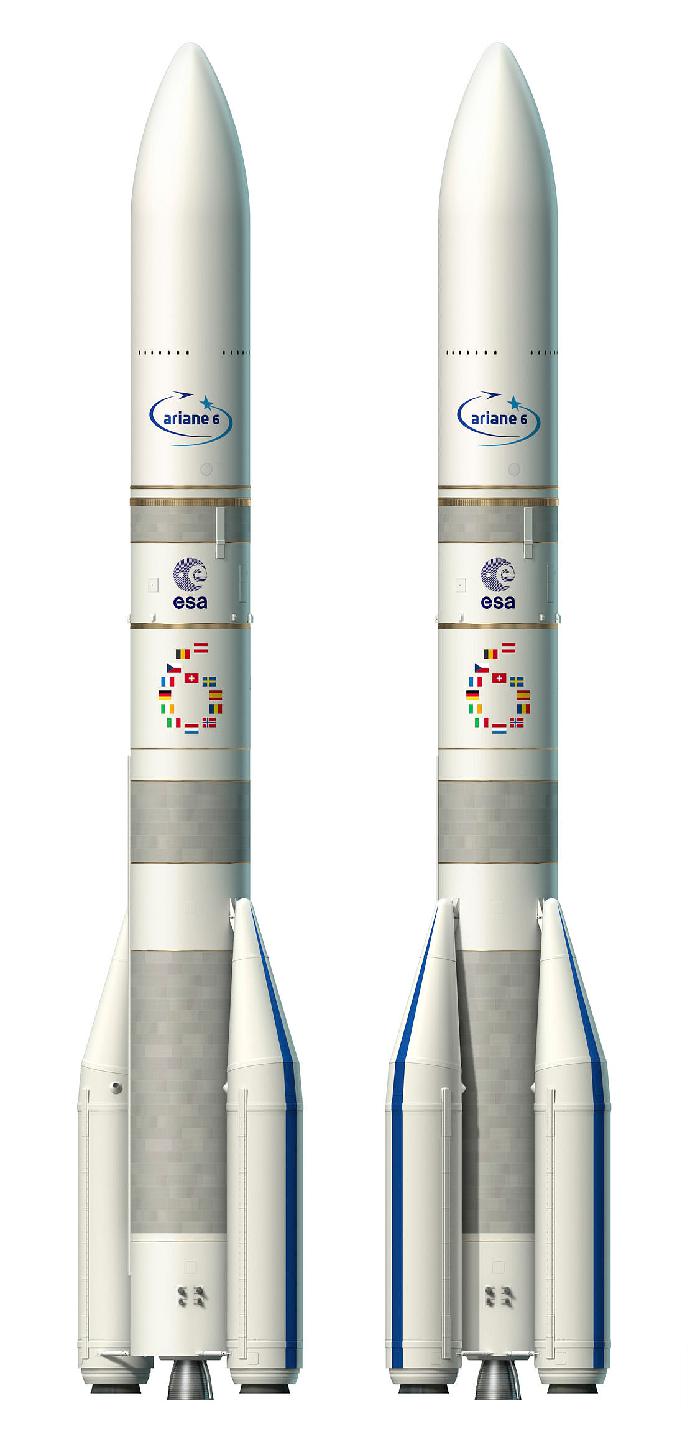
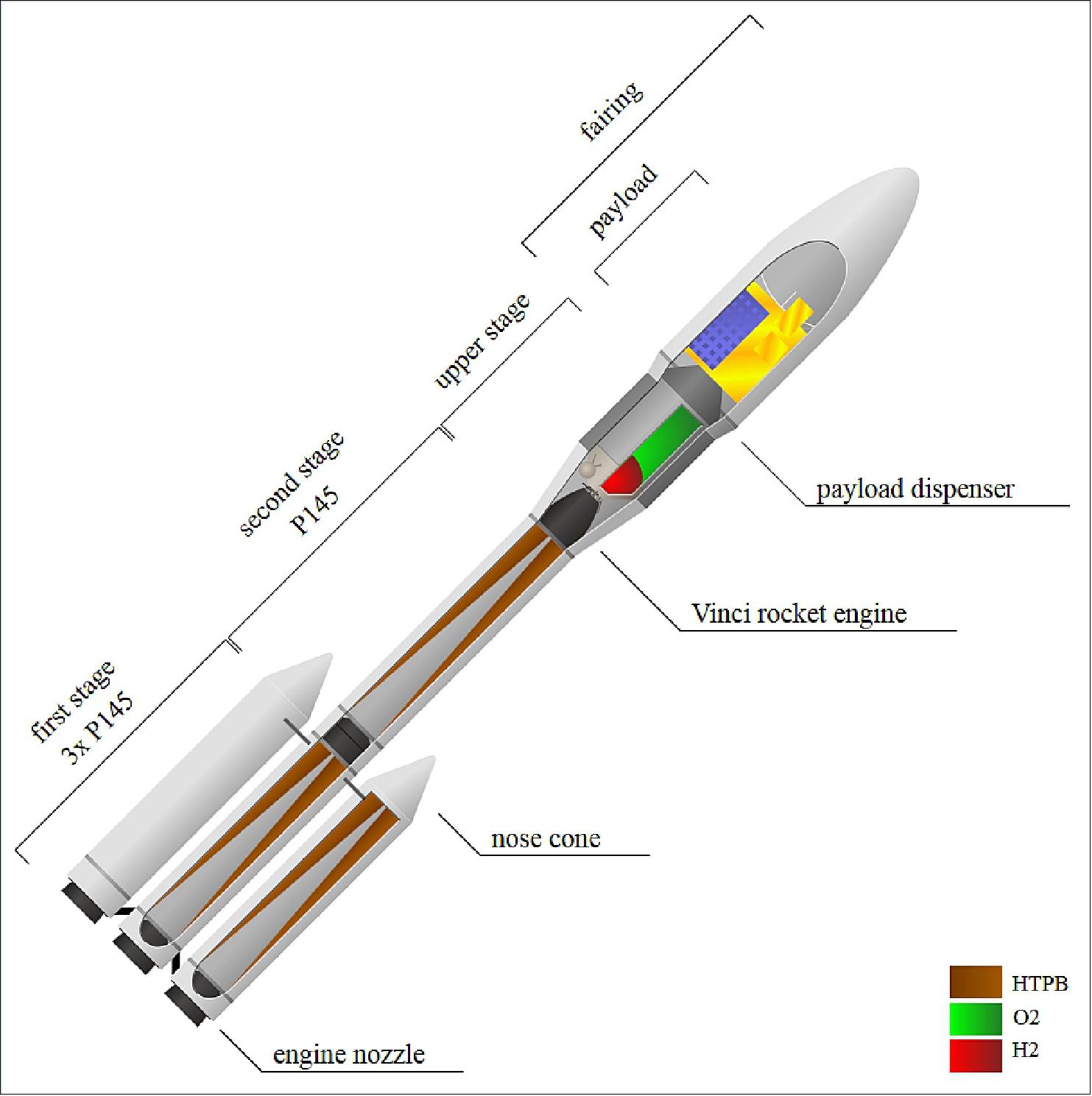
The industrial prime contractors, CNES and ArianeGroup, who are responsible for the launch base and launcher respectively, have jointly agreed on developing a common family of test and control systems that will be used in Europe and French Guiana during the build, verification, integration and launch of Ariane 6.
The Ariane 6 launcher will provide Arianespace with new levels of efficiency and flexibility to meet customers’ launch services needs across a full range of commercial and institutional missions. To ensure Arianespace’s continued competitiveness, this next-generation launcher has been conceived for reduced production costs and design-to-build lead times, all while maintaining the quality and reliability that have made Ariane 5 an industry leader. 3)
Ariane 6 features a modular configuration based on core stages powered by lower and upper liquid propellant modules, which that are supplemented by either two or four strap-on solid rocket motors. Enhancing Ariane 6’s competitiveness is the series production of its rocket engines and a technology-sharing approach with Arianespace’s Vega C – particularly this lightweight launcher’s P120 engine that also will be used in Ariane 6’s solid rocket motors.
ArianeGroup, formerly Airbus Safran Launchers, is prime contractor and design authority for Ariane 6, while ESA oversees procurement and architecture of the overall launch system. On 12 August 2015, ESA appointed Airbus Safran Launchers as principal contractor with the new development of the Ariane 6. On 1 July 2017, Airbus Safran Launchers changed its corporate name to ArianeGroup.
The industrial organization put into place for building Ariane 6 aims for maximum efficiency throughout the production cycle, up to delivery to the launch pad where, for greater flexibility, the payload is assembled on the launcher. The creation of European clusters of excellence allows to work with industrial partners via an extended enterprise approach, in order to standardise launcher methods and tools. The contribution of new industrial processes and innovative manufacturing technologies (3D printing, friction-stir welding, laser surface treatment, etc.), combined with a product lifecycle management system that meets the latest standards, helps optimize industrial level production. 4)
The overall goal is to achieve production costs 40 to 50% lower than those of Ariane 5 in order to be competitive in the face of new market demands. With the aim of ensuring continuity of independent European access to space, Ariane 6 should be making its first launch in 2020 and will be fully operational as of 2023, offering a level of reliability equivalent to that of Ariane 5.
Development Status
• July 13, 2022: ESA’s new Vega-C rocket has completed its inaugural flight, placing main payload LARES-2 – a scientific mission of the Italian Space Agency ASI – into its planned orbit. Six research CubeSats from France, Italy and Slovenia flew as secondary payloads. The launch caps a multi-year effort by ESA, prime contractor Avio and industrial partners in 13 ESA member states to build on the heritage of its predecessor, Vega. 5)
- Flight VV21 lifted off from Europe’s Spaceport in French Guiana at 15:13 CEST (13:13 UTC) on 13 July 2022 (10:13 local time). This mission lasted about 2 hours and 15 minutes from lift-off to release of final payload and final burn of the AVUM+ upper stage engine.
- Total payload mass at liftoff was approximately 474kg: 296 kg for LARES-2, with the remainder being the six CubeSats, payload adapters and carrying structures.
- Vega-C represents a dramatic capability boost compared to Vega, which has flown since 2012. With new first and second stages and an uprated fourth stage, Vega-C increases performance from Vega’s 1.5 t to about 2.3 t in a reference 700 km polar orbit.
- Overseeing launch operations from mission control at the Spaceport, ESA Director of Space Transportation Daniel Neuenschwander remarked: “Today we open a new era of European launch solutions, starting with Vega-C and to be complemented by Ariane 6.”
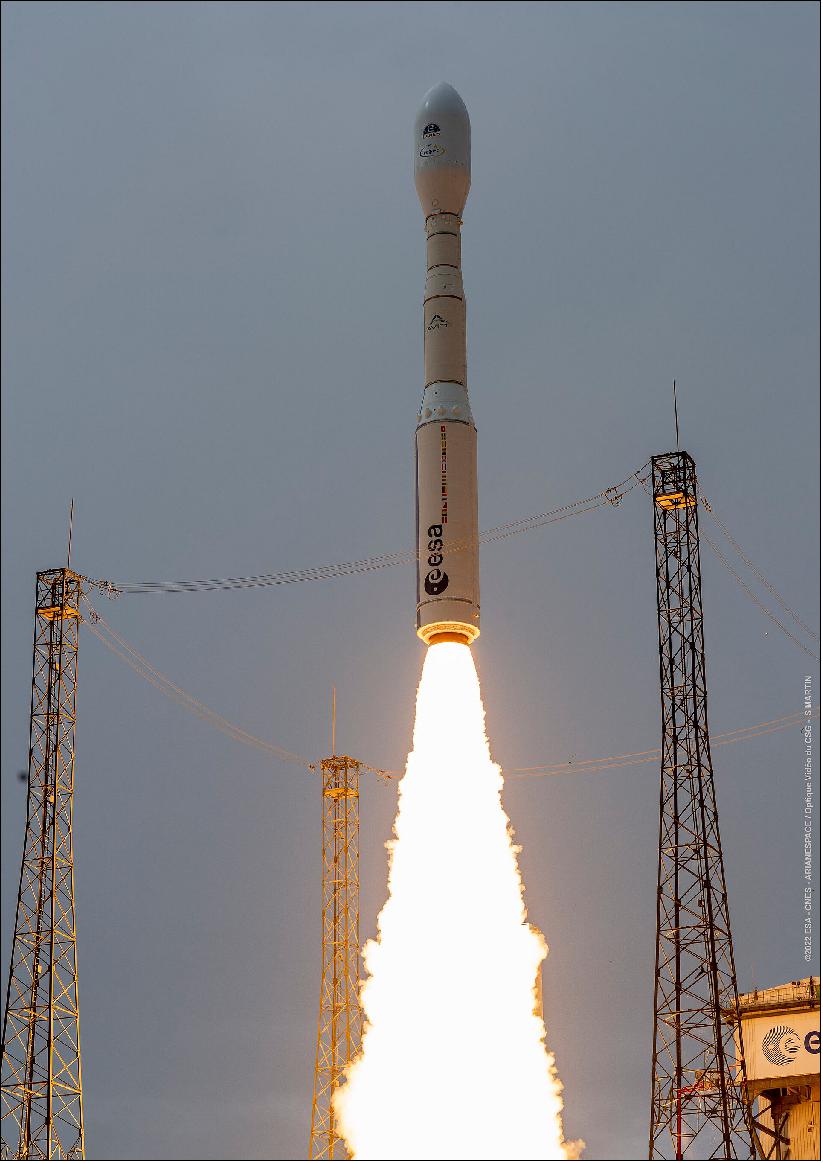
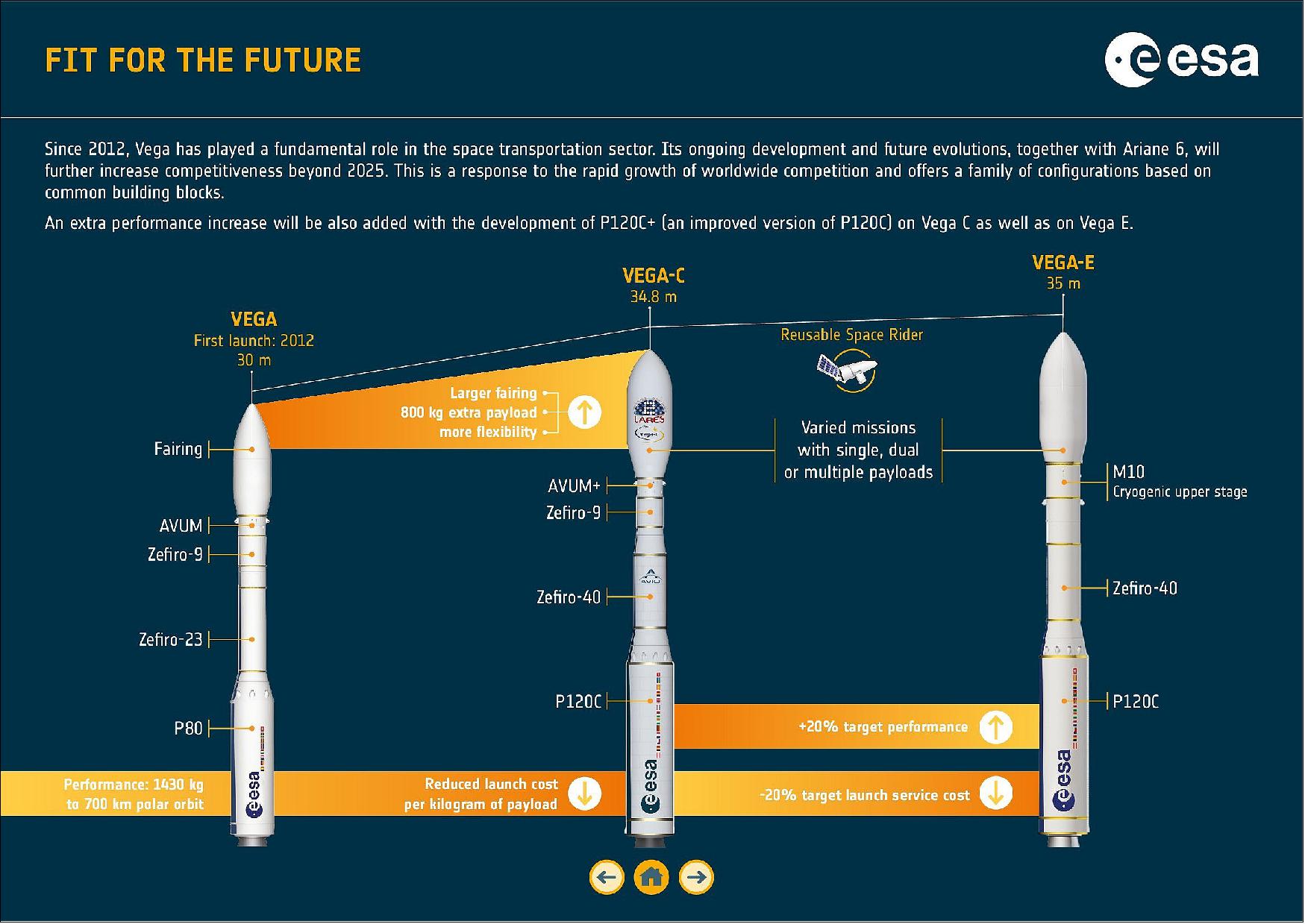
• July 12, 2022: The Ariane 6 launch pad at Europe’s Spaceport in French Guiana now hosts the first example of ESA’s new heavy-lift rocket. This Ariane 6 combined tests model will be used to validate the entire launch system during its ground phase in readiness for the inaugural launch of Ariane 6. 6)
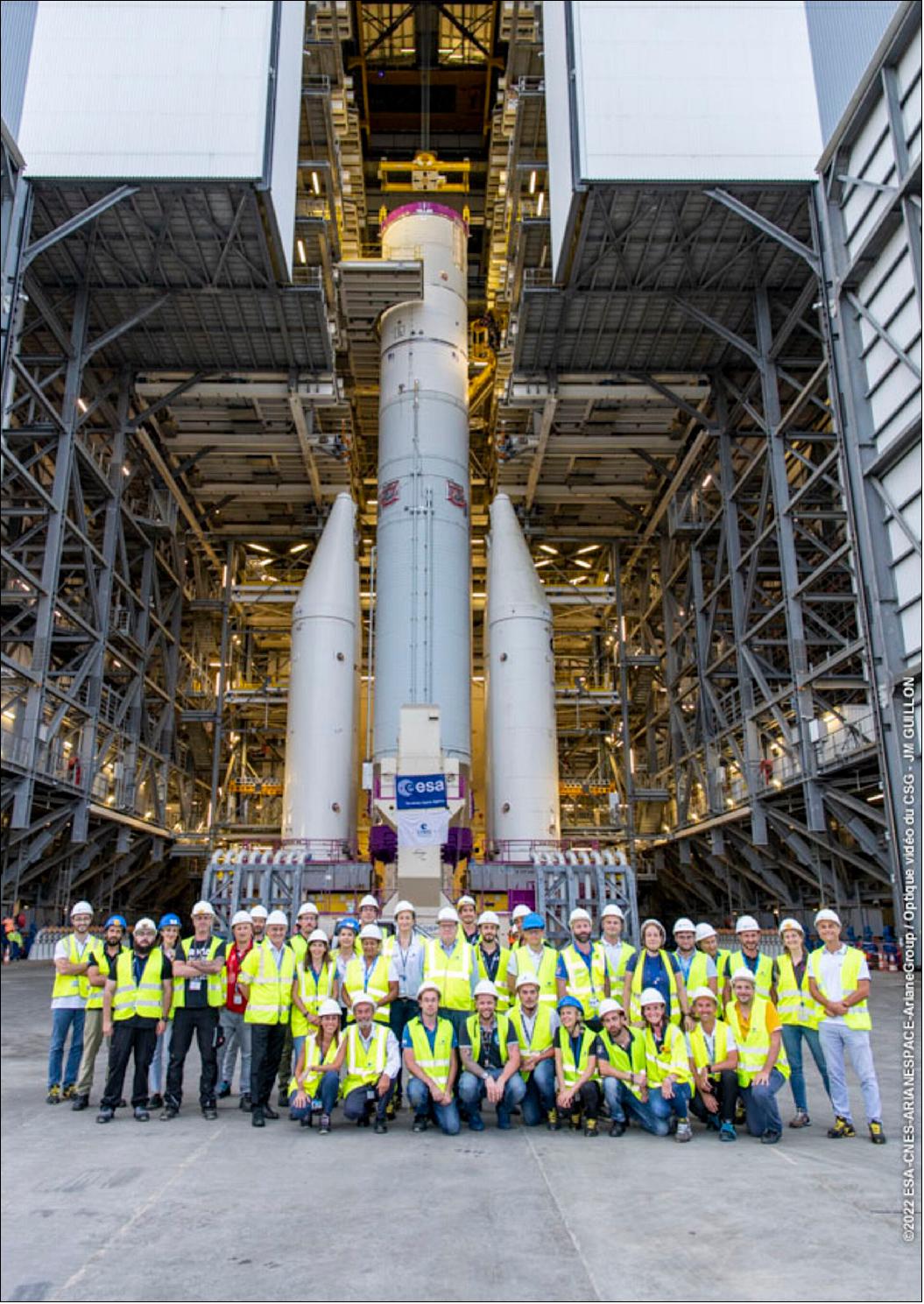
- The combined tests include filling tanks, and draining them in case of launch abort, count-down automated sequence, and cryogenic arms disconnection and retraction at a simulated lift-off.
- These tests will be carried out under ESA’s authority by an integrated team from ESA, ArianeGroup and French space agency CNES.
- The Ariane 6 combined tests model is highly representative of the flight model. It consists of the core stage and the upper stage, which make up the central core, as well as three pylons shaped like the rocket’s solid boosters and a fully representative but inert mockup of the fourth booster.
- The Ariane 6 combined tests model central core was precisely mated in the purpose-built launcher assembly building, where this task is carried out horizontally. Automated guidance vehicles then brought the assembled core to the launch and, working with the crane at the mobile gantry, raised it to its vertical position.
- “This key milestone is a cornerstone of the validation of the Ariane 6 integration concept which was imagined at the very beginning of this wonderful adventure. Achieving it is a source of great pride and a terrific motivator for Ariane 6 teams”, says Jérôme Crubilhé, ESA Mechanical Engineer.
- Before receiving the central core, launch pad systems underwent a battery of tests to check the “cryogenic connection system” of umbilical cords carrying hydrogen and oxygen fuel – liquified at -253C and -183C respectively – that will keep the rocket topped up in the critical moments before liftoff. The system must also deliver helium and nitrogen used for flushing and purging.
- Critically, these systems are designed to remain connected to the rocket until nearly the moment of liftoff. The method demands careful choreography of large mechanical systems but brings several advantages by improving reliability and availability while eliminating some equipment that is not needed in flight. The net result is to reduce the rocket’s dry mass and recurring costs.
- Also, last-moment decoupling does away with some purging lines needed by Ariane 5, to reduce recurring costs and the dry mass of the rocket.
- Daniel Neuenschwander, ESA’s Director of Space Transportation, said: “I am delighted to see solid progress towards first flight. Ariane 6 marks a new era in reliable, competitive and autonomous European spaceflight.
- “Ariane 6 is also the foundation for a series of developments which will maintain Europe’s gateway to space into the 2030s.”
- Ariane 6 is a modular launch vehicle using either two or four P120C strap-on boosters, depending on mission requirements. The P120C engine does double duty, also serving as the first stage of ESA’s new Vega-C rocket.
- The reignitable Vinci engine which powers the upper stage allows Ariane 6 to deliver multiple payloads to different orbits on a single launch. After payload separation a final engine burn deorbits the upper stage so that it does not become a debris threat in space.
- Ariane 6 development is project-managed and funded by ESA, which also acts as launch system architect. ArianeGroup is design authority and industrial prime contractor for the launcher system and CNES is prime contractor for the Ariane 6 launch base at Europe’s Spaceport. Arianespace is the launch service provider of Ariane 6.
• July 8, 2022: The Vega-C Payload Assembly Composite (PAC) with LARES-2 has been rolled out to the Vega Launch Zone (ZLV) and hoisted onto the Vega-C launch Vehicle on 7 July 2022 at Europe's Space Port in Kourou, French Guiana. 7)
- On the wave of Vega’s success, Member States at the ESA Ministerial meeting in December 2014 agreed to develop the more powerful Vega-C to respond to an evolving market and to long-term institutional needs.
- Vega-C increases performance from Vega’s current 1.5 t to about 2.2 t in a reference 700 km polar orbit, covering identified European institutional users’ mission needs, with no increase in launch service and operating costs.
- The participating states in this development are: Austria, Belgium, the Czech Republic, France, Germany, Ireland, Italy, the Netherlands, Norway, Romania, Spain, Sweden and Switzerland.
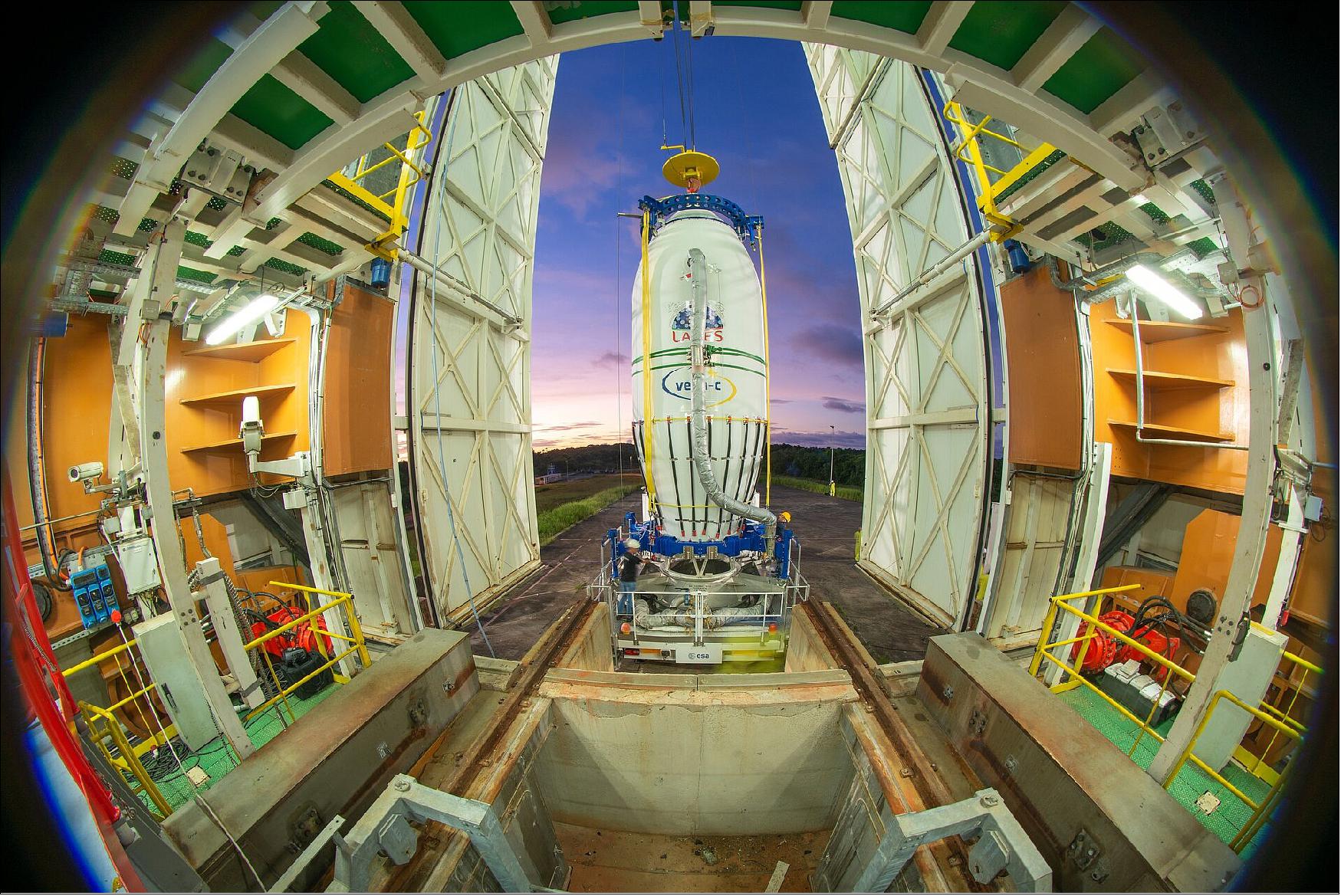
• June 16, 2022: As the European Space Agency prepares to begin operations of its next-generation Vega-C and Ariane 6 launch systems complemented by the reusable Space Rider orbital transportation system, work is underway to define the future of European space transportation capabilities for the coming decade and beyond. 8)
- ESA, together with partners, is elaborating a vision of the future of space transportation in Europe. The objective is to identify the activities required to unleash Europe’s technological potential as a global competitor, with an industrial landscape that fosters innovation and drives cost reduction.
- Identifying critical technologies is a key feature of this approach.
- Work has been underway since summer 2021 to identify features of a future European space transportation infrastructure. The next phase will be to define a technology roadmap that allows ESA, Europe’s national space agencies and institutions, and both established and start-up space companies to match the intense technical and commercial competition coming from the USA, China, Russia and India.
- More than 100 representatives of Europe’s space sector are preparing to gather on 28 June in Palermo, Sicily for an intensive series of roundtable discussions.
- Giorgio Tumino, ESA’s Chief Technical Advisor for Space Transportation, is leading the elaboration of this vision and organising the Palermo gathering, called “Shared Vision for the Future of Space Transportation in Europe”.
- Critically, he says, concepts for a “Vision 2030+” must be discussed independently of the needs and constraints of existing programmatic frameworks. “We need to think about the future without being held back by the parameters of today,” he says.
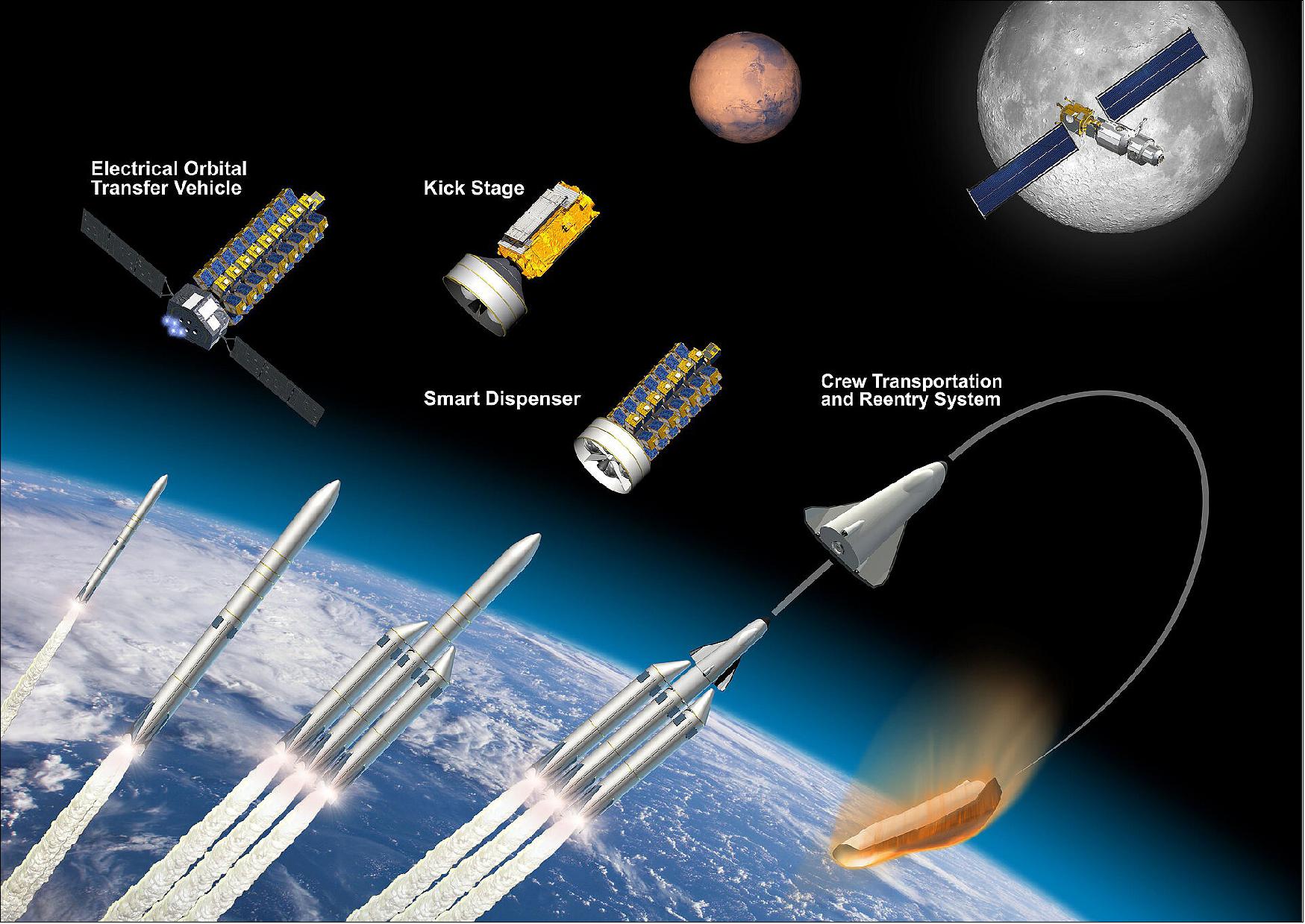
- Encouragingly, he adds, work done so far has been supported by technical experts from institutions of ESA’s Member States: “There are elements for a vision of the future from the technical and technological perspective.”
- One key focus of the Palermo meeting is to share ESA’s Vision 2030+ with industry and consolidate a technology development strategy, because it is important to define coordinated actions by Europe’s institutions and companies. 2030, he notes, is coming soon – it is the “next step, not the step after the next”.
- Following the Space Summit held in Toulouse in February 2022, another focus is to share the steps ESA is taking to prepare an informed decision on human exploration, including human space transportation capabilities in Europe, as these may become an additional dimension of Vision 2030+. At Palermo, discussions will grapple with the question of competition versus cooperation between institutional and private-sector actors spread across many European countries.
- ESA, its national partners and other European institutions which rely on space services may also need to redefine their roles. Going from being project leaders – the traditional role of a space agency – to project enablers means learning to work with private sector actors and their objectives, rather than hiring them to fulfil a specified mission.
- That new role may see agencies work to de-risk ambitious technology development efforts to smooth the path from concept to reality. Agencies may also need to act as “anchor customers” to ensure a coordinated European procurement of end-services by, for example, guaranteeing a minimum yearly order.
- In that context, Tumino says, an important objective of the Palermo gathering will be to identify where to focus resources for the best return on investment.
- Daniel Neuenschwander, ESA’s Director of Space Transportation, says the event in Palermo will be a unique opportunity to share objectives and work with European stakeholders to further elaborate Vision 2030+ in preparation for November’s ESA Council at Ministerial Level. “Our objective is to identify the paths we need to follow to unleash European technological potential and position Europe as a key space power in a competitive global space sector,” he says.
- The final event programme and list of roundtable participants is now available at: https://www.roundtable-spacetransportation.com/. Interested participants should register to attend by 19 June 2022.
• June 16, 2022: ESA’s new medium-lift Vega-C rocket is nearly ready for its inaugural flight, with its four fully-stacked stages now ready for payload integration, final checks and launch from Europe’s Spaceport in French Guiana. 9)
- Flight VV21 will lift off as soon as 7 July, pending suitable conditions for launch.
- Vega-C represents a dramatic capability boost compared to its predecessor, Vega, which has flown since 2012. With new first and second stages and an uprated fourth stage, Vega-C increases performance from Vega’s 1.5 t to about 2.2 t in a reference 700 km polar orbit.
- Vega-C features a new, more powerful first stage, P120C, based on Vega’s P80. Atop that is a new second stage, Zefiro-40, and then the same Zefiro-9 third stage as used on Vega.
- The re-ignitable upper stage is also improved. AVUM+ has increased liquid propellant capacity, to deliver payloads to multiple orbits depending on mission requirements and to allow for longer operational time in space, to enable extended missions.
- The P120C motor will do double service, with either two or four units acting as strap-on boosters for Ariane 6. Sharing this component streamlines industrial efficiency and improves cost-effectiveness of both launchers.
- With its larger main stages and bigger fairing – which doubles the payload volume compared to Vega – Vega-C measures 34.8 m high, nearly 5 m taller than Vega.
- The new launcher configuration delivers a significant improvement in launch system flexibility. Vega-C can orbit larger satellites, two main payloads or can accommodate various arrangements for rideshare missions. ESA’s upcoming Space Rider return-to-Earth vehicle will be launched to orbit on Vega-C.
• April 26, 2022: Launcher integration for the inaugural flight of Vega-C began with the P120C solid-fuel first stage being delivered to the Vega Launch Zone (Zone de Lancement Vega, or ZLV) at Europe's Spaceport in Kourou, French Guiana on 15 April 2022. P120C will also fly on Ariane 6, with two or four units serving as boosters depending on mission requirements. 10)
- The interstage segment to join the P120C first stage with the Z40 second stage followed on the 22nd.
- For flight VV21, the principal payload will be LARES-2 (Laser Relativity Satellite-2), a scientific mission of the Italian Space Agency (ASI). Also onboard will be six European research CubeSats.
- Following Vega’s success, Member States at the ESA Ministerial meeting in December 2014 agreed to develop the more powerful Vega-C to respond to an evolving market and long-term institutional needs.
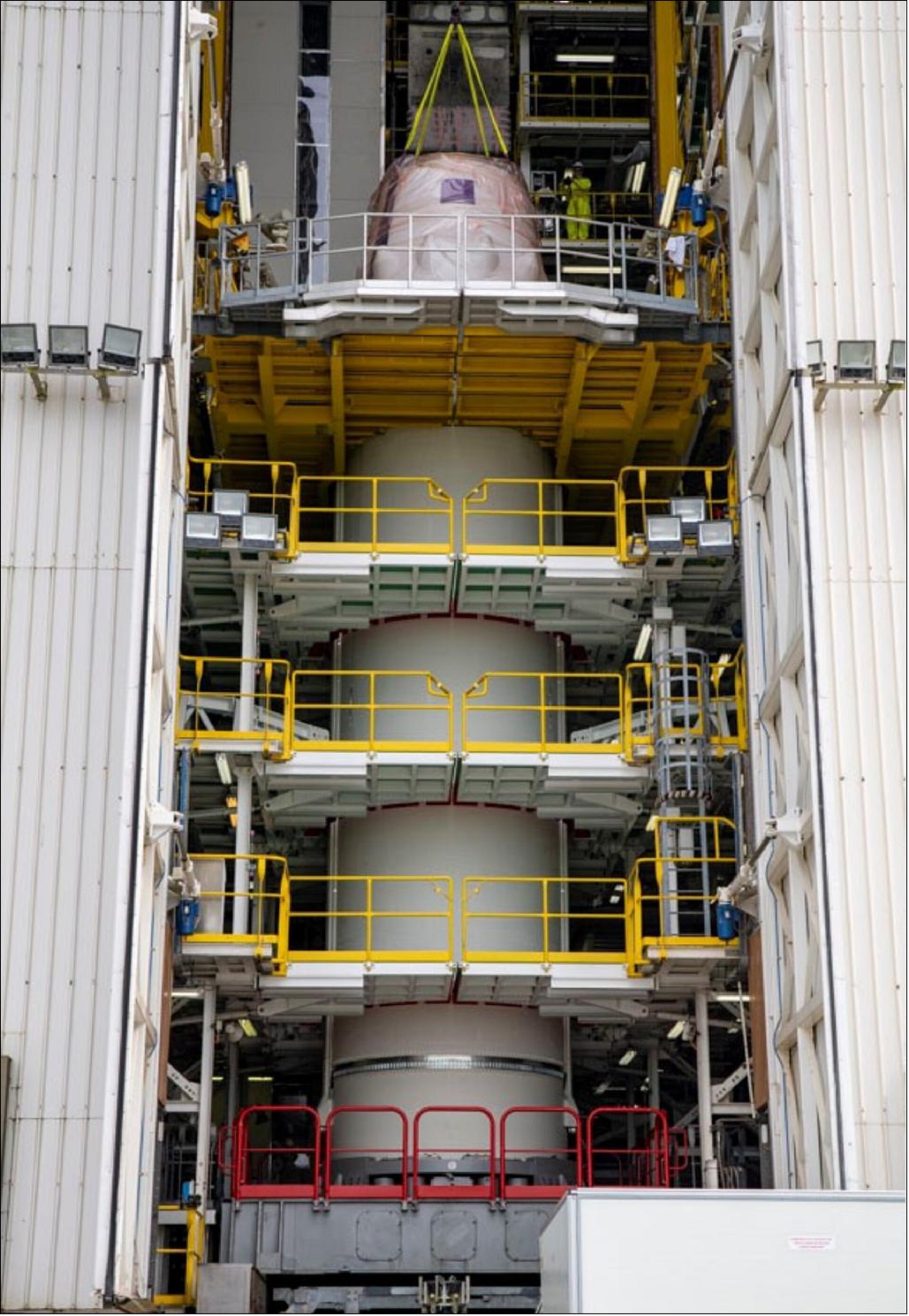
- Vega-C increases performance from Vega’s 1.5 t to about 2.2 t in a reference 700 km polar orbit and increases the available payload volume, covering identified European institutional users’ mission needs with no increase in launch service and operating costs.
- The participating states in this development are: Austria, Belgium, the Czech Republic, France, Germany, Ireland, Italy, the Netherlands, Norway, Romania, Spain, Sweden and Switzerland.
• April 5, 2022: Arianespace and Amazon sign agreement for 18 Ariane 6 launches, the largest ever both for Arianespace. — The highest performing version of Ariane 6, Ariane 64, will be used over three years to orbit satellites of the Project Kuiper broadband constellation. 11)
- Arianespace and Amazon (NASDAQ: AMZN) announced an unprecedented launch service contract during the International Space Symposium in Colorado Springs, USA, on April 5. Under the terms of the contract, Arianespace will perform 18 Ariane 6 launches for Amazon’s Project Kuiper over a period of three years from Europe’s Spaceport in French Guiana. Among the 18 launches planned for the deployment of the Project Kuiper, 16 will be carried out with an advanced version of the Ariane 64.
- Stéphane Israël, CEO of Arianespace, declared: “This contract, the largest we’ve ever signed, is a great moment in Arianespace’s history. We are honored to be given a significant role to play in the deployment of Amazon’s Project Kuiper, which aims to connect tens of millions of people to the internet. It will build on the European innovative spirit, industrial might, and years of experience of the Ariane partners. That Amazon has chosen the Ariane 6 to do the job is a matter of tremendous pride for us and a great vote of confidence for our new launch vehicle. This day marks a decisive success for the Ariane 6 Program and all its value chain in Europe.”
- Arianespace is renowned for its competence in deploying institutional and commercial satellite constellations. For this contract, Arianespace will rely on the Ariane 64 vehicle, the highest performing European launcher which is perfectly tailored for the demanding work of deploying constellations. Ariane 6 will enter service and replace the Ariane 5 as Arianespace’s heavy lift workhorse.
- The versatility, high capability, and expected reliability of the Ariane 6 played a key role in securing this agreement with Amazon for the Project Kuiper. Ariane 6 has been designed from the outset to be scalable and able to integrate, during its life and on a regular basis, new technologies. Out of the 18 A64 launches, 16 A64 will benefit from an increase in the power of the P120C solid boosters (called “P120C+” version). Ariane 6’s incremental development is intended to regularly improve the performance of the launch solutions offered by Arianespace and always better fulfil the needs of both institutional and commercial customers. These developments are funded and managed by the European Space Agency (ESA) and implemented by Ariane 6’s launcher system prime contractor ArianeGroup.
- Amazon’s Project Kuiper aims to connect the unconnected, providing high-speed, low-latency broadband to unserved and underserved communities across the globe at affordable rates. Homes, schools, hospitals, businesses, governments, and institutions that lack access to connectivity could soon have it through Project Kuiper.
• February 11, 2022: ESA in close collaboration with ArianeGroup and Arianespace has selected payloads which best fit the profile of the first mission of its new generation Ariane 6 launch vehicle from Europe’s Spaceport in French Guiana. 14)
This selection follows ESA’s announcement of opportunity in November 2021, which offered a launch to low Earth orbit for experiments up to a total mass of 80 kg and release of payloads with a combined mass of up to 800 kg. They will be hosted on a ‘mass dummy’ featuring a large platform, inside the 14 m long version of the fairing on an Ariane 6 fitted with two strap-on boosters (A62 version).
This demonstration flight will contribute to the qualification of the Ariane 6 launch system as part of the transition from its highly reliable and successful predecessor, Ariane 5. This launch is an important step in the preparation for future institutional missions planned for Ariane 6, such as Galileo.
For this flight, ESA is responsible for operations from the launch campaign to the payload separation, and then disposal of the upper stage through burn-up during reentry.
“I’m glad that ESA can use the very first Ariane 6 flight as a platform for launching these fantastic payloads, some of which will enable European start-ups to validate their systems and provide future commercial services. The Ariane 6 inaugural launch is a key step towards full qualification of the Ariane 6 launch system,” said Daniel Neuenschwander, ESA Director of Space Transportation.
Experiments Onboard
Organisation | Country | Payload | Description | Mass (kg) |
Garef Aerospatial | France | PariSat | Thermal equilibrium of an array to confirm | ≤12 |
Sint-Pieterscollege | Belgium | Peregrinus | Dual sensor magnetic field | ≤ 0.5 |
Libre Space | Greece | SIDLOC | In-orbit demonstrator Radio Frequency beacon | ≤ 0.15 |
ESA | - | ESA YPSat – Eye2Sky | Photo and video footage | <3 |
Organisation | Country | Payload | Description | Mass (kg) |
PTS | Germany | CuriumOne | with a duplicate ASTRIS Engineering Qualification | ≤24.5 (AstroFein |
TU Berlin | Germany | OOV-Cube | Microsatellite – IoT agriculture use case demo | ≤17( AstroFein |
ESA Education Office | Spain | 3Cat4 | 1U CubeSat – Techno demo Flexible | 1.3 |
ESA Education Office/ | Portugal | ISTSAT | 1U CubeSat – Characterisation of aircraft’s ‘cone | 1.3 |
Spacemanic | Slovakia | GRBBeta | 1U CubeSat – Gamma Ray Burst detection | 1.3 |
ArianeGroup | France | SpaceCase SC-X01 | Test platform for reentry technologies such as new-generation | ≤43, (separated: 40) |
The Exploration Company | France, Germany | Bikini Demo | First passive, small-scale demonstrator of a reentry capsule | ≤26 (separated: 20) |
Deployers
Two deployers will be arranged on board and will accommodate CubeSats. The RAMI deployer is built by Spain’s UARX Space, and the ExoPOD is built by ExoLaunch, Berlin, Germany.
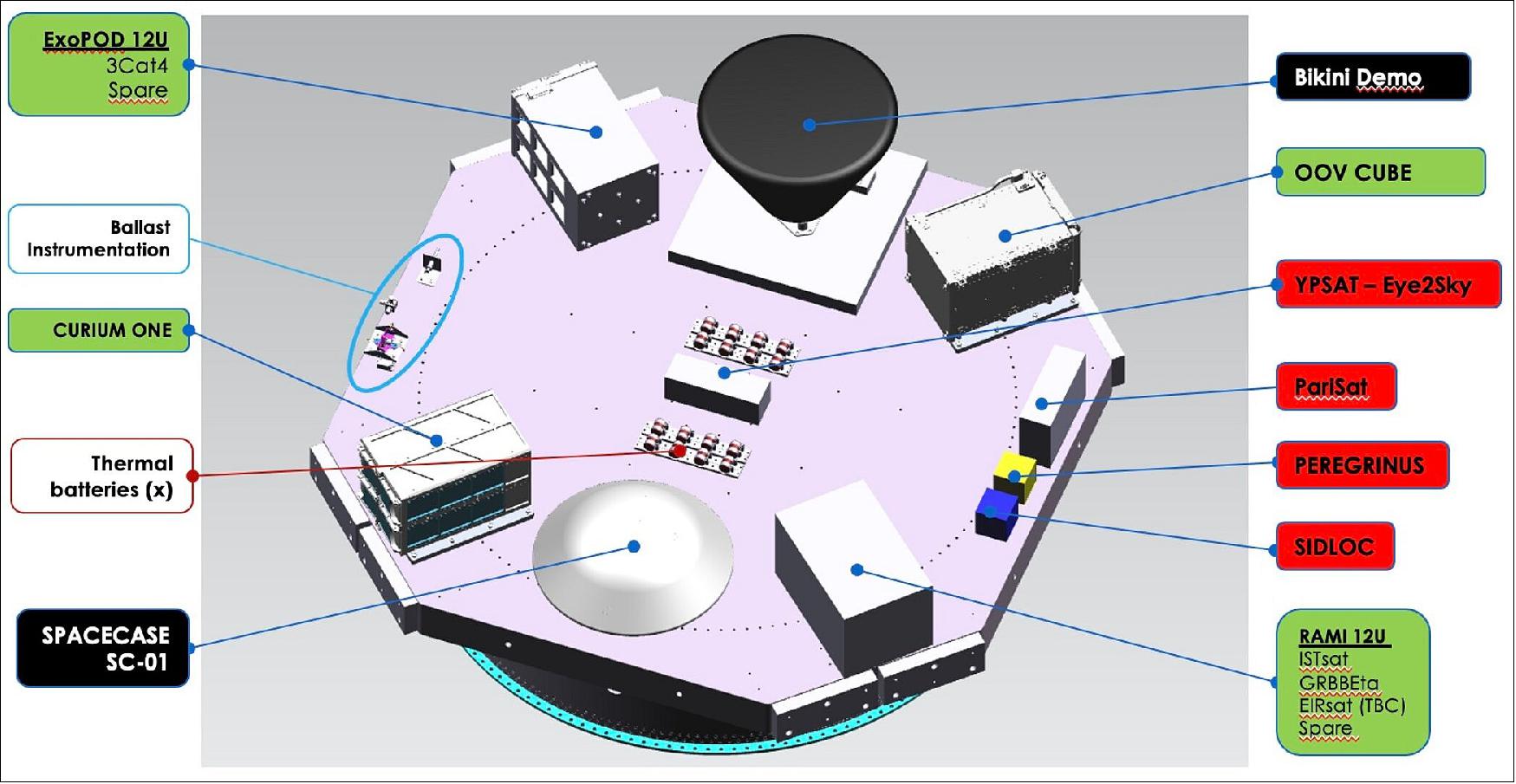
With some spaces for CubeSats still available, ESA may add to this collection closer to launch.
Ariane 6 is a modular launch vehicle using two or four P120C strap-on boosters to achieve the required performance. The reignitable Vinci engine powers the upper stage which allows Ariane 6 to reach a range of orbits to deliver more payloads on a single launch. The upper stage engine will typically burn one, two or more times to reach the required orbits. After payload separation a final burn deorbits the upper stage to mitigate space debris.
• February 11, 2022: Ten years ago this week, 13 February 2012, ESA opened a new era of independent access to space with the flawless inaugural flight of its small launcher Vega. Flying from Europe’s Spaceport in French Guiana, Vega has gone on to earn a reputation for precision and versatility in anticipation of a more capable version, Vega-C. 15)
- Placing medium-sized satellites into the low Earth polar orbits that are ideal for scientific and Earth observation missions – about 1430 kg to 700 km – is Vega’s trademark capability. But the vehicle has also delivered an ESA science mission to deep space – the gravitational wave detector demonstration mission, LISA Pathfinder – and followed the equatorial flight path needed for an experimental IXV ‘lifting body’ payload that paved the way for a European launchpad-to-runway space transportation service, with ESA’s uncrewed Space Rider vehicle.
- Vega has also mastered ‘ride sharing’, to cost-effectively put multiple satellites into orbit on a single flight. This launch vehicle has set the stage for the imminent first flight of a bigger, more capable variant, Vega-C – delivering more payload and greater flexibility for the same cost. And, with its industrial partners, ESA is developing a further evolution, Vega-E, to reduce programme costs while boosting performance.
- For Vega’s inaugural flight, VV01, the Italian space agency, ASI, supplied the principal payload, LARES (LAser RElativity Satellite).
- VV01 capped more than a decade of work on a small vehicle to complement ESA’s heavy lifter, Ariane 5, and the upcoming Ariane 6. ESA and Arianespace partly filled that gap by bringing the medium-lift Soyuz rocket to French Guiana from 2011.
- But the breakthrough was Vega which became an ESA programme in 2000. Seven Member States contributed: Belgium, France, Italy, the Netherlands, Spain, Sweden and Switzerland. ESA, with the technical support of the Italian and French space agencies, and about 40 industrial companies coordinated by the prime contractor Avio, made this enormous challenge a reality.
- About 1000 individuals were involved in the Vega development. “Vega is above all a human adventure built on a great European team, built on competence and cooperation, relying on outstanding dedication and effort,’’ said Stefano Bianchi, Head of Flight Programmes. “For all the engineers and operators who worked so hard to prepare the launch, the 13 February 2012 is a day that will always remain deeply rooted in their memories, as it is in mine.’’
- Vega combines three solid-fuel stages with a fourth, liquid-fuelled stage. Solid fuel motors cannot be throttled, stopped or restarted – after ignition they burn at full-power until the fuel runs out – but they provide exceptional liftoff thrust without the tanks, fuel pumps and fuel handling infrastructure needed for liquid propellants. These economical motors can be manufactured and fuelled in advance to be safely stored until needed for launch.
- The liquid-fuelled fourth stage provides fine control of position thanks to its stop-start-throttle capabilities, so Vega can accurately deliver single or multiple payloads to different orbits on one launch. This flexibility was demonstrated on flight VV16 in September 2020, when Vega first carried its Small Spacecraft Mission Service (SSMS) dispenser for light satellites. The ride share mission orbited seven microsatellites and 46 cubesats.
Continuous Development
- Since 2012, Vega has played a fundamental role in the space transportation sector and its ongoing development and future evolutions, together with Ariane, will further increase competitiveness beyond 2025. This is a response to the rapid growth of worldwide competition and offers a family of configurations based on common building blocks.
- While Vega team members will surely take a moment today to reflect on a memorable decade, their focus is on the future – and the inaugural flight of Vega-C.
- “Vega-C is now in the last phase of its qualification – a crucial step towards its inaugural flight,’’ commented Renato Lafranconi, Vega Programmes Manager. “Its development is driven by the rapidly growing worldwide competition in the Space Transportation sector which requires the continuous improvement of the Vega launch system versatility and competitiveness to ensure its sustainability.’’
- Like Vega, Vega-C features three solid-fuel stages and a liquid-fuelled fourth stage. But Vega-C brings two great improvements. One is an extra 800 kg payload capacity – an increase of more than a third, to about 2.2 tonnes – but for a similar launch cost.
- Vega-C features a new, more powerful first stage, P120C, based on Vega’s P80. Atop that is a new second stage, Zefiro-40, and then the same Zefiro-9 third stage as used on Vega. The new AVUM+ fourth stage can remain operational in space for longer than Vega’s AVUM, to enable extended missions.
- With its larger main stages and bigger fairing, Vega-C measures 34.8 m high, nearly 5 m taller than Vega.
- Equally important is another Vega-C innovation. Its P120C first stage will do double service, with either two or four of these acting as strap-on boosters for Ariane 6. By coordinating Vega-C and Ariane 6 development, ESA and its partners are realising a strategy of continuous, agile development. Vega-E, for example, is being readied to add another 20% payload capability while reducing costs, from as soon as 2025.
- ESA’s Director of Space Transportation Daniel Neuenschwander observes, “Major ongoing development programmes with Ariane 6 and Vega-C will allow Europe to maintain its independent access to space, which is a strategic priority in a world where technology, business and politics move very quickly.”
- “We have to keep pushing forward, to make sure Europe is ready for the future.”
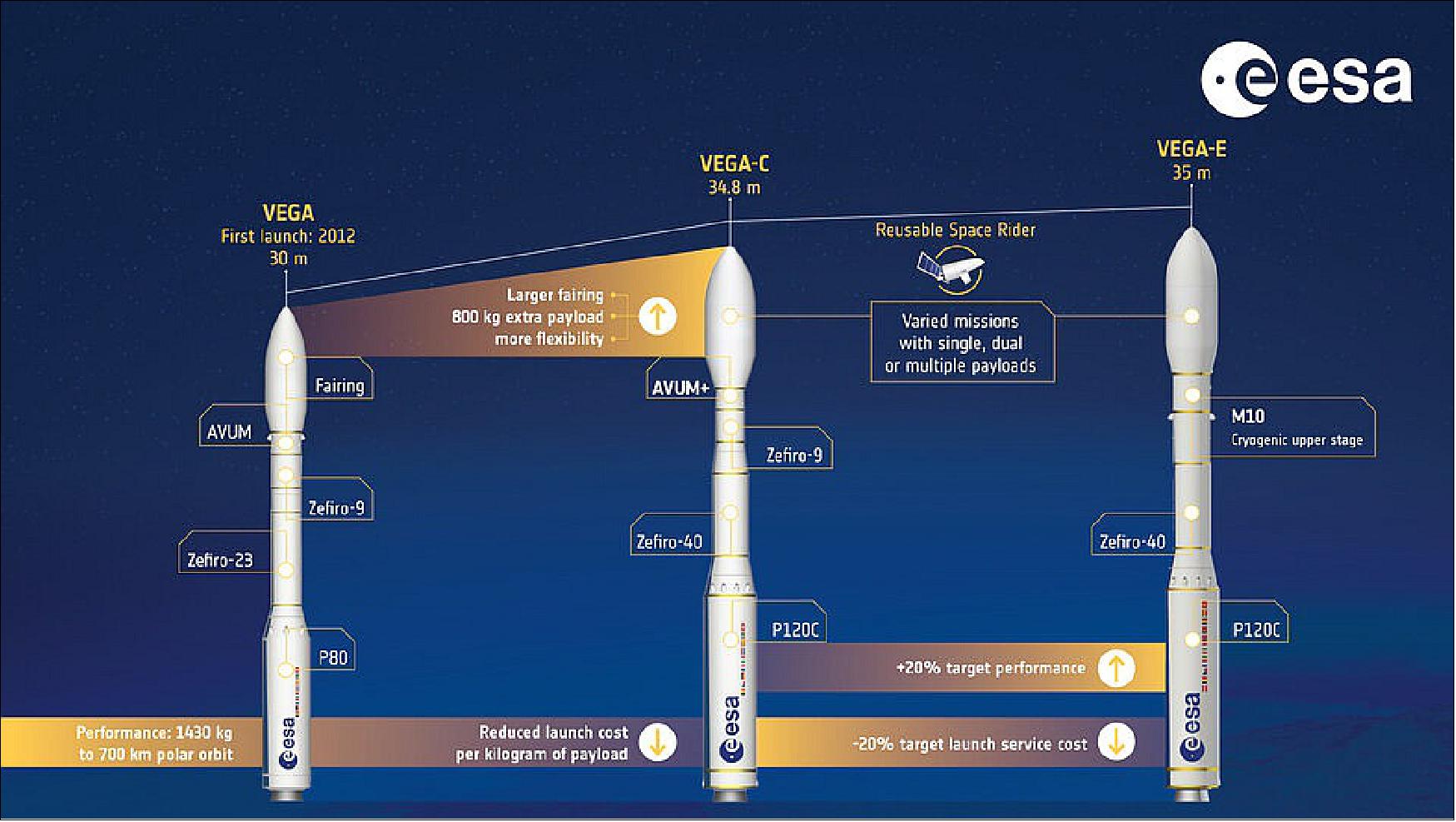
• January 28, 2022: The lower stage of ESA’s next-generation Ariane 6 launch vehicle has been installed on the assembly line at Europe’s Spaceport behind the upper stage. It is now time to join the two horizontally to create the central core of Ariane 6 in readiness for the first combined tests on the launch pad. 16)
- The arrival from Europe of Ariane 6’s central core in French Guiana is a major milestone and an exciting step forward in the path to first flight as it allows combined tests to start. From arrival to hot-firing tests on the launch pad, operational procedures will mimic an Ariane 6 launch campaign.
- The lower stage is from ArianeGroup’s Les Mureaux site in France. Fitted with an additional two or four solid rocket boosters it is designed to power Ariane 6 in the first 10 minutes of flight to about 200 km, delivering about 135 tonnes of thrust in vacuum. The core stage is powered by the liquid-fuelled Vulcain 2.1 – an upgraded engine derived from Ariane 5’s Vulcain 2.
- The Ariane 6 upper stage, built in ArianeGroup’s Bremen factory in Germany, allows Ariane 6 to reach a range of orbits on a single mission to deliver more payloads.
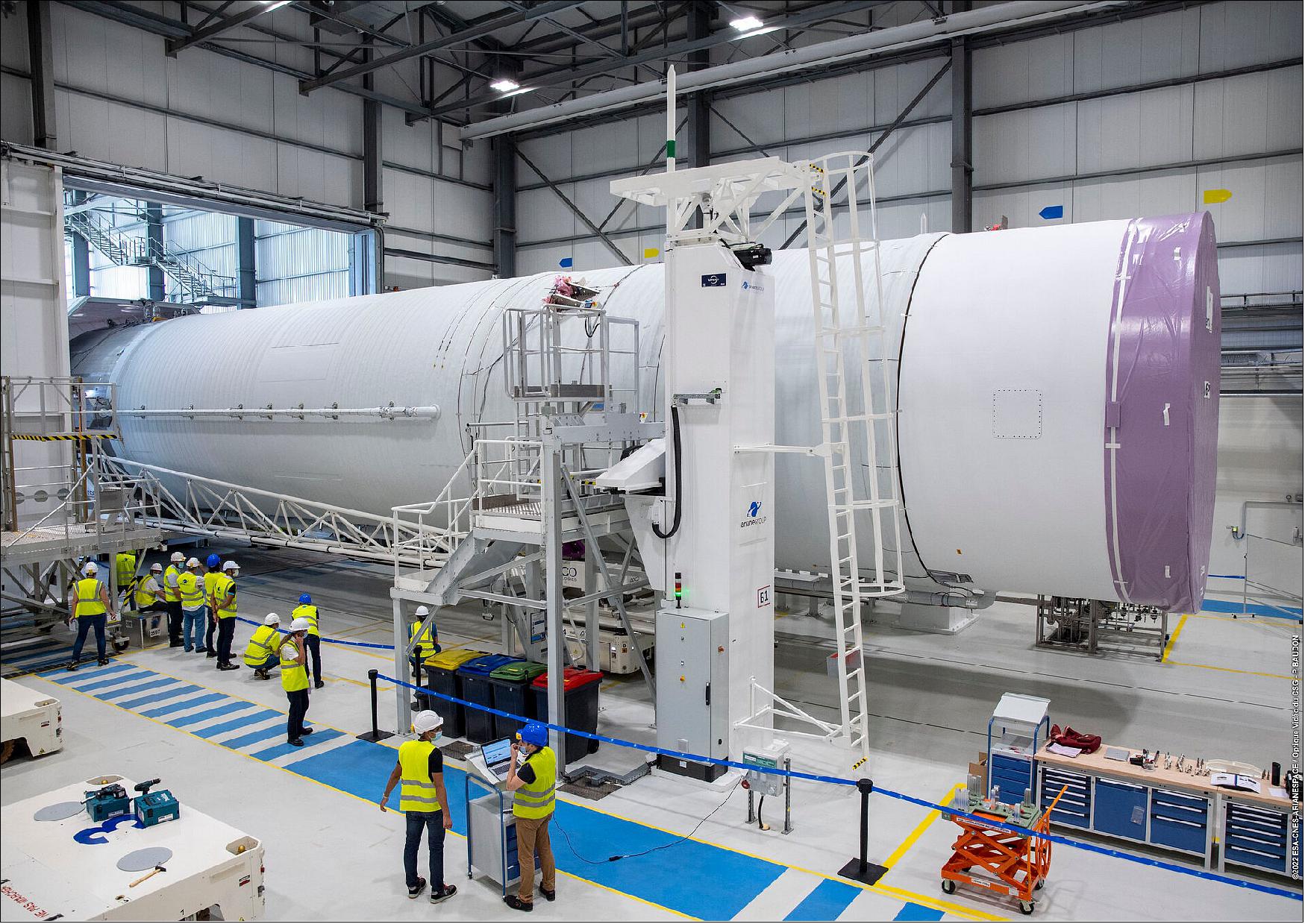
- The upcoming tests verify all the interfaces and functions between the Ariane 6 launch vehicle and ground facilities of the new Ariane 6 launch complex at the spaceport. Reaching this phase of activities is the result of intense preparation by ESA and its partners in Europe and at Europe’s Spaceport.
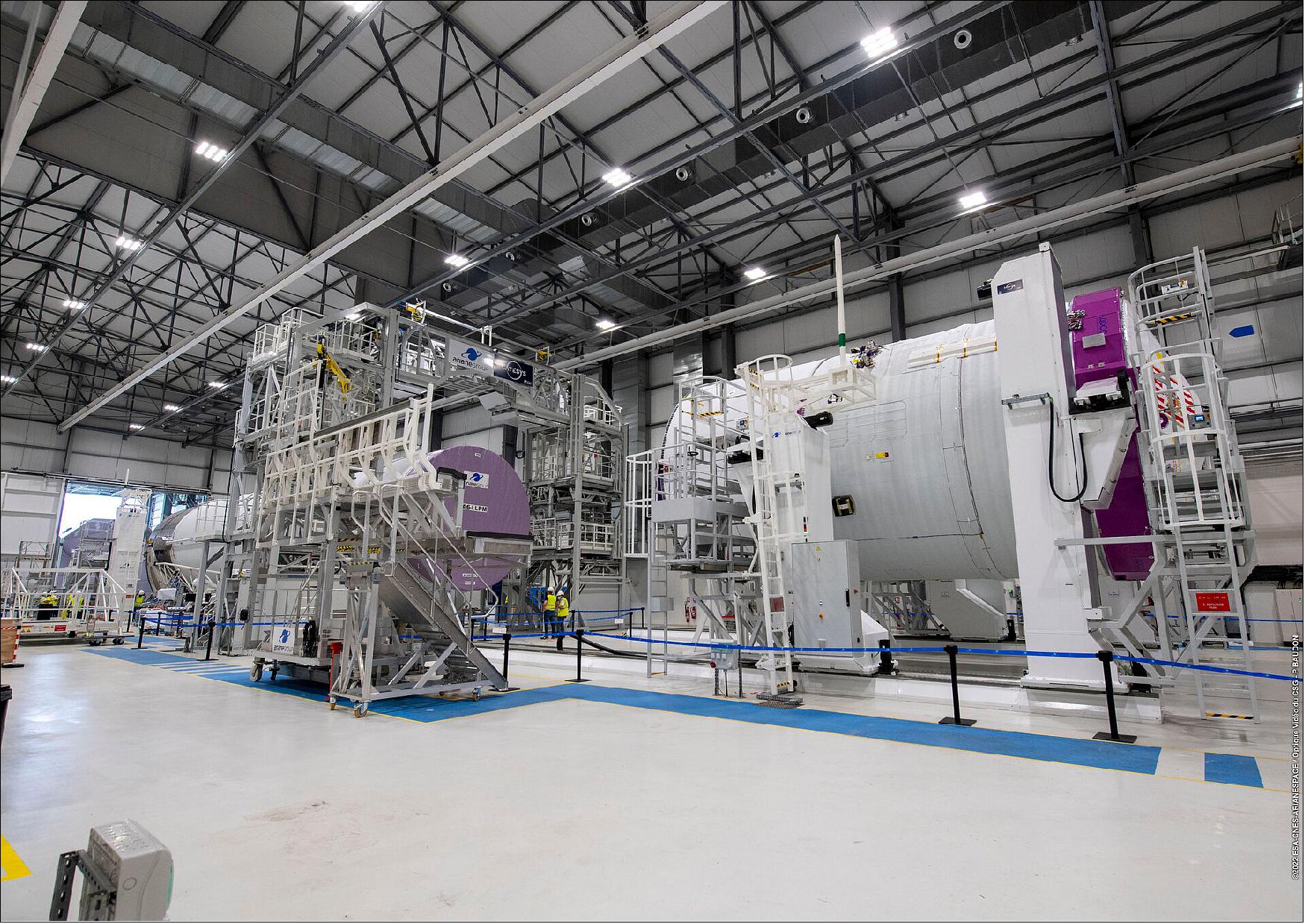
• January 21, 2022: The central core of ESA’s new generation Ariane 6 launch vehicle arrived at Europe’s Spaceport on 18 January and is now inside the launch vehicle assembly building. 17)
- Ariane 6’s central core comprises a lower stage and upper stage. The lower stage is from ArianeGroup’s Les Mureaux site in France; the upper stage is from ArianeGroup’s Bremen factory in Germany.
- Upon arrival by boat at Pariacabo harbour, two containers were transported by road to the new Ariane 6 launch vehicle assembly building – part of the Ariane 6 launch complex at Europe’s Spaceport. Here, the rocket stages were unpacked and installed on the assembly line machinery for horizontal integration, to form the Ariane 6 central core. After this, they will be used in ‘combined’ tests which will verify all the interfaces and functions between the Ariane 6 launch vehicle and ground facilities at the spaceport.
- From arrival to hot-firing tests on the launch pad, operational procedures will follow as closely as possible those for any Ariane 6 launch campaign.
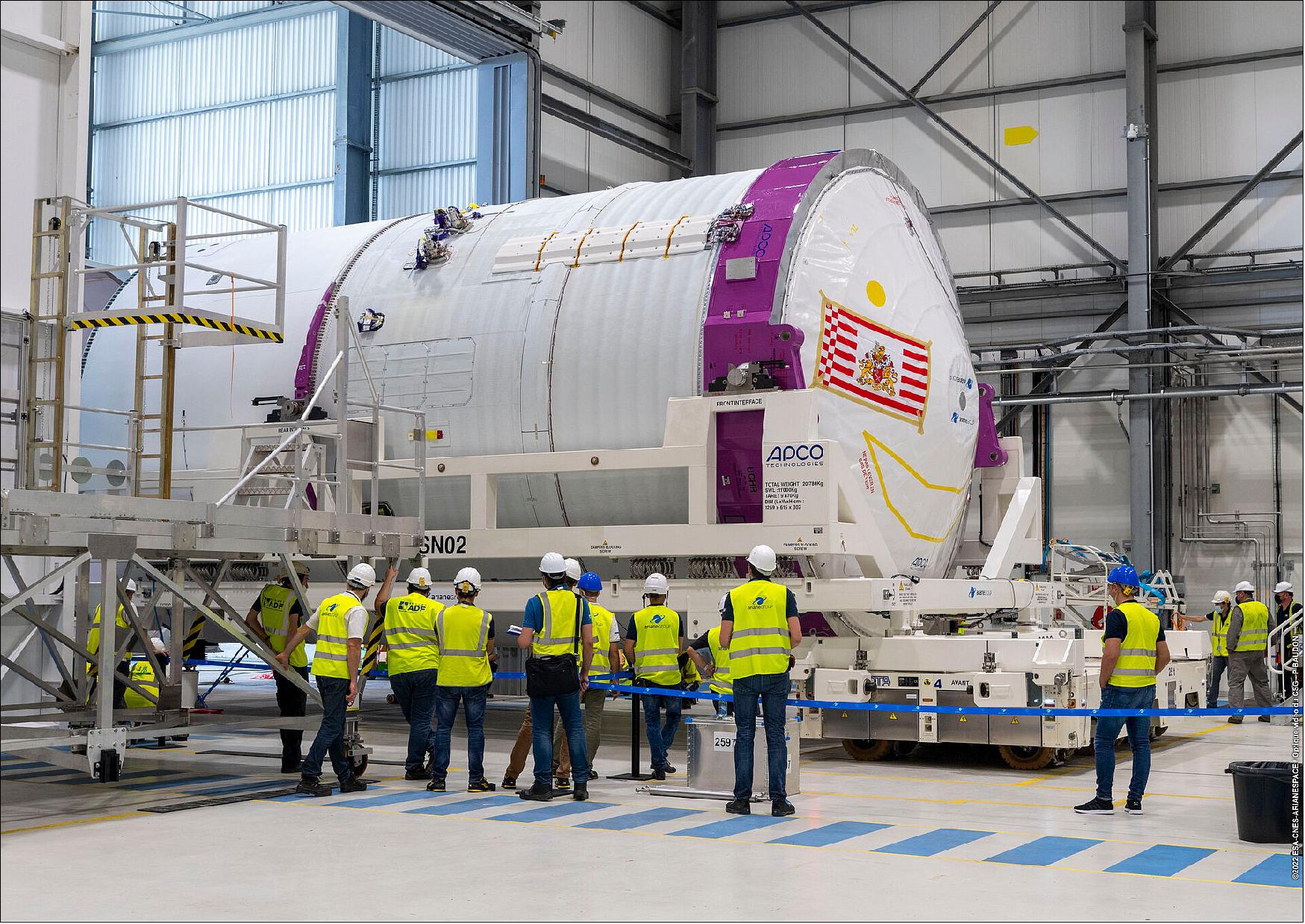
• January 18, 2022: The central core of ESA’s new generation Ariane 6 launch vehicle has arrived in French Guiana from Europe. This enables combined tests at Europe’s Spaceport where Ariane 6 parts will come together on the launch pad for the first time. 18)
- “To have Ariane 6 at Europe’s Spaceport is tremendously exciting. This is a major milestone, the culmination of intense preparation by ESA and partners in Europe and at Europe’s Spaceport, and an important step towards proving Ariane 6 is ready for flight,” commented Daniel Neuenschwander, ESA Director of Space Transportation.
- Ariane 6 will be capable of carrying out all types of missions to all orbits thanks to its multiple reignition capability and modular design. Using two or four boosters to suit the required performance, this new launch vehicle further extends and secures Europe’s independent access to space.
- Ariane 6’s central core comprises a lower stage and upper stage. The lower stage is from ArianeGroup’s Les Mureaux site in France; the upper stage is from ArianeGroup’s Bremen factory in Germany. They will be used in ‘combined’ tests which will verify all the interfaces and functions between the Ariane 6 launch vehicle and ground facilities at the spaceport.
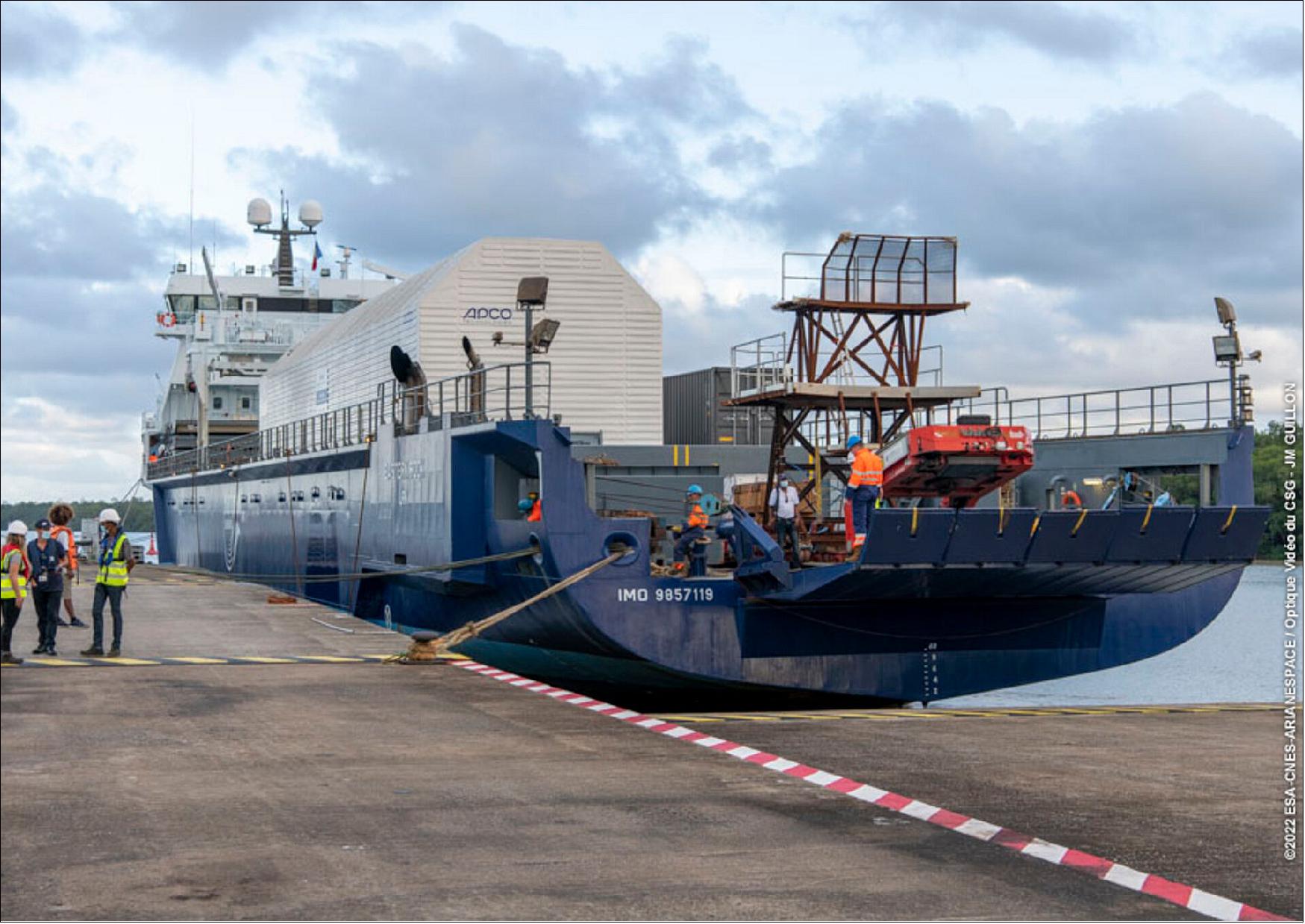
- Upon arrival by boat at Pariacabo harbour, the two containers were transported by road to the new Ariane 6 launch vehicle assembly building – part of the Ariane 6 launch complex at Europe’s Spaceport. Here, the rocket stages will be unpacked and installed on the assembly line machinery for integration, to form the Ariane 6 central core.
Combined Tests
- From arrival to hot-firing tests on the launch pad, operational procedures will follow as closely as possible those for any Ariane 6 launch campaign.
- First, the central core will be integrated horizontally inside the Ariane 6 launch vehicle assembly building then taken to the launch pad and raised vertical inside the mobile gantry. This is a major difference with respect to the current Ariane 5 launch campaign.
- The mobile gantry has moveable platforms so that engineers can access the whole vehicle for integration.
- Four mock-up solid rocket boosters will be strapped to the lower stage. These are the same weight and dimensions as the real boosters and enable engineers to practise the procedures and test the equipment.
- The hot firing test of the Ariane 6’s lower stage Vulcain 2.1 engine will follow a special set of operations on the Ariane 6 launch pad which has been adapted for use as a test bench. Ariane 6’s lower stage Vulcain 2.1 engine will be ignited several times, but Ariane will not lift off during tests.
- The flight software and tank filling and draining operations will be tested too. These are vital to ensure a safe launch sequence, whether it is nominal or interrupted.
- While some elements of the launch pad infrastructure are unfinished, the risky and complex tests of the ground systems have been previously completed and the new Ariane 6 launch complex was inaugurated last year.
Tests in Mainland Europe
- Meanwhile, a further complete Ariane 6 upper stage is being prepared for hot-fire tests at the DLR German Aerospace Center in Lampoldshausen, Germany. Tests inside a special facility will mimic the conditions of space and verify the innovative systems which enhance the versatility of Ariane 6.
- Further tests at ESA’s Technical Centre in the Netherlands, ESTEC, will include separation tests of the lower and upper stage.
• January 7, 2022: Tour the new launch complex for Ariane 6 at Europe's Spaceport in French Guiana. 19)
- First, enter the launch vehicle assembly building which is 20 m tall, 112 m long, and 41 m wide, located a kilometer away from the launch zone. It is used for horizontal integration and preparation of the central core of Ariane 6 – its main stage and upper stage – before it is rolled out to the launch zone.
- The hydrogen and oxygen storage facilities connect to the launch pad via underground pipes as part of the launch support systems.
- The 8200 ton 90 meter-high mobile gantry rolls on rails. Its platforms enable engineers to access the vehicle for integration of the boosters around the core stage and for mounting the fairing containing the payload on top of the upper stage. This steel mobile gantry protects Ariane 6 before launch and is rolled back prior to liftoff.
- At the entrance of the gantry is a mockup Ariane 6 P120C rocket booster. This is representative of one of the real boosters, having the same size and mass but filled with water instead of solid propellant and used in mechanical tests.
- Four lightning protection masts, and a water tower for the deluge system are also part of the launch pad.
• December 16, 2021: ESA’s Vega-C launch vehicle will fly in the second quarter of 2022 offering more performance to all orbits and extended mission flexibility at a similar cost to the current Vega. A new contract aims to widen these mission capabilities to capture new opportunities and satisfy emerging market needs to 2027. 20)
- The ESA–Avio contract is worth €51 million over two and a half years. The signature event in Paris on 15 December was attended by Daniel Neuenschwander, ESA’s Director of Space Transportation, and Maurizio Cutroni, Avio’s CCO, on behalf of Guilio Ranzo, CEO at Avio.
- “ESA reaches forwards to strengthen future access to space for Europe. This contract for Vega-C contributes to enhance flexibility of the services to the customer and ensures increased competitiveness of our developments,” said Daniel Neuenschwander, Director of Space Transportation at ESA.
- Under this contract, Avio as prime contractor to ESA for the Vega and Vega-C launcher systems will work with industrial partners to put into action a series of improvements intended to enable Vega-C to meet a wider range of market needs.
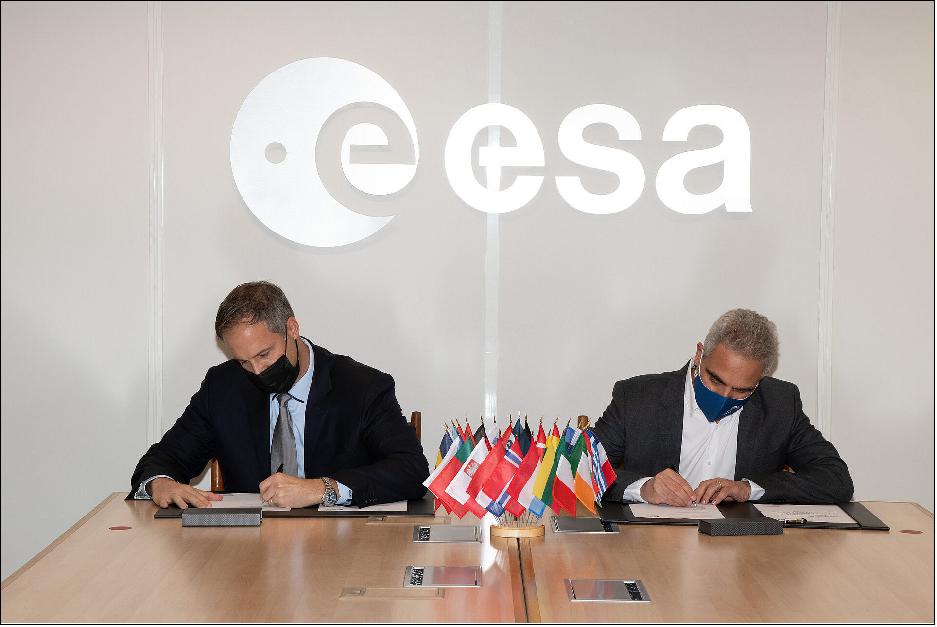
- These developments will also reduce launch service costs and comply with the payload allocation policy approved by the ESA Council, through the achievement, in the short term, of three major high-level objectives.
- The activities are intended to reduce the main production and operation tasks thereby decreasing the launcher system cost by 10% and therefore the Vega-C launch service cost. In particular, it is planned to cut manufacturing costs for mechanical subsystems and components as well as optimise mission preparation and the launch campaign duration.
- A wider range of missions will be possible by increasing the launch system performance margins giving higher mission flexibility, still complementary to the Ariane 6 launch system, to cope with specific missions needs and constraints.
- Increasing versatility of the Vega-C launch system services is expected by offering ad-hoc launch services solutions based on a portfolio of available products, including small spacecraft mission services and dual-launch services.
- “Avio and ESA have identified and consolidated areas to further increase Vega-C competitiveness during the lead up to commercial exploitation. I thank supporting Member States, the Italian Space Agency and our partners for their trust in Avio,” said Maurizio Cutroni, Chief Commercial Officer at Avio.
• December 1, 2021: Recently completed tests of two propellant tanks set a first technological milestone in the ESA reusability roadmap towards the demonstration of a reusable first stage vehicle called Themis. 21)
- Through the Themis program, ESA aims to assess the economic value of reusability for Europe while investing in new technologies for potential use in ESA’s future fleet of launch vehicles.
- The Themis experimental approach promotes learning by hardware testing. This Agile methodology focuses on activities of greatest value and works to short timescales.
- To accelerate development, technologies are being tested early in the development cycle. As part of this, prime contractor ArianeGroup recently performed six tests in Vernon, France, to validate the fluidic and electrical processes and sequences for the correct operation of two test propellant tanks. During these tests the tanks were filled then drained of cryogenic propellants.
- This initial phase of the Themis project involves the preparation of the flight vehicle technologies alongside firing demonstrations of its reusable Prometheus engine. It also includes the preparation of the ground segment at the Esrange Space Center in Kiruna, Sweden, for the first hop-test flights and any associated refurbishment of the vehicle between flights.
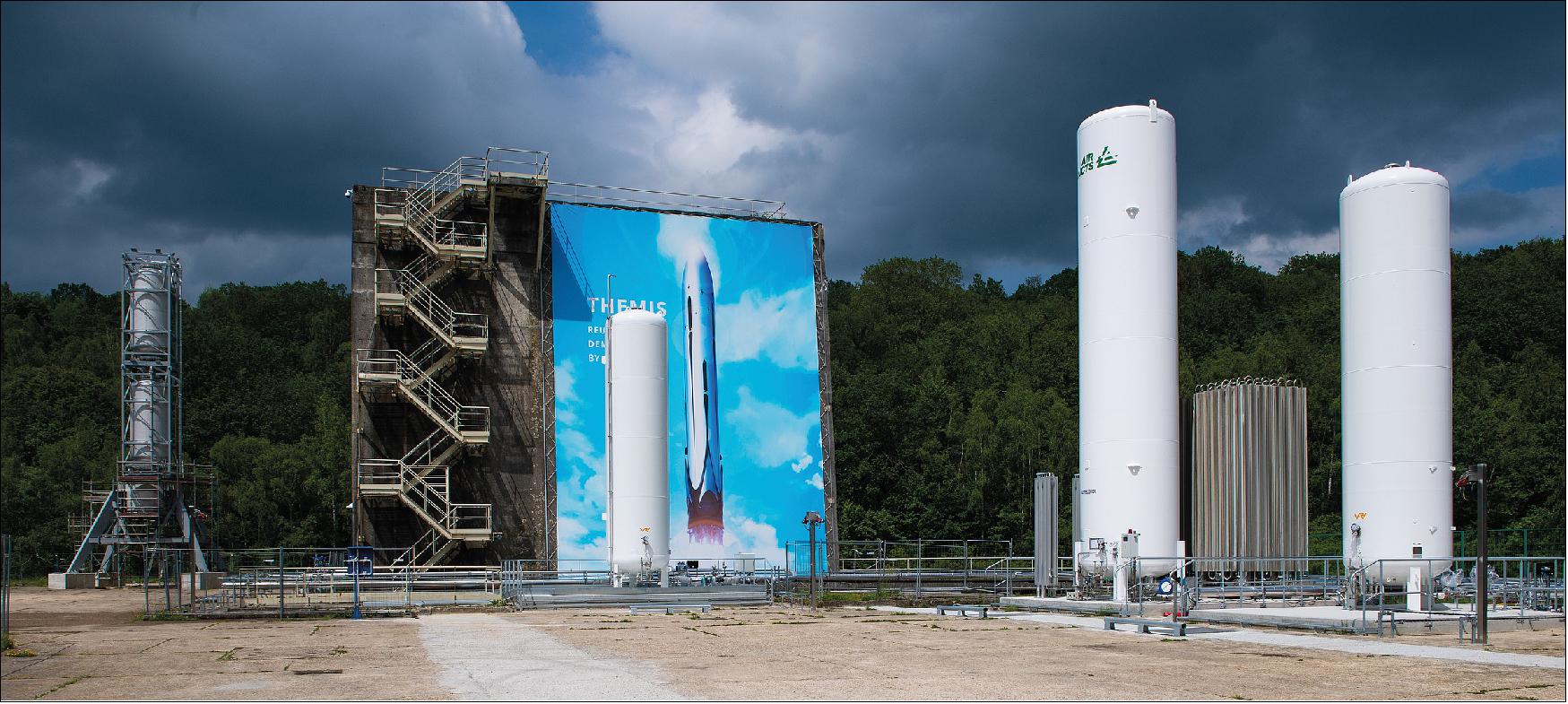
- The fluidic and electrical operations of these test cryogenic tanks and ground equipment have been validated ahead of time to de-risk hot firing tests with the Prometheus engine under integration on the same test bench.
- “This is an exciting time. In the next step for Themis, we will combine two key building blocks for the future of space transportation systems in Europe. Both are developed within ESA’s Future Launchers Preparatory Program. Themis, ESA’s flagship reusable first stage vehicle and Prometheus, its next-generation low-cost reusable engine,” said Yann Tincelin, Space Transportation Systems Project Engineer at ESA.
- Prometheus is an ultra-low-cost engine built extensively through additive layer manufacturing. This has reduced the estimated cost of production by a factor of ten compared to Ariane 5’s core stage Vulcain engine. It features variable thrust and multiple ignitions and is therefore suitable for core and upper rocket stages.
- The fuel used for Prometheus is liquid oxygen–methane which is highly efficient, allows standardization and operational simplicity. Methane propellant is also widely available and easy to handle which will minimize ground operations before and after flight.
- Prometheus technologies are likely to be incorporated in improvements made to rocket engines currently in operation.
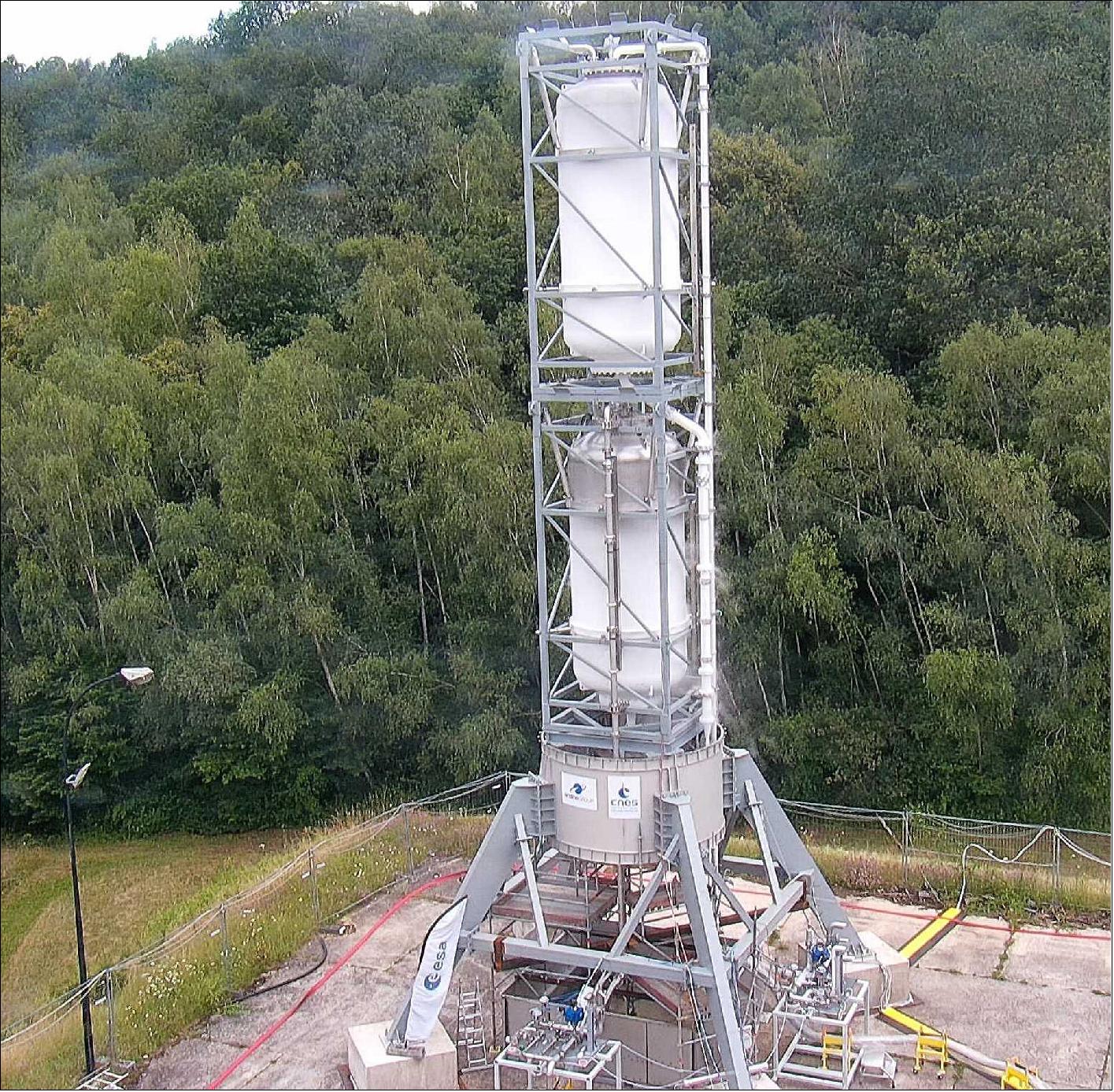
European Industry
- In parallel to the ongoing activities for ground hot firing tests, Themis flight demonstrators are also under preparation. A European ecosystem of industry partners is forging ahead to develop and manufacture components.
- Flight version steel cryogenic tanks are being manufactured. Low-cost optimized thrust vector actuation systems for Prometheus are being designed. The landing legs system has entered its final design stage before manufacture. All these enabling building blocks will come together for integration on the Themis flight demonstrator for low-altitude hop-tests in Kiruna, Sweden.
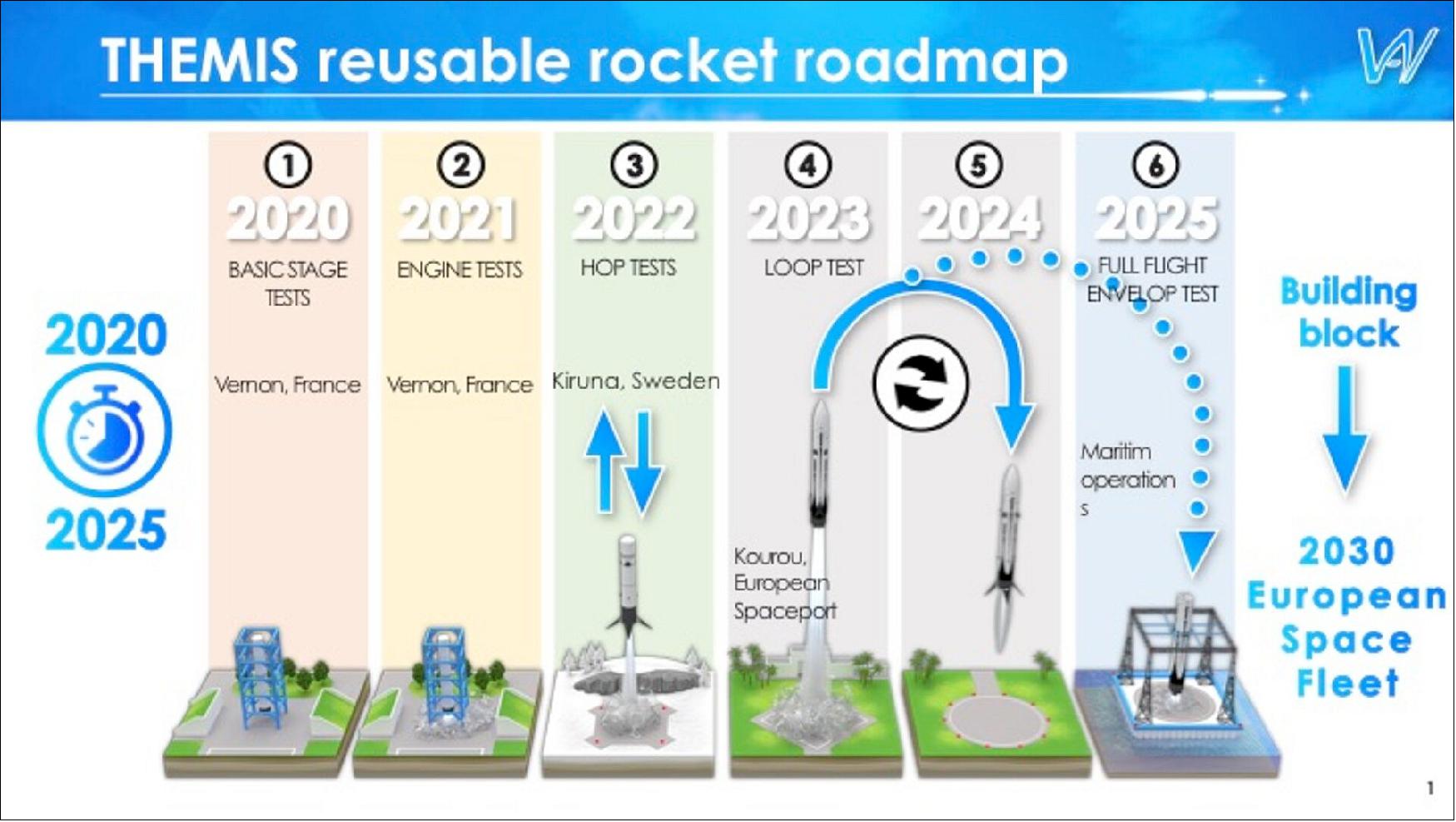
- Meanwhile, the final design of ‘Launch complex 3’ at Kiruna Esrange Space Center has been reviewed by the Swedish Space Center and ArianeGroup, to prepare for the first Themis hop-tests in Sweden in 2023.
- This incremental progress is built on early evaluation at each intermediate step with focus first on technical de-risking of Prometheus integration into a fully operational stage, then on flights increasingly representative of operational launch vehicles.
- The final steps will be flights from Europe’s Spaceport in French Guiana in 2025 to demonstrate ascent to high altitude, reentry, landing, refurbishment and reuse, with an integrated Themis demonstrator equipped with three Prometheus engines and all the required subsystems for enabling stage recovery.
• November 5, 2021: ESA offers an opportunity for payloads and experiments to ride on board the first flight of Ariane 6 planned in 2022. Notice of interest should reach ESA by 15 November. 22)
- For its first flight, Ariane 6 will be in the two-booster configuration with a short fairing. ESA will use a payload carrier able to host experiments totalling 80 kg and release payloads with an aggregated mass of 800 kg.
- Under the responsibility of ESA, this launch will serve to qualify the overall Ariane 6 system, including the vehicle, the ground infrastructure and operations from the launch campaign to the payload separation and then disposal of the upper module through reentry, minimizing space debris.
- This Announcement of Opportunity is open in priority, but not exclusively, to any European commercial and institutional candidate mission. Applications from ESA Member States participating in the Ariane 6 program will be given priority: Austria, Belgium, Czech Republic, France, Germany, Ireland, Italy, Netherlands, Norway, Romania, Spain, Sweden and Switzerland.
- Ariane 6 is a project managed and funded by the European Space Agency. ArianeGroup is design authority and industrial prime contractor for the launcher system. The French space agency CNES is prime contractor for the development of the Ariane 6 launch base at Europe’s Spaceport in French Guiana. Arianespace commercializes Ariane 6.
• October 13, 2021: Europe’s Spaceport in French Guiana is preparing for the arrival of Ariane 6, ESA’s new heavy-lift rocket. This involves the final preparations of the new Ariane 6 launch complex and all the systems necessary for a launch. 23)
- On the launch pad, two ‘cryo-arms’ made and tested in France have been attached to the upper end of the mast. They are part of the fluidic connection system which connects to the Ariane 6 upper stage.
- These ‘cryo arms’ support the upper umbilicals which supply the Ariane 6 upper stage with cryogenic top-up fuel, maintain the correct pressurization of the upper stage tanks, cool the engines before ignition and generally keep the upper stage in an optimal condition right up to the point of liftoff. The same umbilicals allow the fuel to be drained safely if a launch is aborted.
- Each arm is 13 m long and weighs 20 tons. One arm supplies liquid hydrogen at -250ºC, the other supplies liquid oxygen at -180ºC. When Ariane 6 lifts off, these arms will disconnect from the rocket and then pivot away quickly in just 2.6 seconds to avoid interfering with the rocket's ascent.
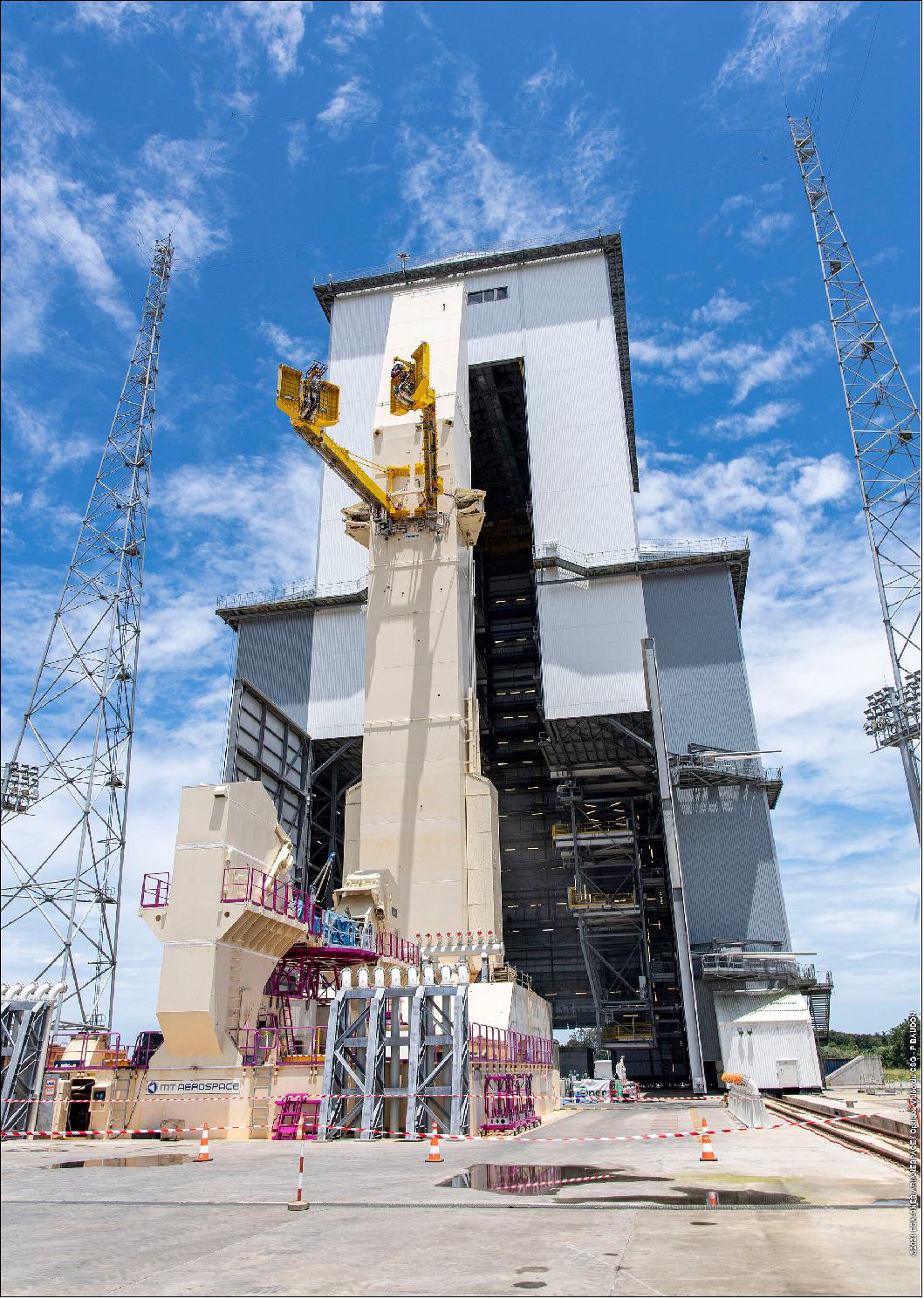
- This maneuver requires great precision in order, almost simultaneously, to disconnect the arms, protect the supply hoses from gas ejections from the boosters and allow the launch vehicle to pass while avoiding any contact with it. A 50-tonne counterweight inside the mast – as heavy as a humpback whale – speeds up the retraction of the arms. A smart damping system allows the arms to brake before the end of their swing backwards in order to preserve the mechanical links with the mast.
- Keeping the fluidic supplies connected with the rocket until the moment of liftoff guarantees the best availability and simplification of the interface with the launch vehicle.
- The disconnect time for Ariane 6 is much faster than for Ariane 5, which is six seconds before liftoff. This means that the sequence for Ariane 6 can be triggered at the latest possible moment in the countdown reducing the chance of unnecessary disconnects on an aborted launch.
- These articulated structures will now be tested with the mobile gantry fully retracted – as for a launch. They will repeat the tests performed in Fos-sur-Mer, France, but this time attached to the mast.
• September 28, 2021: The new launch complex built for Europe’s upcoming Ariane 6 rocket is inaugurated at Europe’s Spaceport in French Guiana. 24)
- With this, ESA celebrates another important milestone in the Ariane 6 roadmap as it forges ahead with combined tests between launch vehicle and launch base and preparations towards the first launch campaign.
- Clearly visible from space, the facilities feature remarkable complex structures above and below ground specially designed to support Ariane 6 launches into the next decade. It is the proud achievement of the French space agency, CNES – prime contractor to ESA for the development of the launch base, and its European industry partners.
- The Ariane 6 program is funded and developed by ESA. This new launch vehicle will replace Europe’s heavy-lift Ariane 5. Available in two versions, with either two or four boosters, Ariane 6 will offer more performance and flexibility than its predecessor. This opens new opportunities and guarantees continued access to space for ESA Member States.
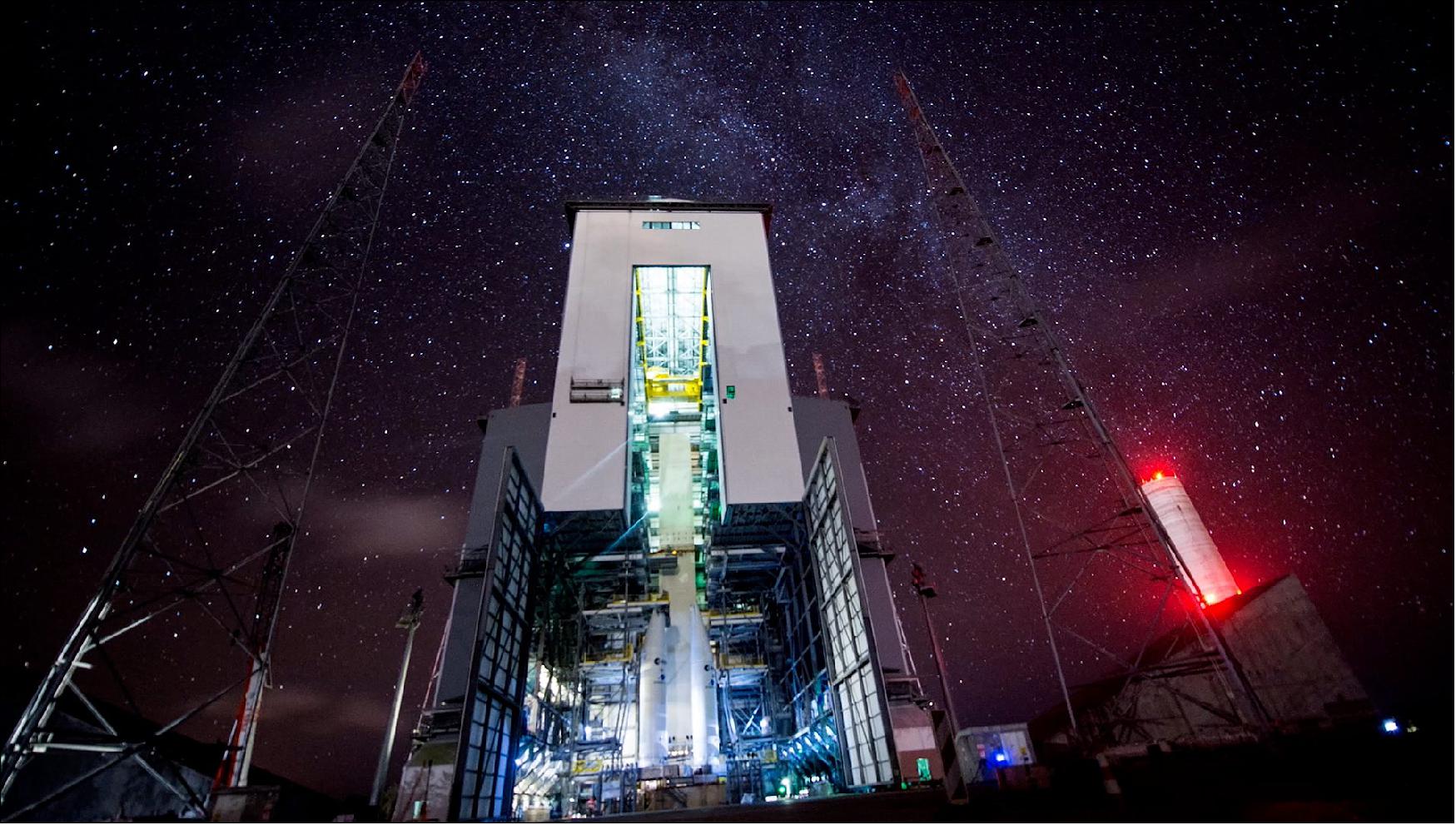
- The Ariane 6 launch complex is a marvel of engineering, designed to optimize the launch system performance and operations workflow. Its design benefits from lessons learned in the construction and operation of the existing Ariane, Vega and Soyuz launch complexes at the spaceport.
- The main elements include the launch pad with two exhaust ducts, the mobile gantry and the launch vehicle assembly building.
- The launch pad is 28.5 m deep and 200 m wide. Its basic structure was poured in concrete the volume of 67 Olympic-sized swimming pools. At its center is the launch table which weighs 700 tons and is 4 m high, 20 m long, and 18 m wide. This structure was built in Europe by MT Aerospace in Germany and shipped to Kourou for integration on the launch pad. Below ground it protects a host of support systems and will bear the weight of Ariane 6.
- Ariane 6’s final integration will take place inside a mobile gantry, just like Soyuz and Vega. The mobile gantry was manufactured in Europe by Eiffage Metal in Germany and was assembled at the spaceport. It will protect Ariane 6 on the launch table during each launch campaign.
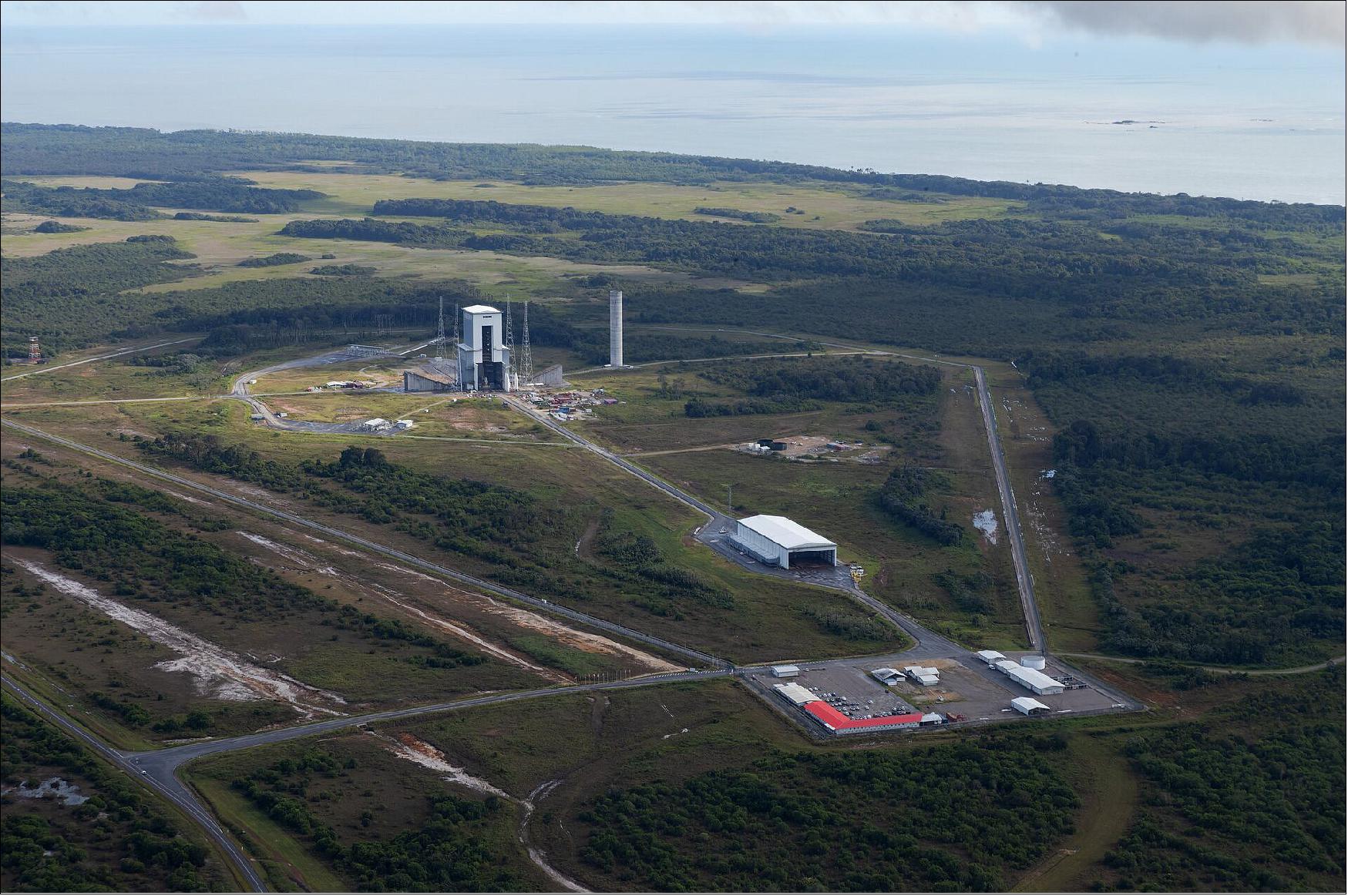
- This 90 m-high by 50 m-wide gantry weighs 8200 t – more than a thousand tons heavier than France's Eiffel Tower. Work platforms will enable engineers to access the vehicle levels to vertically position Ariane 6’s central core directly on the launch table, add two or four boosters depending on the launch configuration, and integrate the fairing that houses the payload. The gantry retracts 140 m on rails before launch. If the launch is delayed the gantry can be rolled back in place to allow access to Ariane 6 before its next launch attempt.
- The Ariane 6 core and upper stages will be integrated horizontally inside the launch vehicle assembly building and prepared for rollout to the launch zone. The building is 20 m tall, 112 m long and 41 m wide, some 1 km from the launch zone.
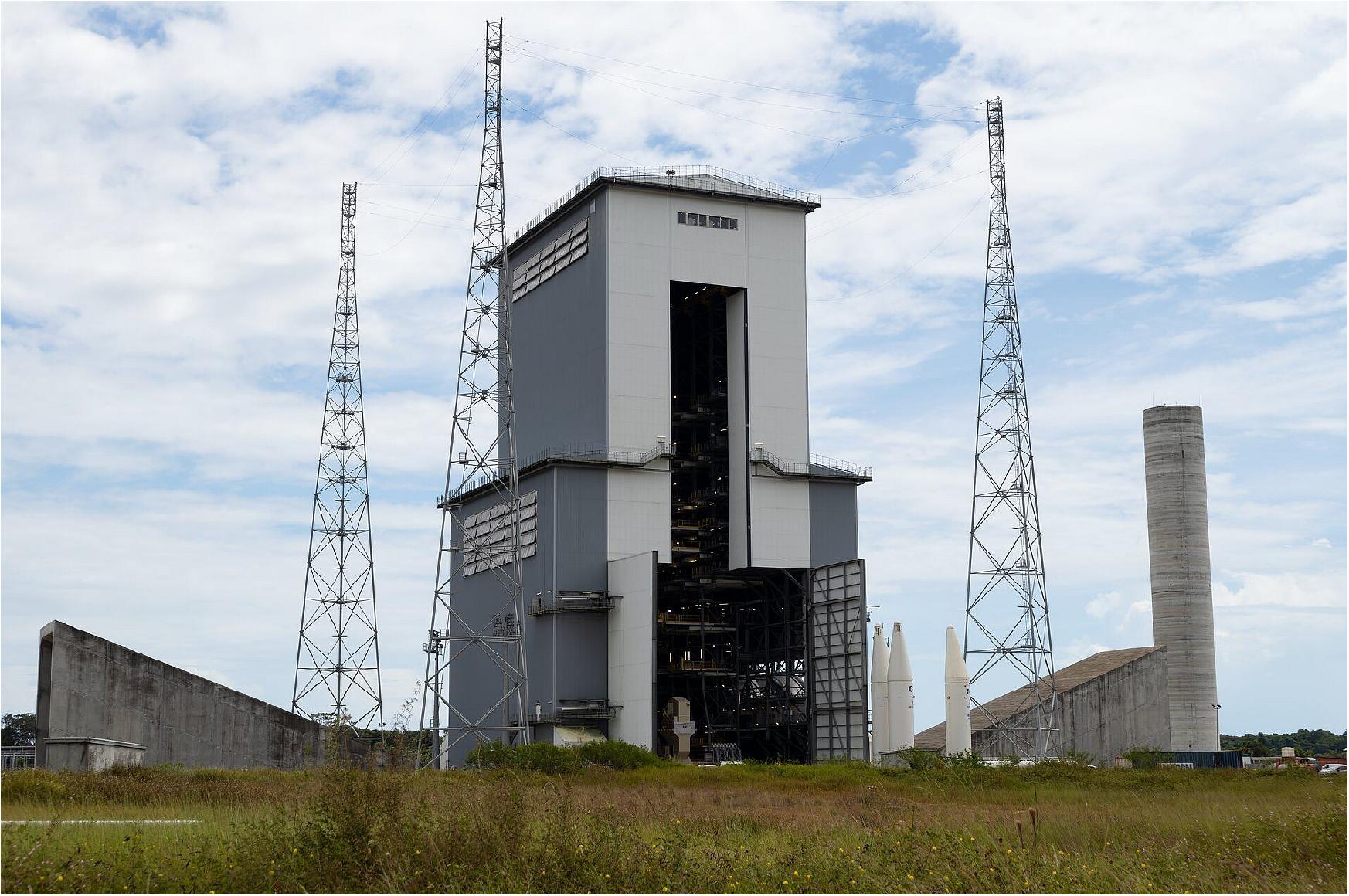
- Horizontal integration lowers the cost of facilities and launcher integration while offering a higher level of flexibility and growth potential and allowing easier access to the whole rocket. Overall, the improved Ariane 6 approach to integration and operations will reduce the duration of a launch campaign from months to weeks.
- ESA’s contract with CNES for the launch base development worth €600 million was signed in 2015. CNES allocated a third of this funding to infrastructure with notable involvement of local industry for construction, materials and equipment, and the remainder to contracts in mainland Europe.
- The systems that are part of the main launch complex structures are being qualified. For example, the deluge system which will protect Ariane 6 and ground installations from the acoustic energy created at liftoff was tested. The disconnection of the fluidic systems for Ariane 6 on the launch pad, tested in France, are now being tested on the launch pad. A central core mockup was used to test ground equipment and practise the maneuvers involved in a launch campaign. France’s space agency (CNES) and ArianeGroup teams jointly performed these tests under the responsibility of ESA.
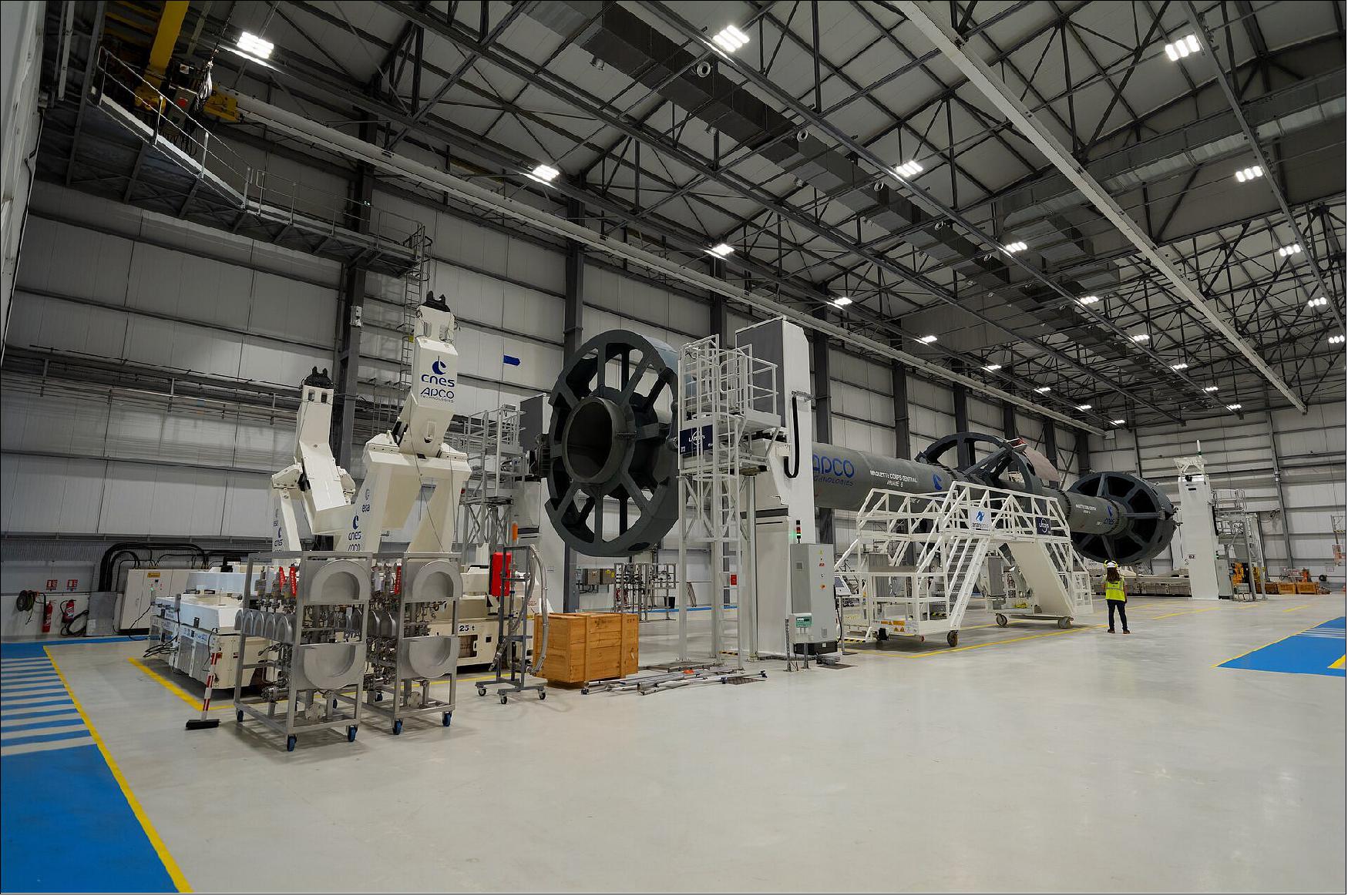
- “The Ariane 6 launch complex is a remarkable achievement and an icon of European cooperation and advancement. It represents a vital part of a program of intense activity at Europe’s Spaceport to prepare for the first flight of ESA’s next generation launch vehicle,” commented Daniel Neuenschwander, ESA Director of Space Transportation.
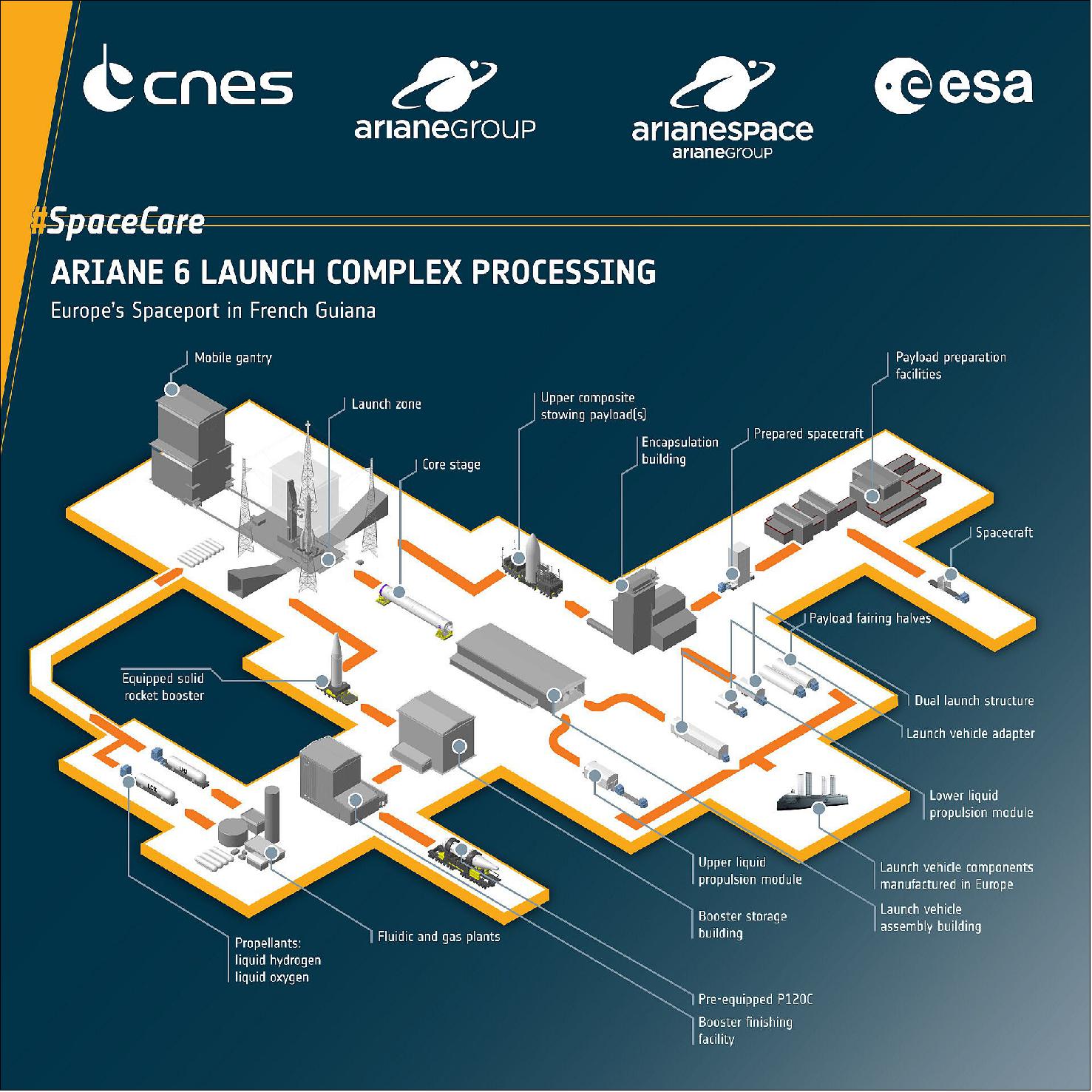
- The inauguration was held in the presence of Sébastien Lecornu, French Minister of the Overseas, Philippe Baptiste, President Director General of CNES, and Daniel Neuenschwander, ESA Director of Space Transportation. Also present were industry partners André-Hubert Roussel, CEO of ArianeGroup, Stéphane Israël, CEO of Arianespace, and Gabriel Serville, President of the Territorial Collectivity of French Guiana.
• September 3, 2021: ESA Member States have agreed upon the boundary conditions for Europe’s upcoming exploitation of Ariane 6 and Vega-C and request ESA to propose a roadmap for new and innovative space transportation solutions for the next decade and a framework for associated short cycle demonstrations. 25)
- The Resolution agreed upon by ESA Member States mid-August sets the conditions for the first three years of stabilized exploitation of Europe’s new launch vehicles, Ariane 6 and Vega-C at Europe’s Spaceport in French Guiana.
- Driven by the launch needs of European institutions and taking stock of the volatile context of the worldwide launch services market, Member States have converged on a stable and secure basis for the exploitation of these new launch vehicles to provide guaranteed access to space for Europe in the coming years.
- The revised stabilized exploitation model is based on a European institutional launch service demand of four Ariane 6 vehicles (three Ariane 62 with two boosters and one Ariane 64 with four boosters, or two positions on a dual payload launch on Ariane 64) and two Vega-C per year on average. Price conditions for the associated standard launch service have also been agreed upon.
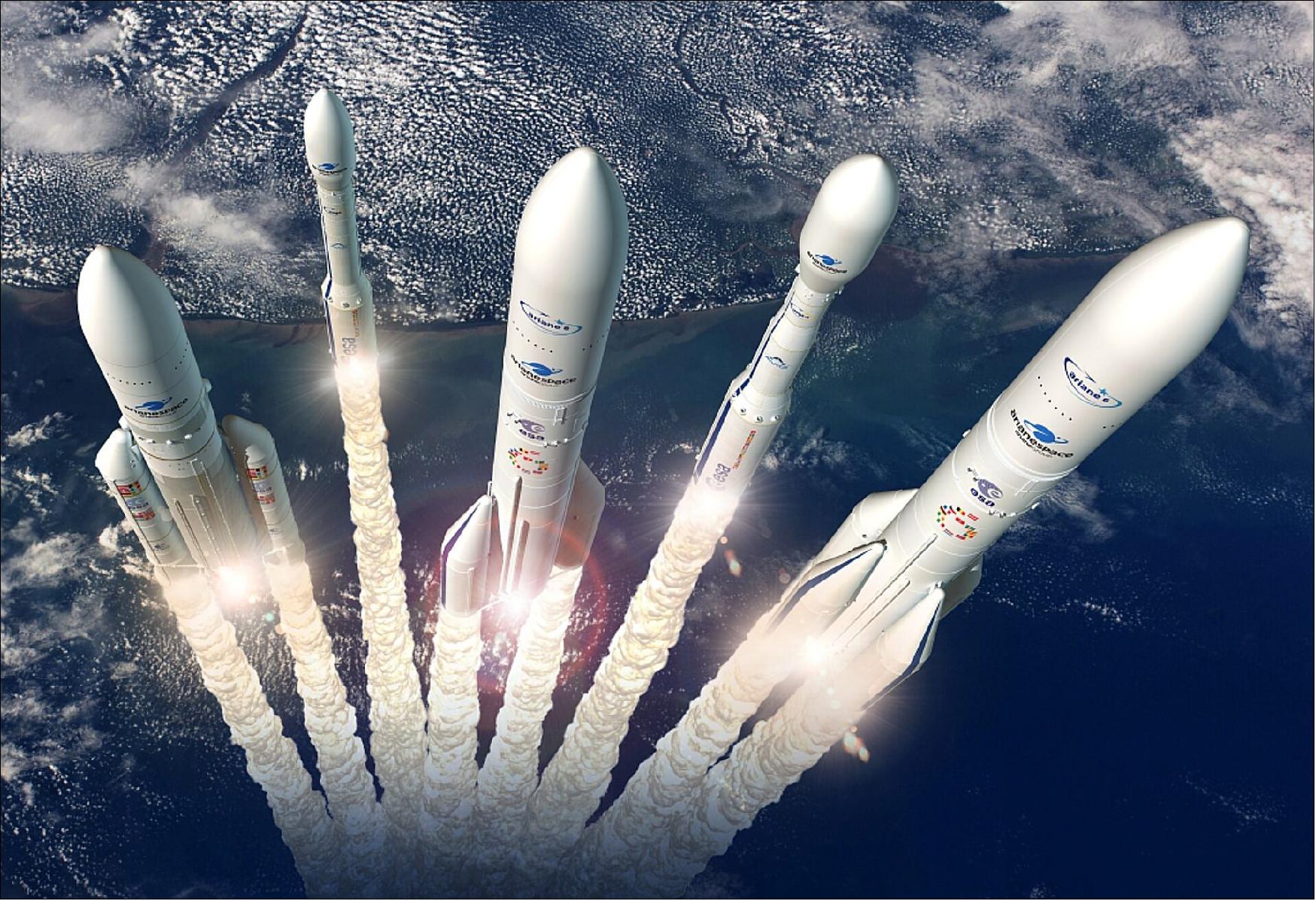
- Member States have also established a basis for maintaining strategic industrial capabilities through options to serve either additional institutional launches or a higher commercial demand. Corresponding financial decisions by Member States are planned to be taken at the occasion of the Council Meeting at Ministerial Level at the end of 2022. European institutional customers of launch services will also need to commit to launch on ESA-developed launchers.
- In addition, the ESA Council also requested the ESA Director General to agree with the European Union on a European flight ticket initiative to regularly demonstrate and validate in orbit missions of less than 200 kg on launch services with proven capabilities to be selected on a competitive basis.
- To prepare for the future, ESA Member States have further tasked ESA to propose the next generation of European space transportation solutions required for the next decade. To that end, ESA is asked to create a frame for short-cycle demonstration of such space transportation solutions for approval at the occasion of the upcoming Council Meeting at Ministerial Level. Preparation is under way including through ESA’s New European Space Transportation Solutions initiative (NESTS) initial studies.
- “Considering the continuously changing space transportation market, the agreed boundary conditions ensure a stable reference for the successful exploitation of Ariane 6 and Vega-C to serve European institutional needs and the commercial market.
- “At the same time, Member States have given ESA the important mandate to propose a roadmap for new and innovative European space transportation solutions for the next decade and beyond. In addition, we will work, together with the European Union to foster regular opportunities for small missions to be launched on flight-proven European launch vehicles, selected on a competitive basis,” commented Daniel Neuenschwander, ESA Director of Space Transportation.
• July 28, 2021: Future rockets could fly with tanks made of lightweight carbon fibre reinforced plastic thanks to ground-breaking research carried out within ESA’s Future Launchers Preparatory Program. 26)
- Building on earlier studies, MT Aerospace in Germany has demonstrated a novel design of a small scale tank made of a unique carbon-fibre reinforced plastic (CFRP) that is not only leak-proof with liquid hydrogen, but also compatible with liquid oxygen, without the use of a metal liner.
- A tank made solely of CFRP is much lighter than metal, requires fewer parts and is therefore faster and cheaper to manufacture.
- This is a milestone achievement as normally, storage of cryogenic propellants such as these which are cooled to -253ºC requires tanks with metallic liners to make them leak-proof, with or without a composite overwrap.
- “Fuel tanks are safety-critical elements in any propulsion system,” explained Hans Steininger, CEO at MT Aerospace. “We have provided proof that a high-performance pressure tank made of CFRP can withstand cryogenic stress. In the future, the use of CFRP high-performance tanks should not only enable safe rocket launches, it can also exploit the advantage of significantly lower mass compared to metallic tanks.”
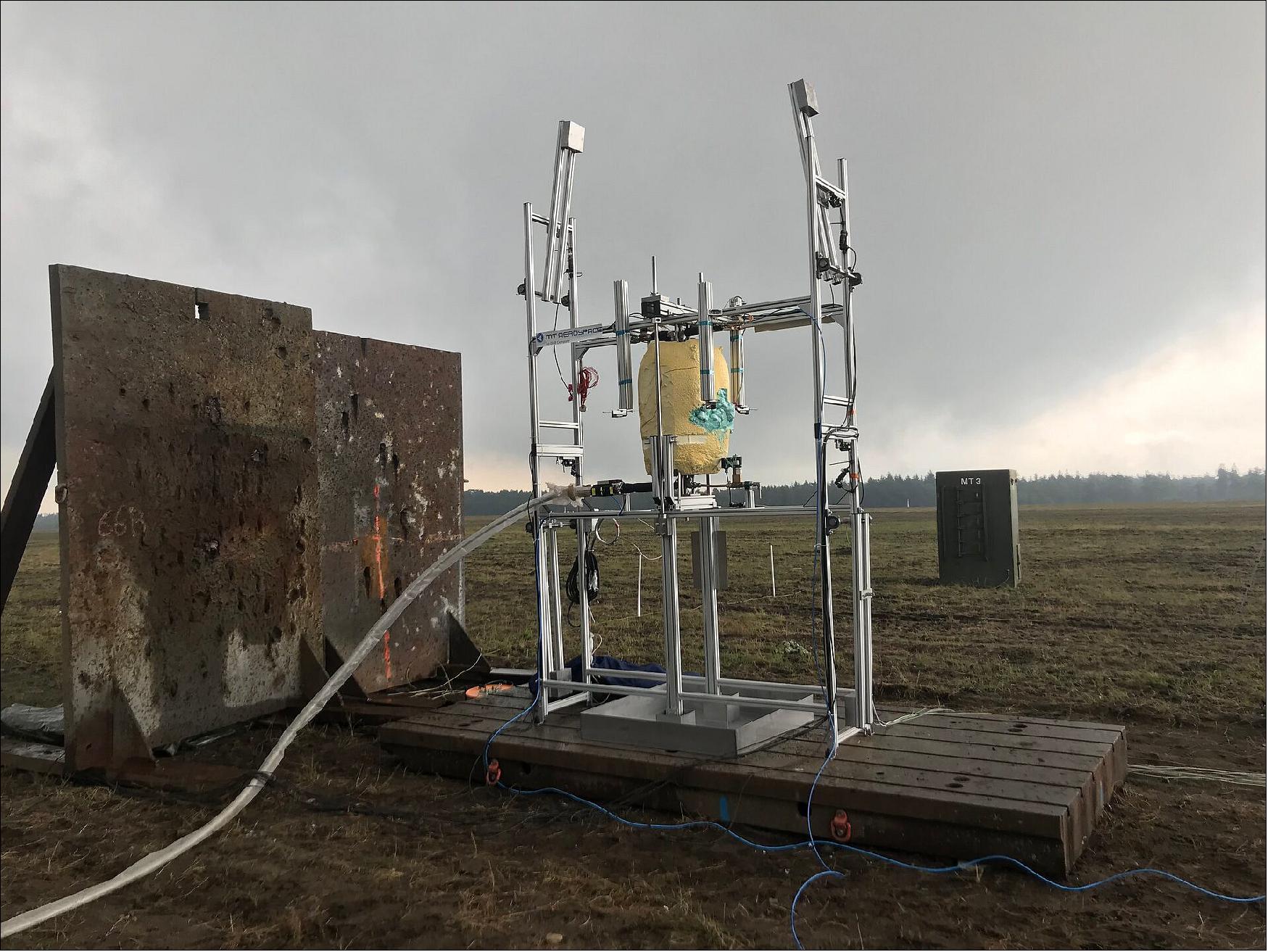
- “This is a tremendous step forward. We have found a very specific carbon composite and processing method that will allow us to consider new architectures and combinations of functions for rocket upper stages which are not possible using metal,” added Kate Underhill, Upper stage and propulsion demonstrators project manager in the Future Launchers Preparatory Program at ESA.
- “Metal is leak-tight. To recreate the same property with carbon composite required a complex weave of black carbon fibre and a special resin. The material resisted cryogenic temperatures, pressure cycles and reactive substances over a number of separate tests.”
- Following these ‘bottle’ tests, small-scale tank demonstrators with integrated thermal protection will soon be built for further tests. Data collected will feed into development of a full-scale demonstrator of a future highly-optimized upper stage, called Phoebus (Figure 99).
- Phoebus will have 3.5m diameter hydrogen and oxygen tanks, thermal protection, structural assembly elements and feature new technologies in avionics, structures and propulsion equipment. CFRP will be applied in the tanks, the interface structure between the two tanks and the outside cylinder representative of the upper stage outer skin.
- The Phoebus demonstrator will be tested with cryogenic fluids in 2023 to confirm the functional performance of the technologies and new cost-efficient production methods as part of a new contract to advance the development of highly optimized upper stages.
- “Here is an excellent example of how ESA’s support to mature cutting-edge technologies leads to major breakthroughs. This new lightweight carbon-based material would allow the manufacture of an Ariane 6 upper stage that is two tonnes lighter – mass made free for payloads,” said Daniel Neuenschwander, ESA Director of Space Transportation.
- The Phoebus project is a joint initiative by MT Aerospace and ArianeGroup in Germany to validate key technologies developed with support from ESA since May 2019.
• July 21, 2021: ESA will further increase the competitiveness and environmental sustainability of Europe’s Vega launch system beyond 2025 through a contract signed with Avio in Italy. 27)
- Vega operates from Europe’s Spaceport in French Guiana to launch light satellites to one or multiple orbits in a single launch. This contract takes Vega a step further and marks the start of a new phase in preparation of a new Vega launch vehicle called Vega-E, which will make extensive use of Vega-C building blocks.
- The objective with Vega-E is to further increase the competitiveness and performance of Vega-C – which is planned to have its first flight in 2022. This will increase its flexibility in terms of payload mass and volume and reduce the launch service cost and globally the cost of launch per kilo offered in the market.
- The key for achieving these objectives is the use of new technologies for a completely new upper stage, featuring a new low-cost liquid-fuelled engine.
- “This contract takes Vega a step further having at its heart the new M10 liquid oxygen–methane cryogenic engine, which will further increase its competitiveness, performance and sustainability,” said Daniel Neuenschwander, ESA Director of Space Transportation.
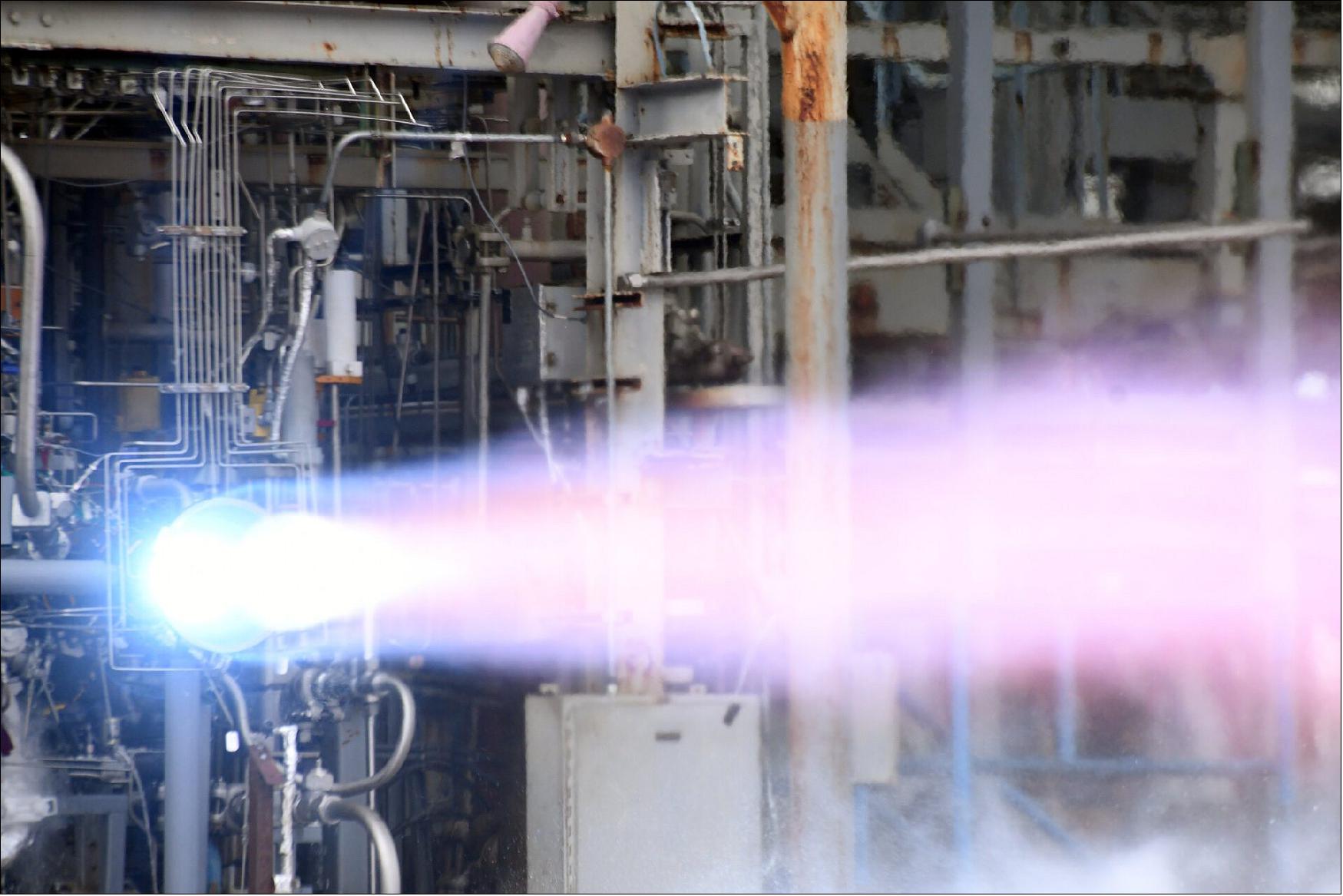
- Vega-E will have three stages unlike Vega-C which has four. Two stages will be derived from Vega-C: the first stage P120C solid rocket motor which provides the thrust at liftoff and the second stage solid rocket Zefiro-40 motor. The new third stage is the liquid oxygen–methane cryogenic upper stage which is the core of the Vega-E preparation.
- “Vega-E’s upper stage will replace the third stage Zefiro 9 solid-propellant motor and the fourth stage upper AVUM of the current Vega configuration. This will have a beneficial effect on performance and cost,” explained Renato Lafranconi, Vega programs manager at ESA.
- Vega-E’s upper stage will improve mission flexibility through its new M10 expander cycle engine with multiple reignition capability. The fullscale 3D-printed thrust chamber assembly of the M10 passed its first series of hot firing tests last year which also qualified new efficient manufacturing methods.
- “The reduction of emissions and combustion waste makes the introduction of the M10 engine a further improvement in environmental sustainability which is a driver for the future of Vega,” added Adriana Sirbi, Vega Evolution Preparation Manager at ESA.
- Industries and universities from eleven countries are involved in the preparation of the Vega-E launch system, and will contribute to the success of this European rocket. Prime contractor, Avio, with partners will further define the launcher system and its subsystems as well as the preliminary design of the Vega-E launch pad and the associated infrastructure at Europe’s Spaceport in French Guiana.
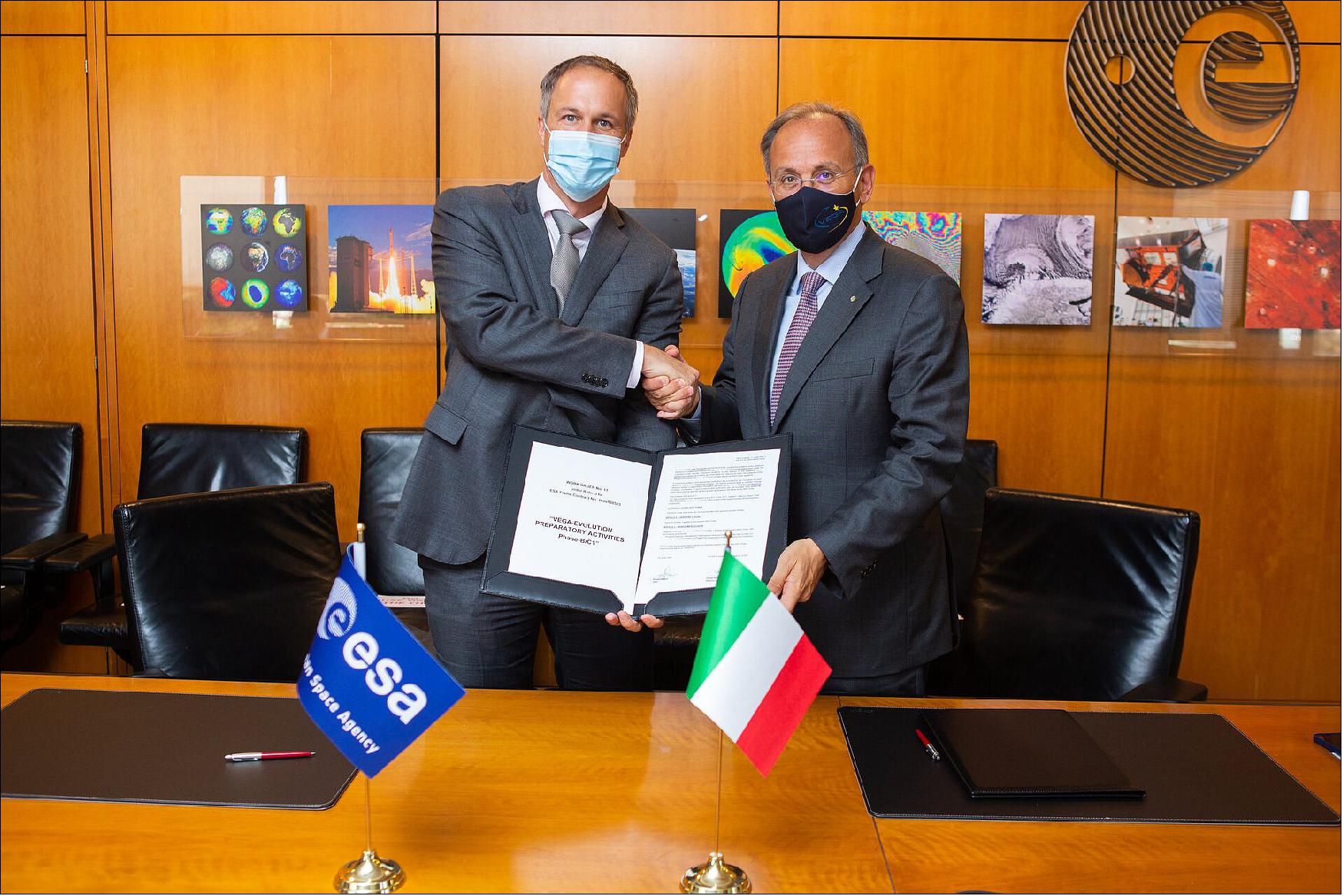
• July 13, 2021: ESA will enhance the versatility of Europe’s Ariane 6 rocket with a kick stage called Astris in a €90 m development contract with prime contractor, ArianeGroup. This is part of ESA’s strategy to extend Ariane 6’s capabilities to serve a wider range of space transportation requirements. 28)
- Astris is planned to fly by mid 2024 as an optional add-on to Ariane 6’s upper stage and will interface directly with the payload. This will enable Ariane 6 to offer a range of new space transportation services by allowing complex orbital transfers.
- Astris will simplify missions by taking over some of the required built-in propulsion capabilities of payloads to move themselves to their final position in orbit. This will reduce the burden on satellite manufacturers to factor this into their design.
- The modular architecture of Astris makes it versatile, giving potential for even more capabilities. Structures will include a flight proven family of propellant tanks. This approach makes it possible to develop mission specific kits that offer a tailored solution to each customer.
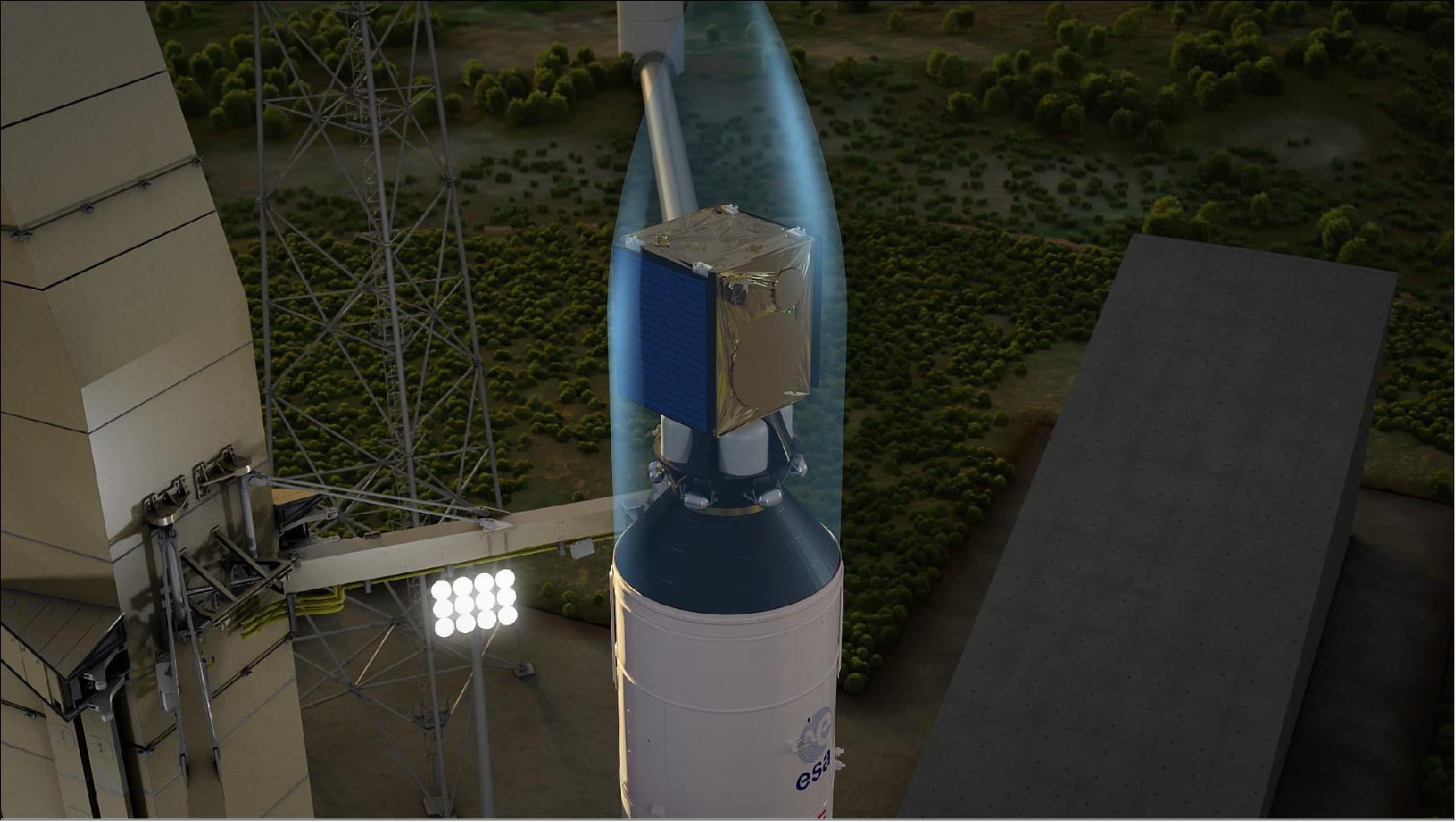
- Future space missions, especially for telecommunications applications and space exploration, could use Astris to reduce mission cost and risk. ESA’s Hera spacecraft, a planetary defence mission to the Didymos asteroid system, is set to be the first to benefit.
- “ESA’s Astris kick stage is a major development to ensure that Ariane 6 can serve the widest possible range of present and future space transportation requirements. It is an important element to enable flexible in-space transportation services, such as space logistics, in-orbit servicing and specific exploration missions,” commented Daniel Neuenschwander, ESA Director of Space Transportation.
- “From the beginning of the Ariane 6 program, the launcher was designed to be scalable and incorporate innovations throughout its operating cycle. This contract rewards the expertise and innovation capacity of our Bremen site in the field of launcher upper stages, while our teams near Munich are currently developing the new Berta engine. By pooling our skills, this project further strengthens Germany’s role in the new European launcher, Ariane 6,” added Pierre Godart, CEO at ArianeGroup in Germany.
- Through Astris, Ariane 6 could enable deep space exploration for ridesharing payloads with destinations such as asteroids, the Moon and Mars. The Astris concept will make objects in the Solar System more accessible to a wider range of payloads.
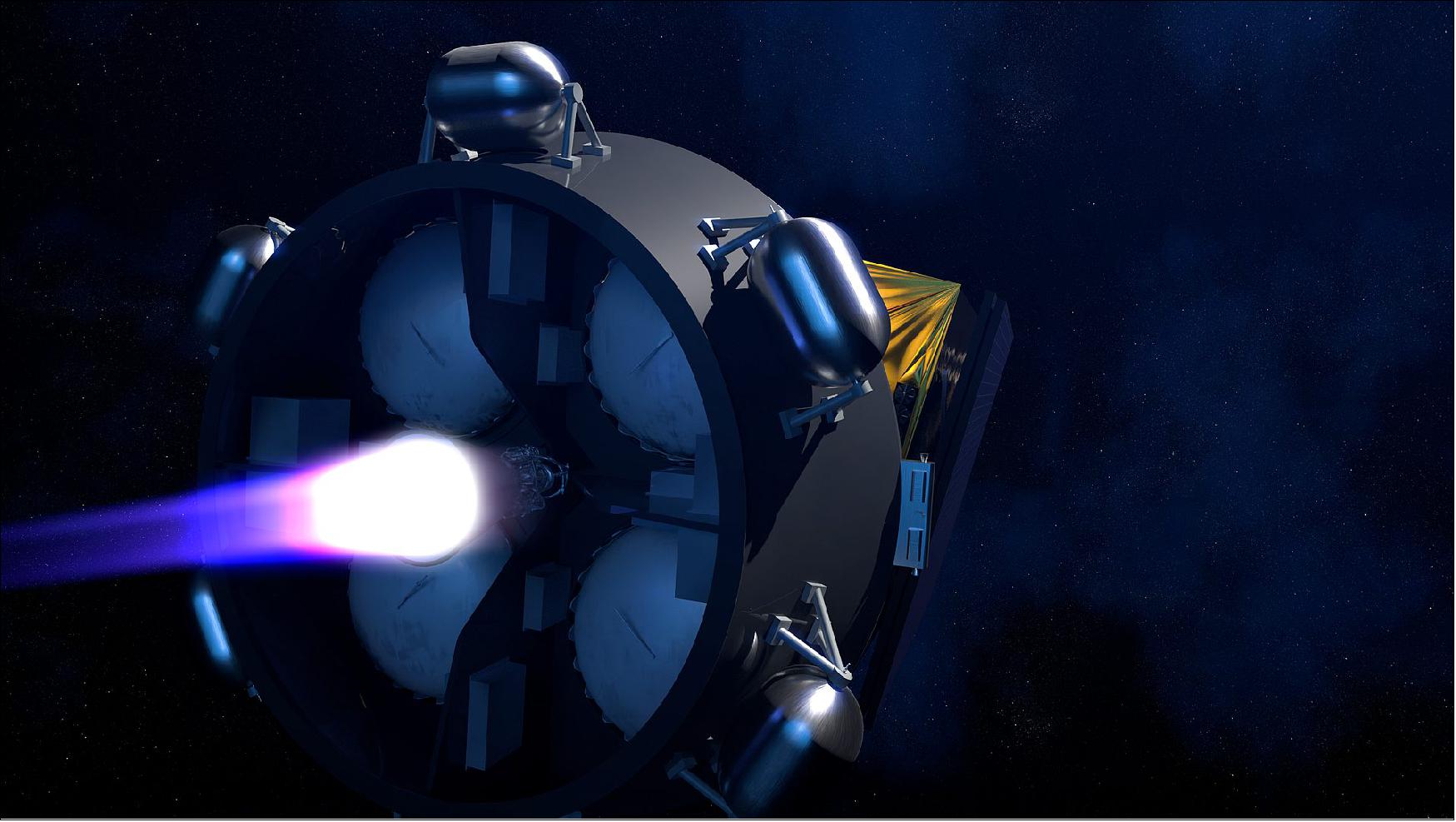
- Closer to Earth, Astris will augment Ariane 6’s ability to deploy multiple payloads into separate low Earth orbits on a single launch.
- Alternatively, Ariane 6 could place one payload in a transfer orbit then Astris would separate from the upper stage to take a second payload directly into its final position in geostationary orbit.
- The Berta engine, a mid-size storable propellant propulsion system for Astris is in development and qualification at ArianeGroup in Ottobrunn, Germany, carried out within ESA’s Future Launchers Preparatory Program (FLPP). This type of engine can be reliably reignited several times, making it particularly suitable for extended missions or for transport to different orbits.
- Activities for the Astris kick stage are carried out within ESA’s Ariane 6 Competitiveness Improvement Program. It anticipates future space transportation needs and works with industry to create solutions to ensure Europe remains competitive in the global market.
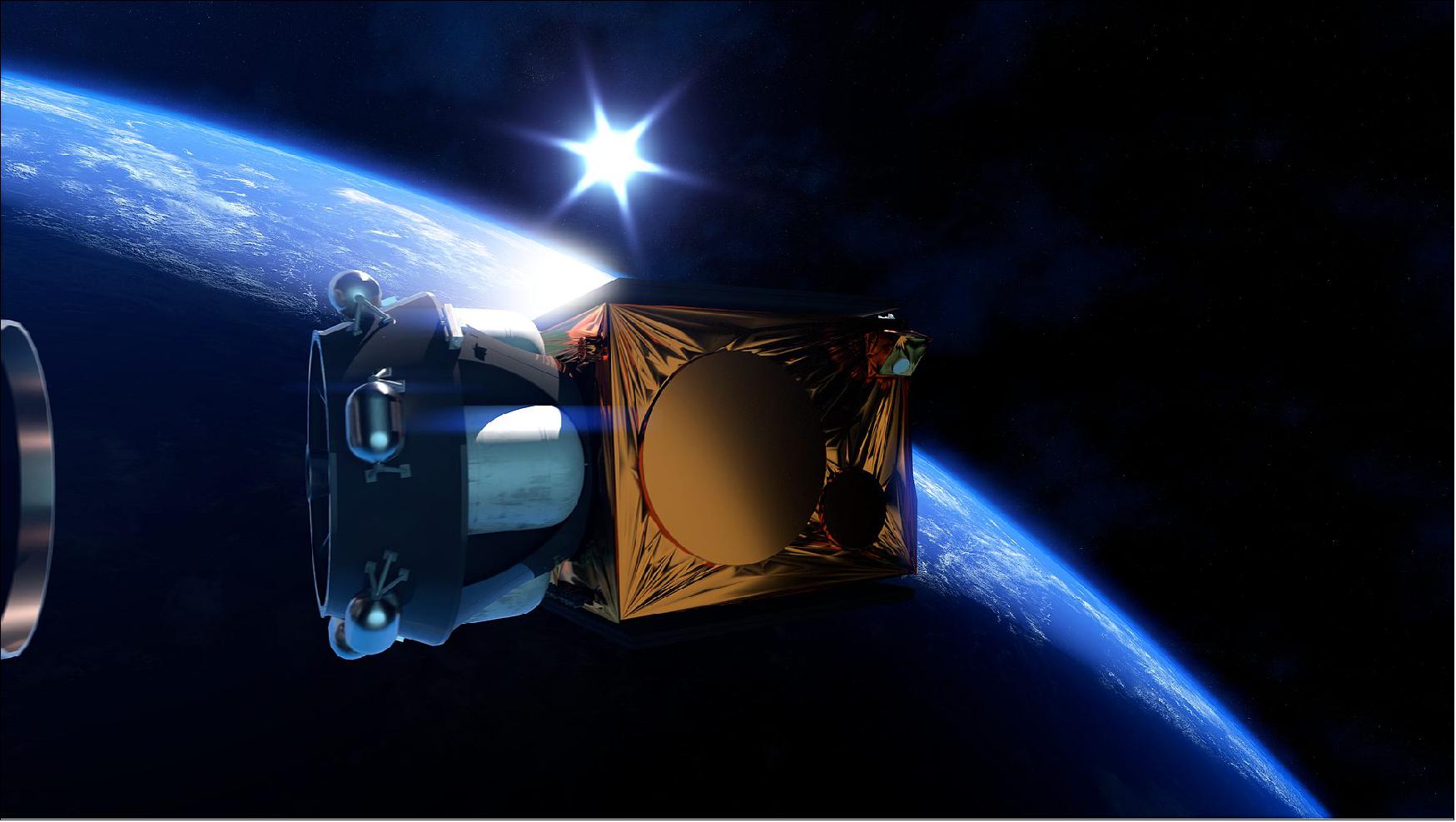
• May 6, 2021: Europe’s Spaceport in French Guiana is carrying out combined tests to prepare for the arrival of Ariane 6, Europe’s next generation heavy-lift launch vehicle. 29)
- The first Ariane 6 fairing has already arrived at the Spaceport from Europe. It is 20 m high and 5.4 m in diameter and is being integrated with a mockup payload to test equipment and procedures inside the assembly building.
- RUAG Space in Emmen, Switzerland manufactures each entire large half-shell in one piece from carbon-fibre composite which is ‘cured’ in an industrial oven. This reduces cost and speeds up production. Fewer parts allow horizontal as well as vertical assembly of the closed fairing and the launch vehicle, which is particularly important for Ariane 6.
- A blue metal scaffold on the right of the picture, called the ‘strongback’, encases the fairing. There is one for each half-shell to hold each steady and to maintain the shape of the fairing while it is being raised vertical, and during assembly.
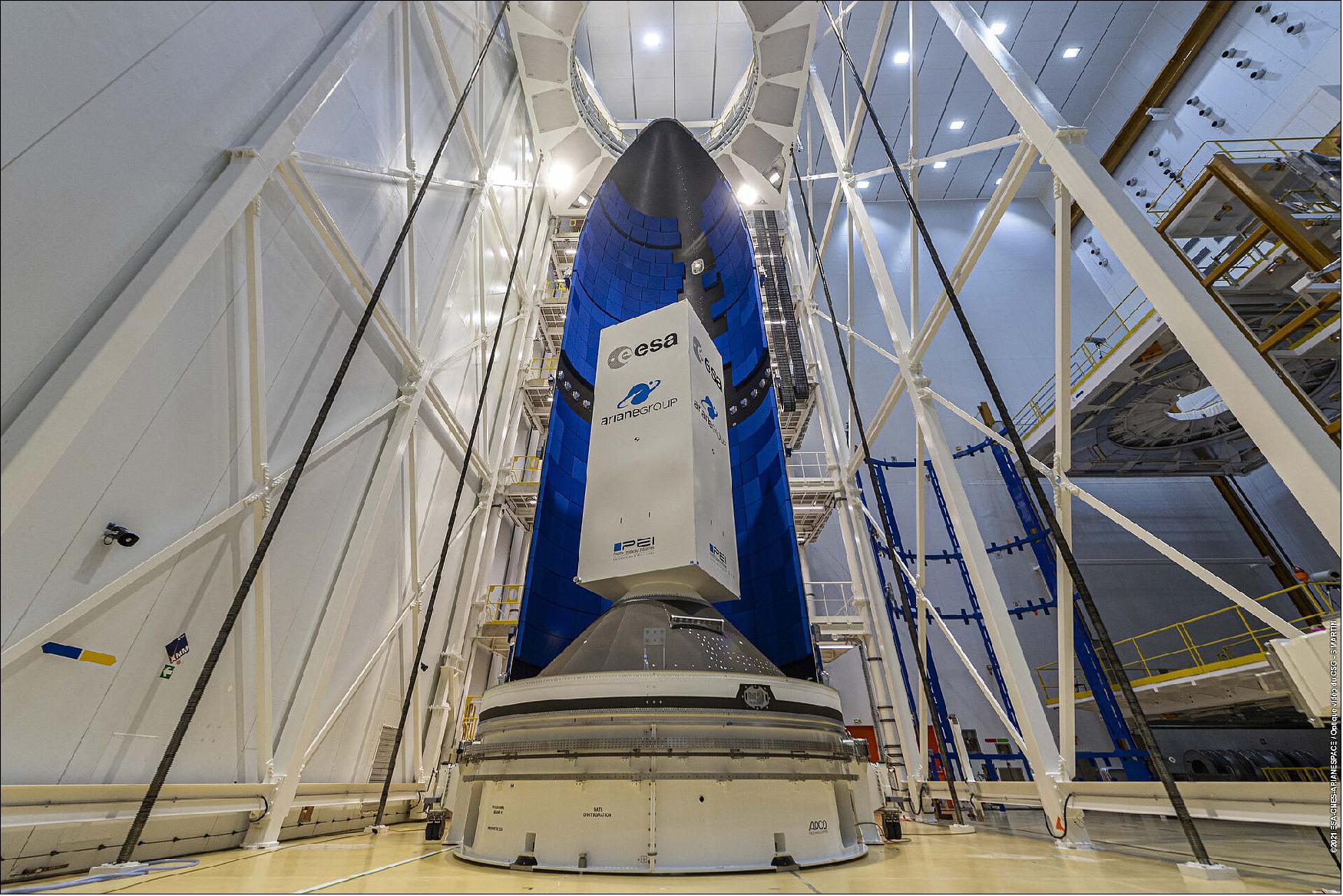
- Before this combined test, the French space agency, CNES, updated the existing Ariane 5 assembly building with a new integration dock, composed of a large white frame, with two mobile platforms adjustable to any level and accessible by fixed stairs and platforms.
This assembly building has two halls: one for integration of the fairing on the Ariane 5 rocket, and an encapsulation hall where the payload is stowed in the fairing. This encapsulation hall is a spacious clean room for Ariane 6.
- A new door 26 m high has been installed at the entrance of the building to make room for the integrated fairing, payload and adapter to move on its trailer to the Ariane 6 launch zone.
- This activity is one of many extensive ‘combined tests’ which are being carried out in a team effort at the Spaceport by ESA, CNES, ArianeGroup, Avio and other industry partners. These tests will prove the systems and procedures that will prepare Europe's new Ariane 6 launch vehicle for flight.
• May 3, 2021: Europe’s new launch vehicle, Vega-C, is near completion. Elements will soon be shipped to Kourou for assembly and preparation for Vega-C’s inaugural flight. 30)
• April 6, 2021: Ariane 6 early combined tests at Latesys in Fos-sur-Mer, in France, have simulated the moment of liftoff when the umbilicals separate from the launch vehicle. 31)
- These tests are part of the critical path towards the first flight of Europe’s new Ariane 6 launch vehicle. They validate the interfaces and mechanical behavior during separation of this complex cryogenic connection system. More extensive combined tests will be carried out at Europe’s Spaceport in Kourou, French Guiana which will include the fluidic supplies.
- The cryogenic connection system sustains the launch vehicle on the launch pad during the countdown to launch.
- Umbilicals supported by ‘cryo-arms’ on the main mast, supply Ariane 6 with top-up fuel, maintain the correct pressurization of Ariane 6’s tanks, cool the engines before ignition and generally keep the launch vehicle in an optimal condition right up to the point of liftoff. The same umbilicals allow the fuel to be drained safely if a launch is aborted.
- “At the moment of liftoff, it is paramount that the connections between launch vehicle and launch base are disconnected and pulled away quickly and safely,” explained Luis Escudero, ESA’s Core Future Launch Preparation Program Manager.
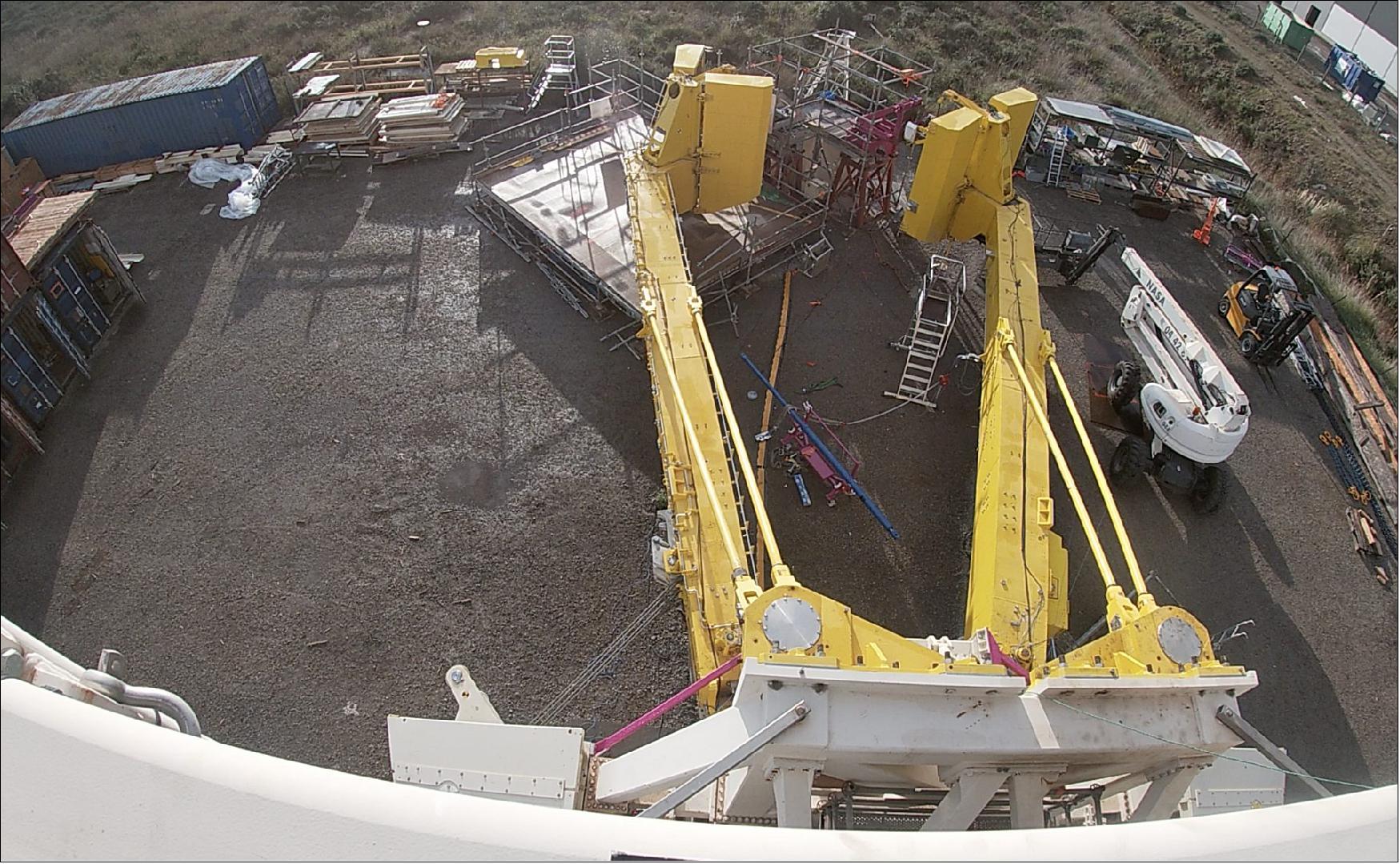
- “Pyrotechnic actuators detonate to burst hinges open allowing the umbilicals to safely separate from Ariane 6. The supporting cryo-arms that hold the upper umbilicals then move out horizontally away from the launch vehicle. A 50-ton counterweight inside the mast – as heavy as a humpback whale – speeds up this maneuver.
- “At the same time, steel doors slam shut on the mini-masts at the base of Ariane 6 on the launch pad to shield the connectors from the rocket exhaust.
- “This all happens in split seconds in a highly precise, synchronized sequence.”
- The launch base design is improved for Ariane 6. The disconnect time is now faster than it is for Ariane 5. This means the sequence can be triggered at the latest possible moment in the countdown reducing the chance of unnecessary disconnects on an aborted launch.
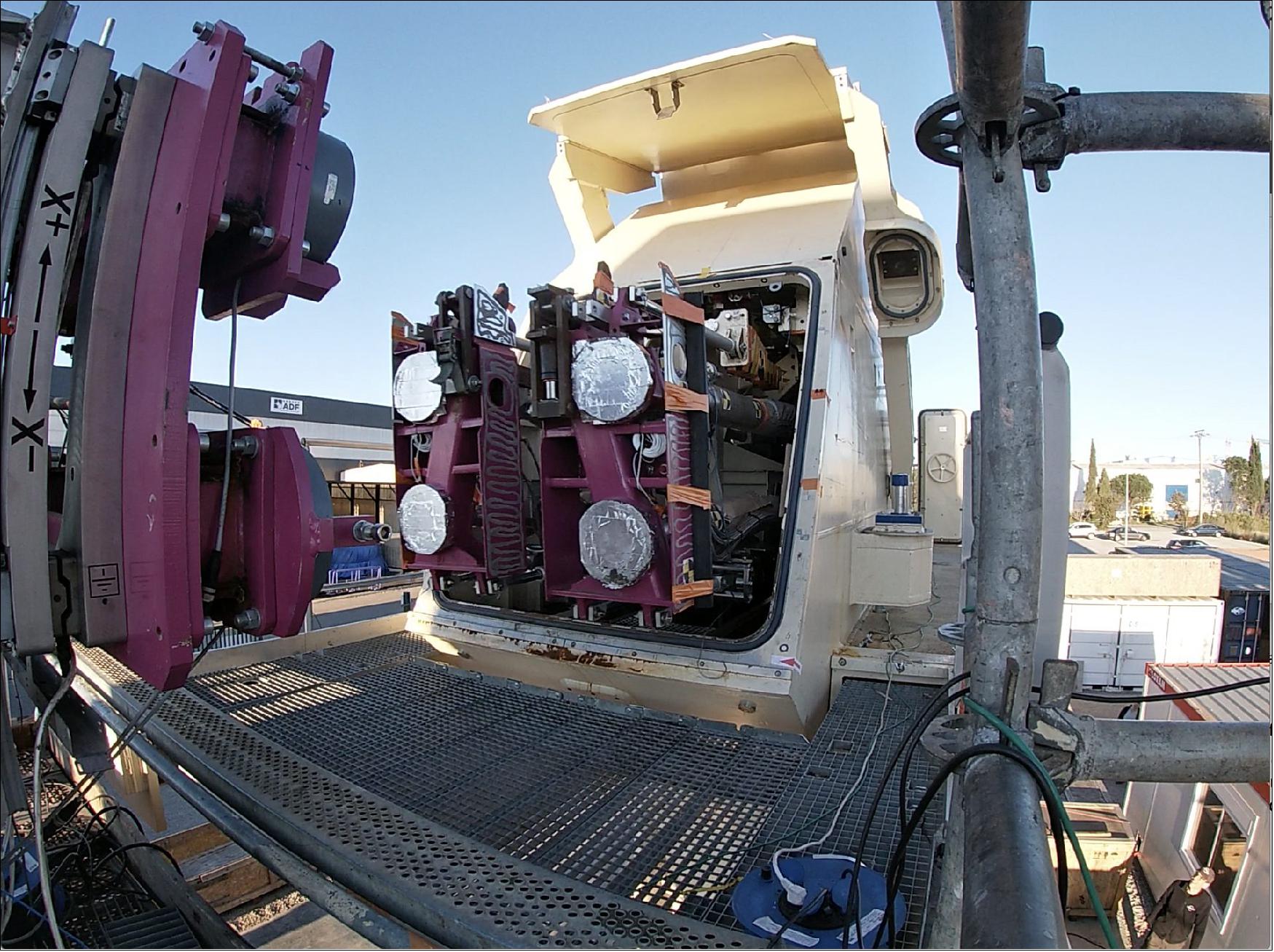
- Over the last few months, Latesys under CNES responsibility and with the support of ArianeGroup, have performed tests to validate the disconnection and retraction functions of the launch pad mechanical systems and the mounts between launch base and rocket, and verified mechanical loads.
- These tests involved the cryo-arms which connect to the Ariane 6 upper stage; mini-masts fixed to the launch table connected by umbilicals to the lower stage; and other Ariane 6 connections.
- ESA has overseen these tests and analyzed the results to verify and validate the cryogenic connection system.
- Following these tests, the components were dismantled and will be shipped to Kourou for integration on the launch pad. Here they will be reassembled and further tested in combination with the cryogenic systems that will supply liquid oxygen and liquid hydrogen to the launch vehicle.
- A launch base technical qualification followed by combined tests at the Spaceport lasting several months will prepare for the launch system technical qualification and debut flight of Ariane 6.
- “These tests were a vital link in a chain of test campaigns that move us forward to further combined tests in French Guiana. This is a very positive step forward for Ariane 6,” commented Pier Domenico Resta, ESA’s Ariane 6 Launch System Engineering Manager.
• March 19, 2021: During the recent meeting in Rome between Bruno Le Maire, French Minister of the Economy, Finance and Recovery, and Giancarlo Giorgetti, Italian Minister of Economic Development, Arianespace announced the signature of an agreement with Avio to start production of 10 new Vega C launch vehicles. 32)
- his agreement kicks off the procurement of long lead-time items and the initial activities for the production of 10 new launchers, to be delivered from 2023.
- Arianespace, the European launch services company, announced today the signature of an agreement with Avio, industrial prime contractor for the Vega and Vega C launchers, to start production of a batch of ten new Vega C rockets, to be launched as from 2023.
- “Arianespace is delighted to have signed this agreement with our long-standing partner Avio, confirming the ramp-up of Vega C, in particular to meet European government requirements,” said Stéphane Israël, Chief Executive Officer of Arianespace. “Through this long-term supply, Arianespace kicks off its order for a fourth batch of Vega launchers, the first comprising only upgraded Vega C launchers. A number of European Earth observation and science programs, most notably Copernicus, will fully benefit from the greater competitiveness of Vega C. More than ever, Vega is establishing its role as the second pillar of Europe’s space access capabilities, along with Ariane.”
- Giulio Ranzo, Chief Executive Officer of Avio, commented: “We are delighted to receive a new batch order for Vega C, which confirms Arianespace’s customers’ interest and trust in the new launcher product, which is the result of an effective cooperation among several European industries under Avio’s leadership”.
- The agreement was signed in Rome on March 19, 2021 by Stéphane Israël, CEO of Arianespace, and Giulio Ranzo, CEO of Avio, during a meeting between Bruno Le Maire, French Minister of the Economy, Finance and Recovery, and Giancarlo Giorgetti, Italian Minister of Economic Development.
- Vega C launchers produced within Batch 4 will serve institutional and commercial missions from 2023 onwards; in particular, they will contribute to the fulfillment of strategic objectives selected by European institutions, either collectively through ESA and the European Commission, or for national purposes. Thus, 2021 will see the contracting by Arianespace of launch services for the next nine Copernicus satellites within the Multiannual Financial Framework 2021-2027 of the European Commission.
- Vega C is a new-generation light launcher, perfectly suited to the launch of both commercial and government payloads. Because of its high performance and versatility, Arianespace provides the best possible solution to orbit small and medium spacecraft into a wide range of orbits (Sun- synchronous, ballistic, transfer to the Lagrange point L1, etc.), for Earth observation, science, education, defense and other applications. With Vega C, Arianespace will offer enhanced performance and greater payload volume for future customers at the same price as for launches by Vega.
• January 29, 2021: The first complete upper stage of Europe’s new Ariane 6 launch vehicle has left ArianeGroup in Bremen and is now on its way to the DLR German Aerospace Center in Lampoldshausen, Germany. Hot firing tests performed in near-vacuum conditions, mimicking the environment in space, will provide data to prove its readiness for flight. 33)
- Integrated in October last year at ArianeGroup in Bremen, Germany, this ‘hot-firing model’ of the complete upper stage is fully operational having undergone extensive functional tests. Its new reignitable Vinci engine is connected to two liquid hydrogen and oxygen tanks and is equipped with all lines, valves and electronic and hydraulic instrumentation and control systems.
- On board a barge departing from Neustadt port in Bremen on 29 January, the upper stage will journey to BadWimpfen and then be taken by road to Lampoldshausen. The DLR German Aerospace Center has already tested Ariane 6’s Vinci engine and Vulcain 2.1 liquid propulsion engines.
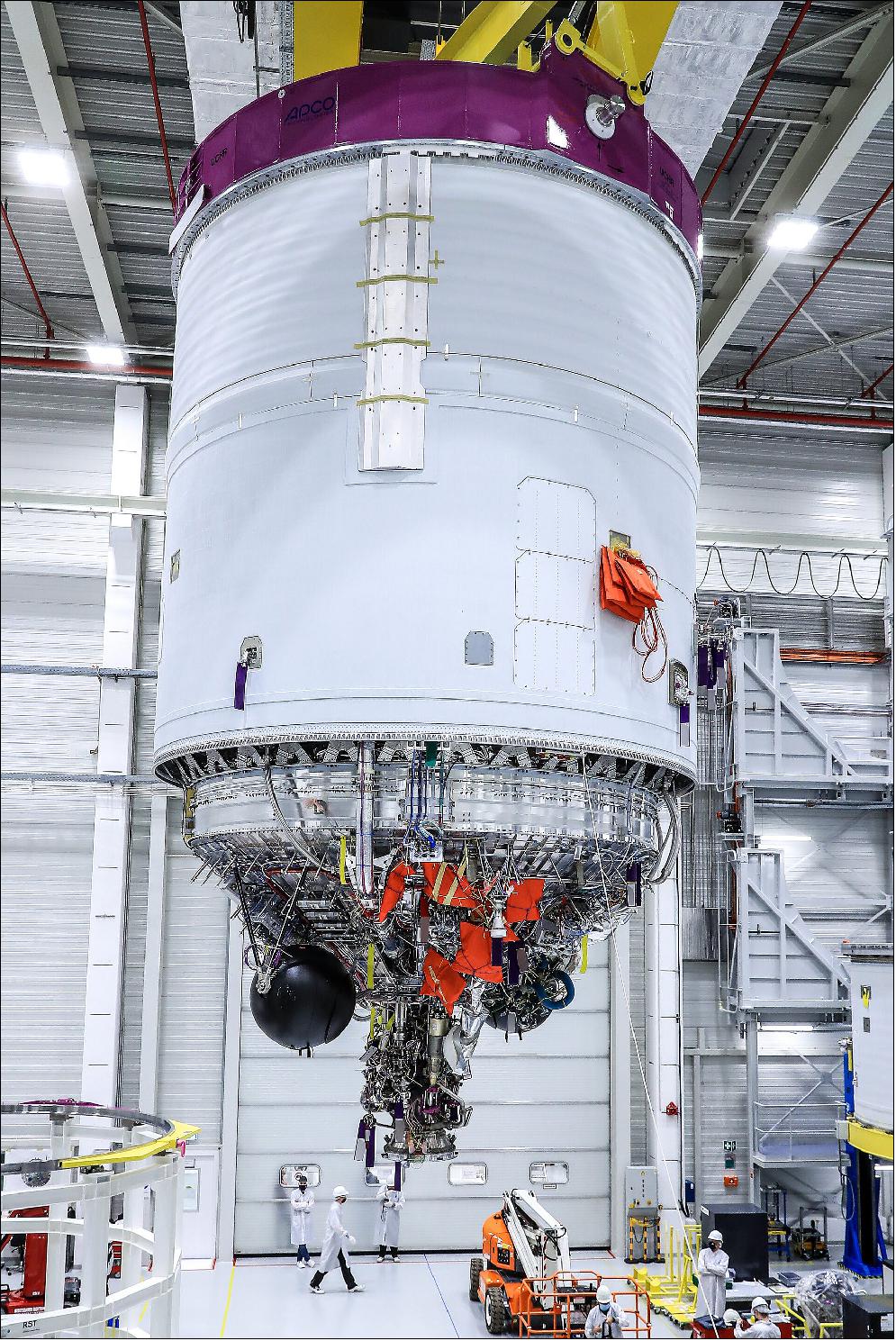
- The complete upper stage will be installed on the new P5.2 test stand. Inside this facility all aspects of the flight are simulated including stage preparation such as the fuelling or draining of its tanks. The building has platforms that give engineers access to all parts of the stage. After final preparations, a countdown marks the start of the test.
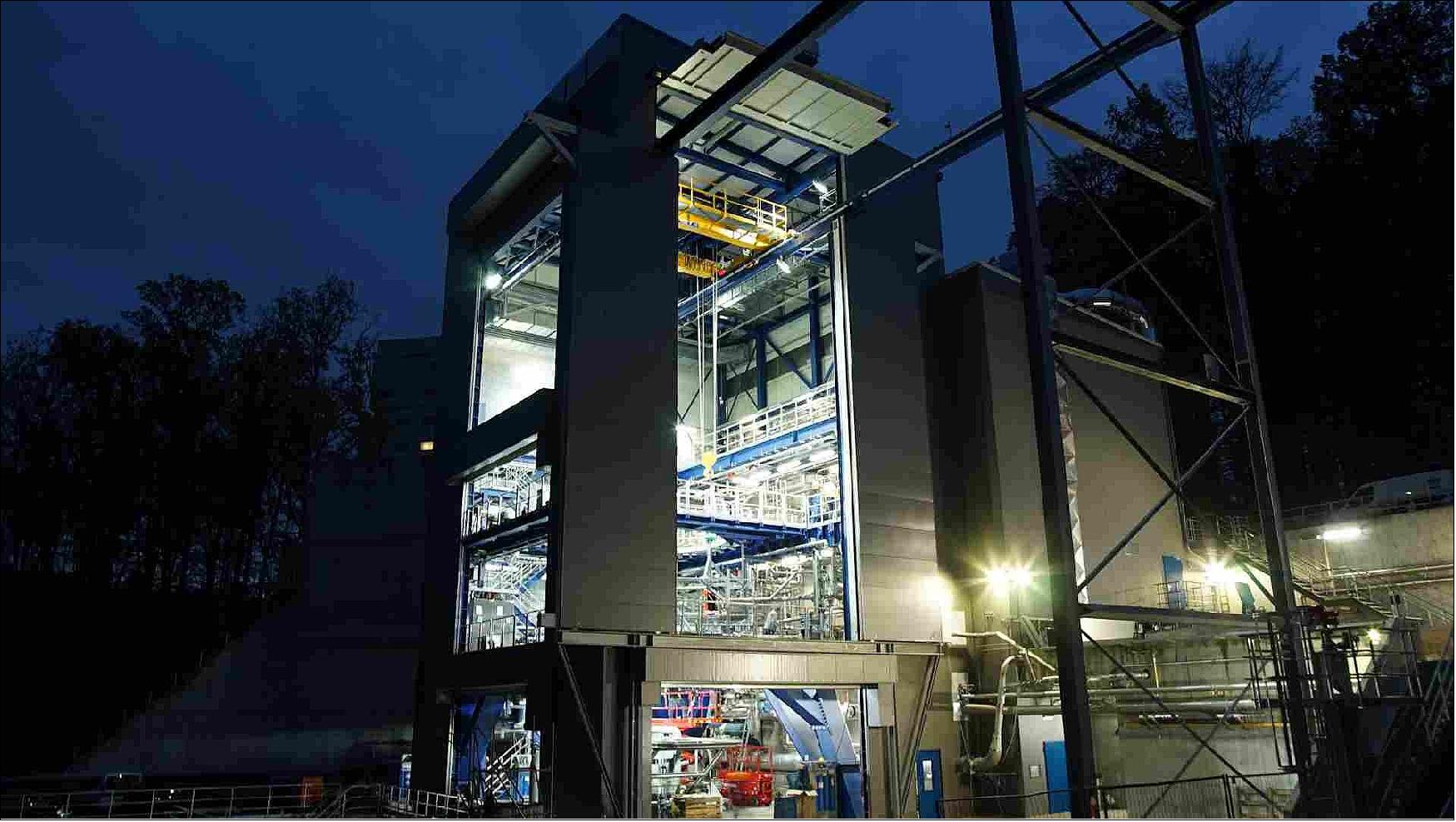
- Operations inside the P5.2 testing facility are monitored from a remote central control room. During this campaign of tests, the Vinci engine will be ignited up to four times in order to gather data describing the behavior of the whole upper stage when the Vinci engine is running.
- Tests will also provide data on non-propulsive ballistic phases, tank pressurization to increase performance, Vinci re-ignitions, exhaust nozzle maneuvers, ending with passivation where all remaining internal energy is removed.
- Weekly tests will typically last 18 hours each.
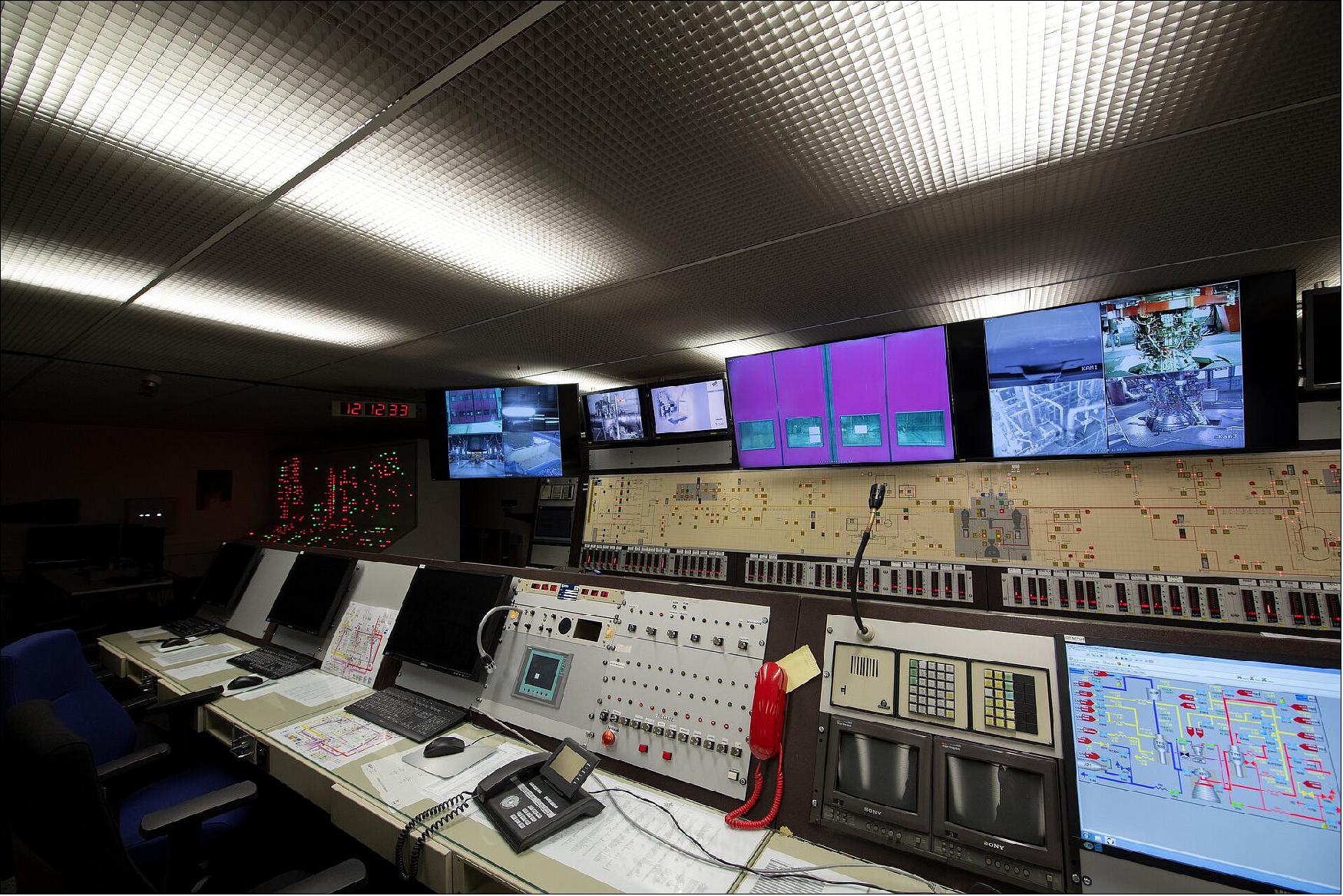
- ”We have reached another milestone in the Ariane 6 roadmap to flight. Seeing the elements of Ariane 6 coming together is very exciting. With the upcoming hot-firing tests of the complete upper stage we will gain valuable insights into the technical heart of this new European launch vehicle,” commented Daniel Neuenschwander, ESA Director of Space Transportation.
- Karl-Heinz Servos, COO at ArianeGroup, added: “Completion of this stage for the first hot-fire tests is a major step for Ariane 6, for Germany and for European space as a whole.”
- Walther Pelzer, Head of the German Space Agency at the German Aerospace Centre (DLR), commented: “With the first Ariane 6 upper stage hot-fire testing at the new P5.2 test facility at the DLR site at Lampoldshausen, we are now one more vital step closer to Ariane 6’s maiden flight.”
- Meanwhile, a further two Ariane 6 complete upper stages are being integrated by ArianeGroup. The Combined Tests Model is intended for tests of the launch vehicle and the launch base at Europe’s Spaceport in French Guiana, and the Flight Model 1 is intended for the inaugural flight of Ariane 6.
- Ariane 6 will be capable of carrying out all types of missions to all orbits thanks to its multiple re-ignition capability and modular design. With two versions: Ariane 62, fitted with two P120C boosters, and Ariane 64, with four, this new launch vehicle further extends and secures Europe’s independent access to space.
• January 12, 2021: Tour the Ariane 6 launch complex at Europe's Spaceport in Kourou, French Guiana. 34)
- The 8200 ton 90 meter-high mobile gantry has platforms to enable engineers to access the vehicle for integration of the stages. This steel structure protects Ariane 6 before launch and is rolled back prior to liftoff.
- At the entrance of the gantry are two mockup Ariane 6 P120C rocket boosters. These are representative of the real boosters, having the same size and mass but filled with water instead of solid propellant and used in mechanical tests.
- The hydrogen and oxygen storage facilities are close by. Underground, engineers are preparing the launch support systems.
- A pumping station at the reservoir will supply the water to quell the exhaust at liftoff.
• November 6, 2020: Europe’s Spaceport in Kourou, French Guiana, covers 700 km2 and comprises the launch range, three operational launch complexes with another under development for Ariane 6, and propellant manufacturing plants. Together they draw up to 20% of the country’s energy supplies. 35)
- About half the power at the base is used to cool buildings while energy-intensive solid and liquid propellant processes take up most of the rest. The yearly bill is several million euros.
- ESA with France’s CNES space agency, plan to cut costs by reducing the reliance on the French Guiana grid and transitioning to ‘green’ and renewable energy sources on site. These new energy sources are intended to provide 90% of the electricity consumed at the base by end-2025. On achieving this, Europe’s Spaceport would be well in advance of COP21 (Conference of the Parties) objectives (Paris Climate Conference) to combat climate change.
- The energy transition plan is based on two major pillars: the introduction of solar fields (up to 10 MW peak) delivering the first electron by the start of 2023, followed by two biomass units the same year with the intention of utilizing the waste heat for cooling buildings. This mix could save about 50 GWh per year, reducing the carbon footprint by about 45 000 tonnes of carbon dioxide (CO2) equivalent.
- These development plans were approved at Space19+. They reflect the approach of ESA and CNES to the global urgency to care for our planet.
- ESA aims to increase its contribution to the sustainable development of our society, avoid negative impacts on the environment and maximize positives ones.
- “Solar panels would in the first instance, allow a technology learning curve. Further extending the number of panels would bring additional power to the Spaceport to supplant an aging French Guiana grid by 100% green energy,” explained Teddy Peponnet, CSG Renewable NRJ transition project manager at the Spaceport.
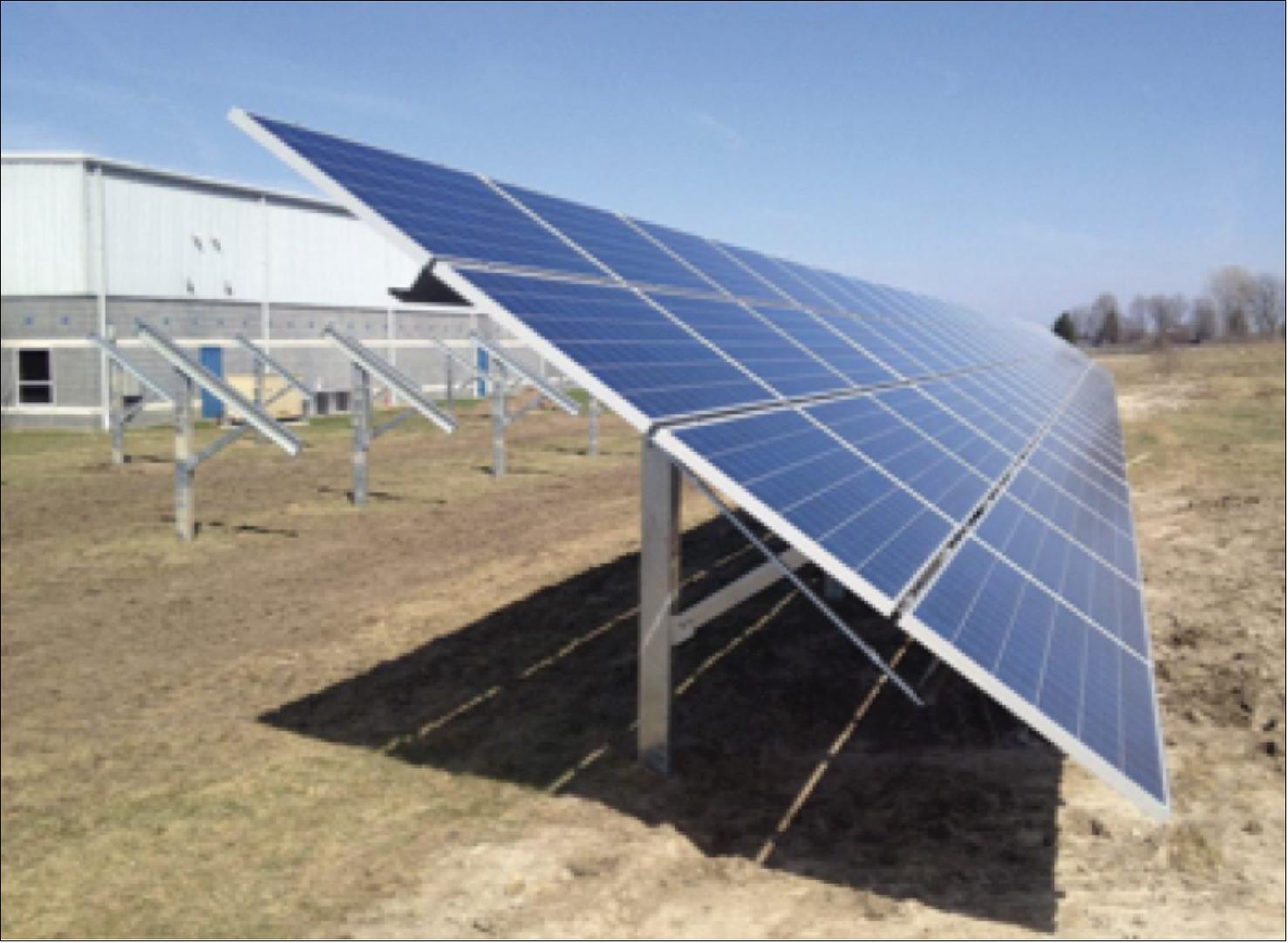
- “In the future, solar energy would be used to recharge fuel cells at the Spaceport. Biomass units, installed and operated by a third party, would also supplement the French Guiana grid. A workforce of 250 will work on the biomass overall cycle, boosting local employment.”
- The principle of a biomass power plant consists of using dead wood to produce bio-gas in gasification chambers and obtain electricity via a co-generation process – the carbon dioxide produced is offset by the crop’s sequestering of carbon dioxide from the air. About 75% of the energy contained in the fuel is dissipated as heat, made use of via absorption groups to feed the air conditioning system of the Spaceport.
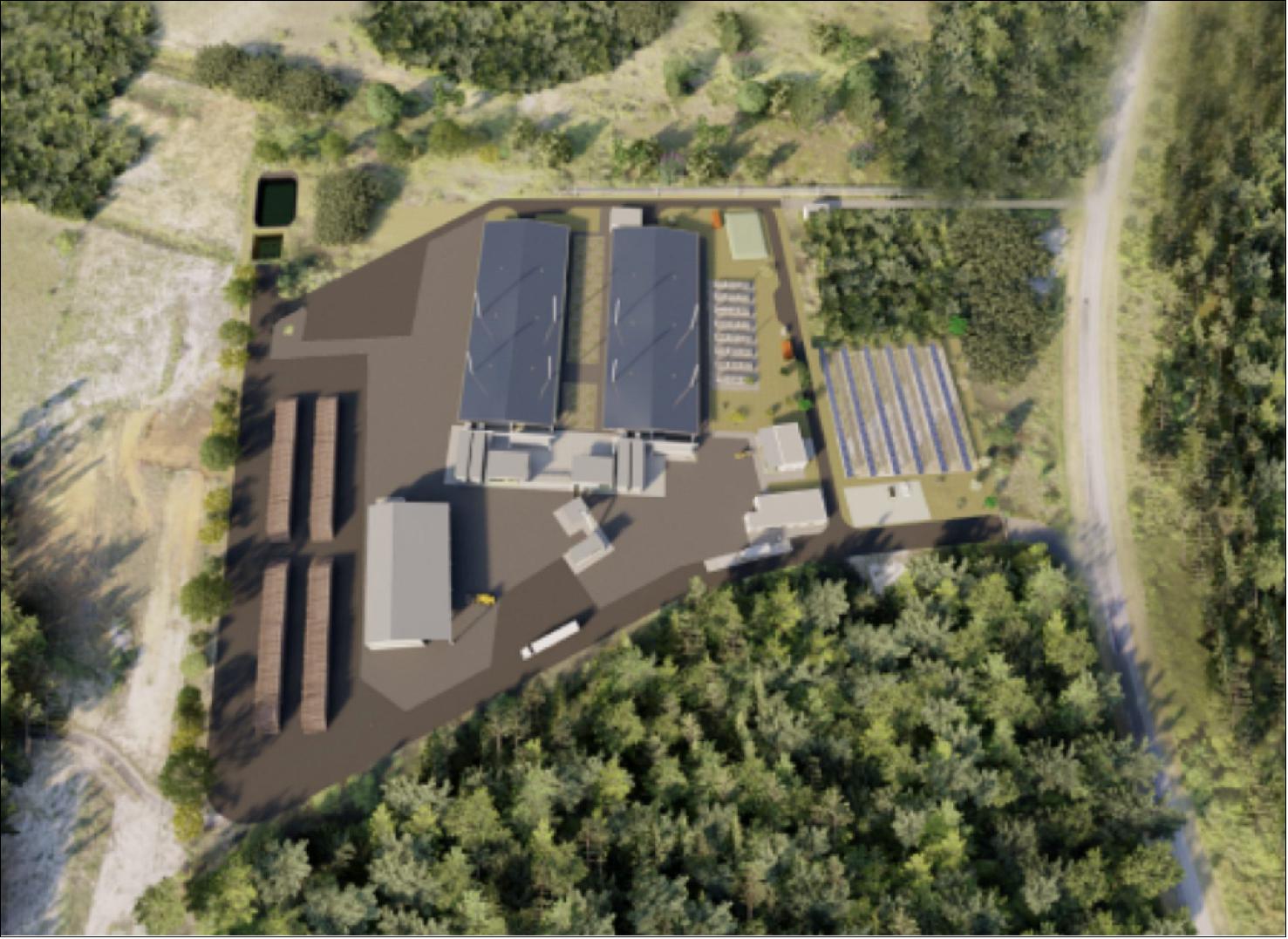
- In addition to the ‘greening’ actions adopted by ESA and CNES, industrial operators are playing a major role as well. This summer, industry supported by ESA, implemented specific energy saving memorandums of understanding with EDF SEI, the local energy provider. These protocols enable them to collect energy rebates which will be reinvested for greater launchers competitiveness and carbon footprint improvements on site.
- ESA, CNES and industrial operators are creating a new chapter in the history of Europe’s Spaceport. Together they are using renewable energy as a key component in launchers competitiveness while serving the local community and ultimately French Guiana as a whole.
• October 29, 2020: Vega-C and Ariane 6 are being developed by ESA to assure Europe’s independent access to space. The maiden flight for Vega-C is planned to take place in June 2021, that for Ariane 6 for the second quarter of 2022. 36)
- Solid progress is being made on both Vega-C and Ariane 6 development programs. Since March, some technical events and the COVID-19 pandemic have both impacted the progress of activities. Uncertainty from COVID-19 still persists globally to date.
Vega-C
- Vega-C is a more powerful and versatile version of the Vega launch vehicle currently operating at Europe’s Spaceport in French Guiana. Vega-C’s maiden flight is planned for June 2021.
- Vega was on track for its return to flight, after the July 2019 failure, with its mission (VV16) in March 2020, but Europe’s Spaceport had to be closed due to COVID-19 safety measures. The VV16 launch campaign resumed in May but several further launch attempts were halted due to unfavorable weather. Vega’s return to flight, with the new SSMS dispenser carrying 53 satellites, was successfully launched on 2 September.
- Between February and September no activities for the preparation of Vega-C were possible in the Vega mobile gantry while it housed the P80 solid rocket motor in readiness for flight VV16, due to safety constraints.
- The qualification at system and subsystems level is currently under finalization.
- As from October, all the new solid motors for Vega-C have completed qualification testing. The Zefiro-40 solid rocket motor for Vega-C completed qualification tests in 2019. The final test of the P120C took place successfully on 7 October.
- Two Vega flights, VV17 and VV18, are planned before Vega-C. Activities for the modification of the mobile gantry for Vega-C, such as modifications of the fluids networks as well as connection and installation of the new control bench for Vega-C, will have to start after VV18 now planned early February.
- Vega-C maiden flight is planned for June 2021.
- Vega-C is a project managed and funded by the European Space Agency. Avio is the industrial prime contractor. Arianespace commercializes Vega-C.
Ariane 6
- ESA, CNES and ArianeGroup have jointly established a consolidated reference planning for Ariane 6 development and are working as an integrated team in their respective roles to make it happen. This schedule is based on analysis of recent achievements, remaining critical milestones and the impact on the program caused by the COVID-19 pandemic.
- With the successful third static fire test of the P120C solid rocket motor on 7 October, all the propulsion elements of the launcher system have completed their qualification tests.
- At Europe’s Spaceport, activities for the finalization of the Ariane 6 launch base are progressing. First integration testing with fullscale ‘mock-ups’ of the P120C strap-on booster and of Ariane 6’s central core took place in the new mobile gantry. Testing of the cryogenic arms that link the launch pad and the launch vehicle are also ongoing at Fos-sur-Mer in France, before shipping to French Guiana.
- ArianeGroup is completing the challenging development and qualification of the Ariane 6 Auxiliary Power Unit for the upper stage. This device will allow Europe to offer additional capabilities in satellite deployment for the satellite constellation market.
- The first Ariane 6 upper stage has been assembled in Bremen, Germany. Coupling the launcher’s tanks with the equipped engine bay of the re-ignitable Vinci engine for the first time. The upper stage is currently undergoing mechanical, fluid and electrical tests, before leaving for further tests at the DLR German Aerospace Center’s Lampoldshausen facilities in Germany.
- There, the complete stage will be hot fire tested on a new test bench specially developed by DLR for the Ariane 6 upper stage. The Ariane 6 upper stage static fire tests are planned to start in the second quarter of 2021.
- In parallel, the first Ariane 6 core stage and the second Ariane 6 upper stage are under preparation. These specimen will be shipped to Europe’s Spaceport from Les Mureaux (France) and Bremen (Germany) respectively, for the combined tests campaign.
- In the third quarter of 2021, the Ariane 6 launch base will be handed over from CNES to ESA. At this point the Ariane 6 combined tests campaign can start. These series of tests will bring the launch vehicle and launch base together for the first time for integrated tests of multiple systems. This will include a static fire test of Ariane 6 while standing on the launch pad for the first time.
- Following the successful combined test campaign and Ground qualification review of the launch system, the first launch campaign, with the integration of the maiden flight hardware, will start.
- When all these steps are successfully completed Ariane 6 will be in a position to perform its maiden flight in the second quarter of 2022.
- Ariane 6 is a project managed and funded by the European Space Agency. ArianeGroup is design authority and industrial prime contractor for the launcher system. The French space agency CNES is prime contractor for the development of the Ariane 6 launch base at Europe’s Spaceport in French Guiana. Arianespace commercializes Ariane 6.
Impact of COVID-19
- The measures taken to control the pandemic have seriously impacted the progress of activities both in Europe and at Europe’s Spaceport since March 2020, including as a result of social distancing, site lockdowns and reduced capacity at facilities, travel restrictions, quarantines and confinement measures.
- This has considerably slowed all working and operational processes for prime contractors and their respective subcontractors around 13 European countries. Ongoing pandemic effects continue to disrupt on-going development and operations.
- “We constantly and closely monitor the COVID-19 impact and technical challenges on our ongoing space transportation developments and operations. Together with our contractual partners and participating States, ESA continues to pull together towards our common priority goals which are the maiden flights of Vega-C and Ariane 6,” commented Daniel Neuenschwander, Director of Space Transportation at ESA.
• October 23, 2020: Europe’s new-generation Vega-C small launch vehicle developed by ESA will increase performance and extend current launch capabilities at Europe’s Spaceport. 37)
- The first stage P120C, second stage Zefiro-40 and the third stage Zefiro-9 are all fueled by solid propellant. These motors, together with the AVUM+ liquid propulsion upper module, will allow Vega-C to lift payloads of up to 2300 kg to a reference 700 km altitude in polar orbit.
- The P120C first stage will burn for 130 s using 142 t of fuel to deliver a liftoff thrust of about 4500 kN. This will take Vega-C to an altitude of about 60 km in the first phase of flight before the second stage takes over.
- Europropulsion, owned jointly by Avio and ArianeGroup, built three P120C models for test. One development and two qualification models have all been static fired successfully at Europe’s Spaceport.
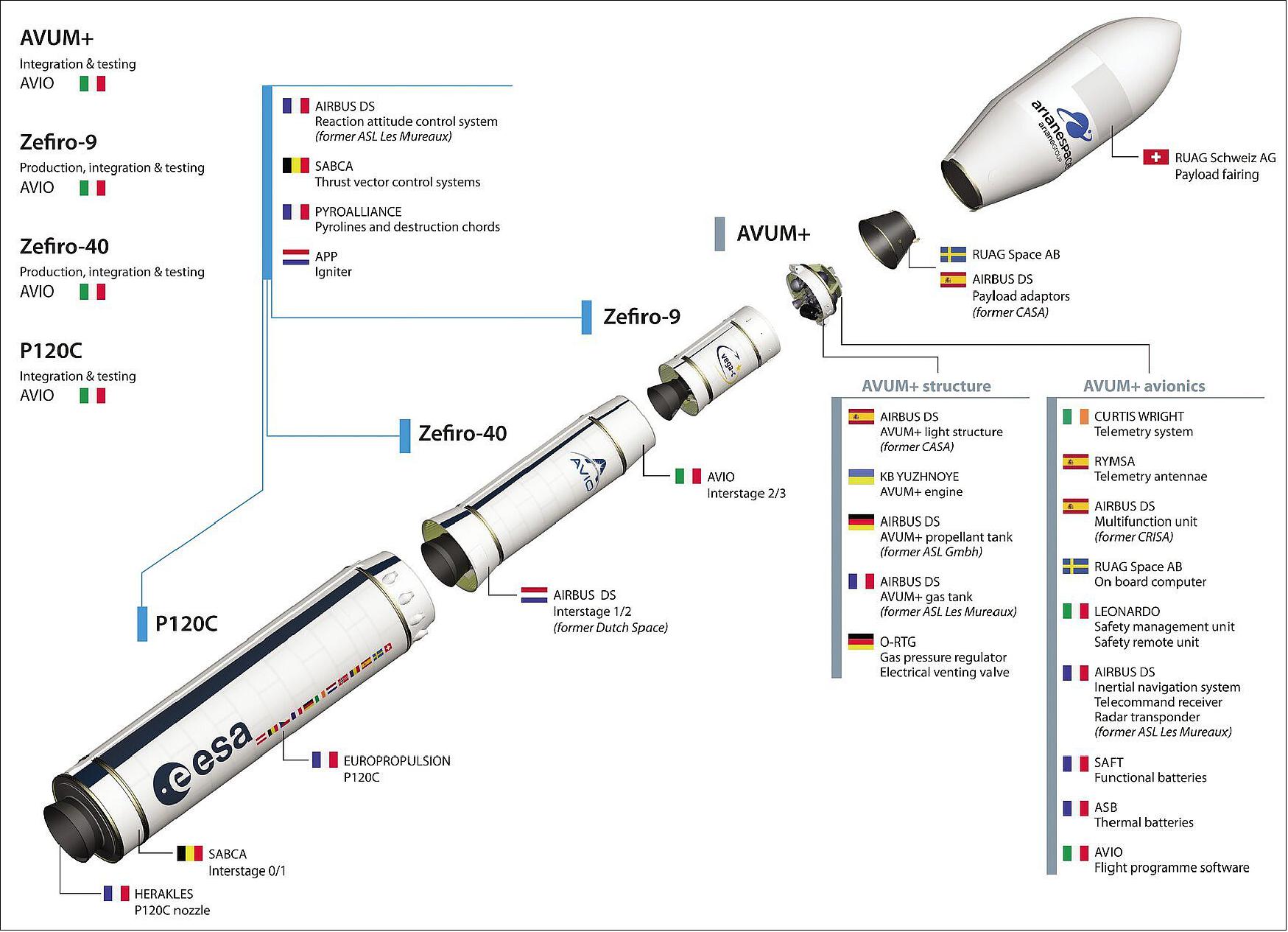
- The first qualification model, in the Vega-C configuration, was hot fired in January 2019. The second qualification model, in the Ariane 6 configuration, was hot fired on 7 October. Using the P120C on two launch vehicles has saved on development costs and benefitted economies of scale and created an opportunity for Europe to scale up production.
- Vega-C’s second stage, powered by the new Zefiro-40 contains about 36 t of solid propellant.
- The Zefiro-40, developed and manufactured by Avio in their Colleferro factory in Italy, was static fired on 8 March 2018 and then again on 10 May 2019 at test facilities in Sardinia.
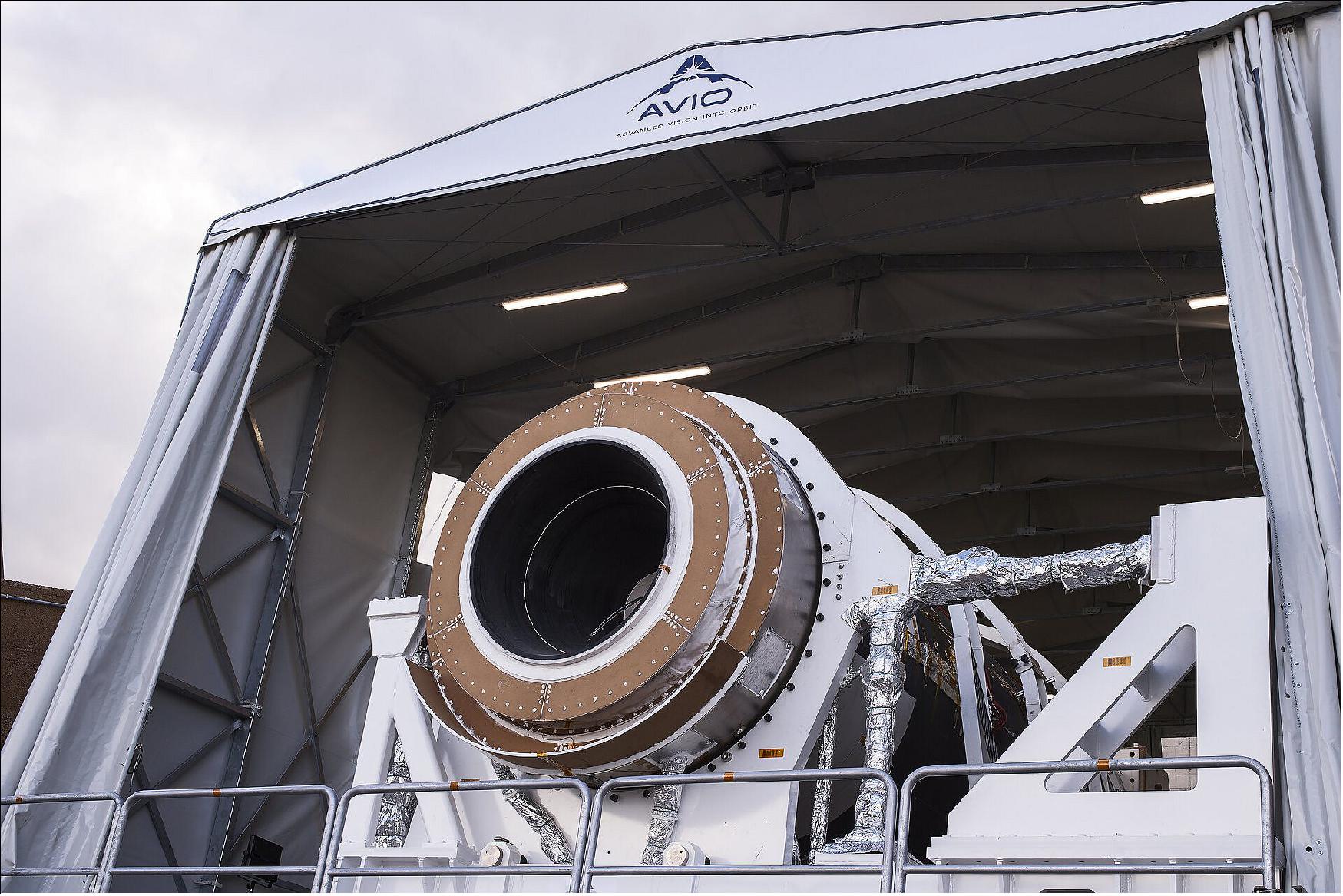
- During a burn time of 92 seconds the Zefiro-40 generates an average thrust of 1300 kN which is four times greater than that of an engine of a modern passenger aircraft. This propels Vega-C to an altitude of about 123 km.
- The Zefiro-9 will power Vega-C’s third stage. It is an advanced version with a new igniter with respect to the one used on the Vega launch vehicle currently operating at Europe’s Spaceport.
- On 1 October, the Zefiro-9 seated on the test bench in Cagliari, Sardinia performed its final qualification hot firing. It burned for 120 s using 10 t of solid propellant. The Zefiro-9 will take Vega-C to an altitude of about 190 km.
- “Industry is working very hard and very closely with ESA to complete the end of the qualification program for Vega-C. Together we are overcoming the obstacles caused by the COVID-19 pandemic and we are committed to complete all activities planned for the preparation of the Vega-C maiden flight,” commented Giorgio Tumino, Head of Vega-C development and Chief Technical Advisor for Space Transportation at ESA.
• October 15, 2020: All three engines developed to power Europe’s future Ariane 6 rocket have completed extensive tests – the P120C solid rocket motor for the boosters, the Vulcain 2.1 engine for the core stage and the Vinci for the upper stage. 38)
- Ariane 6 in the four-booster version will stand 63m tall, with a mass of 900 tons and have the liftoff power equivalent to 12 Airbus A380 engines roaring at takeoff.
P120C – Solid Ppropulsion
- Two or four P120Cs, depending on the configuration, will be strapped onto Ariane 6’s core stage as boosters for liftoff.
- The P120C is Europe’s new solid propulsion workhorse. The ‘C’ stands for ‘common’ as P120C will be used on both ESA-developed launcher systems – Vega-C as well as Ariane 6. It has been developed by Europropulsion, which is owned jointly by Avio and ArianeGroup.
- Rocket motors that contain solid fuel burn until the fuel is depleted. Simple and powerful, this form of propulsion is often an operations low-cost option for raw power, used most often at the liftoff stage. Each P120C motor provides about 4500 kN of thrust.
- P120C is 13.5 m long and 3.4 m in diameter with a mass of 11 tons. Its 25 cm thick casing is made using a carbon composite material and it is built in one segment at Avio’s Colleferro rocket factory in Italy. ArianeGroup in France developed the advanced P120C nozzle, while Nammo in Norway provided the igniter. Efficient production methods have shortened production cycles and optimized costs.
- Three models of the P120C have completed hot firings at Europe’s Spaceport in French Guiana: the development model (DM1) in July 2018, the first qualification model (QM1) in January 2019 – the version which will be used on Vega-C’s maiden flight, and most recently the qualification model (QM2) in October 2020 for use on the maiden flight of Ariane 6. The production of the motor components for the Vega-C flight model is almost complete.
- The final step is to demonstrate that new production facilities are fully up and running to meet demand.
Vulcain 2.1 – Core Stage Engine
- Ariane 6’s core stage cryogenic engine, the Vulcain 2.1, is fueled by liquid oxygen–hydrogen. It delivers 1371 kN of thrust in vacuum to propel Ariane 6 in the first eight minutes of flight, up to an altitude of 200 km. It has the same mass as an Airbus A318 jet engine but provides more than 10 times the power.
- The Vulcain 2.1 features a 3D-printed gas generator, a redesigned, simplified nozzle and a combustion chamber that can be ignited from the ground via the bottom of the nozzle instead of by pyrotechnic devices inside the motor, reducing the cost and mass.
- Expensive liquid helium is no longer needed as it was for Vulcain 2.0 because heated oxygen in the exhaust lines now pressurizes the oxygen tank.
- The final qualification static firing test of Vulcain 2.1 in July 2019 in Lampoldshausen confirmed the functional and mechanical behavior of this engine while upcoming combined tests will qualify Ariane 6 subsystems at stage and launcher level.
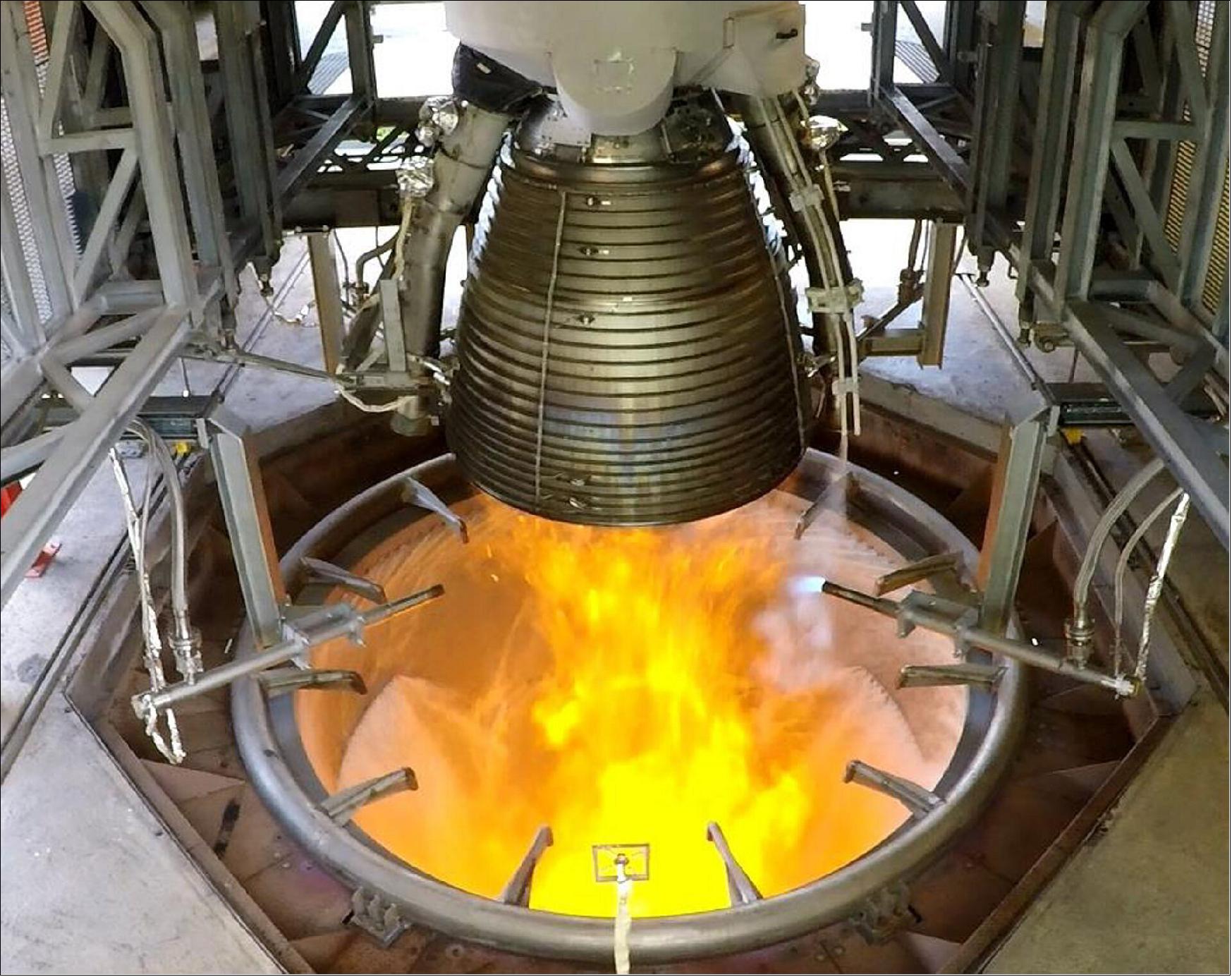
Vinci – Reignitable Upper Stage Engine
- Vinci is Europe’s first expander cycle engine and will power Ariane 6’s upper stage. It is fueled by liquid oxygen–hydrogen and can be reignited up to five times. This increases the operational flexibility of Ariane 6 and ensures that the engine safely deorbits at the end of the mission.
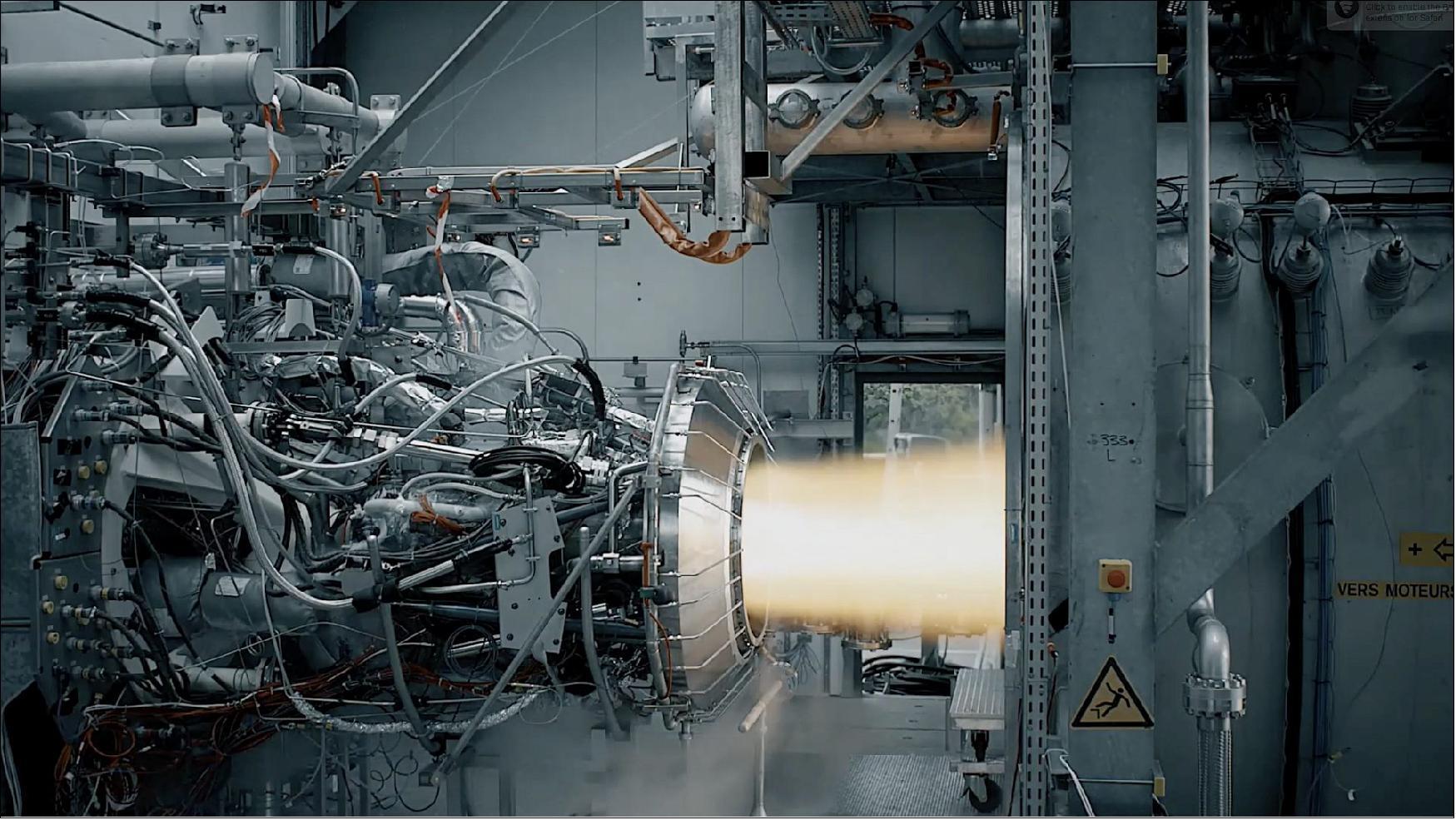
- The qualifying tests for the Vinci were completed in October 2018. This engine was successfully tested more than 140 times and reignited multiple times in succession in near vacuum to complete its qualification bringing a total of more than 14 hours of operation.
- The Vinci engine will be integrated with the complete Ariane 6 upper stage at ArianeGroup facilities in Bremen, Germany. It will then be transported to the DLR German Aerospace Center in Lampoldshausen where the Ariane 6 upper stage will experience a simulated launch inside their new P5.2 facility.
- “ESA with European industry have created three new engines to grow Europe’s independent access to space. We have increased performance, expanded our flexibility and become even more competitive. With all engine qualifications tests completed, we will now focus on remaining final phase activities for Ariane 6 and Vega-C maiden flights,” commented Daniel Neuenschwander, ESA Director of Space Transportation.
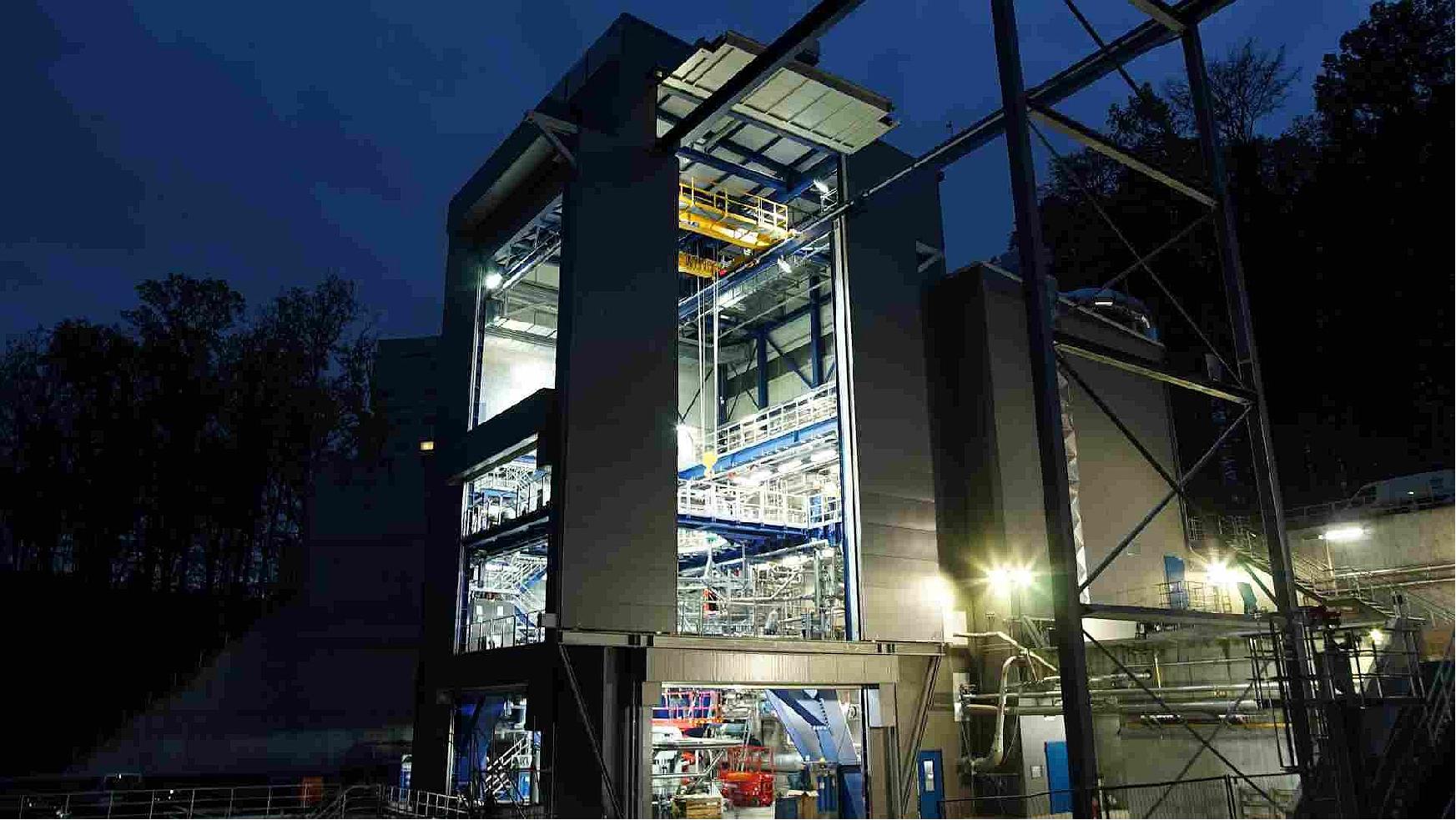
• October 8, 2020: P120C motor configured for Ariane 6 is test fired. 39)
- Depending on the configuration, two or four P120C motors, developed in Europe, will be strapped onto the sides of the future Ariane 6 launch vehicle as boosters for liftoff. The P120C will also be used as the first stage of Vega-C.
- After it was fully loaded with 142 tons of fuel, the 13.5 m long and 3.4 m diameter motor was ignited to simulate liftoff and the first phase of flight.
- The motor burned for 130 seconds and delivered a maximum thrust of about 4500 kN. The test was performed at Europe’s Spaceport in French Guiana, and was completed with no anomalies.
• May 29, 2020: Workers are returning to Europe’s Spaceport in Kourou, French Guiana to resume preparations for Vega and Ariane 5 launches. Construction of the new Ariane 6 launch pad has also restarted. 40)
- COVID-19 lockdown measures introduced in March meant that all but safety-critical operations were suspended at the Spaceport and the vast site had to be secured. Strict new safety and hygiene procedures have now been introduced. Launch teams returning from mainland Europe will spend two weeks in quarantine.
- Vega is due to return to flight this summer on its first rideshare mission dedicated to small satellites using a new dispenser called the Small Spacecraft Mission Service (SSMS).
• March 4, 2020: The 30-m high four-stage Vega is Europe’s launcher for smaller satellites. Its topmost AVUM (Attitude Vernier Upper Module) hosts Vega’s avionics ‘brain’, overseeing the overall flight of the launcher. Then, once it separates from the third stage, the reignitable AVUM flies like a spacecraft in its own right to deploy its various payloads into their set orbits, achieving meter-scale precision. 41)
- ESA’s Materials and Electrical Components Laboratory, based at ESTEC in the Netherlands, played a trouble-shooting role ahead of the first Vega launch back in 2012, after one of these tanks failed to perform adequately during a ‘burst test’ – involving deliberately overpressurizing it. Following forensic scrutiny the Lab team discovered that weld quality was the culprit.
- They produced a full metallurgical analysis of the tank welds, and came up with new protocols to improve their microstructure – the improved tanks withstanding more than twice their intended operating pressures.
- The sixteenth Vega flight is due later this month. Flight VV16 will carry an innovative ‘rideshare’ payload of multiple small satellites and CubeSats.
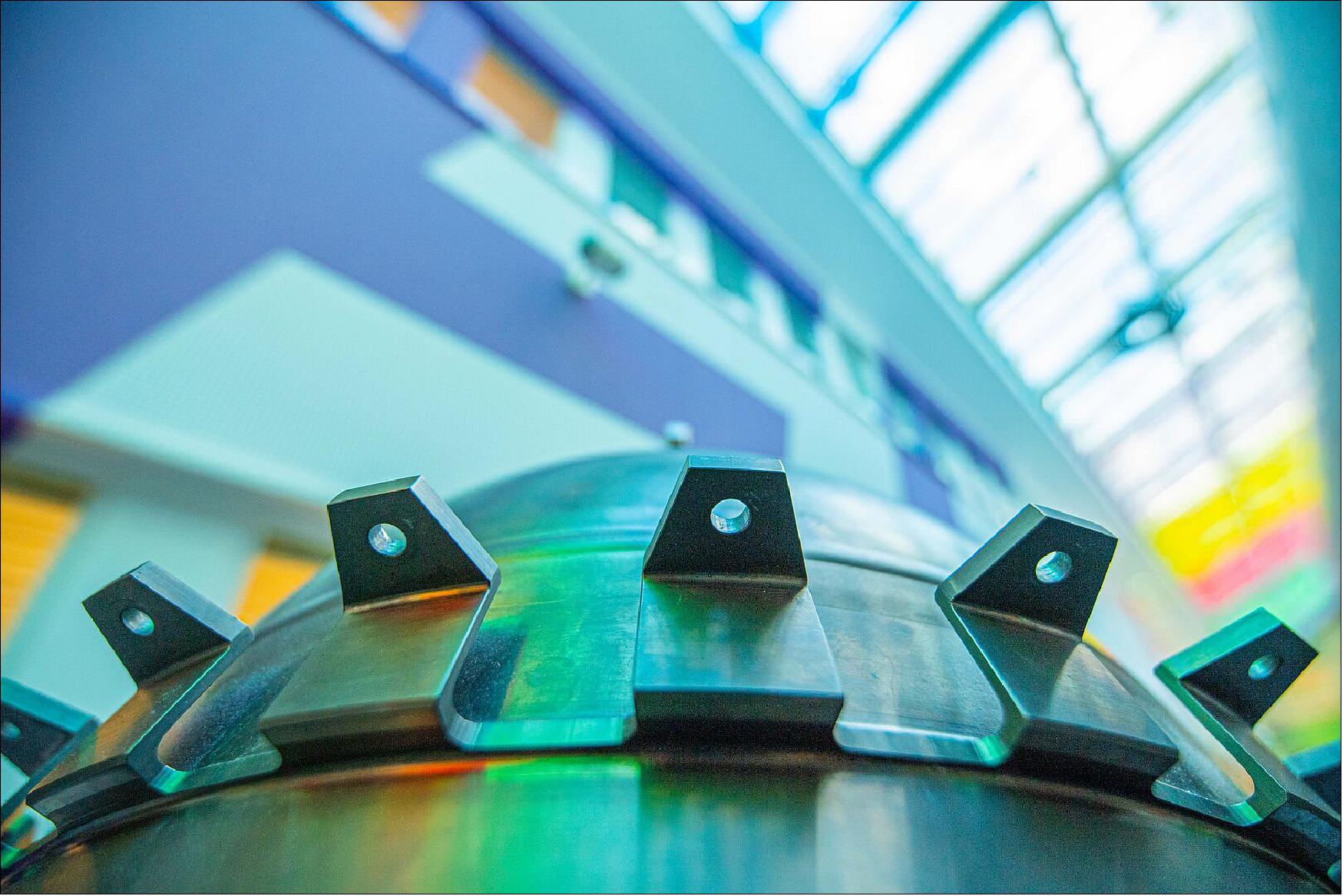
• February 4, 2020: Europe’s Spaceport in Kourou, French Guiana is gearing up for the arrival of Ariane 6, Europe’s next-generation launch vehicle. This aerial view taken in January 2020 shows the main elements of the new launch complex. 42)
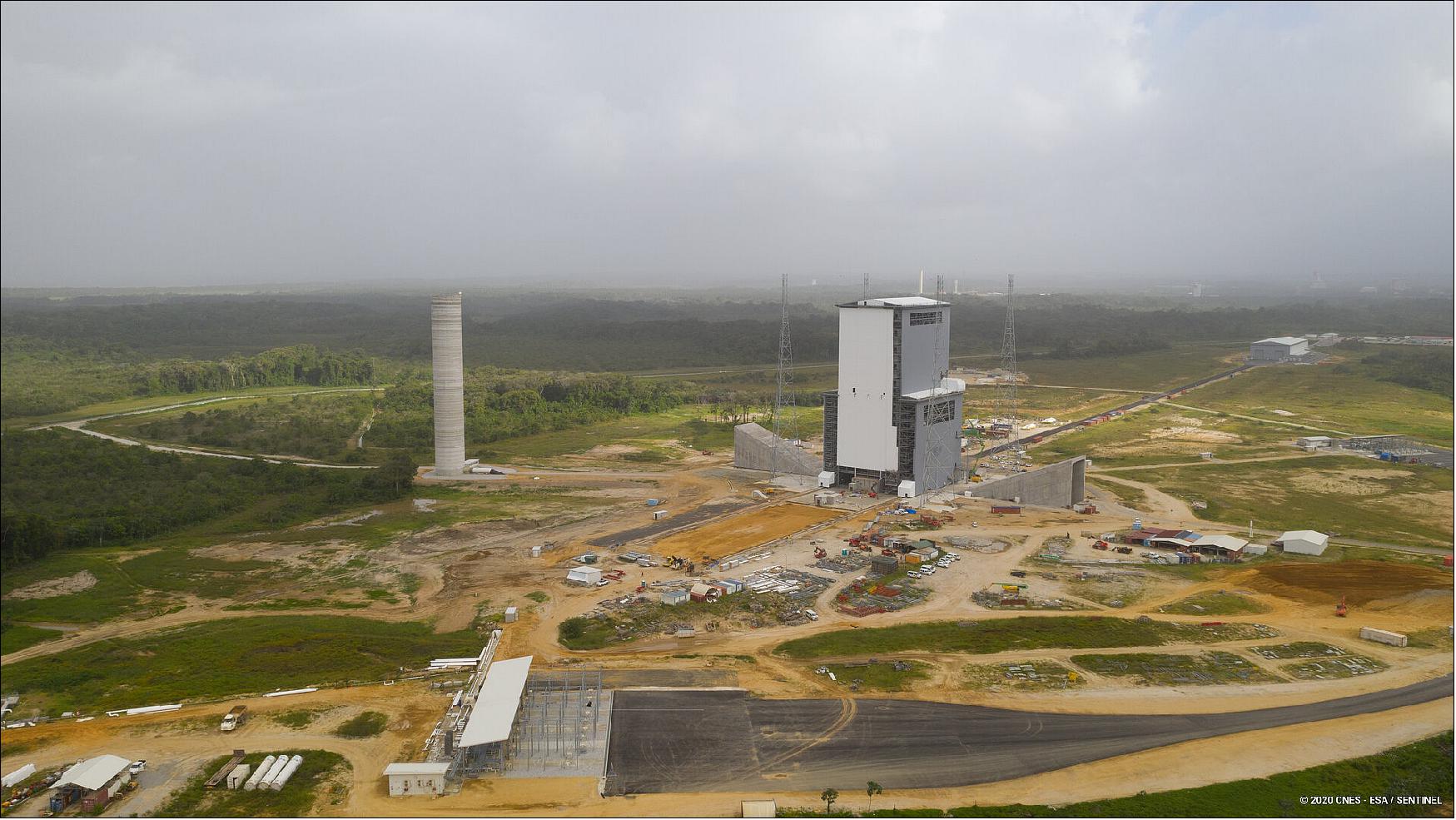
- The 8200 ton 90 meter-high mobile gantry will house Ariane 6 before launch. First in July then again in December 2019, the gantry was rolled along its rails to its prelaunch position over the launch pad. Platforms inside the gantry will allow engineers access to the rocket for integration and maintenance. The mobile gantry is retracted before launch.
- Flame trenches on either side of the gantry will funnel the exhaust at liftoff.
- Four lightning masts have been erected around the launch pad to protect against lightning strikes.
- The water tower pictured left of the mobile gantry will provide the water that will quell the fiery plumes at liftoff.
- The assembly building, on the right (background), is 20 m tall, 112 m long and 41 m wide and is located 1 km away from the launch pad. This is used for Ariane 6's horizontal preparation and integration before rollout to the launch zone.
• January 28, 2020: Europe's Spaceport in French Guiana is almost ready for Ariane 6. Take a tour of the launch complex and its various facilities filmed in January 2020. 43)
• ESA and partners celebrate 40 years of Ariane – a launch vehicle operating in the international space arena, and a symbol of cooperation and innovation that ensures independent access to space for Europe. 44)
- On 24 December 1979, the first Ariane 1 was launched from Europe’s Spaceport in Kourou, French Guiana. Launch L01 carried CAT-1, or Technological Capsule 1, a small satellite used to provide data on the launch characteristics of the new rocket and therefore only powered for eight orbits.
- Ariane 1 was the first launch vehicle to be developed with the primary purpose of sending commercial satellites into geostationary orbit. It was designed mainly to deploy two satellites per mission, thus reducing costs.
- From this first flight, Ariane evolved into a highly reliable rocket boosted by the fast-growing demand for commercial space launches in the 1980s. Operated by Arianespace, Ariane claimed over half the satellite market in this period.
- Altogether, Ariane 1, 2 and 3 launched 28 times between 1979 and 1989, placing a total of 38 satellites in orbit.
- Ariane 4 entered service in 1988 and made 113 successful launches. Its last was on 15 February 2003. It featured an elongated first stage and strap-on liquid and solid-fuel boosters providing more thrust at liftoff. For this version of Ariane, a lighter Sylda fairing structure was introduced. The Sylda allows two payloads to be stacked one on top of the other.
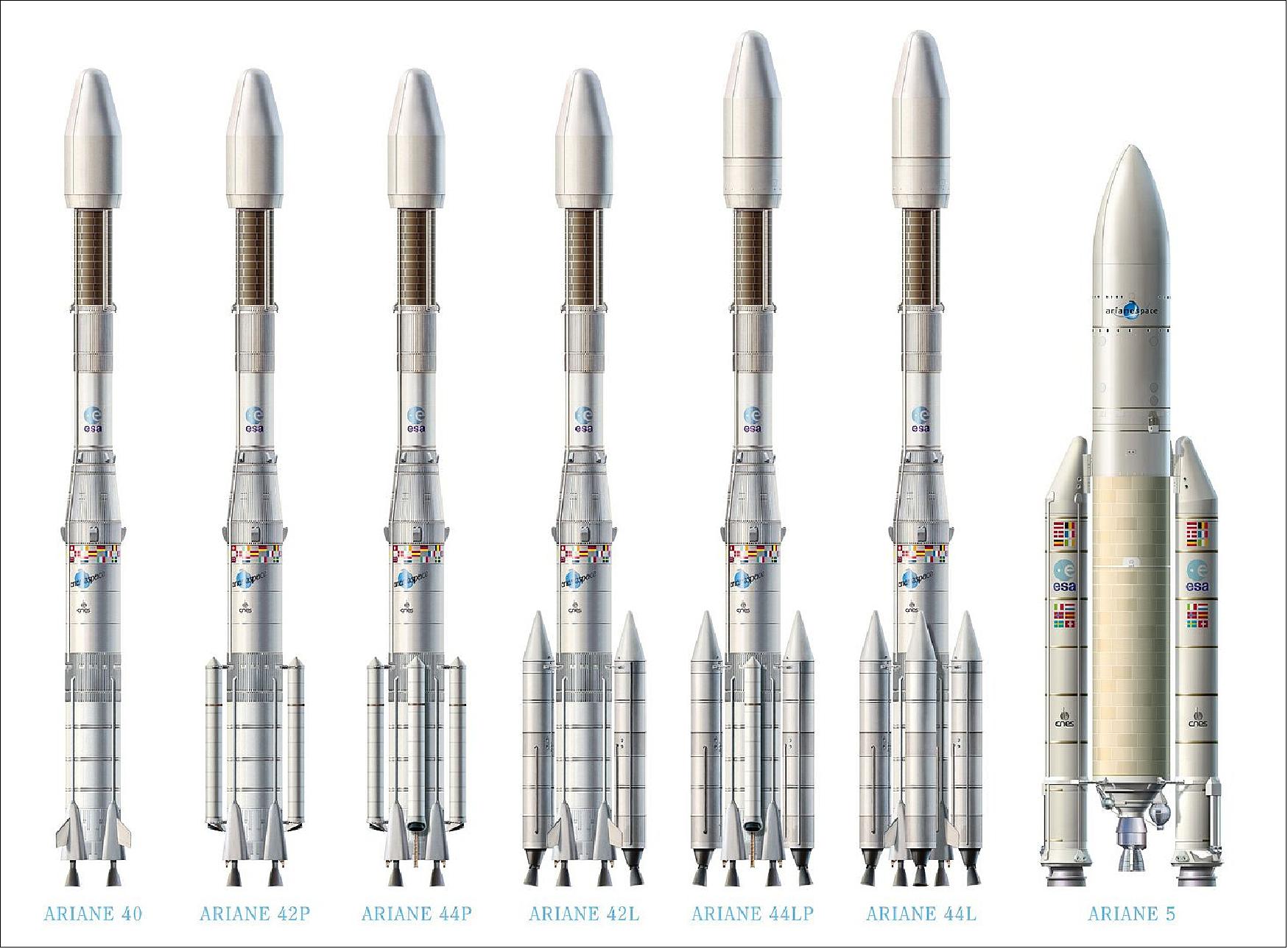
- Ariane 5 is the result of continual investment in new technology, a wider, heavier and shorter design, and new production methods. This has extended Ariane's benchmark lifting capability from its initial 1850 kg to geostationary orbit, to today’s dual payload record of 10,865 kg to geostationary orbit with an Ariane 5 ECA on 2 June 2017.
- Ariane 5’s ES was used for various missions, such as the Automated Transfer Vehicle in low orbit and Galileo in medium orbit. It was retired from service on 25 July 2018.
- Europe's Spaceport lies just above the equator in South America, and hosts facilities for Ariane, Soyuz and Vega launchers.
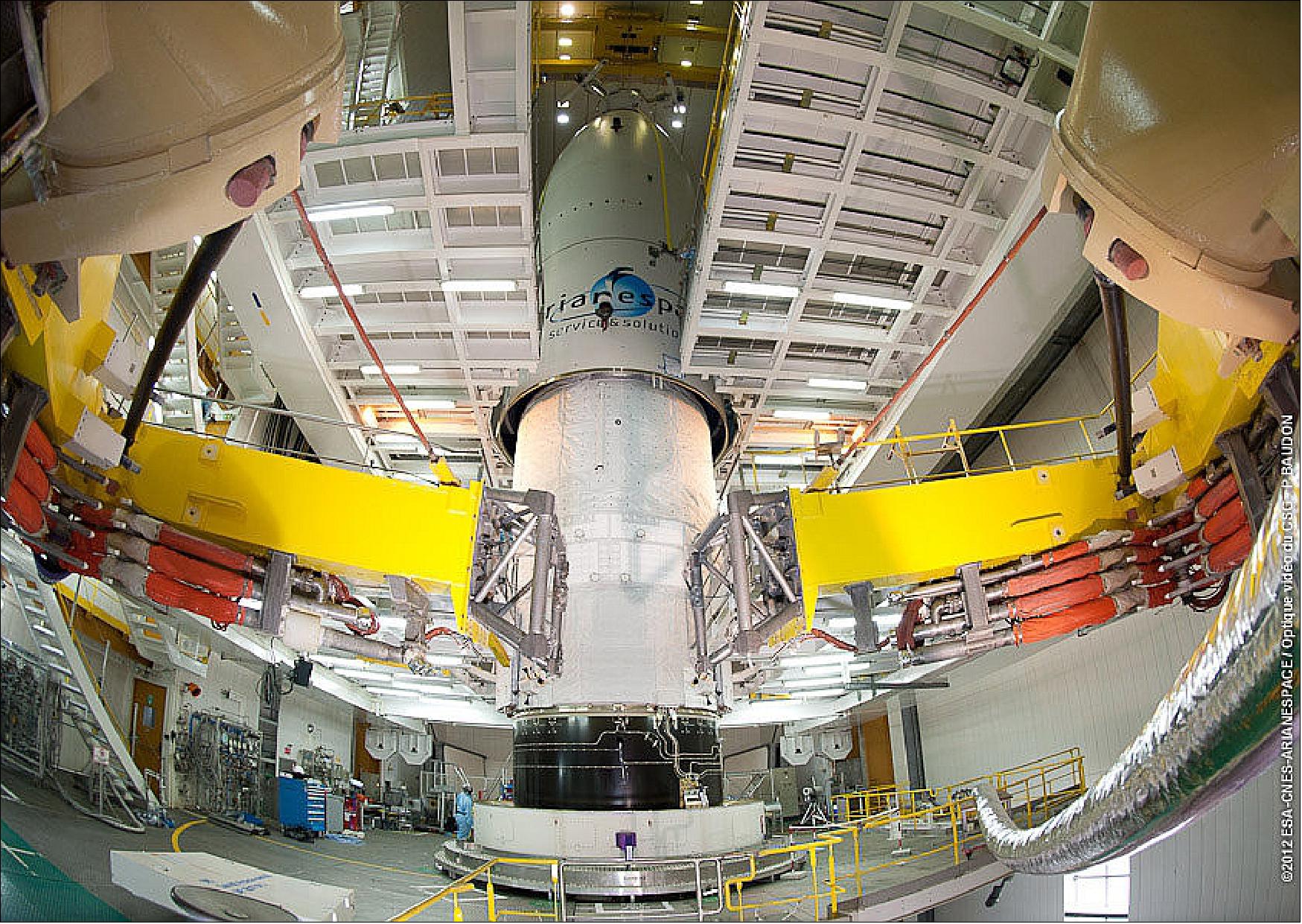
- Continued updates to the Spaceport’s facilities have kept up with the requirements of each new launch vehicle. The pad used by Ariane 1, 2 and 3 was later repurposed for Vega in 2012 and is currently being modified to accommodate the upcoming more powerful Vega-C successor.
- ESA is currently preparing for the next decade in space transportation. Part of this involves the transition from Ariane 5 to the new modular Ariane 6 for which a dedicated launch site has been built.
- Ariane 6 has two versions, Ariane 62 with two strap-on boosters and Ariane 64 with four, for more power.
- The new Ariane design is intended to serve the diverse needs of a wide range of customers offering new payload dispensers for a variety of configurations while dramatically decreasing the cost of launches compared to Ariane 5.
- Changes in the way in which Ariane 6 is assembled, paired with new manufacturing techniques, is set to speed up the turn around time, allowing more Ariane launches than ever before.
- Europe can celebrate Ariane’s history and look forward to building on its successes through innovation and an extreme design-to-cost approach to maintain its lead in a fiercely competitive launch services market.
- Read more about Europe’s Spaceport history and development here. You can also read the article in the ESA Bulletin 172.
• November 26, 2019: Vega-C, due for its first flight next year, is a more powerful version of the current Vega launcher aimed at the thriving small satellite market. Three of its four stages will use solid-propellant motors while its AVUM+ fourth stage – the model of which is seen here attached to the fairing – employs liquid propellant, making it reignitable. 45)
- The two halves of the fairing weigh in at 450 kg each, made of carbon fibre sandwich panels filled with aluminum honeycomb. They have the vital function of safeguarding launcher payloads during the early part of the launch, not just from atmospheric turbulence but also the high noise levels of the crucial first few seconds after take-off, when sound waves bounce off the ground towards the fairing.
- One wall of the LEAF chamber – which stands 11 m wide by 9 m deep and 16.4 m high – incorporates a set of enormous sound horns. Nitrogen shot through the horns can produce a range of noise up to more than 154 decibels, like standing close to multiple jets taking off. LEAF is part of ESA’s ESTEC Test Center in Noordwijk, the Netherlands.
- Two sets of test campaigns allow engineers to collect data on the sound levels the upper stage and payload adapter will experience, once with the fairing and once without. Microphones have been placed around and inside the fairing for these qualification-level tests.
- The fairing will then return to its manufacturer, Ruag Space in Switzerland, where engineers will carry out the remaining qualification tests on this flight hardware, then fit the pyrotechnic cords that will separate the fairing once Vega-C leaves the atmosphere.
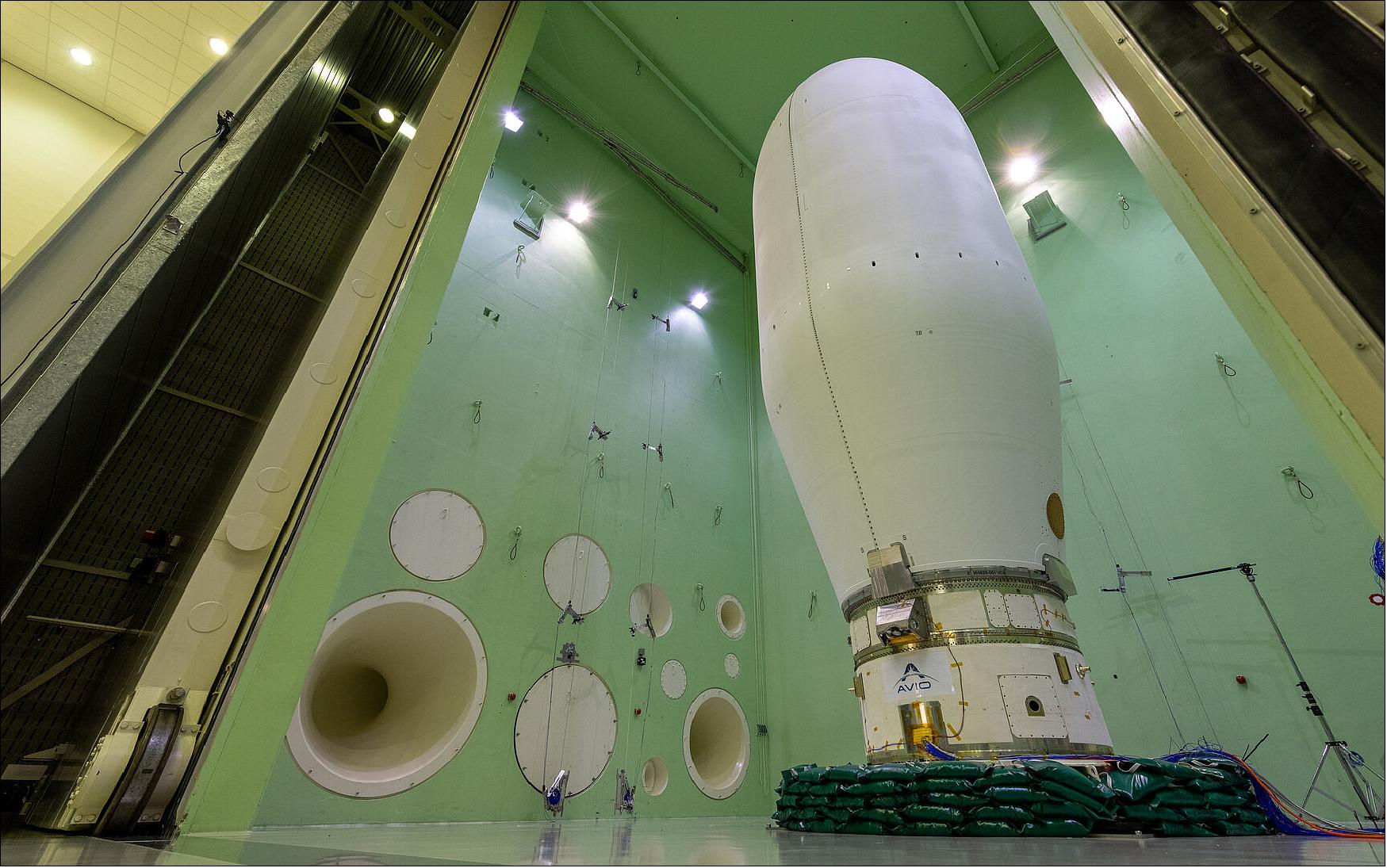
- Vega-C’s inaugural flight is scheduled for mid-2020, carrying the Italian Space Agency’s LARES-2 satellite, a large retroreflector for the study of general relativity related to Earth’s gravitational field.
• November 26, 2019: The first test models of Ariane 6 are being manufactured while Europe’s Spaceport in Kourou, French Guiana, is preparing to test the launch vehicle and all systems involved with launch. 46)
- Under ESA’s responsibility, upcoming tests will show that the launch complex is ready for Ariane 6, and prove the launch system interfaces and performances for launch.
• November 20, 2019: Today, ESA, Arianespace, and respective industrial prime contractors ArianeGroup and Avio signed protocols on the Launchers Exploitation Phase for Ariane 6 and Vega-C. 47)
- With development of Ariane 6 and Vega-C now in the final phase, these protocols will govern the long-lasting exploitation of Ariane 6 and Vega-C. They cover aspects related to technical and industrial responsibilities in the wide range of areas pertaining to operations such as compliance with high-level requirements over the lifetime of both launchers, launch authorization, configuration management, and maintenance of various assets.
- Ariane 6 and Vega-C are of primary importance in guaranteeing access to space for public European missions. ESA has adopted for its missions, and recommended to other European institutional customers, a set of guiding principles for an effective and complementary exploitation of Ariane 6 and Vega-C, based on the respective launcher performances.
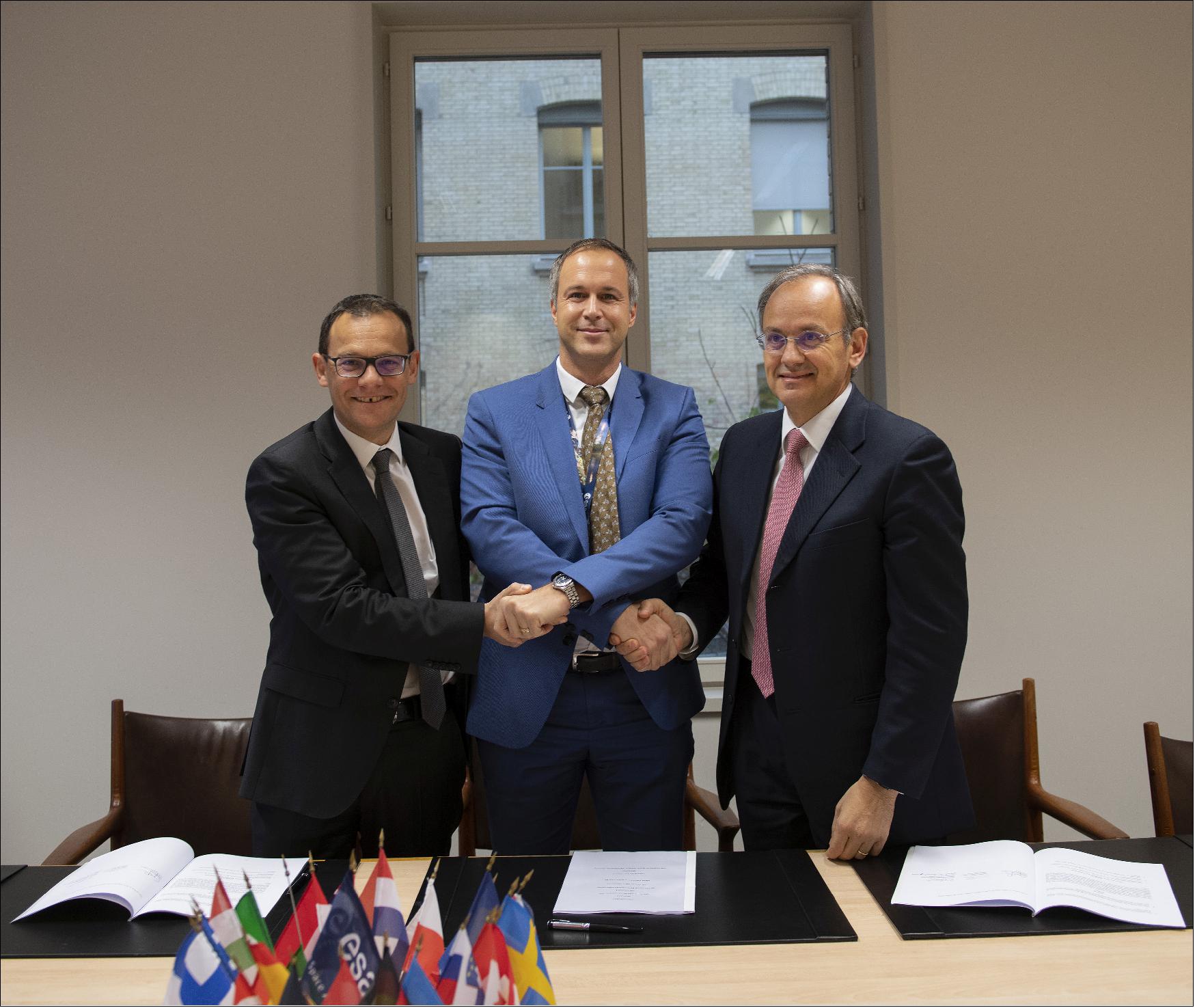
- “The signature of these protocols represents an important step forward. They consolidate the industrial responsibilities for the upcoming operations of Ariane 6 and Vega-C and ensure their mutually beneficial exploitation,” added Daniel Neuenschwander, ESA’s Director of Space Transportation.
- Space capacities are strategically important to civil, commercial, security and defence-related policy objectives. Space is an enabler for responding to societal challenges and for creating jobs and stimulating growth. Europe’s freedom of action in space is conditional to autonomy in accessing space.
• October 22, 2019: Satellites are built to live in the harsh environment of space but engineers must also factor in the rigors of the journey there. ESA has helped RUAG Space Switzerland to develop new rocket fairings that offer a smoother quieter ride to space. 48)
- RUAG manufactures fairings for Europe’s Ariane and Vega launchers and has recently shown how a micro-perforation of the facesheet of the panels of the fairing can reduce noise and vibrations, and how a new hinge and actuation system could reduce the shock of separating the fairing from the launch vehicle when it reaches space.
- “Current technology relies on a simple, compact and highly dependable system that sheds the protective fairing at about three minutes into the flight at an altitude of some 100 km, which is when the rocket enters space,” explained Jorgen Bru, ESA’s Future Launchers Preparatory Program Technology Manager.
- “Typically two pyrotechnic mechanisms detonate to burst hinges open allowing the fairing half shells to safely separate and twist away from the payload stowed inside. It all happens in a split second and is a highly precise, synchronized event.”
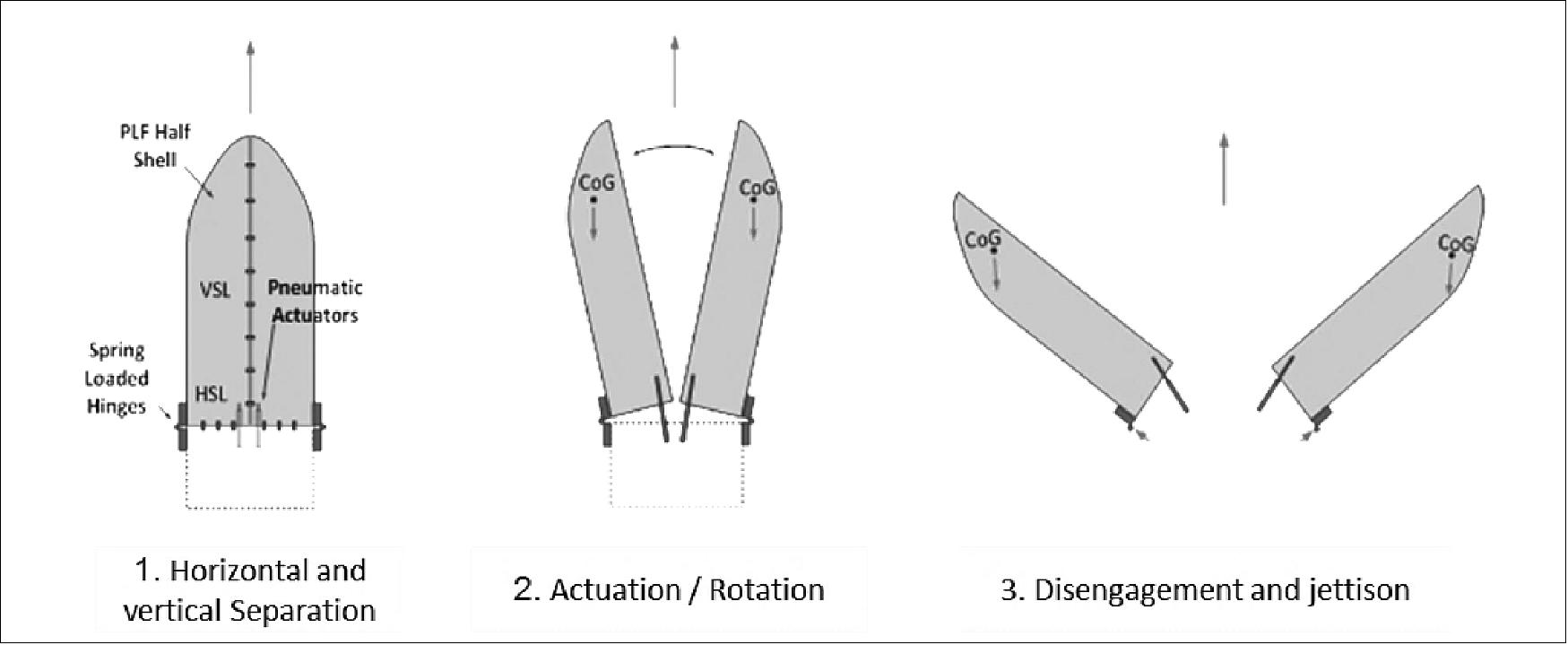
- These pyrotechnic devices are jettisoned with the fairing. They deliver a powerful force while being relatively light and compact, and are proven technology.
- “However, when these pyrotechnic devices are activated, it creates a strong shock effect which is transferred to the launcher and its payload. Satellites are designed to withstand this but companies are now requesting more comfort,” added Jorgen.
- Pyrotechnic systems require thorough testing before being qualified for flight, which is intense, expensive and requires vacuum conditions. A major benefit of RUAG’s replacement low-shock separation and jettison system is that no expensive vacuum chamber is needed for tests because separation relies on a slightly slower non-pyrotechnic process making the friction with air in ground testing much less significant.
- RUAG can achieve the same results using a set of pre-loaded hinges and pneumatic actuators combined with a passive jettison system that pushes the parts away once the separation systems are actuated.
- “This new separation and jettison system, based on hinge and actuator, reduces shock and increases payload comfort during the separation event,” added Alberto Sánchez Cebrian, Project Manager at RUAG.
- Each separation system is discrete. This modular approach reduces development costs as parts can be improved or replaced without affecting the whole system. Testing is simpler and the mechanism requires no synchronization either.
- Tests were carried out on a 2.6 m Vega fairing but the new system is scalable for fairings of Europe’s heavy launcher Ariane.
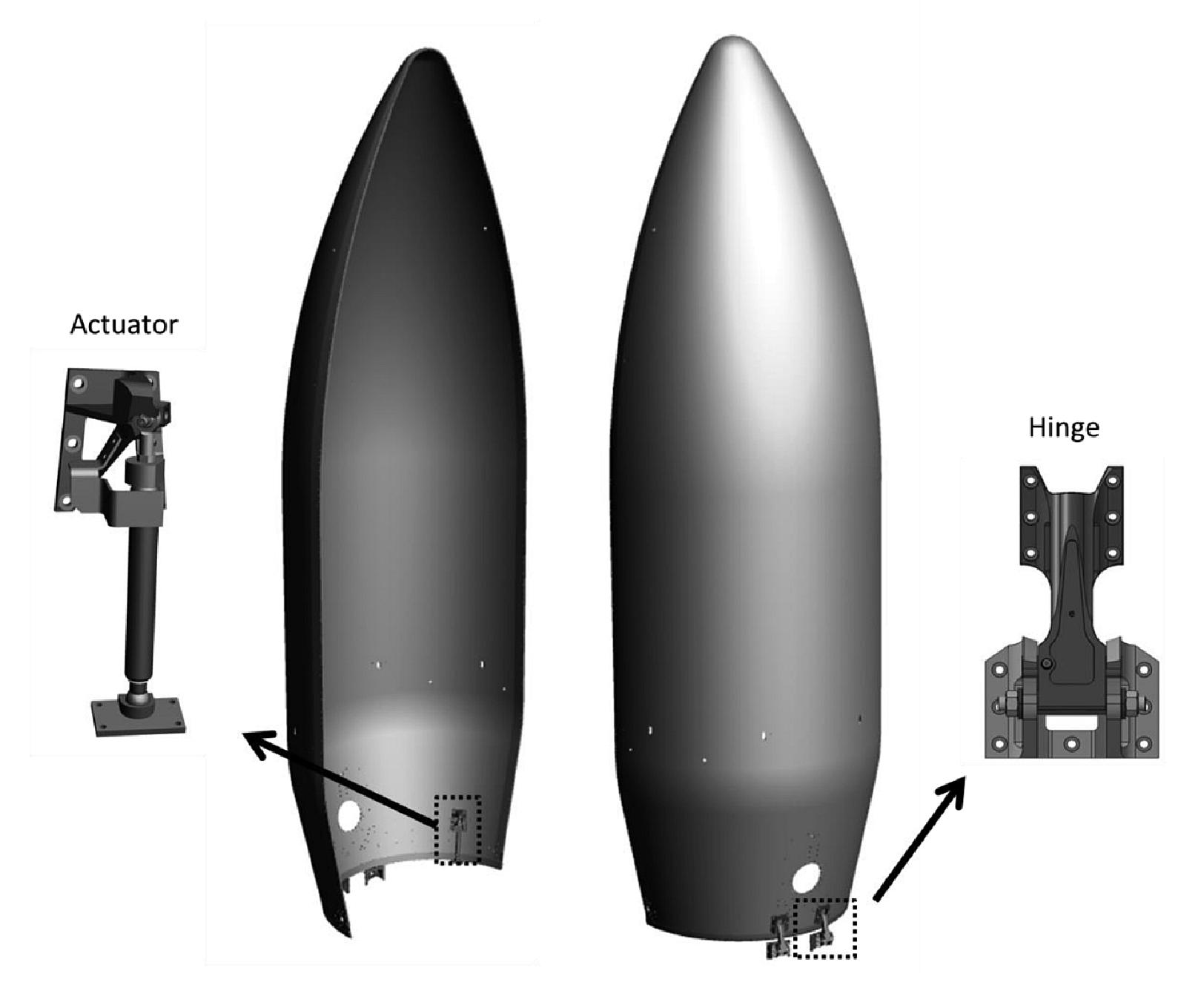
- Alongside the separation tests, modelling of a built in noise-reducing perforated insulation layer within the fairing’s sandwich panels provided a promising noise reduction solution with no increase in mass or volume.
- Significant noise reduction was achieved with no apparent impact on the structural performance of the sandwich panels. This system could replace acoustic absorber mats used currently in rocket fairings. Testing of larger panels will continue in the next project phase.
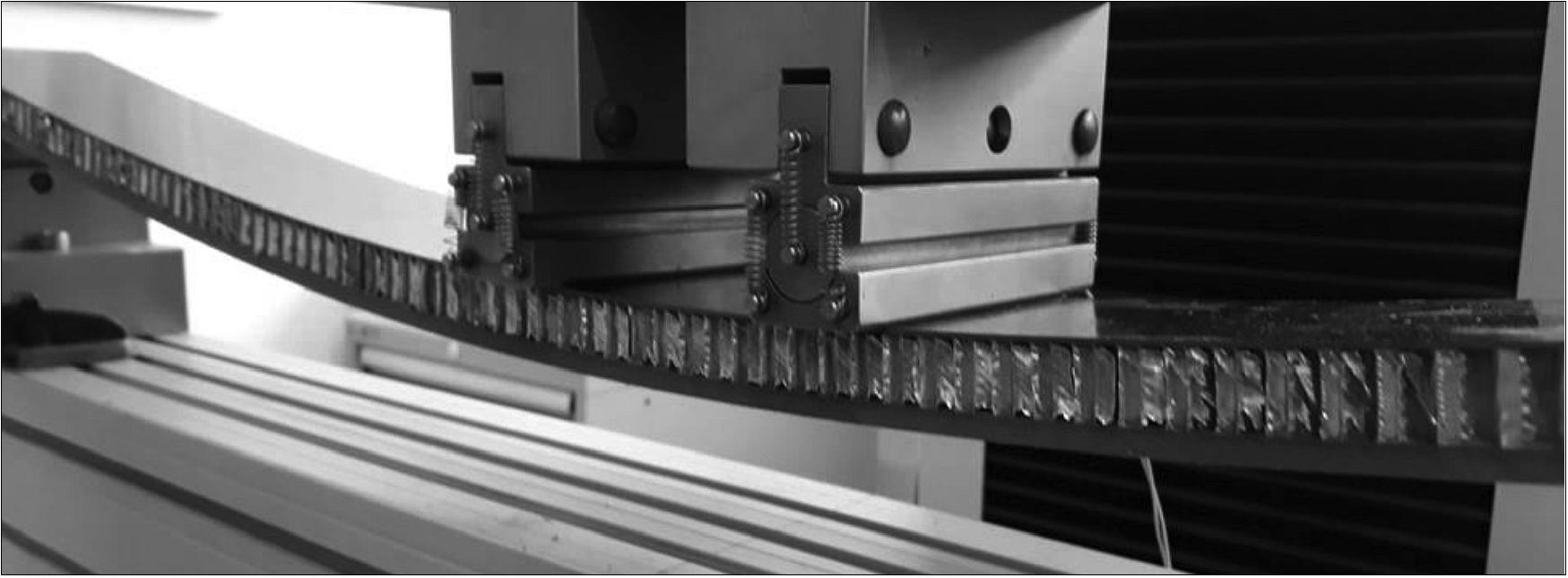
- These activities were funded and carried out within ESA's Future Launchers Preparatory Program.
- RUAG’s fairing modifications will allow designs of more delicate satellites and relax requirements on the launch vehicle.
• September 27, 2019: Ariane 6, Europe's next-generation launch vehicle, has passed another key development milestone. Its Vulcain 2.1 liquid-fuelled engine has now completed its qualification testing, which means combined tests can now begin. 49)
- The main stage Vulcain 2.1 engine will deliver 135 t of thrust to propel Ariane 6 in the first eight minutes of flight up to an altitude of 200 km.
- A review last week marked the culmination of two Vulcain static firing test campaigns over 15 months on two demonstration models in test facilities at the DLR German Aerospace Center test facility in Lampoldshausen.
- The final qualification static firing test of Vulcain 2.1 in July lasted almost 11 minutes (655 seconds). This completed a total of 13,798 seconds of operation, or nearly four hours with a controlled engine, using Ariane 6 flight actuators to gimbal the engine.
- “These very positive results confirm the functional and mechanical behavior of Vulcain 2.1. The upcoming combined tests will qualify Ariane 6 subsystems at stage and launcher level,” commented Guy Pilchen, ESA’s Ariane 6 launcher project manager.
- The engine will be refurbished for dynamic and vibration tests. Combined tests using a fully representative main stage at Europe’s Spaceport in French Guiana, will finally qualify the Ariane 6 core stage for flight.
- Completion of the Vulcain 2.1 and Vinci qualification tests represent a major step forward in the Ariane 6 development.
- The qualifying tests for the Vinci re-ignitable engine, which will power the launcher’s upper stage, were completed in October 2018. Vinci will be integrated with the complete upper stage for tests at Lampoldshausen.
- The next step for large propulsion systems is the static firing in French Guiana of the final qualification model of Ariane 6’s P120C solid fuel booster. This test will define the acceleration profile for the launcher and will consequently allow engineers to pursue the preparation of the upcoming flights.
• July 29, 2019: At Europe’s Spaceport the Ariane 6 mobile gantry, a 90 m high metallic structure built to house Ariane 6, underwent a 97 m rollout test last week to mimic prelaunch. 50)
- This 90 m-high metallic structure is nearly a thousand tons heavier than France's Eiffel Tower. It will house Ariane 6 and when fully equipped will weigh 8,200 tons. Its platforms provide access to the launch vehicle for integration on the launch pad. It protects Ariane 6 until its doors are opened and it is retracted about five hours before the launch.
- The mobile gantry stands on 16 bogies, each bogie comprises eight wheels and each wheel is equipped with one electric motor. A total of 128 electric motors synchronize to set the wheels in motion along rails.
- “Preparation is everything but the actual move is automated and quite simple,” explained Jean-Michel Rizzi, ESA’s Ariane 6 Launch Base Project Manager, “You choose to move the gantry forward or backwards and then press the start button.
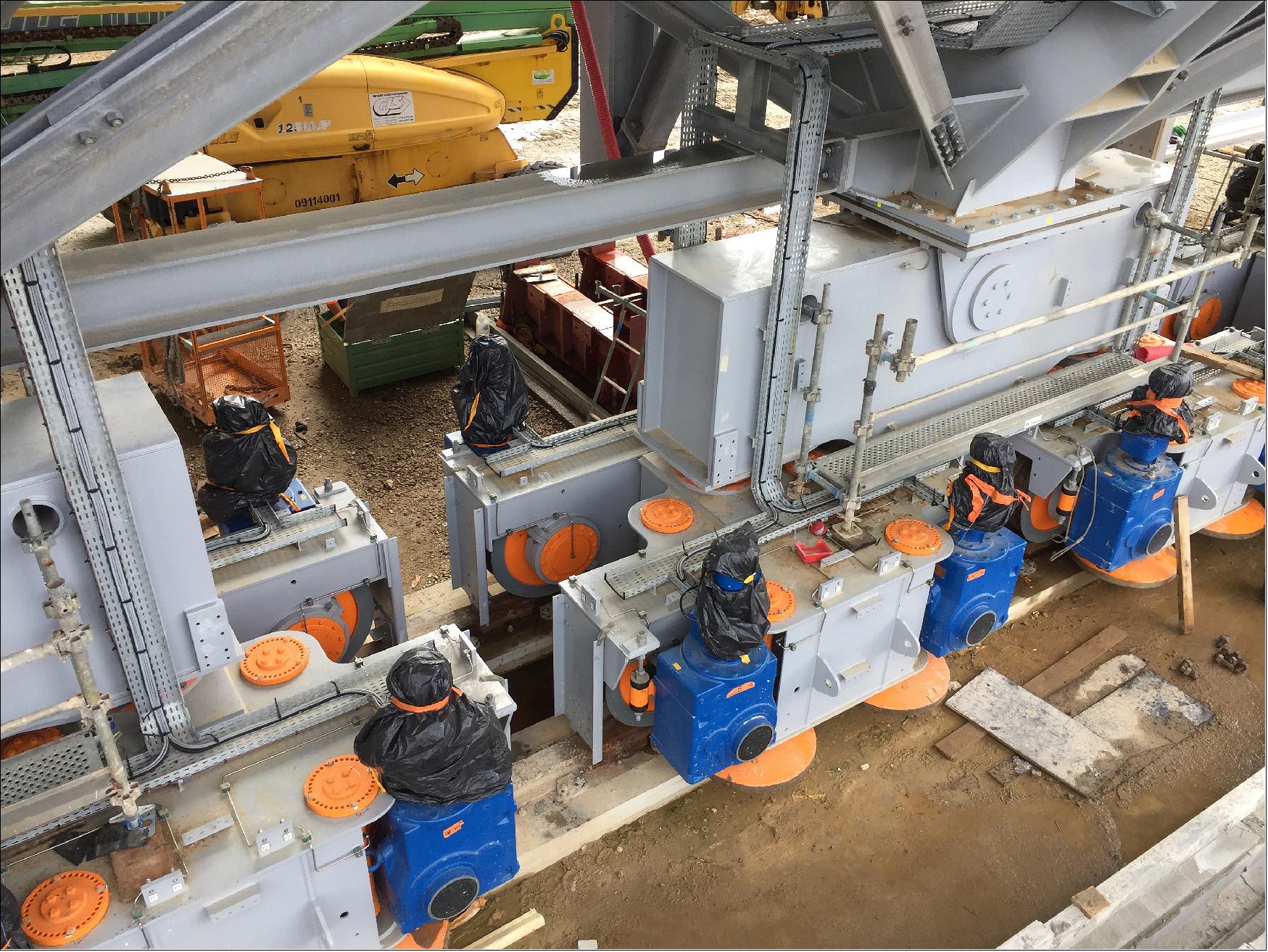
- “There are three speeds. The first and last meter are done at the slowest speed of 1m/minute. This increases to a ‘cruising’ speed of 7.6 m/minute for a 130 m stretch and then slowed back down to 3 m/minute in the decelerating phase over a distance of 9 m. The full rollout of 141 m takes 22 minutes.”
- Over the next five weeks this test will be repeated several times and after each test, the mobile gantry will be rolled back to its initial pulled back position.
- Current works being carried out around the nearby mast will soon be finished allowing the mobile gantry to follow the full track length.
- The Ariane 6 Launch Base construction is nearly complete and final tests are proving the infrastructures are ready for handover from industry to CNES, France’s Space Agency. These rollouts are part of this process. At the end of this year all systems are expected to be fully integrated.
- After a successful Launch Base Technical Qualification Review, CNES will hand over the launch base to ESA.
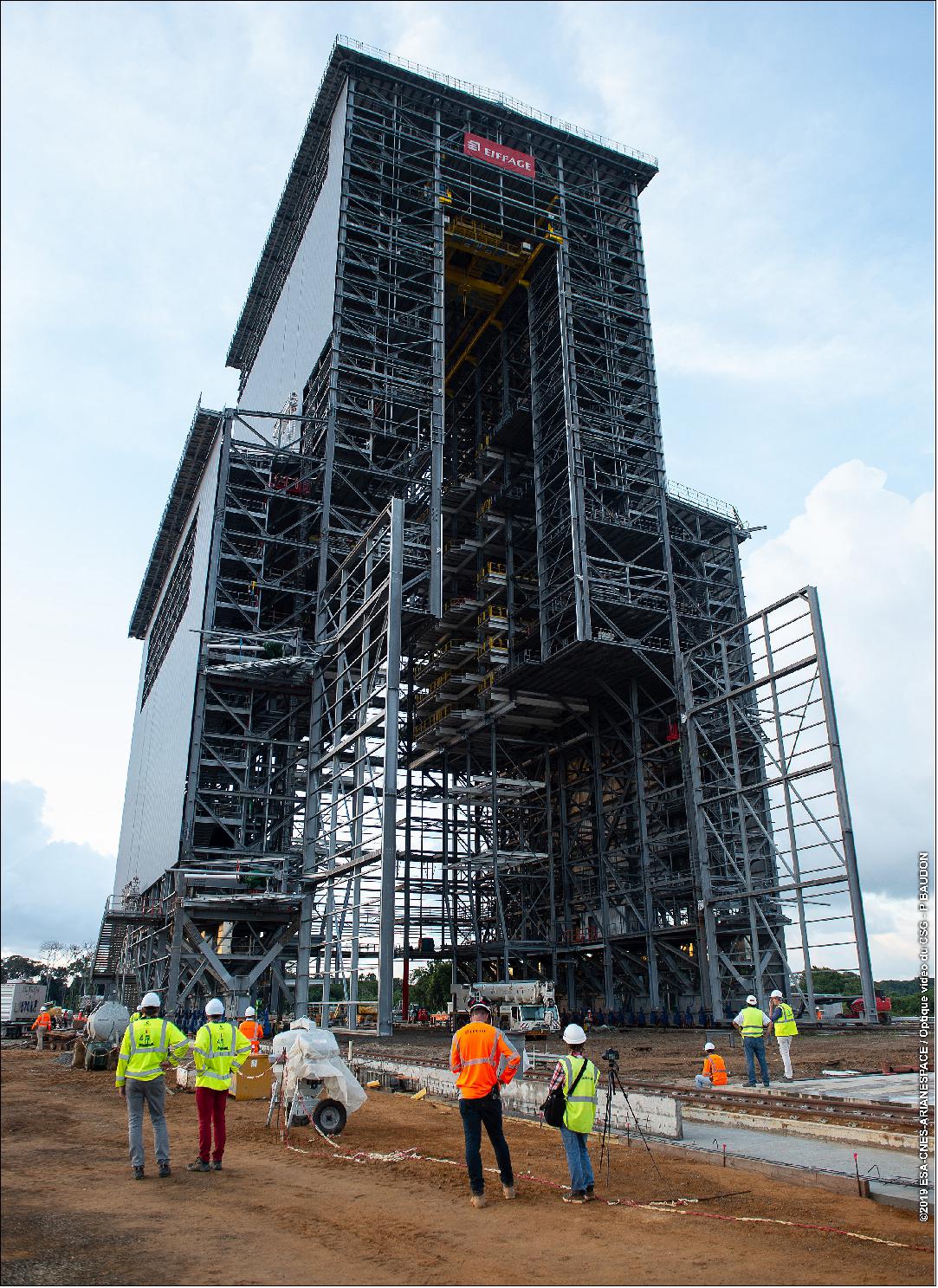
• July 18, 2019: The Ariane Group is reporting that the 26th qualification tests of the Vulcain® 2.1 engine, which will power the Ariane 6 main stage, have been successfully completed. 51)
a) The qualification tests of the Vulcain®2.1 engine, which will power the Ariane6 main stage, were completed during the 26th development test.
b) This final qualification test took place on 16 July on the P5 test stand at the DLR site in Lampoldshausen
c) Both Ariane6 liquid propulsion engines have now completed their firing qualification tests
d) The qualification tests for the Vinci re-ignitable engine for the Ariane upper stage were completed in October 2018.
- This final qualification test, carried out on the P5 test stand at the German Aerospace Center(DLR)site in Lampoldshausen, lasted almost 11minutes (655 seconds).
- This success, which is decisive for the further development of Ariane6, marks the end of this qualification test campaign, during which the Vulcain®engine will have functioned for 13,798 seconds, or a total of nearly4 hours.
- The significant milestones achieved during the Vulcain®2.1 qualification campaigns include:
1) a total of 13,798 seconds of operation, or nearly 4 hours;
2) a firing test with a controlled engine oscillation of ±5º, using Ariane6 flight actuators.
- “Completion of the Vulcain 2.1 engine qualification tests is a major step forward in the development of Ariane6. Following the qualification of the Vinci engine last year, all the Ariane6 liquid propulsion engines have now completed their qualification firing tests”,said André-Hubert Roussel, CEO of ArianeGroup. “The last step in the qualification of the Ariane6 engines will be that of the solid fuel side booster. Its third and final firing will take place in French Guiana at the beginning of 2020”.
- The qualifying tests for the Vinci® re-ignitable engine, which will power the launcher’s upper stage, were completed in October 2018. On the solid propulsion side, the P120C solid fuel engine, which will equip the Ariane boosters and the first stage of Vega-C, has already been tested twice successfully in French Guiana. Its qualification will be completed with the third test bench firing at the Guiana Space Center in Kourou.
• June 27, 2019: An Irish space company will design, develop and deliver on-board live telemetry for Europe’s next-generation Ariane 6 launch vehicle under a contract signed yesterday. 52)
- Réaltra Space signed the agreement with ArianeGroup, the prime contractor to ESA for the development of Ariane 6. The company will provide live video images from cameras located on board Ariane 6, showing each stage of the launch.
- The first Ariane 6 flight is scheduled to take place in 2020.
- Ariane 6 has a modular structure that has three stages that propel it to space: either two or four strap-on solid rocket motors; followed by a core stage; and an upper stage.
- The robust cameras supplied by Dublin-based Réaltra Space will capture the moments at which the stages separate as the rocket soars up through the atmosphere on its way to space.
- John Halligan, Minister for Training, Skills, Innovation, Research and Development in the Irish government, said: “The awarding of this contract is a significant achievement for Réaltra and demonstrates how Irish space companies can succeed in the delivery of cutting-edge space technologies. The world-class activities in Réaltra are building the reputation of Ireland’s space technology sector in the global marketplace and creating high-value jobs in Irish companies.”
• June 20, 2019: ESA is involving potential European stakeholders early on in the development and exploitation of the Vega space transportation system, including Space Rider. 53)
- New payload carriers are being developed with the first ride share this year on Vega’s Small Spacecraft Missions Service. Further payload capabilities will be available through Europe’s next-generation Vega-C in 2020 and the Space Rider in 2022, also offering a laboratory for payloads operations in space and return to Earth for a host of applications.
- Vega and Space Rider active industrial partners and newcomers are proposing innovative ideas to be processed and incorporated in ESA proposals presented at Space19+ in November where ESA Member States will take decisions on the future of Europe in space.
- ESA’s Space Transportation Directorate aims to gather the widest industrial background, competence and interest necessary to implement its programs’ activities at system, subsystem and components levels. Part of this has been achieved by exchanging detailed information with current and potential developers and end users.
• June 7, 2019: The ELA-4 (French: l'Ensemble de Lancement Ariane 4) launch site is currently undergoing construction and is intended as the future launch site for the Ariane 6 launch vehicle. Both the launch pad itself and the BAL (Fench: Bâtiment d’Assemblage Lanceur) - the launcher assembly building are being worked on for use with Ariane 6. 54)
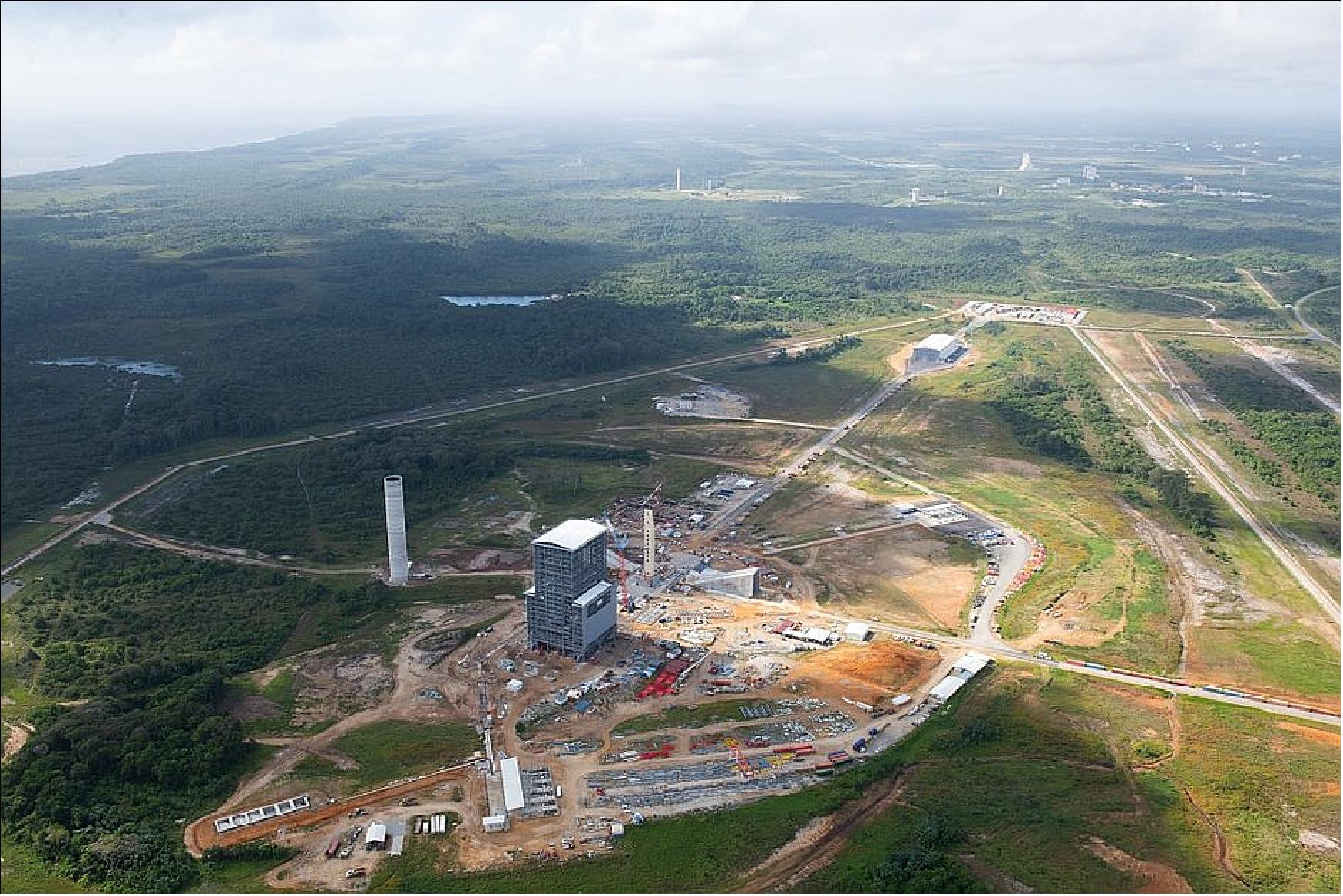
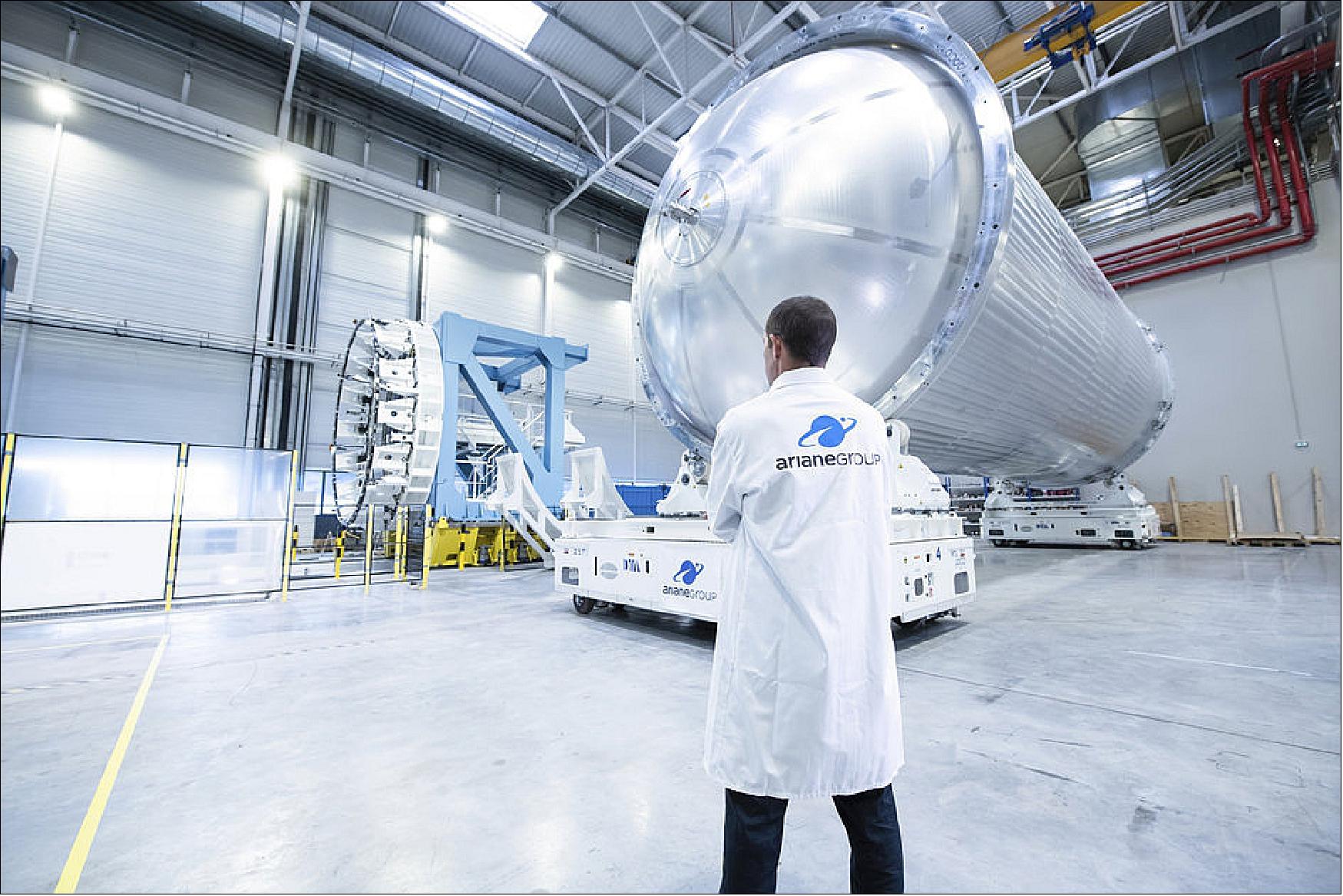
![Figure 72: With the help of ESA, RUAG Space developed an out-of-autoclave process where the carbon-fibre shells of the rocket fairing are cured in an industrial oven instead of an autoclave. It reduces cost and saves time. - The first fairing manufactured in this way was flown on Ariane 5, flight VA238 on 28 June 2017. Vega began using the new type of fairing on 1 August 2017. Ariane 6 and Vega-C fairings will also be produced in the same way. The first half-shell of Ariane 6 (pictured) has been made [image credit: RUAG Space (Switzerland)] 57)](https://www.eoportal.org/ftp/satellite-missions/a/Ariane6_140722/Ariane6_Auto30.jpeg)
• May 6, 2019: Arianespace has signed an order with ArianeGroup to begin manufacturing the first series-production batch of 14 Ariane 6 launchers across the European space industry. 58)
a) Production of this initial batch of Ariane 6 launchers, which are to fly during the 2021-2023 timeframe, will be in parallel with the final batch of 8 Ariane 5 launchers.
b) These first series-production Ariane 6 launchers will roll out of the ArianeGroup plants from early 2021.
c) Ariane 6 is carried out within an ESA (European Space Agency) program. The Ariane 6 maiden flight is scheduled for 2020.
- Following the initial institutional and commercial launch orders for Ariane 6 obtained by Arianespace since the autumn of 2017, and the resolution of the ESA Council on April 17, 2019, related to the rocket’s exploitation framework, ArianeGroup is starting to build the first series-production batch of 14 Ariane 6 launchers.
- These 14 launchers, scheduled to fly between 2021 and 2023, will be built in ArianeGroup plants in France and Germany, as well as in those of its European industrial partners in the 13 countries taking part in the Ariane 6 program.
- In parallel, ArianeGroup is proceeding with manufacturing of the model to be used for ground qualification tests on the launch pad in French Guiana, as well as the Ariane 62’s first flight vehicle, for which the inaugural launch is planned for 2020.
- “Starting work on the first Ariane 6 series-production batch, less than four years after signing the development contract with ESA in August 2015, is a real success for the European space industry as a whole. We have made the necessary efforts to set up a new, more efficient and competitive European industrial organization in record time. We can now ensure the ramp-up of Ariane 6 production and prepare for its launch operations. Our customers are eagerly awaiting Ariane 6, and it will be delivered on time,” said André-Hubert Roussel, CEO of ArianeGroup. “I am particularly grateful to the teams at ArianeGroup, Arianespace, and our industrial partners throughout Europe who – each in their area of responsibility – work hand-in-hand to make the development, production, and marketing of the launcher possible. I also extend my warmest thanks to the European Space Agency, its member states and the national space agencies for their continued support in this great adventure, which is just beginning.”
- Luce Fabreguettes, Arianespace’s Executive Director for Missions, Operations and Procurement, added: “With the kick-off of these first 14 series-production Ariane 6 launchers, Arianespace is proud to continue to offer its customers the best launch services. Thanks to its 62 and 64 versions and the re-ignitable Vinci engine, Ariane 6 will be able to offer an increasingly varied range of missions to satisfy the expectations of its institutional customers and address new trends in the commercial market.”
- Ariane 6 – an ESA program – will be a versatile and competitive launcher particularly well-adapted to market developments. It is modular and will be available in two versions: Ariane 62 (with two P120 solid fuel boosters, common with Vega-C) and Ariane 64 (with four P120C solid fuel boosters), enabling it to carry out all missions, to all orbits, and to guarantee continued European access to space.
- ArianeGroup is the prime contractor for the development and operation of the Ariane 5 and Ariane 6 launchers, and coordinates an industrial network of more than 600 companies, including 350 SMEs (Small and Medium Enterprises) in 13 European countries. Arianespace is responsible for the exploitation of Ariane, Soyuz and Vega launch systems, ensuring their commercialization and subsequent flight readiness and mission preparation for customers.
- ArianeGroup develops and supplies innovative and competitive solutions for civil and military space launchers, with expertise in all aspects of state-of-the-art propulsion technologies. ArianeGroup is lead contractor for Europe’s Ariane 5 and Ariane 6 launcher families, responsible for both design and the entire production chain, up to and including marketing by its Arianespace subsidiary, as well as for the missiles of the French oceanic deterrent force. ArianeGroup and its subsidiaries enjoy a global reputation as specialists in the field of equipment and propulsion for space applications, while their expertise also benefits other industrial sectors. The group is a joint venture equally owned by Airbus and Safran, and employs approximately 9,000 highly qualified staff in France and Germany. Its 2018 revenues amounted to 3.6 billion euros.
- Arianespace uses space to make life better on Earth by providing launch services and solutions for all types of satellites (institutional and commercial) into all orbits. It has orbited more than 600 satellites since 1980, using its family of three launchers, Ariane, Soyuz and Vega, from launch sites in French Guiana (South America) and Baikonur (Central Asia). Arianespace is headquartered in Evry, near Paris, and has a technical facility in Kourou at the Guiana Space Center, Europe’s Spaceport in French Guiana, plus local offices in Washington, D.C., Tokyo and Singapore. Arianespace is a subsidiary of ArianeGroup, which holds 74% of its share capital, with the balance held by 15 other shareholders from the European launcher industry.
• April 9, 2019: ESA and Arianespace are giving full support to European institutional customers to launch their missions on Ariane 6 and Vega-C. Daniel Neuenschwander, ESA’s Director of Space Transportation and Stéphane Israël, CEO at Arianespace welcomed about 100 attendees to a conference last week on Ariane 6 and Vega-C at ESA-ESTEC in Noordwijk, the Netherlands. 59)
- In-depth information on the status of development of Europe’s next-generation launchers, and answers to mission specific technical questions, led to productive two-way discussions and follow-up splinter sessions.
- Ariane 6 and Vega-C, which will debut next year, will see their activities strongly boosted by institutional missions during the transition phase of 2020–2023.
- Ariane 6’s maiden flight has already been earmarked for the launch of OneWeb’s constellation satellites, and Vega-C for the launch of LARES. Three European institutional contracts have already been signed for Ariane 6 and Vega-C launch services, with others expected in the coming months.
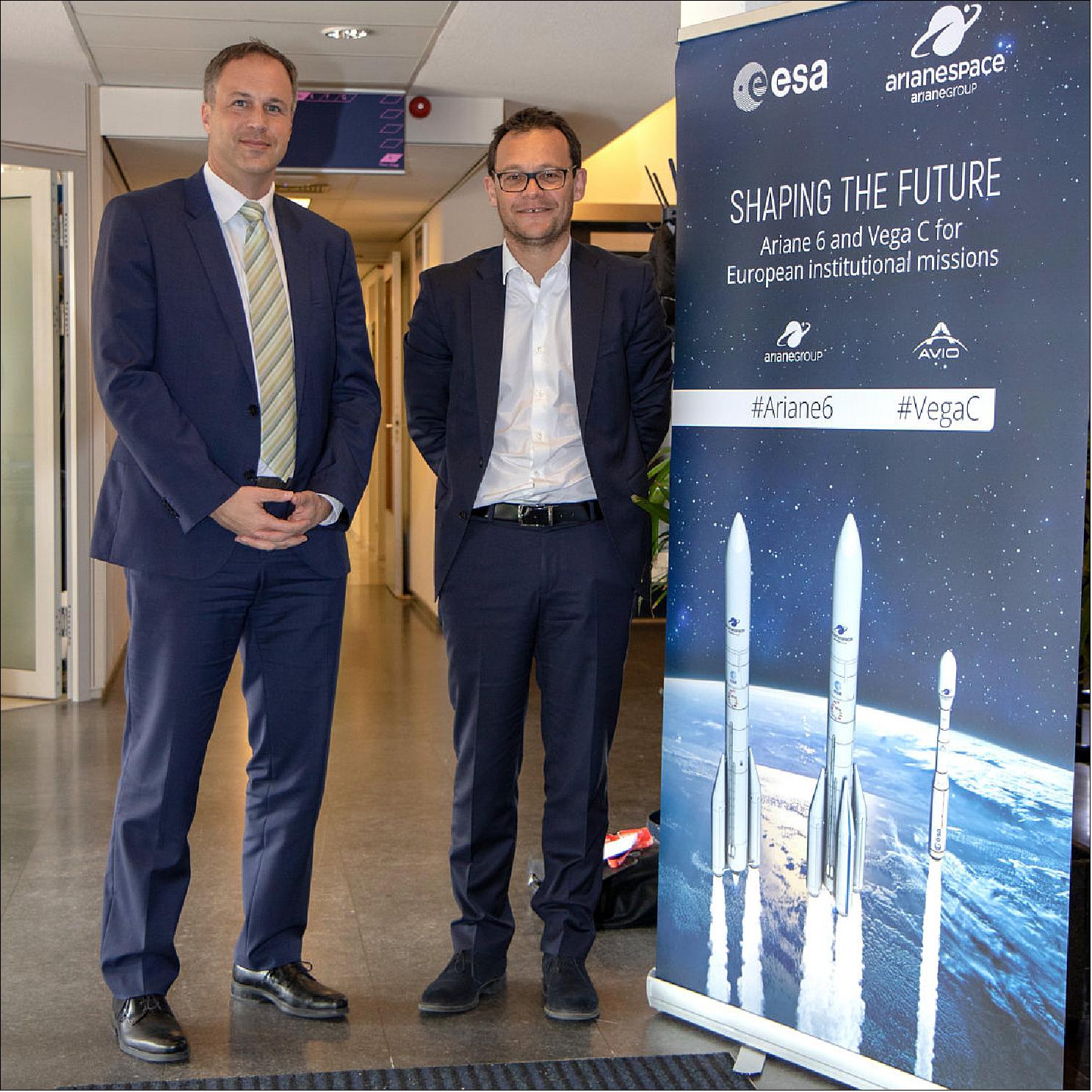
- Low-cost launch opportunities based on a standardized regular service offered through ESA developed payload carrying structures on Ariane 6 and on Vega/Vega-C for light satellites, from CubeSats to minisats, were also discussed in dedicated technical sessions.
- The first of the new payload carrying structures, the SSMS (Small Satellites Mission Service), aimed to meet the needs of a thriving small satellites market, is set to launch on Vega this summer providing a rideshare opportunity for seven microsatellites and 35 CubeSats. Its following launch will be on Vega-C in 2020.
- The Multi Launch System for multiple payloads offered by Ariane 6 is well under development, with an initial mission planned for 2021.
- Compared to the current Vega, the exploitation of Vega-C will allow more launches per year for increased performance to more orbits.
- Ariane 6 will come in two configurations, Ariane 62 with two boosters and 64 with four boosters, depending on mission requirements, to respond to institutional and market demand based on the Ariane 5 heritage and reliability.
- “Ariane 6 and Vega-C are perfectly adapted to handle complex missions and are capable of meeting every mission requirement in full complementarity,” commented Stéphane Israël.
- “The future of Europe and space is closely linked,” added Daniel Neuenschwander, “Let’s fly European.”
• March 19, 2019: Ariane 6 maiden flight will deploy satellites of the OneWeb constellation; OneWeb also books options with Arianespace for two more Ariane 6 launches. 60)
- OneWeb is the developer of a new global, high-speed, low latency satellite-based network designed to address the most demanding global connectivity challenges worldwide. Ariane 6 will be available to OneWeb from the second half of 2020 to provide launch capacity that supports the full deployment and replenishment of the OneWeb constellation.
- The launch service agreement specifies the use of the qualification launch of the Ariane 62 version, scheduled for the second half of 2020; the two Ariane 6 options (either in its 62 version, accommodating up to 36 OneWeb satellites, or in the 64 version, up to 78 OneWeb satellites) will be utilized starting in 2023.
- The OneWeb satellites will be launched by the first Ariane 62 into a near-polar orbit at an altitude of 500 kilometers before raising themselves to their operational orbit.
- OneWeb’s mission is to deliver global communications through a next-generation satellite constellation that will bring seamless connectivity to everyone, everywhere.
- To this end, OneWeb is building a network of low-Earth orbit satellites that will provide high-speed, low latency services to a range of markets – including aeronautics, maritime, backhaul services, community Wi-Fi, emergency response services and more. Central to its mission, OneWeb also will be focused on connecting schools and working to bridge the digital divide for people everywhere.
- With its system deployed, the OneWeb constellation will enable user terminals capable of offering 3G, LTE (4G), 5G and Wi-Fi coverage, giving high-speed access around the world – by air, sea and land.
- The Ariane 6 launch vehicle has two variants – Ariane 62 and Ariane 64 – which allows Arianespace to offer a wide new range of launch services and solutions to customers.
- OneWeb already has entrusted Arianespace with 21 Soyuz launches to ensure the timely deployment of its constellation, whose first successful launch occurred on February 27, 2019, from the Guiana Space Center (CSG), French Guiana, South America.
- Adrian Steckel, OneWeb Chief Executive Officer, said: “I am happy to announce we will be continuing our partnership with Arianespace to launch additional satellites for our constellation on Ariane 6. Our first launch represented the start of our mission to provide connectivity for everyone, everywhere and we are grateful to Arianespace for their professionalism and fundamental role in making our launch a success. With our first six satellites in orbit, first customer contracts signed, OneWeb has entered its commercialization phase and is one step closer to reaching our dreams of providing global connectivity.“
- “We are glad to see OneWeb on board the first Ariane 6. It confirms its attractiveness on today’s commercial market and sets a mark for Ariane 6’s future,” added Daniel Neuenschwander, ESA Director of Space Transportation.
- With the signature of this new contract, Stéphane Israël, Arianespace Chief Executive Officer, made the following statement: “Arianespace is extremely proud to be a part of the effort to deploy OneWeb’s constellation. OneWeb’s choice to fly aboard the first Ariane 6 says a great deal about Arianespace’s DNA: we have always been at the forefront in bringing together innovation and reliability. This contract illustrates the outstanding versatility of our future launcher, which will be a champion during the next decade, embracing all market needs. I wish also to thank the European Space Agency which has accepted to allocate to the market this first flight of Ariane 6, which is part of its development contract with our prime contractor and parent company ArianeGroup.”
• March 11, 2019: The Vega-C launch system recently passed its CDR (Critical Design Review) and is now ready to complete manufacturing and final testing as part of the qualification phase. 61)
- This Critical Design Review is a major milestone. Independent experts from ESA, national institutions and industries confirmed the consistency and maturity of the entire Vega-C launch system design, authorizing the program to enter the design qualification phase for the inaugural flight planned in the first quarter of 2020.
- The review included all the elements of the Vega-C launch system, as well as integration activities for the launch base and launch range.
- It encompassed all detailed design aspects and test campaigns performed on all launch system elements, such as the solid rocket motors (P120C and Z40), structural components, avionics equipment, and related integrated system aspects.
- The review Board meeting, chaired by Toni Tolker Nielsen, ESA’s Inspector General, and Daniel Neuenschwander, ESA Director of Space Transportation, concluded the review by commending the teams, and giving the green light to proceed to the next phase.
- “This critical milestone was achieved thanks to the extraordinary commitment of all industry involved in the Vega-C development to meet the challenging objectives and planning of the program. This timely success shows that we are on track,” commented Giorgio Tumino, Vega Development Program Manager.
- Qualification tests will verify the design and manufacturing processes, assembly and flight hardware and software, and associated ground support systems. Simulations will show the space and ground segment work together as they should.
- Stefano Bianchi, ESA’s Head of Space Transportation Development Department added: “We have a challenging twelve months ahead, starting with four Vega launches between March and November and ending with the maiden flight of Vega-C. We have an exceptional team within European industries and Agencies, to meet these challenges!”
• January 29, 2019: The first qualification model of the P120C solid-fuel motor, configured for Vega-C, was static fired yesterday on the test stand at Europe’s Spaceport in French Guiana. 62)
- Fully loaded with 142 tons of fuel, the 13.5 m long and 3.4 m diameter motor was ignited for a final simulation of liftoff and the first phase of flight.
- During a burn time of 135 seconds, the P120C delivered a maximum thrust of 4650 kN. No anomalies were seen and ,according to initial recorded data, the performance met expectations. A full analysis of these test results will confirm readiness of this motor for Vega-C’s debut launch.
- The P120C replaces the current P80 as the first stage motor of Vega-C, significantly increasing performance.
- New features make this motor a proud achievement of European industry. The large motor case made of carbon composite was built in one piece. Advanced manufacturing techniques have been incorporated in horizontal robotic integration of the nozzle, and efficient production has driven down costs in a competitive launchers market.
- This hot firing follows the test of the P120C development model in July last year. The second qualification model, configured for Ariane 6, will be tested later this year.
- Ariane 6 will also use P120C motors as strap-on boosters, either two or four according to the configuration. Building a common motor for Europe’s next-generation launch vehicles has benefitted development goals and economies of scale, supporting ESA’s goal to maintain independent access to space for Europe.
- ESA, France’s CNES space agency, and Europropulsion under contract to Avio and ArianeGroup, collaborated on this test.
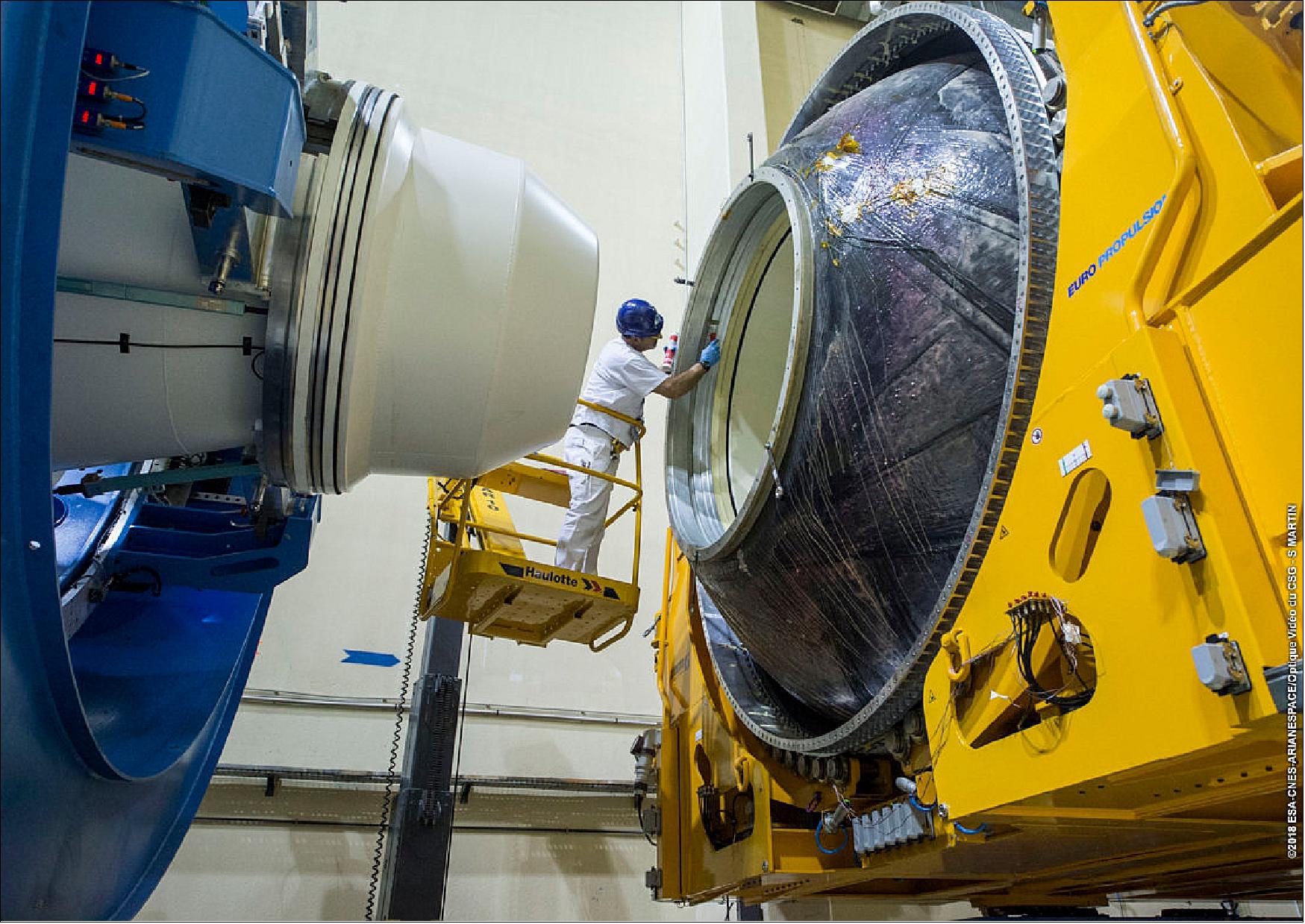
• June 14, 2018: The ESA Council met today in Paris to discuss the path towards the future exploitation of Ariane 6. In view of the progress made in the Ariane 6 program, Participating States have decided on the completion of the development up to full operational capability and agreed to fund industrial incentives associated with the development of Ariane 6 and P120C solid rocket motor. 63)
- Participating States also committed to start with the first step of the Ariane 6 and P120C Transition Program. This program supports the evolution from Europe’s Ariane 5 to full operational capability of Ariane 6.
- Ariane 6 is Europe’s new-generation launcher, designed to secure guaranteed access to space for Europe at an affordable price for European institutional users. It will operate in two configurations: Ariane 62 is fitted with two P120C strap-on boosters while Ariane 64 has four. Ariane 6’s maiden flight is planned for mid-2020.
- P120C is the largest carbon-fiber solid propellant booster ever built in one segment at almost 13.5 m long and about 3.4 m in diameter. Two boosters will be used on Ariane 6’s maiden flight in 2020.
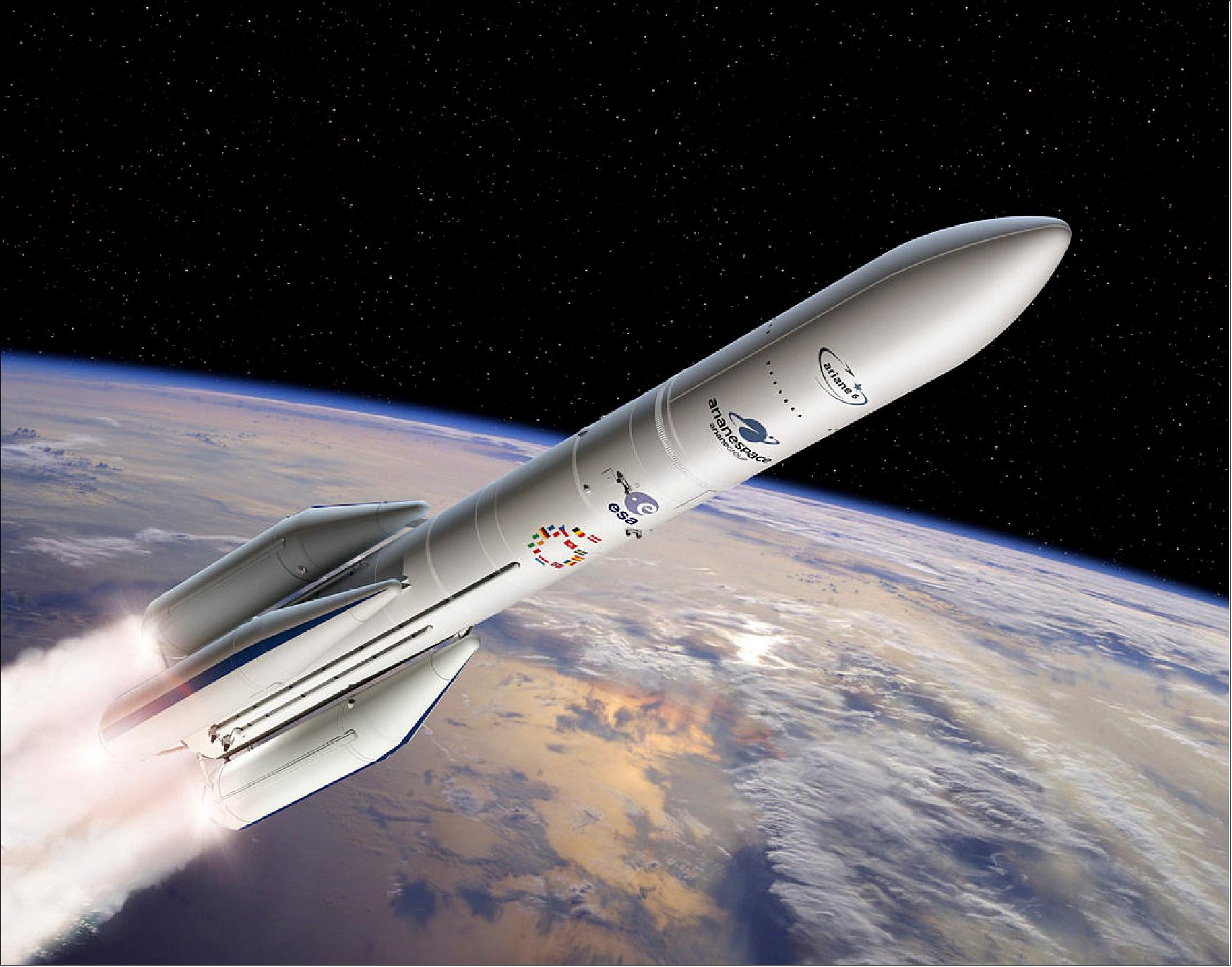
• February 15, 2018: The re-ignitable Vinci®, engine, which will power the upper stage of the Ariane 6 launcher, has now successfully completed its last two subsystems qualification campaigns (M6 and M7) with 140 engine tests conducted. The tests in campaigns M6 and M7, vital for qualification of the engine subsystems, were carried out on the PF52 bench at the ArianeGroup site in Vernon, France, and on the German Aerospace Center DLR's P4.1 bench in Lampoldshausen, Germany. 64)
- A total of 25 tests (16 for M6 and 9 for M7) were carried out under nominal conditions, and include three major performance "firsts":
a) a test of 1,569 seconds – an unprecedented duration,
b) a series of 20 successful boosts (1 ignition followed by 19 engine re-ignitions), totaling an operating duration of 300 seconds,
c) a continuous burn of 800 seconds in "high operation", i.e. at the maximum thrust for which the engine is designed.
- The purpose of these tests was also to test the Vinci® engine beyond its operational requirements, as it will only require ignition a maximum of 4 times during its missions, with a maximum burn time of 900 seconds in flight.
- Valérie de Korver, Product Manager Vinci® Propulsion System at ArianeGroup, said: "These campaigns went very smoothly and we demonstrated considerable margins with respect to the flight requirements, in particular thanks to a new ignition system and we successfully achieved a number of firsts, such as performing 20 boosts in a single test. This is a major step in demonstrating the ability of the Vinci engine to meet the versatility demands of the Ariane 6 launcher. It is also a new and major milestone for the program and for the teams, who are well aware of the challenges faced in these campaigns and who are always intensely committed to ensuring their success."
- The Vinci® engine was developed by ArianeGroup for Ariane 6 and provides the future European launcher with extreme versatility. Its main feature is its multiple ignition capability: Vinci® will be able to re-ignite in flight as many times as necessary, in order to place several payloads in orbit at different locations, according to the specific needs of the mission. This engine will enable Ariane 6 to carry out all types of missions, regardless of duration and target orbit, particularly the deployment of satellite constellations, for which demand will continue to grow.
- Design authority and industrial lead contractor for the development and operation of the Ariane 6 launcher on behalf of the European Space Agency (ESA), ArianeGroup coordinates an industrial network of more than 600 companies in 13 European countries, including more than 350 SMEs (Small and Medium Enterprises).
• February 2, 2018: Two models of the common solid rocket motor for Ariane 6 and Vega-C are being prepared and tested at Europe’s Spaceport in French Guiana. 65)
- The P120C full-scale model solid rocket motor for Ariane 6 and Vega-C, filled with 142 tons of inert propellant, is tilted from its vertical orientation to horizontal position for further integration with other structures.
- The P120C is the largest solid-propellant motor ever built in one segment, at almost 11.5 m long and about 3.4 m in diameter. Two or four will be strapped to Ariane 6 as boosters for liftoff.
- Vega-C is expected to debut in mid-2019 with P120C as the first-stage motor, which will increase performance from Vega’s current 1.5 t to about 2.2 t in a reference 700 km polar orbit.
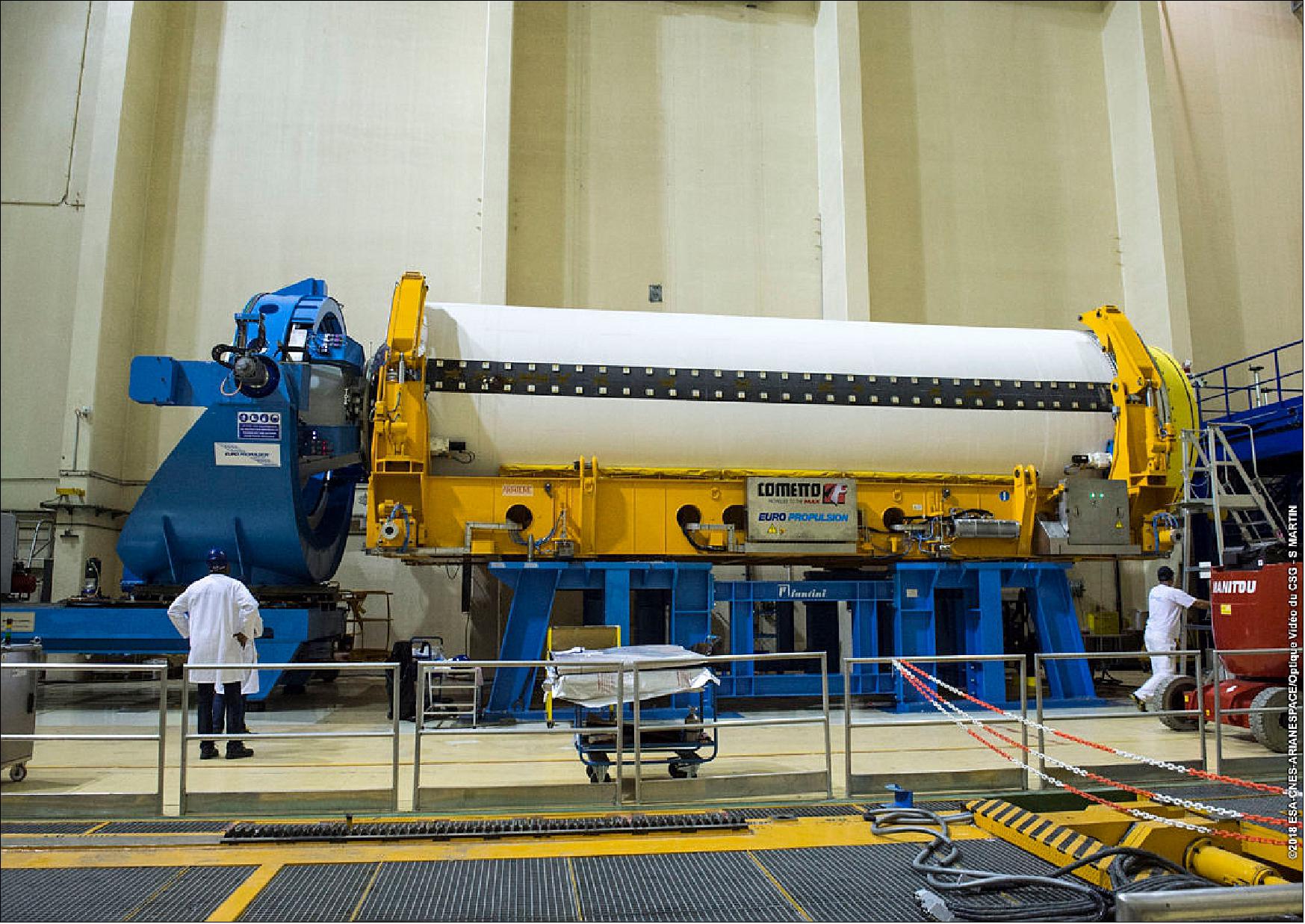
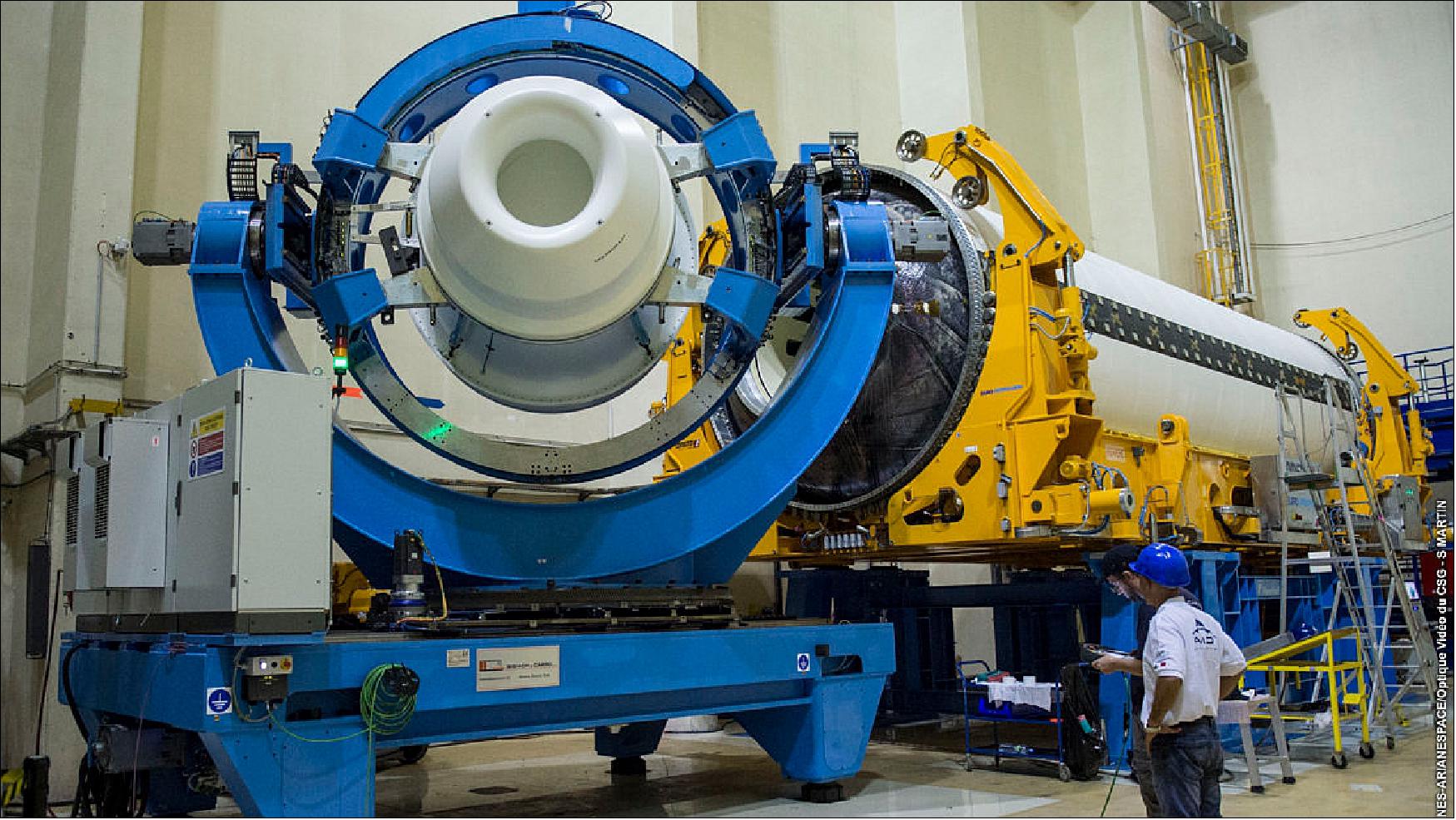
• January 23, 2018: The first hot firing of Ariane 6’s Vulcain 2.1 main engine has been performed at the DLR (German Aerospace Center) test facility in Lampoldshausen, Germany. — Further tests will examine the ignition conditions, and the behavior and performance of the engine and its different subsystems. 66)
- The engine, developed by ArianeGroup, has a simplified and more robust nozzle, a gas generator made through additive manufacturing, and an oxygen heater for oxygen tank pressurization. These features lower the cost of the engine and simplify manufacturing.
- During this year, three Vulcain test campaigns in Germany and France will help engineers to decide whether adjustments are needed to optimize the functional, thermal and mechanical behavior, before the start of combined tests.
- In parallel, more than 130 test firings on the Vinci engine powering Ariane 6’s upper stage have been carried out. These tests, in particular, have verified Vinci’s multiple ignition capabilities. Tests have used the P41 stand at DLR in Lampoldshausen and the PF52 stand at the ArianeGroup site in Vernon, France.
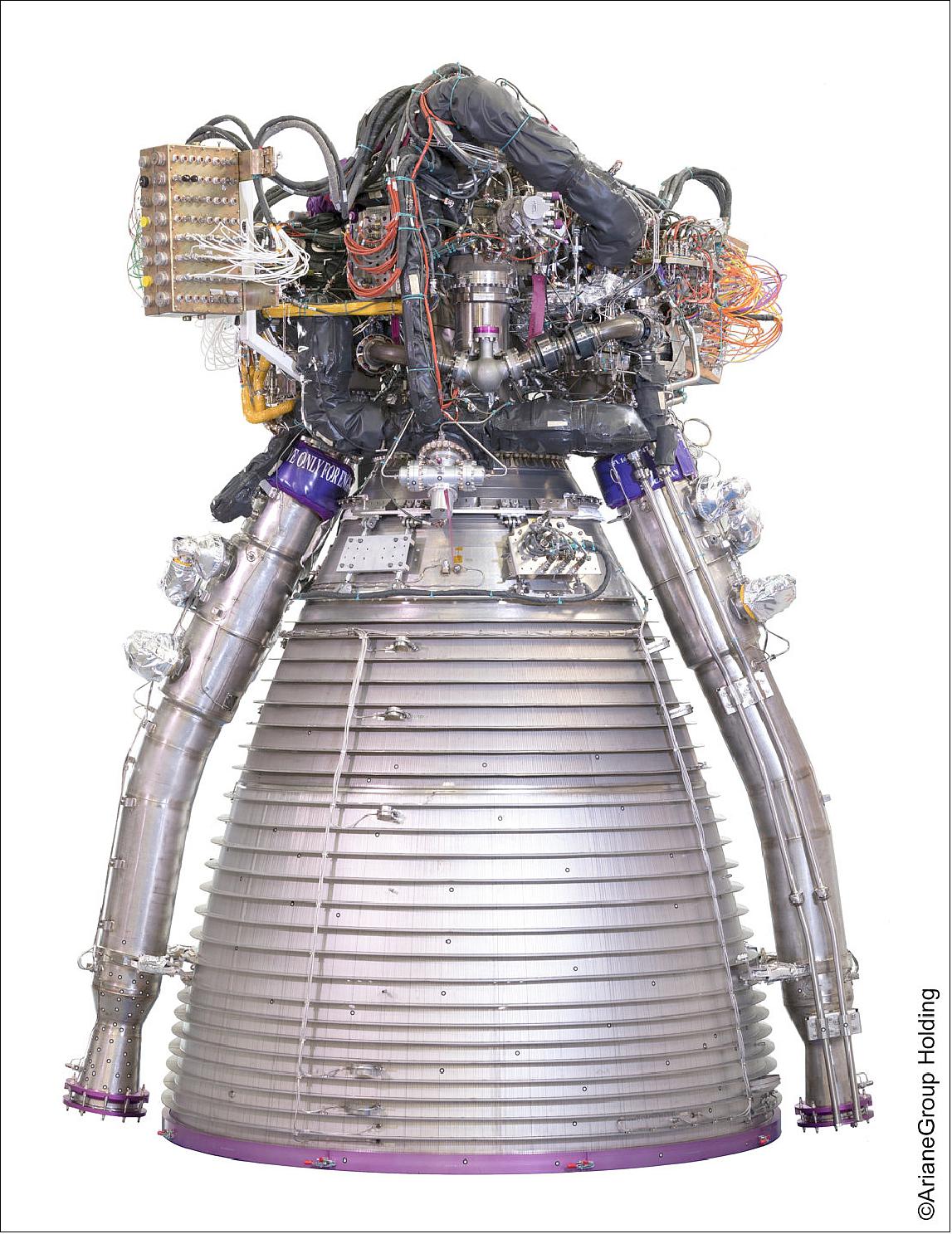
• January 8, 2018: Watch Ariane 6's Vulcain main engine roar into action in its first test firing at DLR German Aerospace Center test facility in Lampoldshausen, Germany. 67)
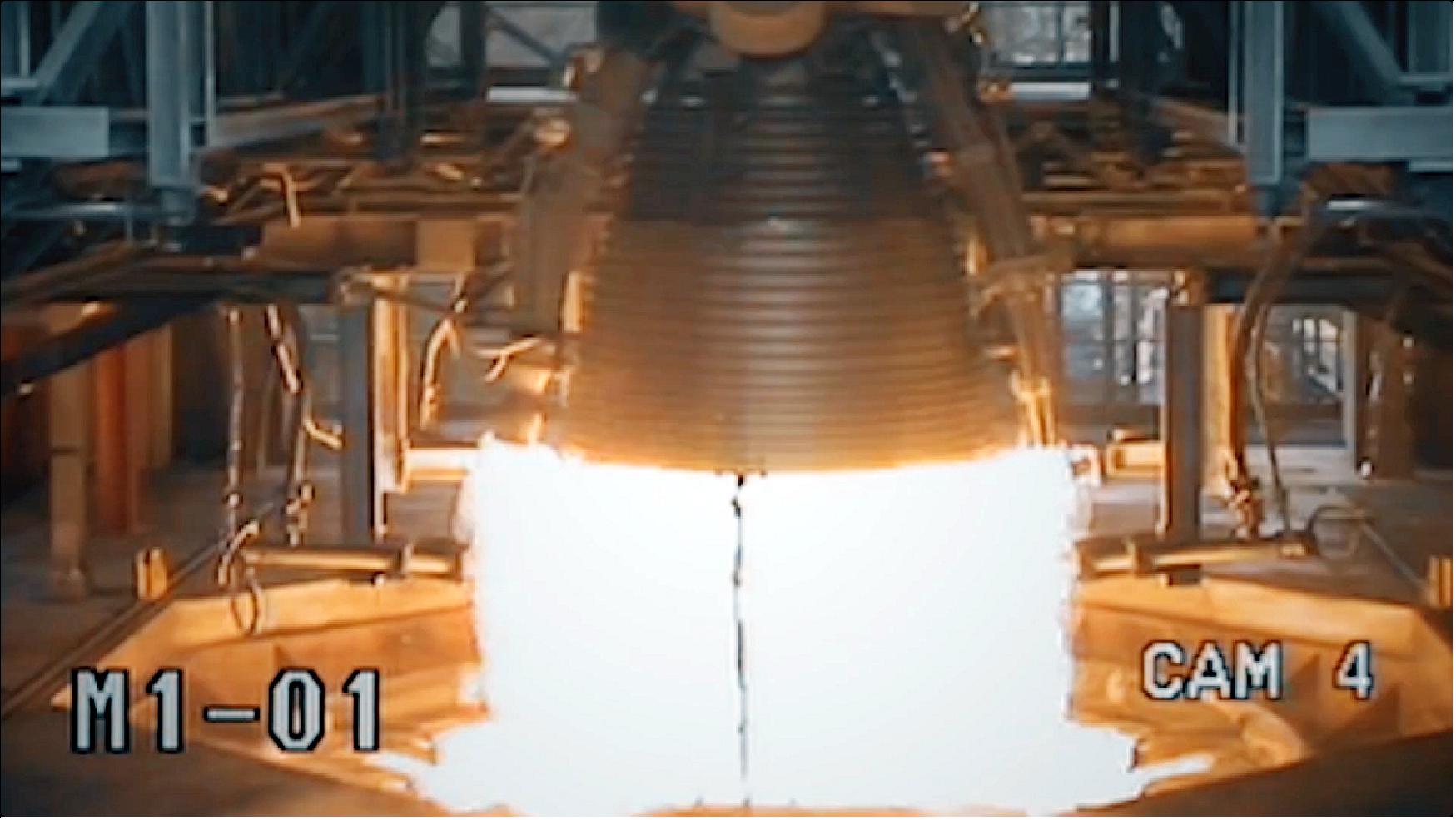
• December 15, 2017: The race is on to build the new launch pad for the Ariane 6 rocket, due to make its maiden voyage in July 2020. Construction is in full swing in French Guiana as Europe builds not only a new rocket but also a new way of launching rockets, in a bid to face down competition from the likes of SpaceX. 68)
- When Euronews visited, around 500 people were active on the site from six in the morning until ten at night, with attention focused on two key elements of the pad - firstly the huge flame trench which will take the hot gases away from the rocket on launch, and the new building in which the Ariane 6 will be built.
• September 14, 2017: Arianespace will launch four new satellites for the Galileo constellation, using two Ariane 62 versions of the next-generation Ariane 6 rocket from the Guiana Space Center in French Guiana. 69)
- Stéphane Israël, Arianespace Chief Executive Officer, and Paul Verhoef, Director of Navigation at the European Space Agency (ESA), signed the launch contract for four new satellites to join the European satellite navigation system Galileo. The contract will be conducted by ESA on behalf of the European Commission (DG Growth).
- These launches are planned between the end of 2020 and mid-2021, using two Ariane 62 launchers – the configuration of Europe’s new-generation launch vehicle that is best suited for the targeted orbit. The contract also provides for the possibility of using the Soyuz launch vehicle from the Guiana Space Center, if needed.
- Both missions will carry a pair of Galileo spacecraft to continue the constellation deployment for Europe’s satellite-based navigation system. The satellites, each weighing approximately 750 kg., will be placed in medium earth orbit (MEO) at an altitude of 23,222 km and be part of the Galileo satellite navigation constellation.
• At the end of 2016, ASL became the majority shareholder of Arianespace and changed its name to ArianeGroup on the 1st of July 2017. 70) ArianeGroup & Arianespace now gathers all the competences for designing, procuring, integrating, operating and commercializing launchers.
• November 9, 2016: After a program review completed in September, ESA is now in a position to proceed with the full development of its Ariane 6 and Vega C launch vehicles. Today, the riders to the contracts awarded in August 2015 were signed at ESA headquarters in Paris, France. This confirms the timely continuation of the preparation of Europe’s Ariane 6 and its launch complex. 71)
- ASL (Airbus Safran Launchers) is prime contractor and design authority for Ariane 6, with France’s CNES space agency as prime contractor for the launch pad and associated facilities at Europe’s Spaceport in Kourou, French Guiana.
- The set-up with ASL is an important change of governance in the European launcher sector. Industry is the design authority and taking full responsibility for developing and exploiting the vehicles, committing to deliver them to ESA and the European institutional customers at specified competitive prices.
- “Ariane 6 is on track for its 2020 maiden flight, achieving full operational capability in 2023,” said Daniel Neuenschwander, ESA’s Director of Launchers. “The timely availability of Ariane 6 is bound to have a significant impact on the increasingly competitive worldwide launcher market.”
• September 2016: Given the short development time for Ariane 6 (decision to start development in dec-2014 for a maiden flight in 2020), it has been decided to follow a concurrent engineering approach between ESA acting as Launch System Architect and the two prime contractors (ASL and CNES) in the elaboration of the Operational Concept. 72)
• August 12 ,2015: Today, ESA signed contracts for the development of the Ariane 6 new-generation launcher, its launch base and the Vega C evolution of the current small launcher. 73)
- The contracts, signed at ESA’s Paris Head Office with ASL (Airbus Safran Launchers), France’s CNES space agency and ELV(European Launch Vehicle) of Italy, respectively, cover all development work on Ariane 6 and its launch base for a maiden flight in 2020, and on Vega C for its 2018 debut.
- “These contracts will allow the development of a family of European launchers, highly competitive in the world market and ensuring autonomous access to space at fully competitive prices for ESA’s Member States,” said Jan Woerner, Director General of ESA. “They are an important change of governance in the European launcher sector, with industry being the design authority and taking full responsibility in the development and exploitation of the launchers, and committing to deliver them to ESA and the European institutional actors at specified competitive prices.”
- ASL and ELV are working closely together on the P120C solid-propellant motor that will form Vega C’s first stage and Ariane’s strap-on boosters.
- Ariane’s modular approach will offer either two boosters (Ariane 62) or four boosters (Ariane 64), depending on the required performance.
- The site of the launch pad for Ariane 6 at Europe’s Spaceport in Kourou, French Guiana has been chosen, and prime contractor CNES is already excavating the site. The new complex will also include facilities for preparing the launcher.
- The three contracts follow the decision taken at the ESA Council meeting at Ministerial level held in Luxemburg in December 2014 to maintain Europe’s leadership in the fast-changing commercial launch service market while responding to the needs of European institutional missions.
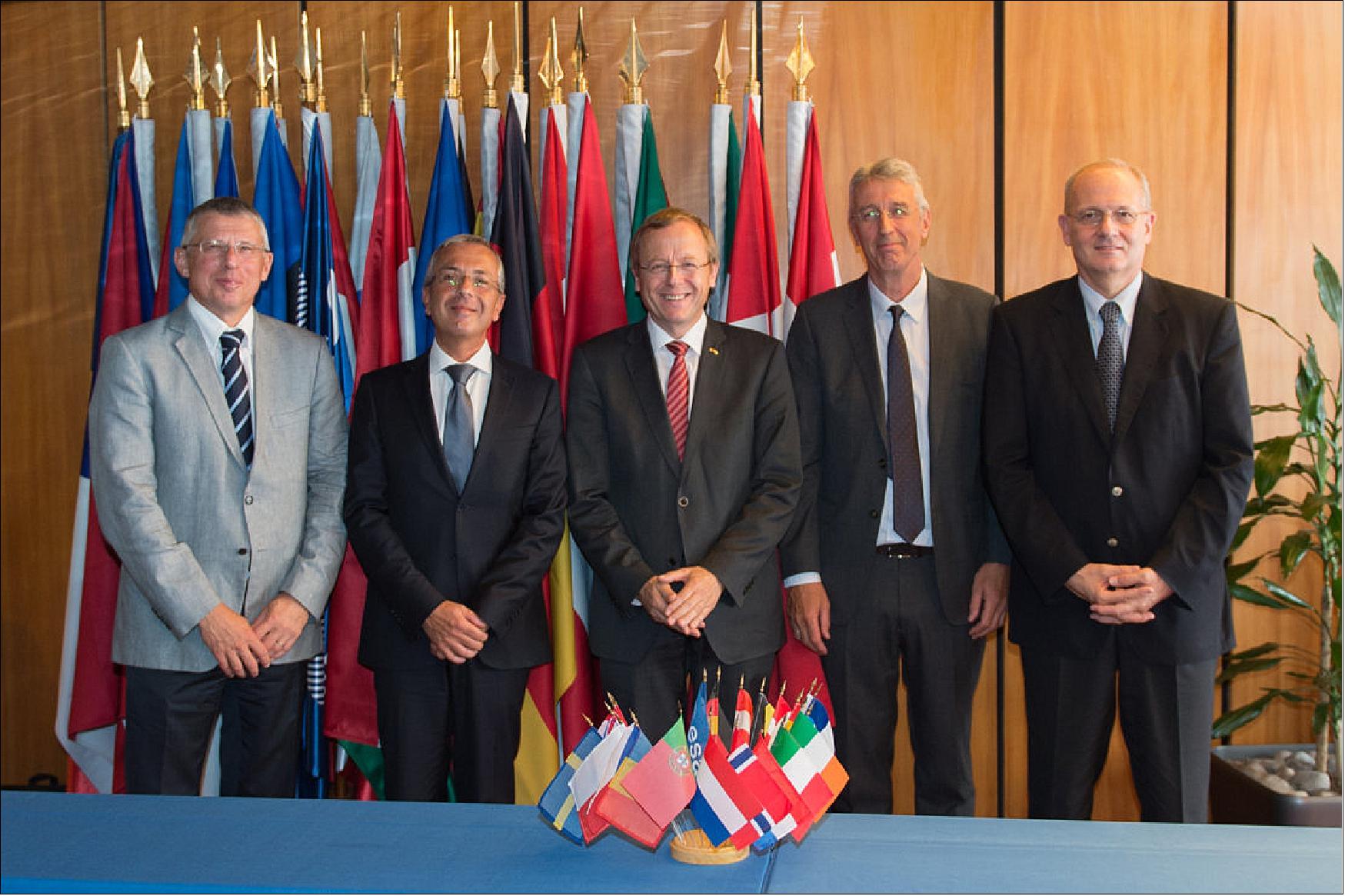
• On June 10, 2015, the French government reiterated its formal approval of the sale of state ownership in the Arianespace launch consortium to Airbus Safran Launchers, a joint venture set up to develop and produce Europe's next-generation Ariane 6 launch vehicle. 74)
- In a statement issued following a meeting with the French defense, research and industry ministers, Prime Minister Manuel Valls said Arianespace is destined “to be controlled by Airbus Safran Launchers via a transfer of Arianespace shares currently held by CNES,” the French space agency.
- “Negotiations on the terms of this industrial operation will continue on this basis while respecting the usual procedures,” Valls continued. “These discussions will be conducted in close collaboration with our European partners and other actors from the French and European space industry with the common objective of writing a new page in the history of Europe's space sector.”
- Formed late last year to initiate development of a next-generation successor to Europe's Ariane 5 – known as Ariane 6 – Airbus Safran Launchers currently holds a 41% stake in Arianespace, while CNES holds a little more than 34%. The new joint venture has been pushing for a quick transfer of Arianespace equity to the Airbus Safran Launchers, and negotiations have been underway for several months as to the launch consortium's value.
• December 2, 2014: ESA today concluded a productive one-day Council meeting at ministerial level in Luxembourg. Ministers of ESA Member States agreed on the development of a family of new launchers, Ariane 6 and Vega C, and approved funding for the International Space Station and space exploration. - In addition, Ministers set a course for ESA to remain an independent intergovernmental space organization. 75)
Ministers adopted three Resolutions:
1) “Resolution on Europe’s access to space”, covering the development of Ariane 6 and Vega C.
2) “Resolution on Europe’s space exploration strategy”, covering ESA’s three destinations for exploration (LEO low-Earth orbit, Moon and Mars)
3) “Resolution on ESA evolution”, covering the vision for ESA until 2030.
Ariane 6 Concept
The configuration of Ariane 6 is a modular two-stage launcher with strap-on boosters in two different configurations (see Fig. 1); they allow covering a broad range of commercial and institutional applications. 76)
Ariane 62 with two strap-on solid-propellant boosters will be used primarily for single-passenger missions with medium-sized satellites.
Ariane 64 with four strap-on boosters with a payload lift performance set at 10.5 tons to GTO in dual launch is more dedicated to larger payloads.
Both configurations include a cryogenic main stage powered by an upgraded Vulcain 2 engine derived from Ariane 5 – and a cryogenic upper stage based on the new Vinci engine previously planned to fly on the midlife evolution of Ariane 5 A5ME.
The P120C strap-on motors are commonly developed for Ariane 6 and VEGA-C evolution of VEGA launcher. More details on the configuration and design of Ariane 6 are presented in Ref. 72).
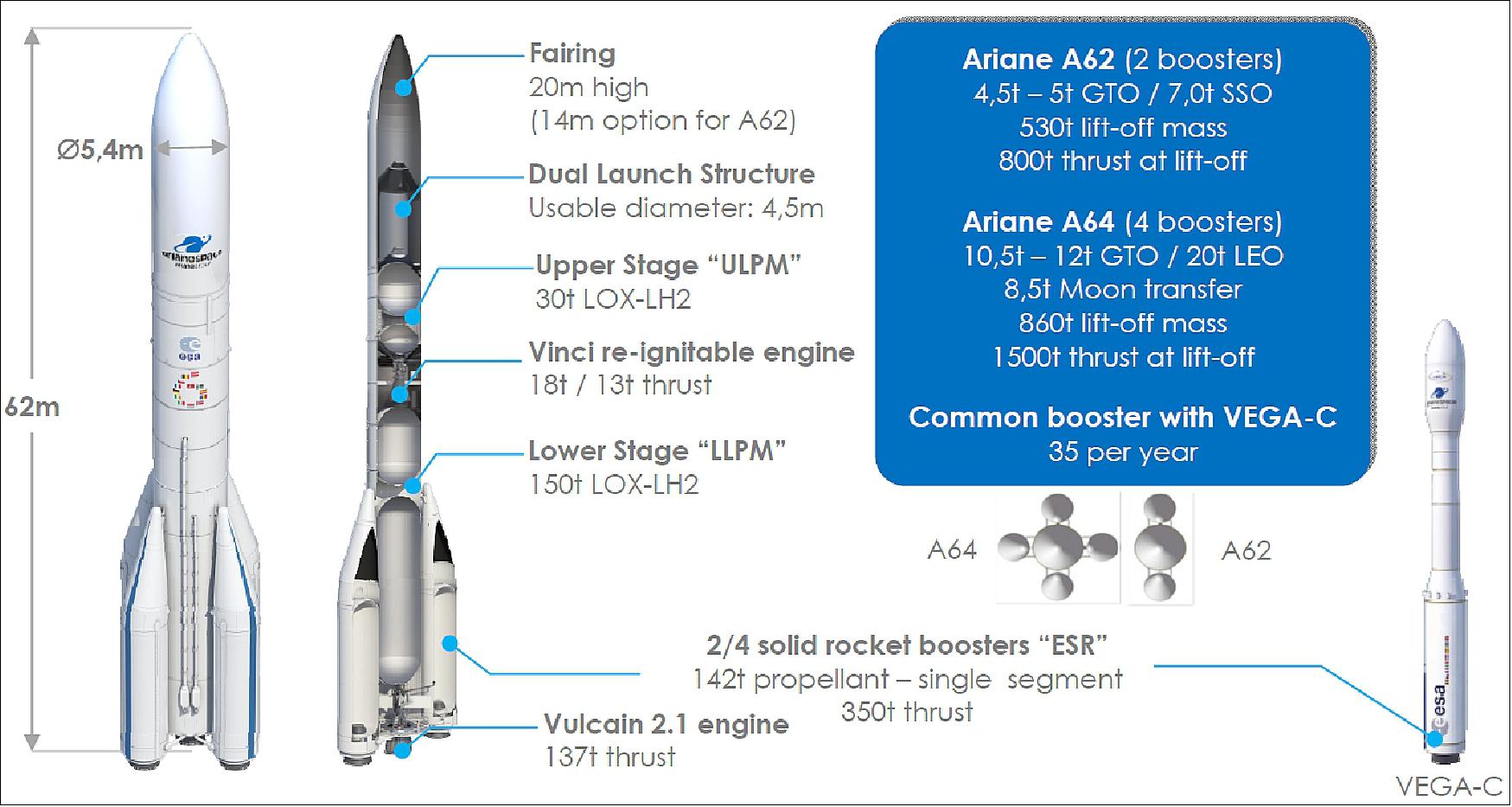
Industrialization Concept
ArianeGroup has engaged in a new way to develop launchers in Europe adapting the “Lean” management, development and manufacturing approaches to the launchers business. It stands on 4 pillars and a basis displayed in Figure 82.
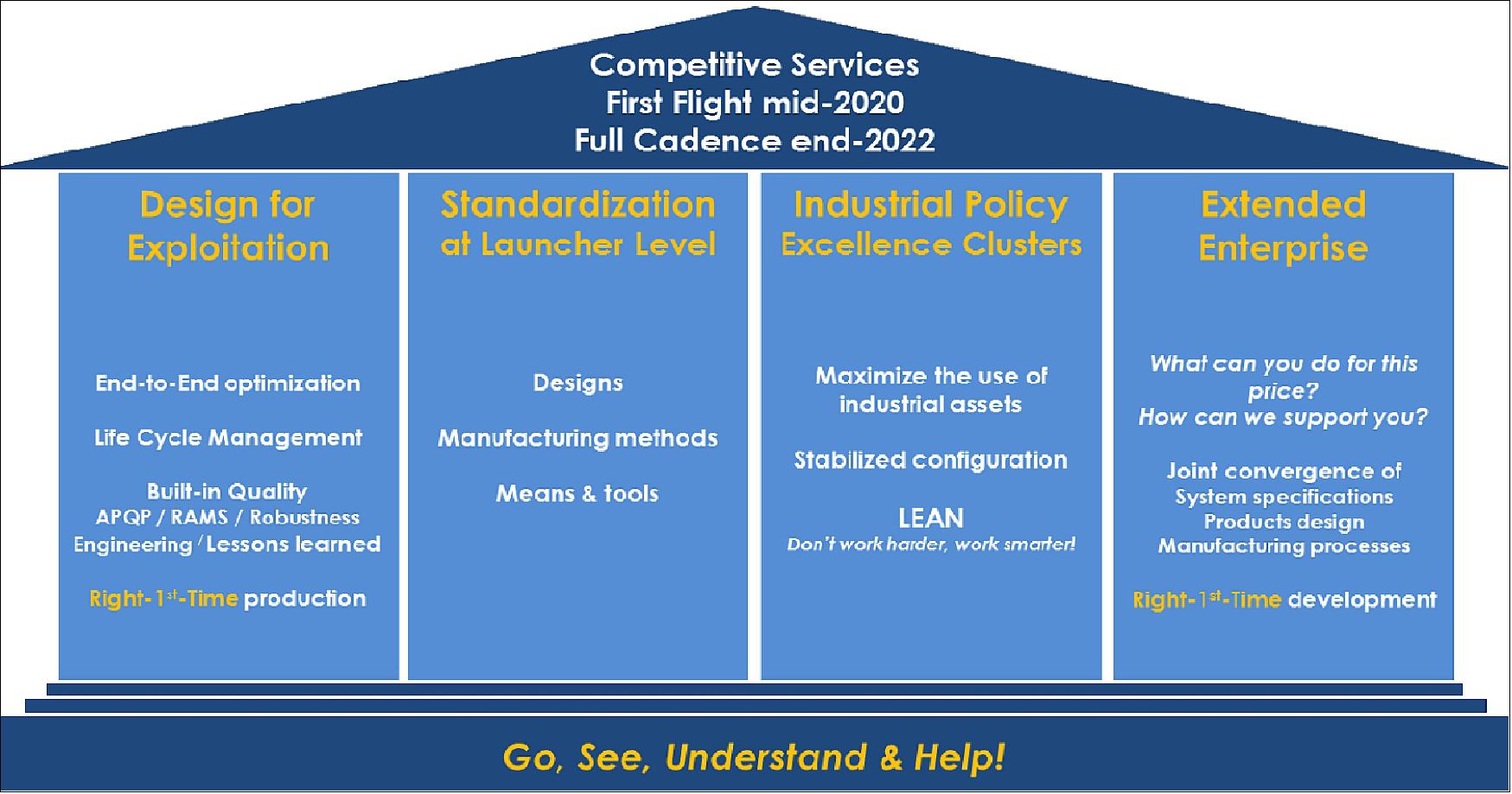
Excellence Clusters
Ariane 6 industrial policy was fostered by the European Launcher sector reform with new governance, new streamlined industrial set-up and one single contract at completion to ensure continuous development.
The Airbus-Safran Joint Venture creation and more recently the creation of ArianeGroup are major steps towards a new industrial set up since they:
• Create the conditions for Ariane 6 success: revamped industrial set-up required to bring Ariane 6 as quick, as performant and as affordable as possible to the market;
• Integrate launcher complementary competences: combine launcher system prime and integration expertise with critical capabilities in solid and liquid propulsion;
• Improve competitiveness of the future European launcher sector to adapt to stringent budget constraints, changing demand and enhanced competition;
• Build closer relations between Industry and Arianespace with the creation of ArianeGroup: industry will be exposed to market risks, to answer in an agile manner to customers demand and industrial operations in Kourou will be streamlined.
Another step is the reorganization of the launcher industrial scheme through the creation of clusters of excellence. Industrial breakdown is driven by the gathering of competences around dedicated industrial partners. This organization for the Ariane 6 project is presented in Table 3 and illustrated on Figure 83.
Launch System Architect | ESA |
Launch Base | CNES |
Launcher, LLPM/Vulcain, ULPM/ Vinci, ESR | ArianeGroup |
Solid Rocket Motor | Europropulsion-Regulus-ArianeGroup-Avio |
Cryotechnical Systems | Air Liquide |
Metallic Structures | MT Aerospace - Augsburg |
Thrust frames | Airbus Defence & Space, The Netherlands |
Composite aerostructures | Airbus Defence & Space, CASA, Spain |
Fairing | RUAG |
Mechanical ground equipment | APCO |
Avionics | Airbus Defence & Space Electronics/ CRISA |
Thrust Vector Controls | SABCA |
LLPM (Lower Liquid Propulsion Module)
ULPM (Upper Liquid Propulsion Module)
ESR (Equipped Solid SRM (Solid Rocket Motor))
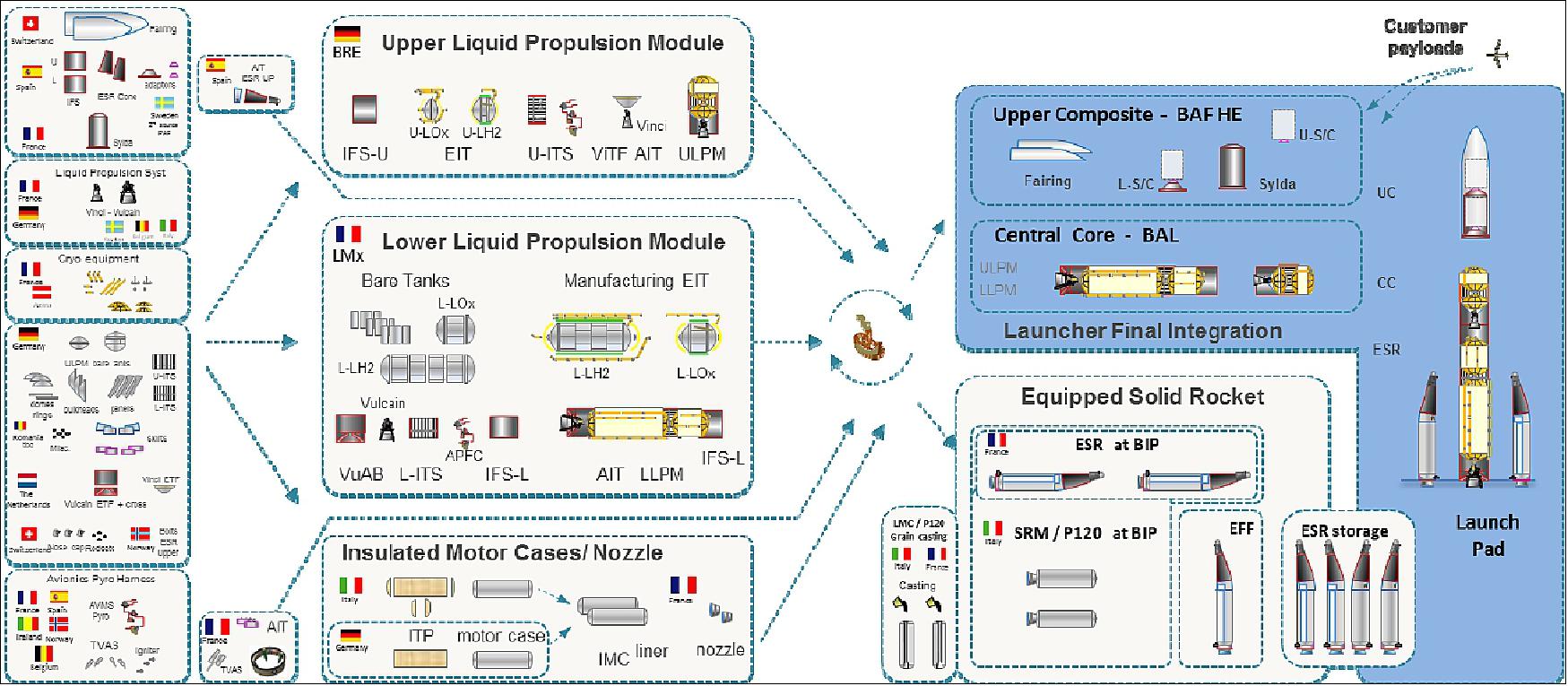
Industrial Assets
The design of Ariane 6 production system optimizes the use of industrial assets and limits the need for new ones. No new investment is decided without sound lean index, overall equipment effectiveness, added value surface ratio, etc.
The current Ariane 5 production system allows reusing existing facilities (buildings, test benches and tools), with limited adaptations - including supplier assets - for producing the 1st set of hardware before industrial implementation in existing buildings. The increases of launch rate will be achieved by increasing the effectiveness of the current Ariane 5 and Vega exploitation facilities. Among other, the main manufacturing, Assembly and Integration and Test facilities will be reused such as:
• BIP (Bâtiment Integration Propulseur),
• BEAP (Banc d’Essai des Etages d’Acceleration à Poudre),
• PF50 P5 (Vulcain Test Benches),
• P4.1 and PF52 P5.2. (Vinci Test Benches)
Facilities will be shared with Vega-C for the Solid Rocket Motor for a faster industrialization and learning curve.
Stabilized Configuration
This industrial setup will reach maximum efficiency if it manages to be disturbance-free. It thus needs to be designed to have a maximum stability of manufacturing and integration in the exploitation phase. This robustness is ensured by an alignment of product and process designs during development phase. It is performed in a concurrent engineering mode, with common freeze of specifications, product and process designs.
Standardized and stabilized manufacturing processes, & means and tools are also implemented to reach a “right first-time” production. This is also supported by the implementation of lean principles and continuous improvements methods at all levels as detailed in the next section.
Lean thinking is a mindset promoted in Ariane 6 design of products and processes driven by natural and simple principles:
• Fluidity: the aim is to reach continuous flow so emphasis is set on the identification and elimination of wastes & unnecessary actions.
• Small Steps: improvements do not need to be major breakthroughs all the time. The major change stands in continuous improvement.
• Evolution: it is important to keep the ability to evolve in order to allow agility at all levels.
• Common sense: the simplest ideas are often the easiest and most efficient. It is important to be inspired by what might have worked elsewhere.
Lean implementation relies on methods and tools. In order to learn to see the value versus the wastes, the main tool used is value stream mapping, which helps quantifying wastes: waiting (work in progress), setup, rework, machine breakdown…and which measures the lean index of a process (value added time vs. total lead time). Multi-function value stream mappings had already started on Ariane 5 processes at the workplaces and led to structured improvement plans.
The use of 5S is also generalized in order to standardize work and that operators concentrate on value-added operation. Operators are focused on “value”, empowered to improve and with a strong support from management. This results in work preparation, kitting & synchronized logistics.
These principles have been directly implemented in the design of the main integration facilities of Ariane 6 Liquid Propulsion Modules and Solid Rocket Motors.
The objective being to reduce lead time by 2 compared to Ariane 5, horizontal integration has been implemented in these facilities. Indeed, it allows having “flat”, simple and versatile buildings and more transparency and reactive support on the shop floor.
The discipline of flow: The lead time and production flow of Ariane 6 are major drivers for its future success in exploitation. Indeed, recent years have shown that the market requires agility and reactivity to address rapidly evolving customer needs. The lean principles described will not only provide local optimizations of the manufacturing and integration processes but are applied at a larger level to perform an end-to-end optimization of the production flow. It will allow managing the production system of Ariane 6 from raw material to launch in a seamless flow.
This optimization is made possible thanks to the integration of core competences at ArianeGroup level and the strong partnerships set with key industrial partners through the Extended Enterprise.
As a result, the production means of Ariane 6 will act as a single facility with a single flow. The Ariane 6 industrial policy is thus allowing a customer-pulled production where the flow is synchronized at customer takt-time. In order to solve the paradigm of reacting to market’s demand while keeping manufacturing at a pace as stable as possible, production needs will be determined and updated through a rolling forecast.
This industrial policy is a major evolution compared to the “production-pushed” approach and is key to the economic efficiency and overall agility of Ariane 6 launcher system.
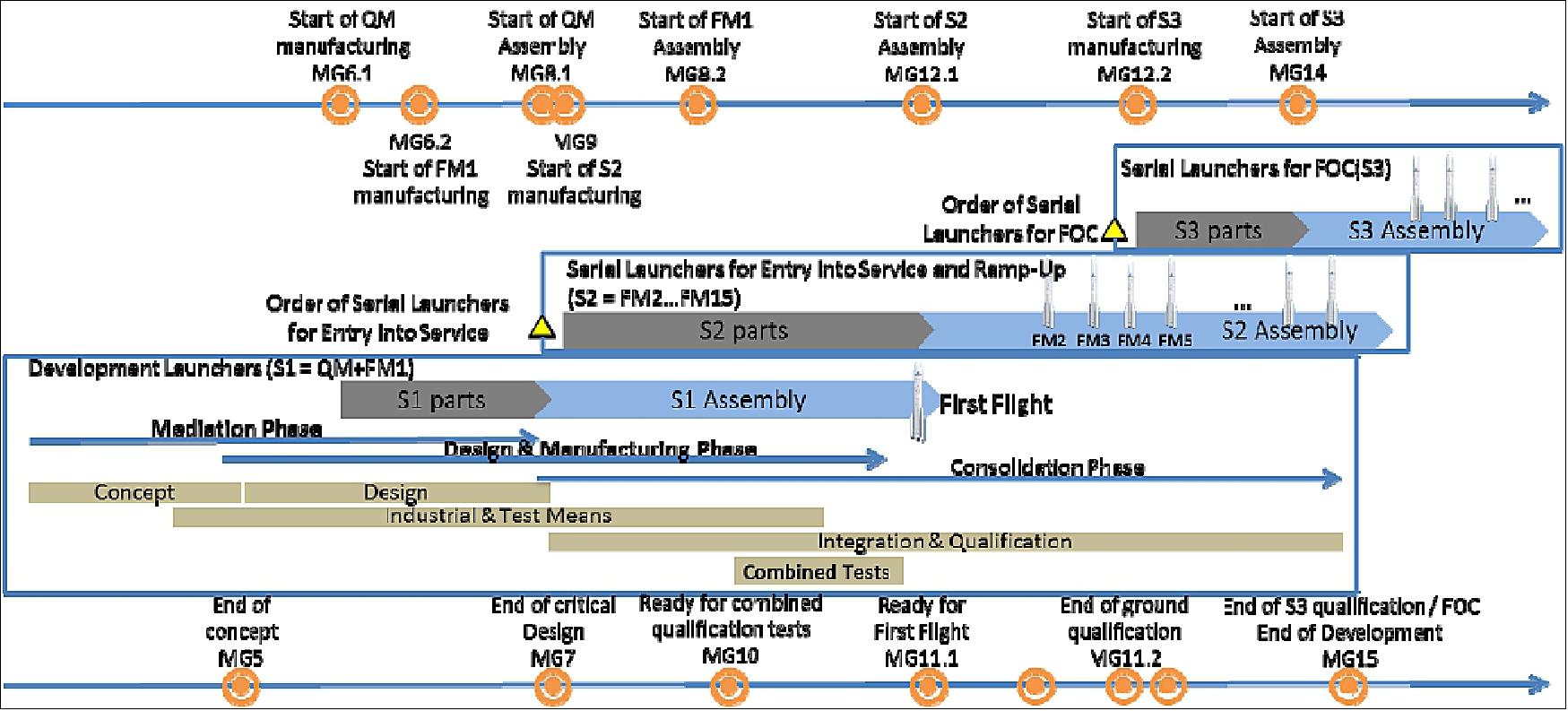
Program Status
In order to perform a first Ariane 6 launch in 2020 and reach a full-operation capability of 11 launches per year in 2023, the development logic applied on Ariane 6 does not follow the traditional V-cycle. Based on the lessons learned from Ariane 5 program but also from Airbus aircraft development experience, a “production-pull” logic is implemented. The main principle is that one single launcher definition demonstrates the compliance of both product and manufacturing/operational process with respect to its requirements in 3 incremental qualification steps. The correct progression over this logic is checked through a series of MG (Maturity Gates) assessing that the correct level of maturity is reached throughout the development (Figure 84).
Maturity Gate #6 (“start of S1 manufacturing”) is split in 2 parts:
• MG6.1 to authorize the start of QM (Qualification Models) manufacturing. The associated review was held in April 2017.
• MG6.2 to authorize the start of Flight Models (FM) manufacturing. It will be held in November / December 2017.
The MG6.1 review concentrated on the maturity of the joint convergence process for:
• Launcher specification, design qualification logic;
• Industrialization logic and supply chain management;
• End-to-End manufacturing, assembly, integration and tests processes and operations;
• Standard Operations Procedures and critical processes.
This maturity gate was passed successfully and allowed confirming that the industrialization policy is correctly implemented and on-track with respect to program’s schedule. The reviewers praised the fact that significant emphasis is put on industrialization in a development review.
Next MG6.2 review will mainly assess the correct progress over the roadmap presented at MG6.1. It will allow triggering the start of manufacturing of Ariane 6’s first flight model.
Vulcain 2.1 & Vinci engines
Vulcain 2.1 first engine assembly has been completed during summer 2017. It used the new P3M tool which supports the operators during assembly by positioning the engine in an optimal position at each integration step. This mean drives down the costs associated to operations by 40%. An illustration of the first Vulcain 2.1 engine on the P3M is provided in Figure 85. The first tests at P5 DLR facility in Lampoldshausen, Germany will take place end of 2017.
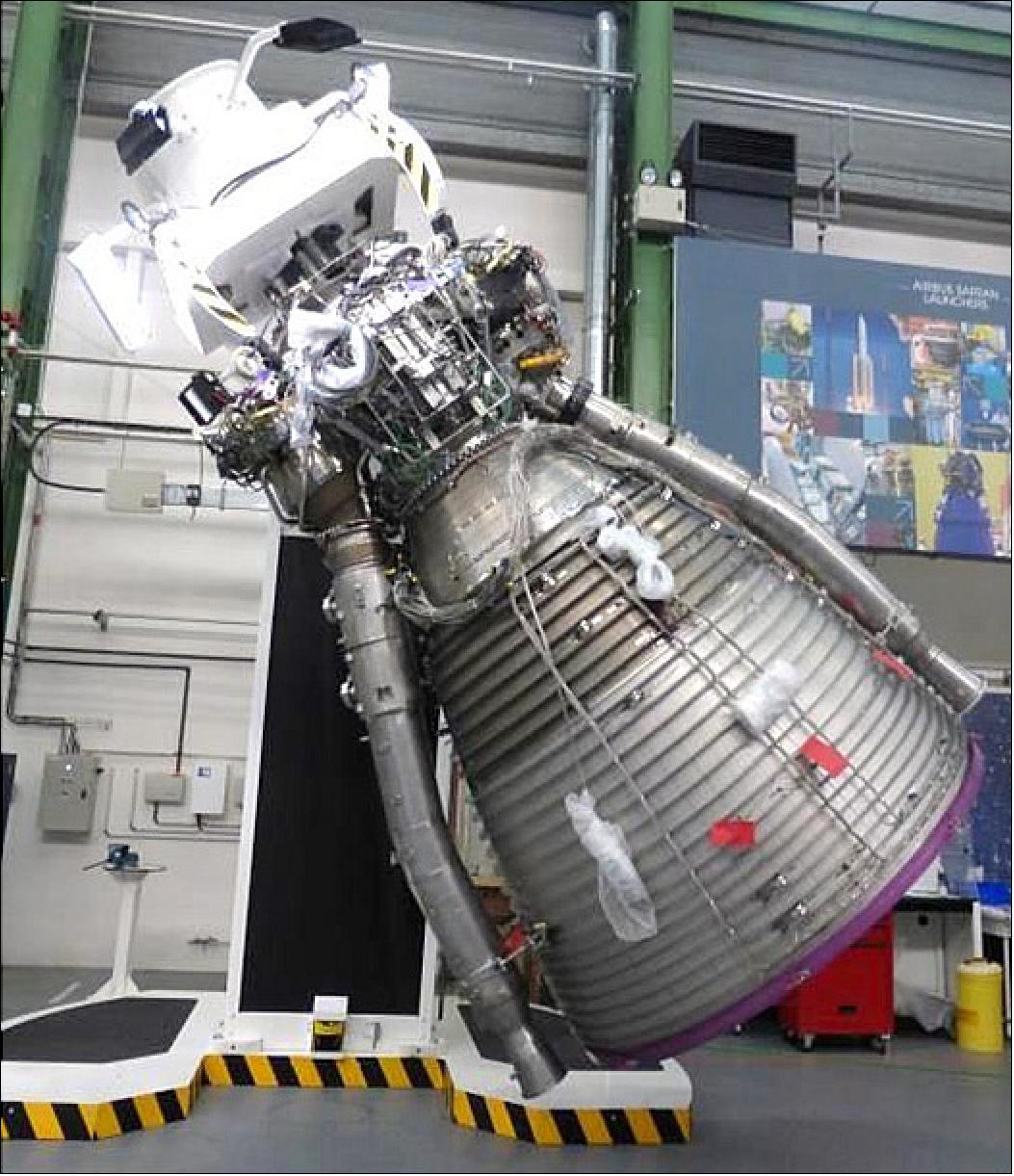
The Vinci re-ignitable engine qualification progresses as scheduled. The first flight qualification model has been delivered end of June 2017 and the dynamic qualification tests were performed at IABG. On the 22nd of September 2017, the 128th Vinci engine test was successfully performed at P4.1 test bench (DLR - Lampoldshausen) with a duration equal to the nominal functioning duration of the engine.
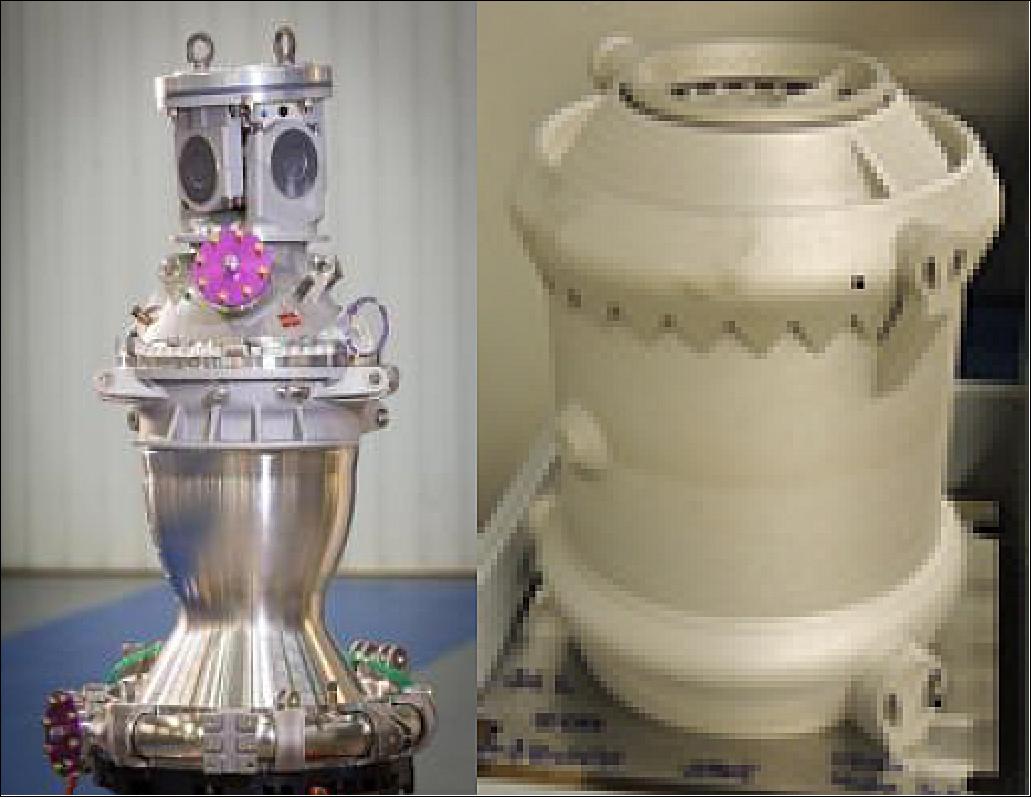
APU (Auxiliary Power Unit): Ariane 6 Upper stage features a gas generator able to pressurize LOX tanks during flight. This Auxiliary Power Unit is fully manufactured using Additive Layer Manufacturing. The first 3D-printed APU has been produced and tests have begun.
Solid Rocket Motor: The inert model of the P120C was delivered to Guiana: first filling tests have been performed. The nozzle components have been successfully fire-tested. The 1st firing test (DM model) is scheduled in April 2018 in Guiana.
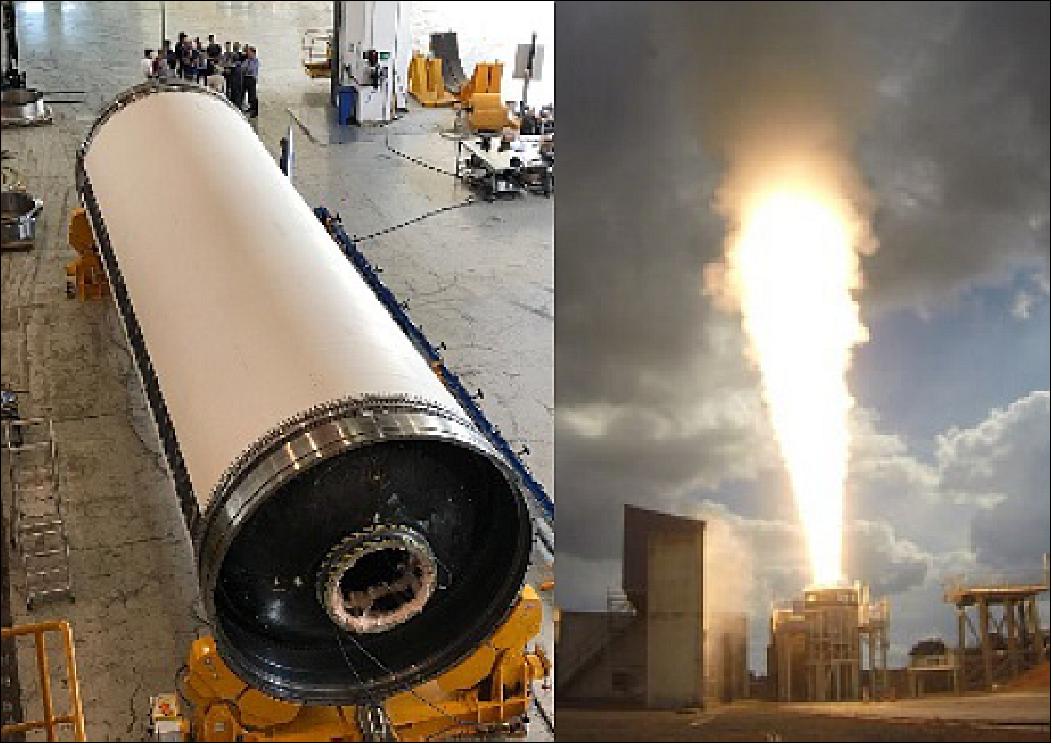
Facilities
In Europe, the facilities for the manufacturing and integration of Ariane 6 liquid propellant tanks have begun in Augsburg, Bremen & Les Mureaux. 3D-immersion rooms have been deployed on ArianeGroup’s site to start rehearsing integration operations and setting up & testing standard procedures without waiting for the facilities to be completed. The Functional Test Facility is also being installed in Les Mureaux to perform the avionics real-time, hardware in-the-loop tests.
In Guiana, the preparation of the Ariane 6 Launch Base by CNES has begun. The combined tests between the Launch Base and Ariane 6 Qualification model will start end of 2019. A new and common building is prepared for Regulus (Joint Venture between ArianeGroup & Avio) to manufacture P120 boosters for Ariane 6 and Vega-C launchers.
• April 26, 2018: CNES is in charge of the CSG (Guiana Space Center) ground segment. CNES has selected the Space Alliance, formed by Telespazio and Thales Alenia Space, to extend the fiber-optic communications system (STFO) at CSG. The extended system will be ready to meet the needs of Ariane 6 customers by the end of 2019. The STFO communications system acts as an interface between launch customers’ test benches and satellites throughout the different launch preparation phases at CSG, including spacecraft fueling, satellite encapsulation under the launch vehicle fairing and launch pad operations. In operation since the 1990s, this system will now be extended and upgraded to serve Ariane 6 customers. 77)
- The new system is specially designed to meet the needs of the very high throughput satellite (VHTS) market, as it extends radio-frequency (RF) services to 40 GHz and allows the simultaneous operation of two satellites in Ka-band. Telespazio France, as prime contractor, and Thales Alenia Space in Spain, as subcontractor, will bring to the project their complementary skills in system engineering, communications networks, software systems, RF and fiber-optics, as well as in the operation and maintenance of the current STFO system.
- Telespazio is already responsible for highly critical and demanding activities in the CSG, and this is the company's first opportunity to take an active role also in the installation of the new Ariane 6 launcher in French Guiana.
Launcher System: The next milestones for the Launcher System are the MG6.2 end of 2017 that will trigger the production of first Ariane 6 flight model and then MG7 mid-2018 that will focus on the critical design review of the launcher system.
Increased Versatility: Ariane 6 versatility has been increased by considering additional upper composite configurations thus offering a large array of solutions to customers (Figure 88). Ariane 6 now features an auxiliary payload system to embark payloads from 1kg to a few hundreds of kg as secondary passengers when performance allows.
For the constellation market, it has been established that Ariane 6 is a suitable solution:
• With its re-ignitable Vinci engine, Ariane 6 offers flexibility in the deployment of constellations by delivering part of the payloads on one orbit and the rest on another. Ariane 6 is in particular able to deliver payloads on two different orbital planes i.e. with different longitudes of the ascending node.
• It has been demonstrated that the capacities of the versatile Upper Stage allow separating several tens of payloads with a non-collision between them guaranteed overall several days.

ESA’s Future Launchers Preparatory Program
On 22 March 2018, the full-scale demonstrator of a thrust chamber for an upper-stage rocket motor, called ETID (Expander-cycle Technology Integrated Demonstrator), arrived at the DLR (German Aerospace Center) test facility in Lampoldshausen for functional tests. It incorporates the newest propulsion systems that will help prove new technologies, materials and manufacturing techniques that offer higher performance at lower cost for Europe’s future launchers. 78)
ETID is a precursor of the next generation of 10 ton rocket engines. Some of the technologies could also be used on upgrades to the existing Vinci, which powers the upper stage of Ariane 6.
The Prometheus precursor of a 100 ton class rocket engine intended for next-generation launch vehicles will also benefit from the knowledge gained during demonstration, for example on additively manufactured parts or low-cost combustion chamber materials.
Upper-stage engines operate in specific conditions such as vacuum and weightlessness that are difficult to reproduce on Earth, and involve significant development risks that have to be mitigated.
From April to the end of the year, ETID will be ignited up to 20 times with each firing lasting 120 s, in conditions similar to those in space with a near-vacuum provided by the test stand. Led by ArianeGroup in Germany, GKN Aerospace in Sweden, Aerospace Propulsion Products in the Netherlands, Safran Aero Boosters in Belgium and Carinthian Tech Research in Austria have all provided hardware for the tests.
At least two versions of each piece of hardware have been built, resulting in at least three different test configurations to be hot-fired, proving different technologies and methods of manufacture such as additive manufacturing, laser ignition and cost-efficient materials. In addition, components will be tested to lay the foundations for a future ‘smart’ engine.
Through its Future Launchers Preparatory Program, ESA aims to increase the future competitiveness of European launchers by creating ready-made technical solutions, which can be transferred for quick development projects with minimal cost, effort and risk.
“New demonstrators and evolutions of existing engines integrate new technologies, industrial processes and global trends to meet the competitive long-term challenges of the European space transportation sector. Hot-firing tests on such demonstrators are the best way we have to test propulsion technologies in representative conditions,” commented Kate Underhill, lead engineer.
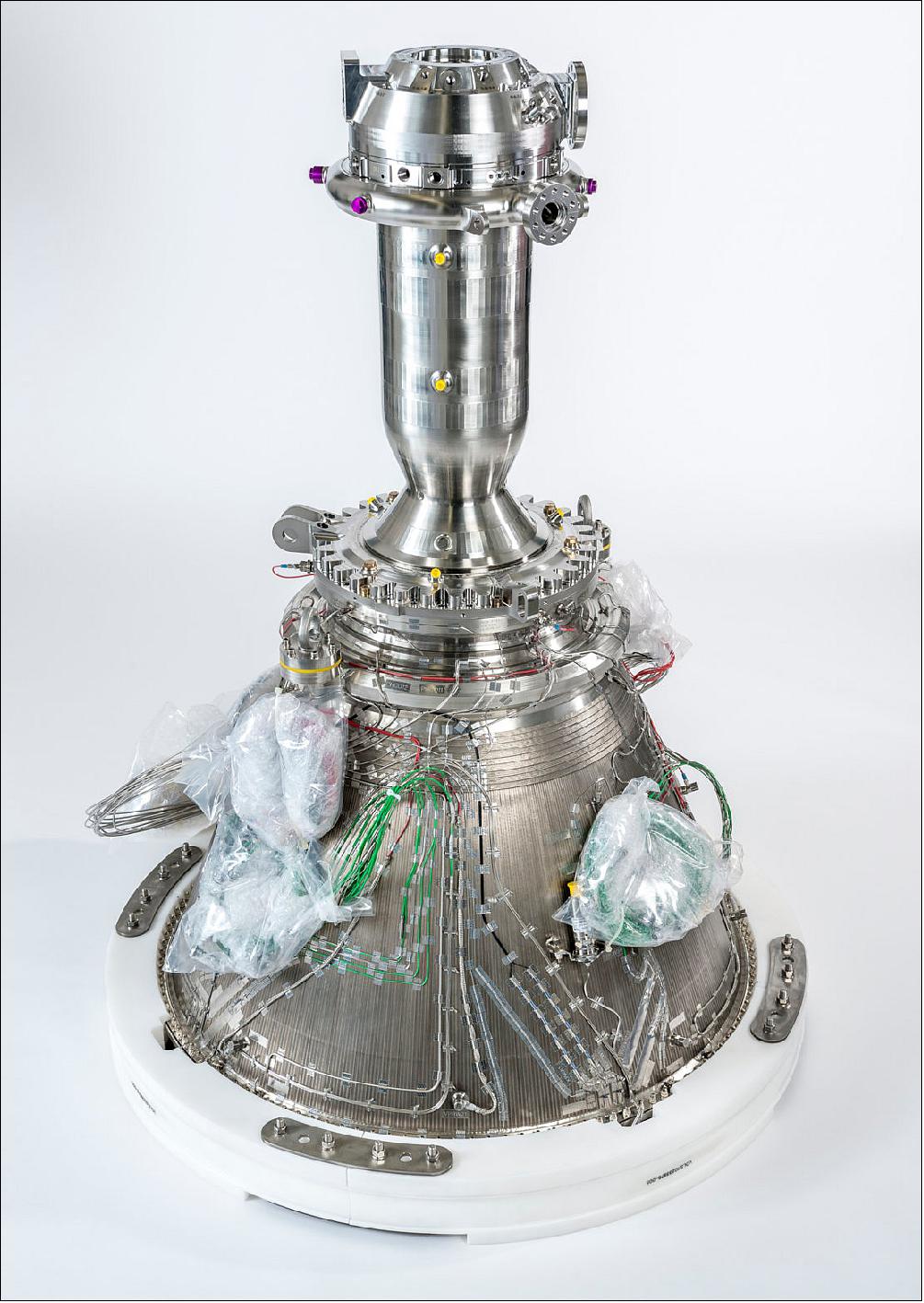
Status of Future Launchers Preparatory Program
• May 28, 2020: Based on hot-fire tests of an ETID (Expander-cycle Technology Integrated Demonstrator) that proved the technology and methods last year, ESA, ArianeGroup and DLR (German Aerospace Center) have built and hot-fire tested a fully additively-manufactured thrust chamber. The ETID is a full-scale integrated demonstrator for an upper-stage rocket engine. 79)
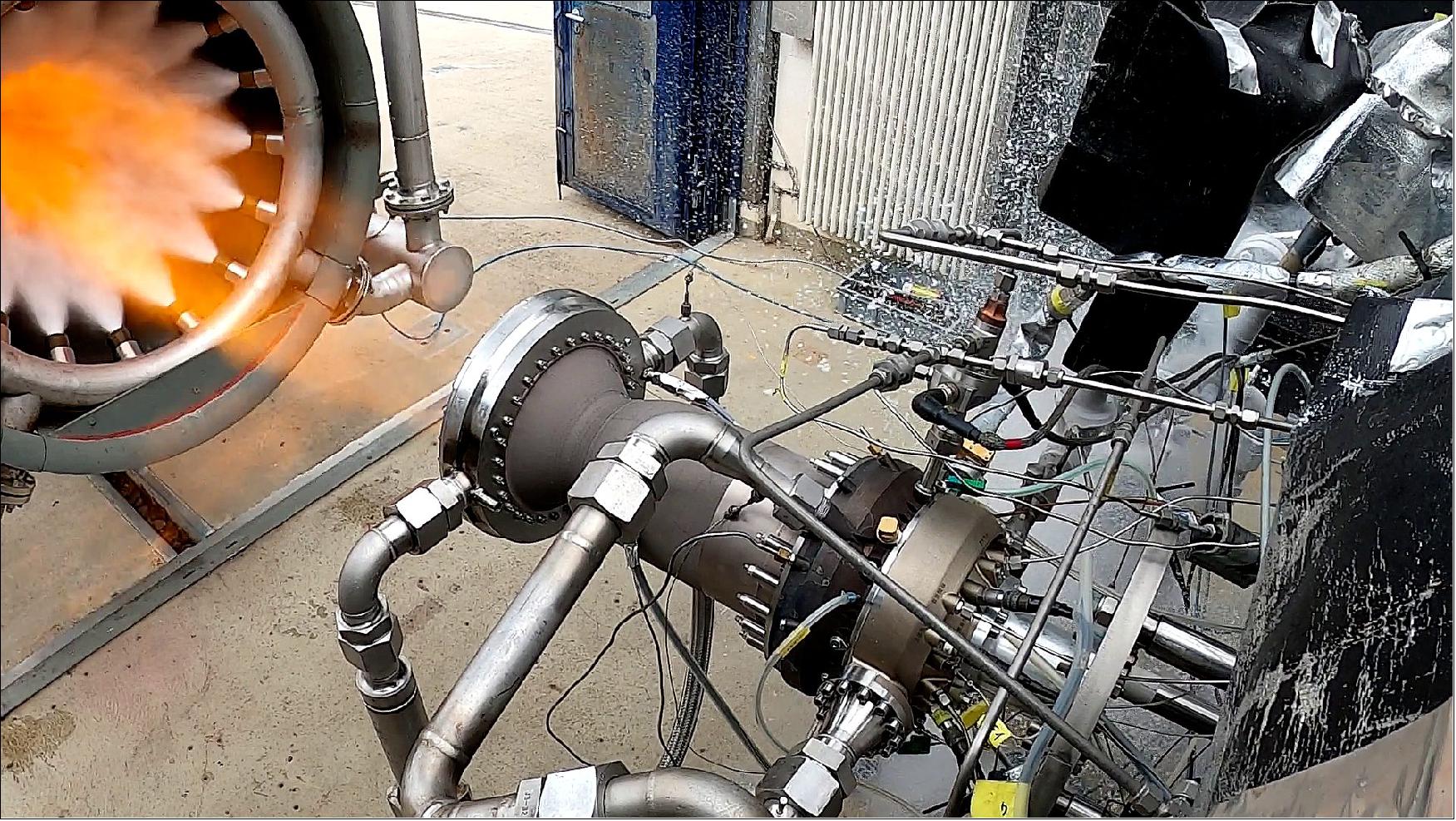
- This fully 3D-printed thrust chamber is built in just three parts and could power the upper stages of future rockets.
- Additive layer manufacturing also known as 3D-printing, allows more complex designs for higher performance, vastly reduces the number of parts in this case from hundreds to three, and speeds up production time. This reduces costs and significantly improves the competitiveness of liquid propulsion engines for European launch vehicles.
- This fullscale chamber has a 3D-printed copper liner with integrated cooling channels and a high-strength jacket built on via cold-gas spraying. Its manifold and single-piece injector head are also 3D-printed.
- The production and test of these parts has been performed within ESA's Future Launchers Preparatory Program.
• March 3, 2020: The 3D-printed thrust chamber assembly of the methane-fuelled M10 rocket engine has passed its first series of hot firing tests. The M10 engine will power the upper stage of future Vega evolutions from 2025. 80)
- “These test results are encouraging, confirming that our propulsion teams are right on track along the development path identified for such novel technology for Vega evolutions,” commented Giorgio Tumino, managing ESA’s Vega and Space Rider development programs.
- M10 will improve propulsion efficiency and environmental sustainability by reducing emissions and combustion waste thereby increasing the competitiveness of European small launchers and lowering their cost.
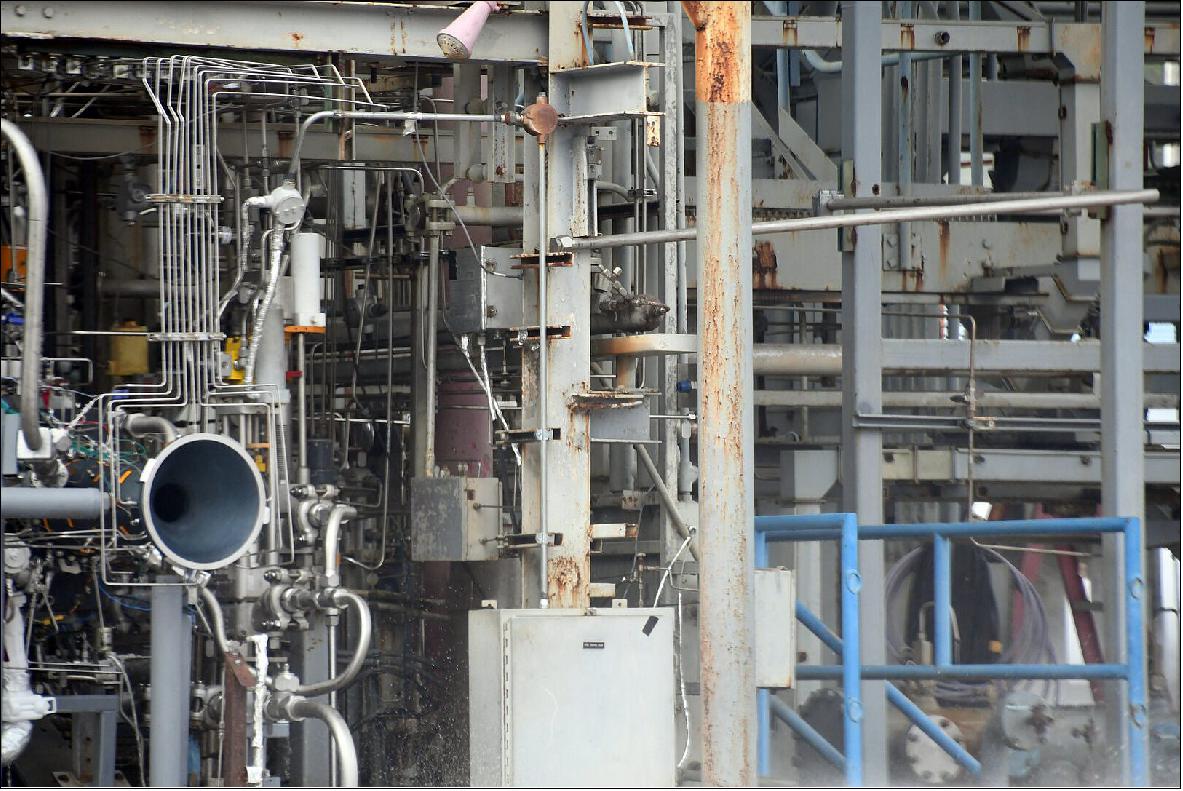
- The M10 is restartable and uses a system of smart pressure control. This improves fuel management and offers mission flexibility.
- Avio in Italy built this TCA in two parts via additive layer-by-layer manufacturing (ALM) using metal alloys, then welded the two parts together. ALM enables more complex internal geometries to be built in fewer parts with a reduced need for additional machining, which benefits cryogenic technology, speeds up production time and cuts costs.
- M10 is a 10 t-class liquid oxygen–methane expander cycle engine, intended to replace the second and third stages (Zefiro 9 solid-propellant motor and AVUM upper stage) of the current Vega configuration.
- ALM with metal alloys has become more reliable and of better quality but product inspection is challenging. Non-destructive inspection (NDI) such as tomography and ultrasound is used to detect defects, geometry distortions and potential obstructions within cooling channels.
- Subscale models demonstrated in 2018 that ALM produces thrust chambers that are comparable to those built in the traditional way and that NDI was successful in detecting defects during manufacturing. This opened the way for the development of the full-scale ALM thrust chamber.
- During this test campaign, the TCA was fired 19 times for a total of 450 seconds at the NASA Marshall Space Flight Center in the USA.
- By comparing this data with the results from previous models, engineers will better understand the engine behavior and performances in the up-scaled model. This will help to optimize the configuration of the first M10 development model.
- The hot firing of the first development model of the M10 engine will be carried out at the end of the year. Ground qualification is foreseen for 2024 followed by its use in future Vega launch vehicles by 2025.
- "These tests prove new technologies and methods that will keep Europe competitive in the launch services market into the future," added Stefano Bianchi, Head of the Space Transportation developments at ESA.
• June 24, 2019: ‘Flow forming’ shapes a metal in a single step and is being trialed to create rocket cylinders that are much cheaper and quicker to make. Launch vehicle structures must withstand large mechanical loads yet be as light as possible. 81)
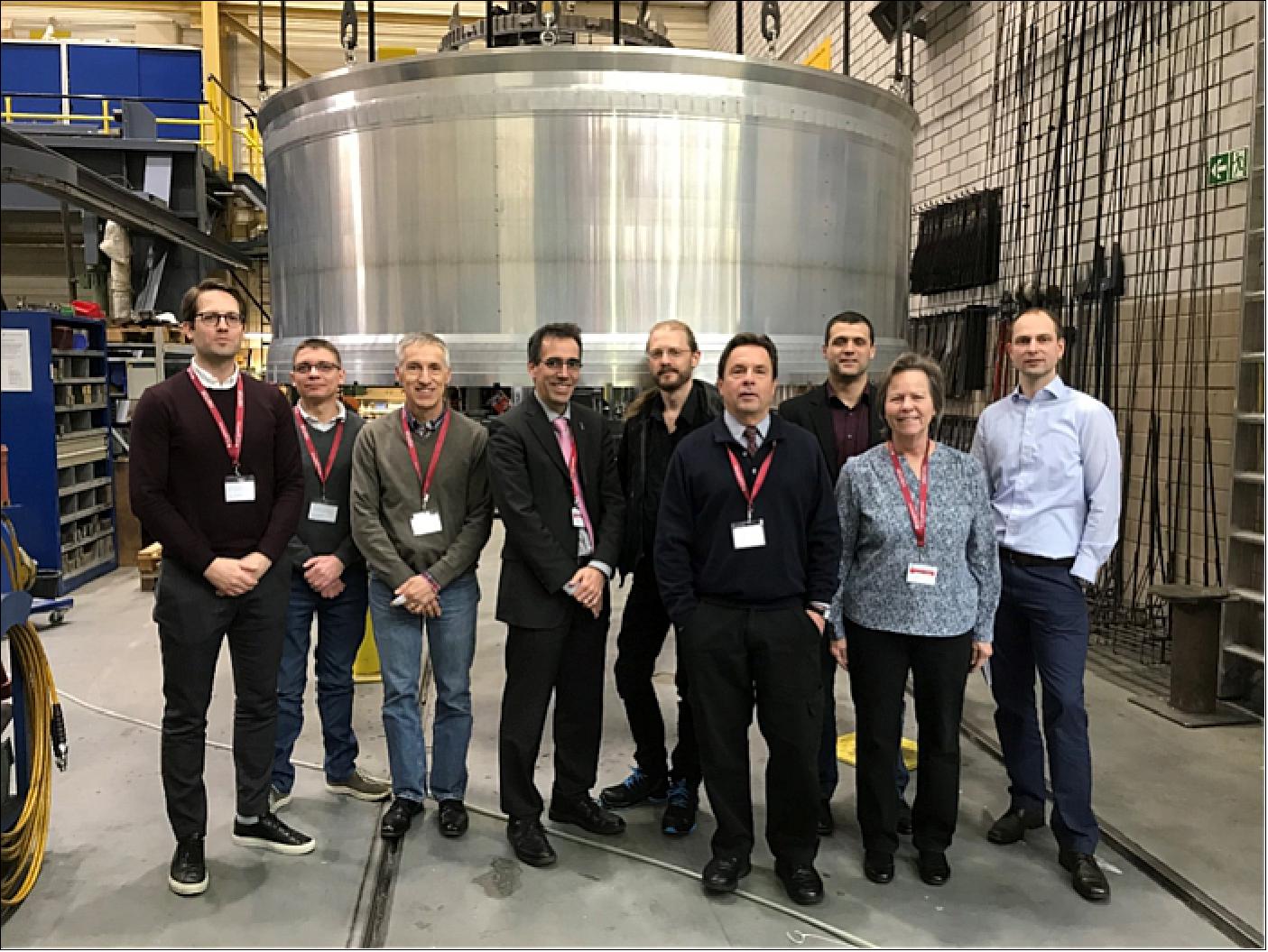
- “A plain cylinder is heavy but it can be made thinner if reinforced by ‘blades’ welded along the wall or directly machined. This requires multiple steps, many welds, expensive jigs and tools – it is costly, takes time and each step can introduce risks,” explained Jorgen Bru, ESA’s FLPP Technology Manager.
- “By contrast, flow forming removes the need for welding. A cylinder is placed over a mandrel with grooves. As external rollers push the metal along, making the tube both thinner and longer, the metal flows into the mandrel’s grooves to create a thin cylindrical skin reinforced with internal blades. As a result, we gain the performance of a stiffened cylinder at the cost of plain cylinder production.”
- The process is known as ISC (Integrally Stiffened Cylinder) flow forming. It was first demonstrated on a Black Brant sounding research rocket in 2015 at NASA’s Wallops Flight Facility on a suborbital mission lasting nine minutes. A 43 cm-diameter aluminum integrally stiffened tube formed part of the upper stage.
- Based on these promising results, collaboration between ESA and NASA led to a manufacturing test campaign at MT Aerospace in Augsburg, Germany that finished in April 2018. This proved that it was possible to manufacture much larger single-piece elements to 3 m diameter.
- In a more recent trial there, ten 3 m cylinders where formed during which engineers investigated the influence of multiple parameters on the forming results and stringer integrity, such as raw part conditioning, feed rate, revolution speed, roller configuration, and total reduction in wall thickness.
- Investigations and mechanical tests on the produced cylinders are ongoing; some have been shipped to NASA Langley for further testing and analyses.
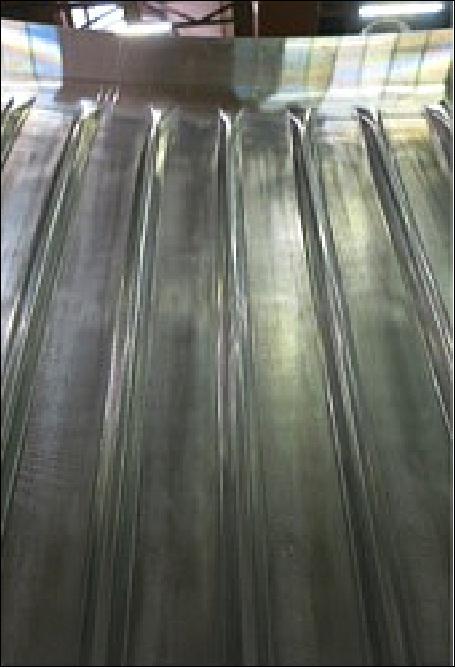
- “Results from the most recent trial at MT Aerospace showcased the ability of flow forming to create near net 3-m diameter cryogenic tank barrel sections of high quality,” commented John Wagner, Engineer in the Advanced Materials and Processing Branch at NASA Langley Research Center. “In the future, we hope to conduct a structural buckling test to demonstrate the benefits of this process compared to integrally machining the barrel sections.”
- Next year, integrally stiffened cylinders will be incorporated in an integrated cryogenic tank demonstrator SCOUT, or Sandwich Common Bulkhead Optimized Upper Stage Tank. Other applications would be non-pressurized elements such as dry bay structures.
• June 19, 2019: One major advantage of 3D printing – otherwise known as additive manufacturing – is that material only needs to be placed where it is required. Embracing the design freedom this opens up can lead to the creation of parts with notably organic appearances compared to their traditionally manufactured counterparts. 82)
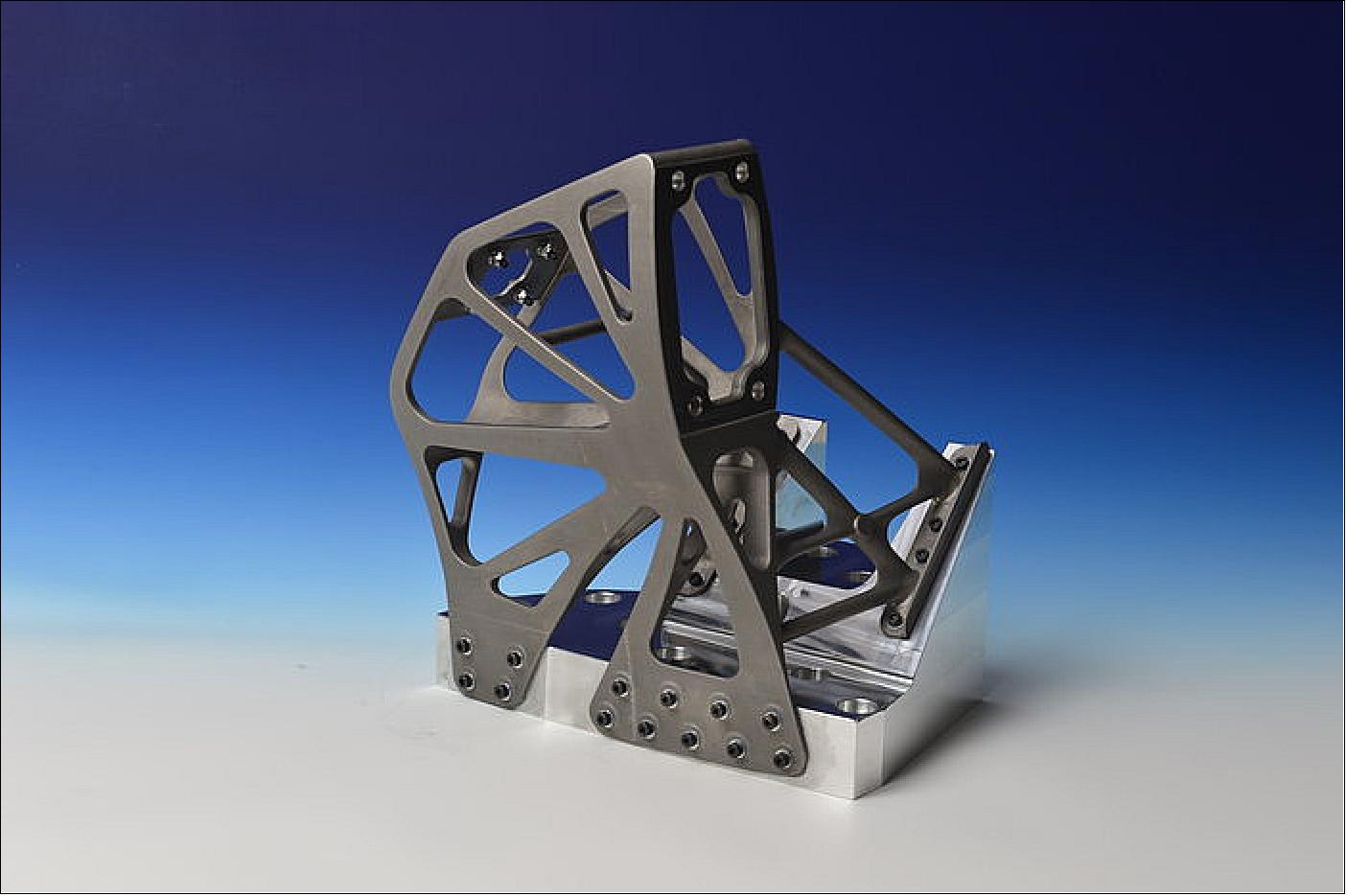
- At the same time their performance can be just as good, if not better, with sharp reductions in mass and manufacturing time.
- This bracket is a 30% lighter version of an operational original, serving to support the cryogenic fuel tank of Ariane 5’s upper stage.
- It was not so much designed as grown, with the instrument’s design requirements put through ‘topology optimization’ software to arrive at the best possible shape.
- This bracket was 3D printed using selective laser melting by ArianeGroup for ESA as part of the Agency’s Future Launchers FLPP (Future Launchers Preparatory Program).
• June 2, 2019: ESA safeguards Europe’s guaranteed access to space through its FLPP (Future Launchers Preparatory Program). 83)
- FLPP weighs up the opportunities and risks of different launch vehicle concepts and associated technologies. Its demonstrators and studies hone emerging technologies to give Europe's rocket builders a valuable head-start as they begin the demanding work of turning the chosen design into reality.
- Based on a standardized scale of TRL (Technology Readiness Levels), technologies that have been demonstrated in a laboratory environment at Level 3, are further developed within FLPP and tested via integrated demonstrators to raise them to TRL 6.
- Once a technology has reached level 6, much of the risk linked to using a new technology in a space environment has been mitigated. It can be quickly transferred to a development up to flight (TRL 9) with optimized cost and schedule.
- FLPP defines the concepts and requirements for new space transportation systems and services. Technologies are selected on their potential to reduce cost, improve performance, improve reliability, or on their ability to fulfil the specific needs of an identified system, demonstrator or mission.
- Within the program, integrated demonstrators are built by combining multiple technologies into one system or subsystem so that industry can use the technology with confidence.
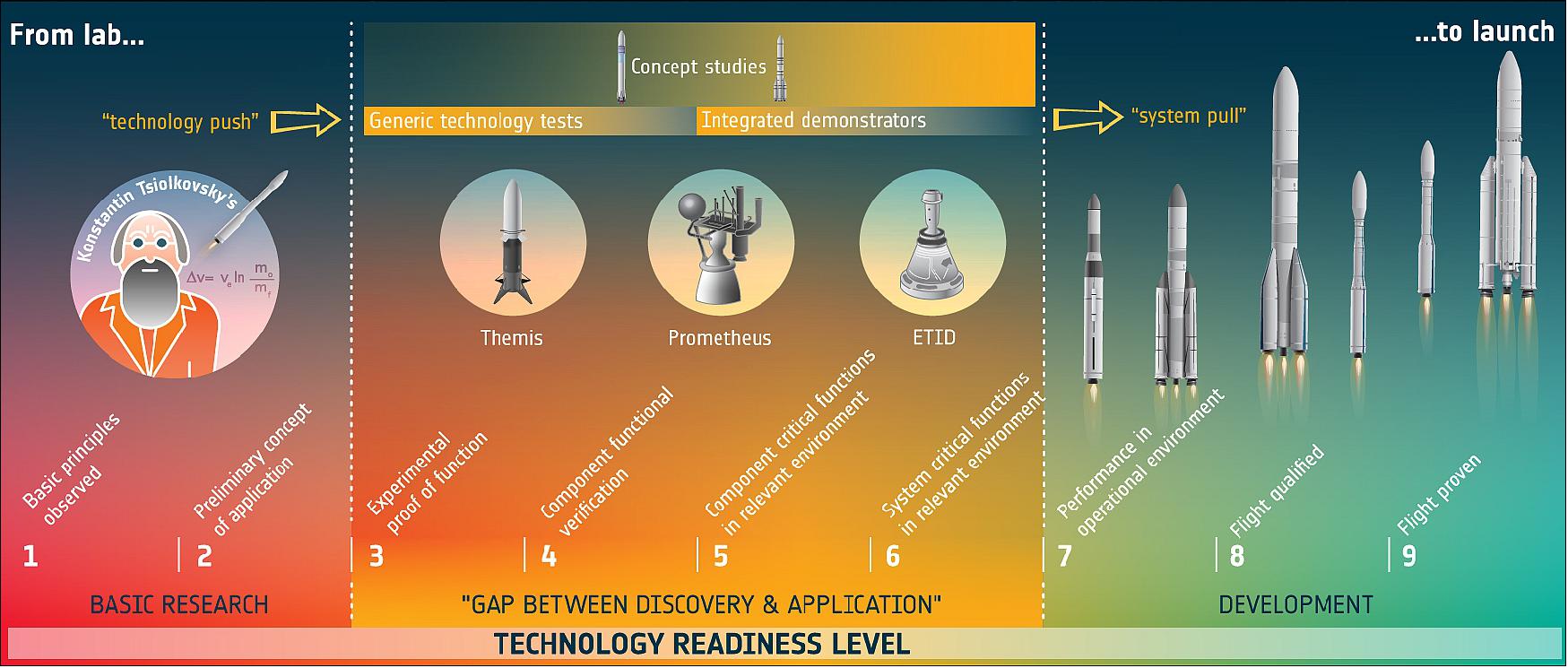
• May 29, 2019: ESA has recently completed hot-firing tests that prove technologies in a move towards ‘intelligent’ engines to power the upper stages of next-generation launchers. 85)
- The ETID (Expander-cycle Technology Integrated Demonstrator) is a full-scale integrated demonstrator for an upper-stage rocket engine.
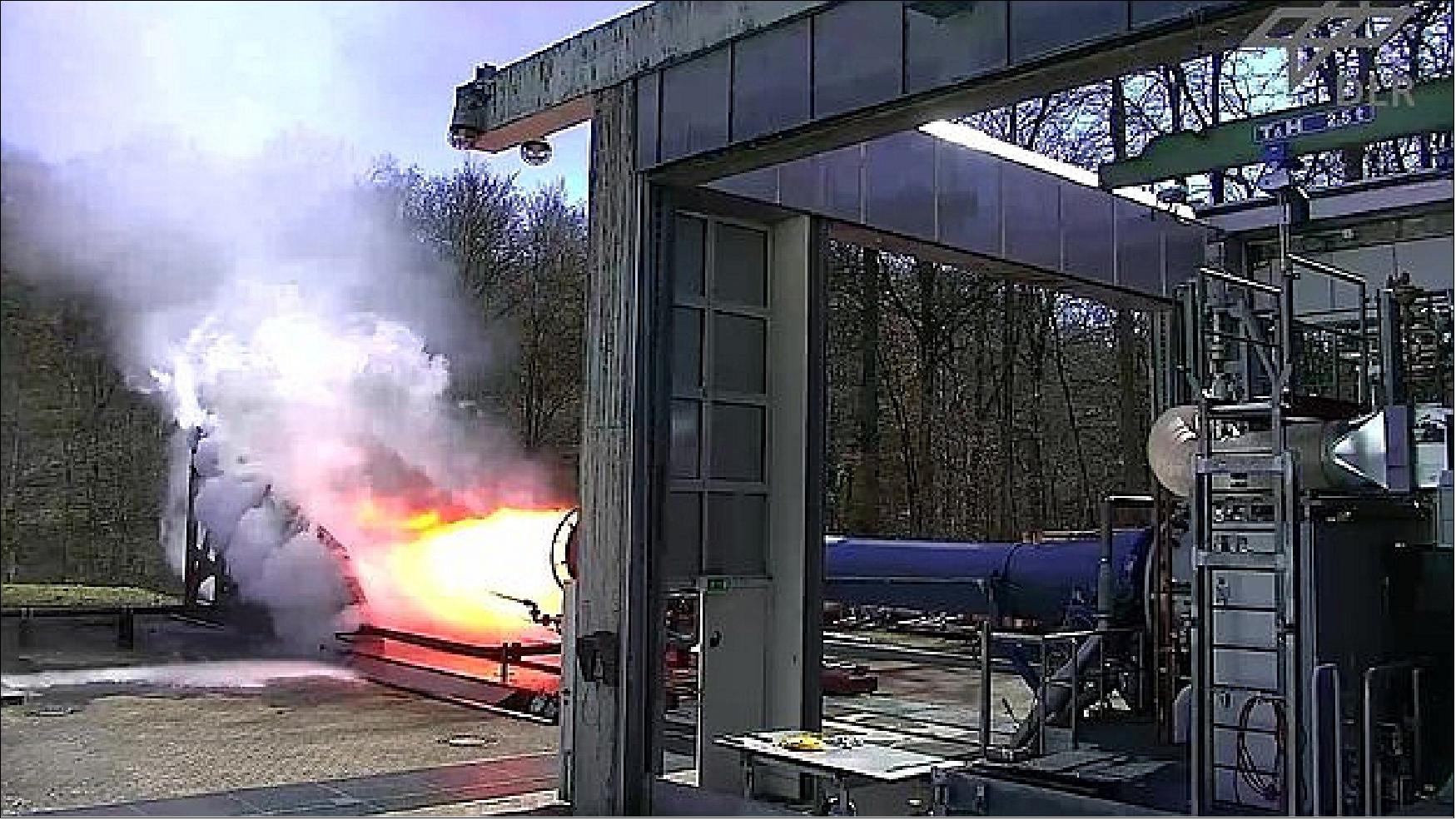
- Yesterday ESA, industrial partners and representatives of participating Member States met at DLR Lampoldshausen, Germany, to review the results of ETID’s extremely successful nine-month test campaign on the P3.2 test bench.
- In total, four configurations of ETID with three new combustion chamber geometries and designs were tested.
- Two different injector heads, including a fully 3D-printed version were also tested, as well as a regenerative nozzle that optimizes the engine cycle by maximizing the heat pick-up.
- Both the combustion chamber and the nozzle use the heat of the combustion to pre-heat and therefore “expand” the hydrogen propellant before combustion. The flow of cold hydrogen also has the effect of cooling the hardware, keeping the temperature within reasonable limits during operation.
- Two different electrical igniters, laser and direct spark, were shown to reignite the engines multiple times, and the electrically-operated valves showed perfect repeatability, aiding the engine startup.
- In the first step towards an ‘intelligent’ engine, there is a fault-tolerant controller associated with the valves. If any electrical component fails, the control system automatically compensates so there is no functional impact.
- Overall, 23 tests were performed for a total operating time of 2707s. During the testing 49 different operating points were reached, including testing the behavior in “extreme” regimes – such as increasing the flow of cool hydrogen in the system and therefore “over-cooling” the hardware during operation.
- This shows the versatility of the ETID design to operate over wide mixture ratio and chamber pressure ranges. This variety of operating points will also help to calibrate the numerical models used to design subsequent engines and predict their performance.
- The ETID project was carried out within ESA’s Future Launchers Preparatory Program.
• May 14, 2019: Rocket upper stages are commonly made of aluminum but switching to carbon composites lowers cost and could yield two metric tons spare payload capacity. 86)
- MT Aerospace, Augsburg, Germany, and ArianeGroup, Bremen, signed contracts with ESA today to develop Phoebus (Prototype of a Highly OptimizEd Black Upper Stage).
- Ulrich Scheib, Director Head of Strategy, Business Development and Space Programs at MT Aerospace, Daniel Neuenschwander, ESA Director of Space Transportation and Jean-Christophe Henoux, Vice President Future Programs at ArianeGroup signed at ESA Headquarters in Paris, France.
- This project builds on legacy upper stage technologies and emerging composite cryogenic capabilities.
- This low-cost lightweight Phoebus demonstrator introduces carbon composite materials, in particular for the metallic tanks containing the cryogenic propellants such as liquid hydrogen and oxygen, and for other primary and secondary structures.
- Composites allow for new architectures and combinations of functions, which are not possible using metallic materials. Further optimizing the entire upper stage architecture, refining propellant loading, minimizing surplus fuel, application of wireless sensors, and alternative interface techniques, could bring the estimated increase in payload capacity to as much as two metric tonnes in geostationary orbit.
- “Future composite upper stages will look very different to those of today,” commented Josef Wiedemann, ESA Project Manager, “Carbon composites will replace much of the metal thereby reducing the mass and offering new opportunities to redefine the architecture of the upper stage depending on mission requirements.”
- The goal is to achieve optimum mass savings while ensuring propellant compatibility with these new materials, at a lower production cost.
- Phoebus aims to bring the relevant cutting-edge technologies to a technical readiness high enough to deliver an integrated stage demonstrator for cryogenic ground testing purposes in 2022. This will validate the technologies in a representative environment providing the foundation to enter development of future lightweight, low-cost upper stages, with applications for Ariane 6 in 2025.
- These activities are being carried out within ESA’s Future Launchers Preparatory Program.
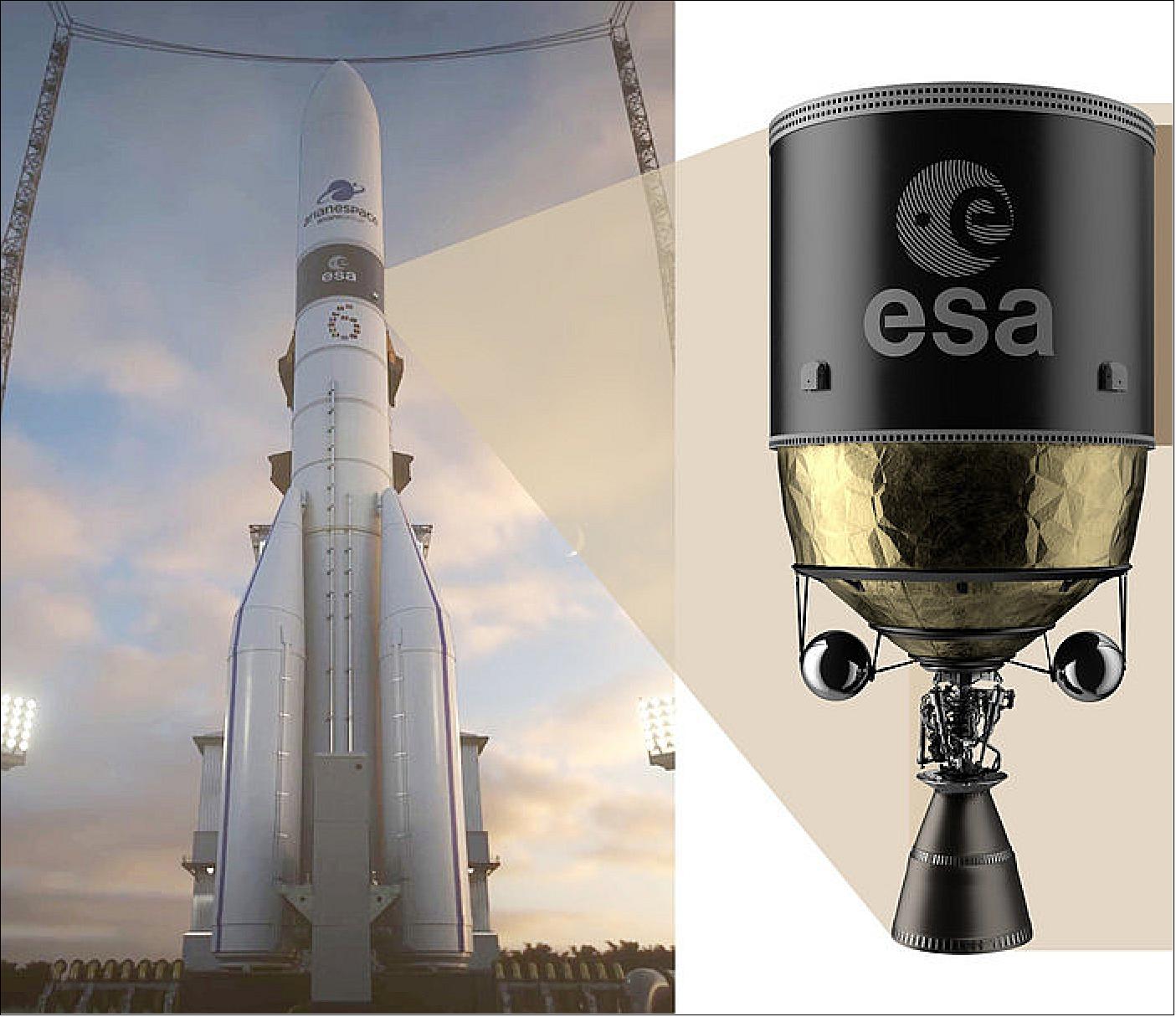
• February 26, 2019: Today, the DLR German Aerospace Center in Lampoldshausen inaugurated a new test facility that simulates launch for the complete Ariane 6 upper stage. 87)
- The Lampoldshausen center makes a key contribution to Europe’s progress in space propulsion and already tests the Ariane 6’s Vulcain 2.1, and Vinci rocket engines. Other rocket engines tested here include the upper-stage expander cycle demonstrator ETID, and recently a 3D-printed thrust chamber designed for storable-propellants, both developed within ESA’s Future Launchers Preparatory Program.
- “An essential part of proving that a launch system is ready, is to test the complete rocket stages in conditions that are as close as possible to those experienced in flight,” added Pier Domenico Resta, ESA’s Ariane 6 Launch System Architect Manager. “This new test facility will enable us to simulate the launch, from ground activities such as fuelling and draining of tanks, through all flight phases.”
- The test stand design is complex, having many fluid interfaces including cryogenic supplies, near-vacuum simulation, an acoustic noise reduction system, electrical interfaces and a control stand that complies with strict safety constraints.
- Operations inside the test stand are monitored from a central control room located away from the test stand.
- The tests will include the Vinci engine firing, non-propulsive ballistic phases, tank pressurization to increase performance, Vinci reignitions, exhaust nozzle maneuvers, ending with passivation where all remaining internal energy is removed.
- Tests will last up to 18 hours and could be repeated on a weekly basis.
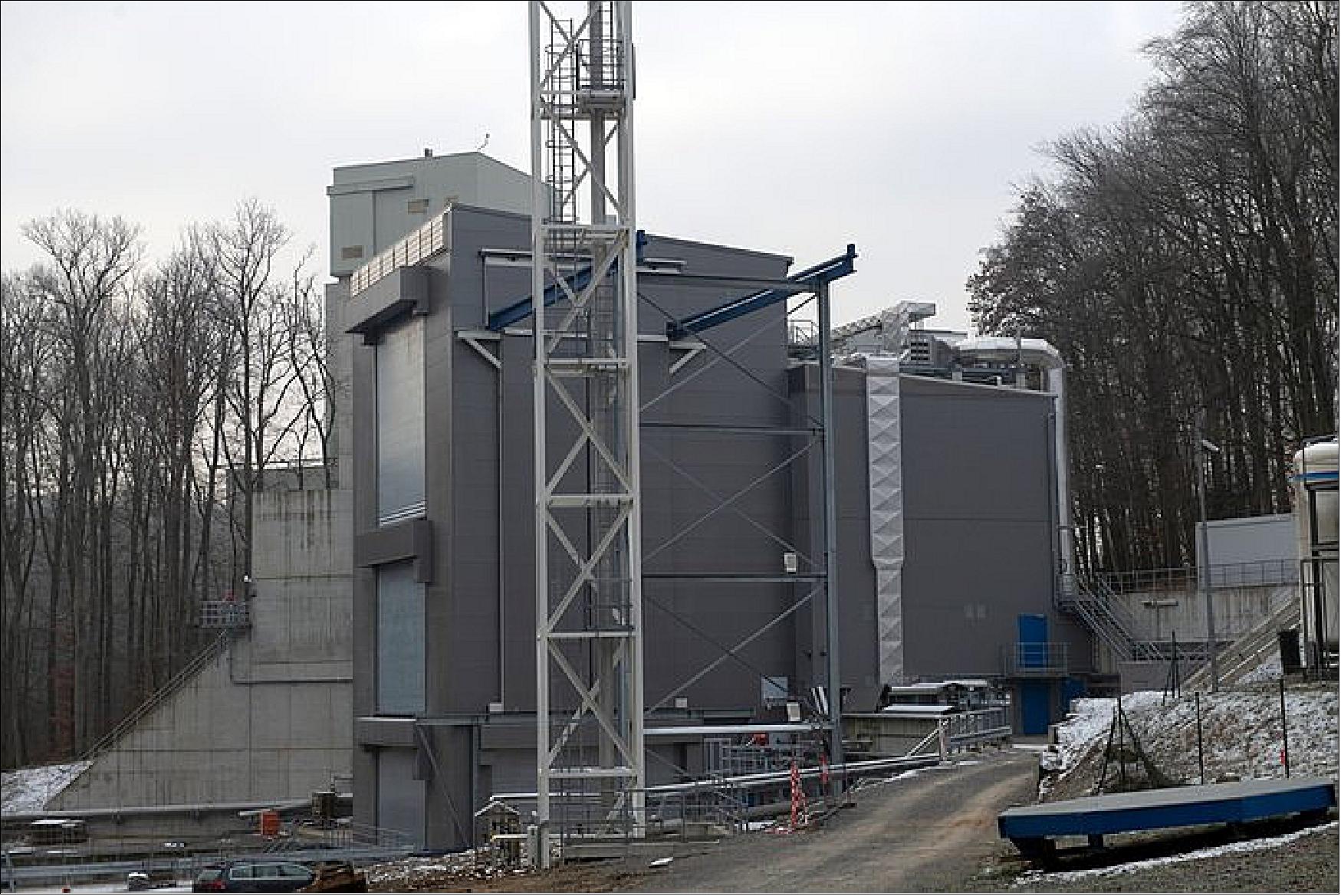
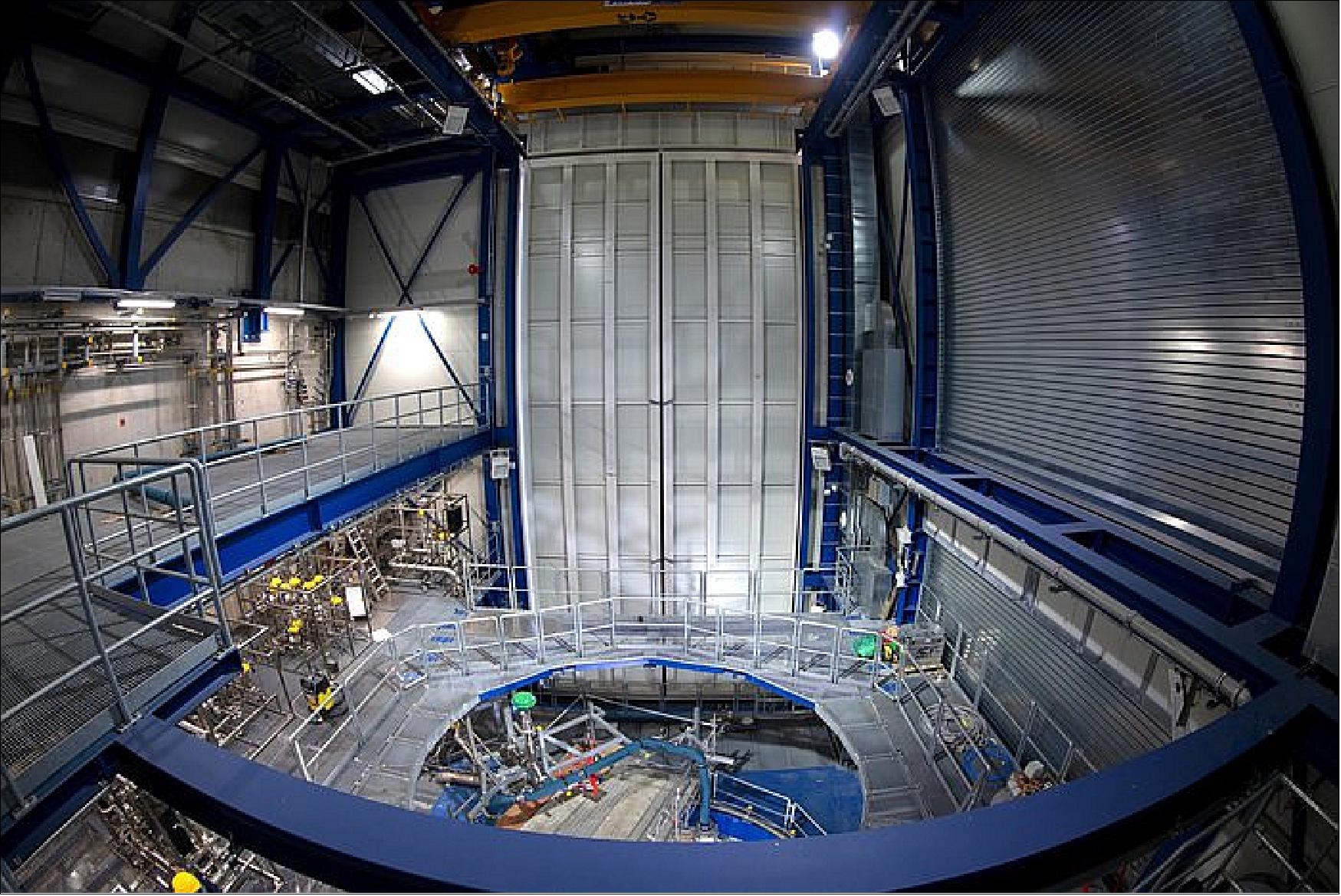
• February 21, 2019: The recent hot firing of a full-scale rocket thrust chamber assembly takes us a step closer to proving 3D-printing for an engine design destined for rocket upper stages, in-orbit transportation applications (kick-stages and space-tugs), microlaunchers, and exploration spacecraft such as a lunar lander and ascent stage on the Moon. 88)
- Manufactured entirely by 3D-printing, this thrust chamber is designed for ‘storable propellants’, called such because they can be stored as liquids at room temperature. Rocket engines that are powered this way are easy to ignite reliably and repeatedly on missions lasting many months.
- This Combustion Chamber demonstrator, with a reference thrust of 2.5 kN, was hot-fired for 560 seconds at the DLR German Aerospace Center’s Lampoldshausen testing facility in Germany.
- The knowledge gained from this test campaign will be applied in turn to future engine designs to achieve a thrust range of about 2–10 kN.
- Developed by ArianeGroup within ESA’s Future Launchers Preparatory Program, this combustion chamber helps to investigate flow and heat transfer phenomena on surfaces created by 3D printing – otherwise known as additive layer manufacturing.
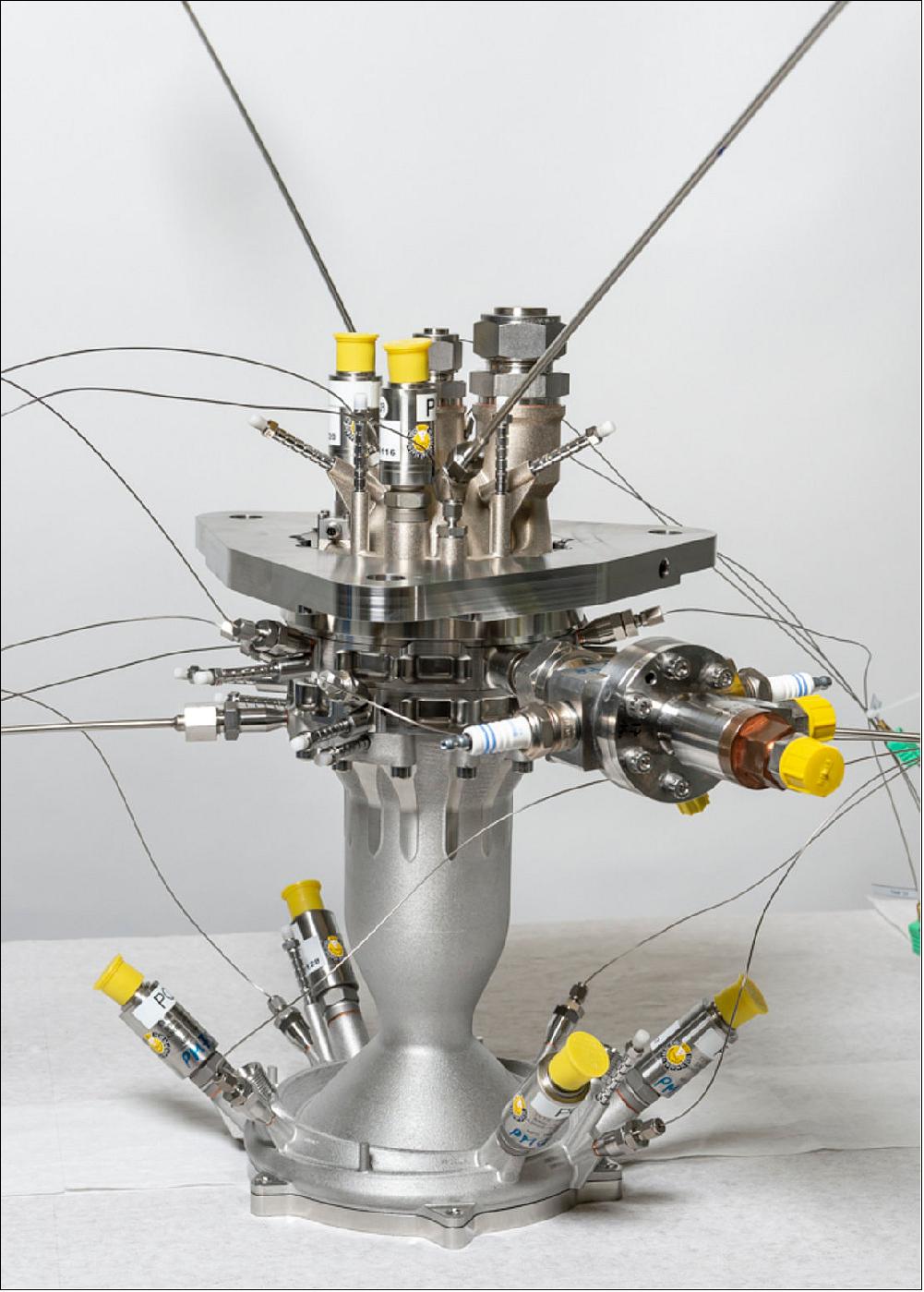
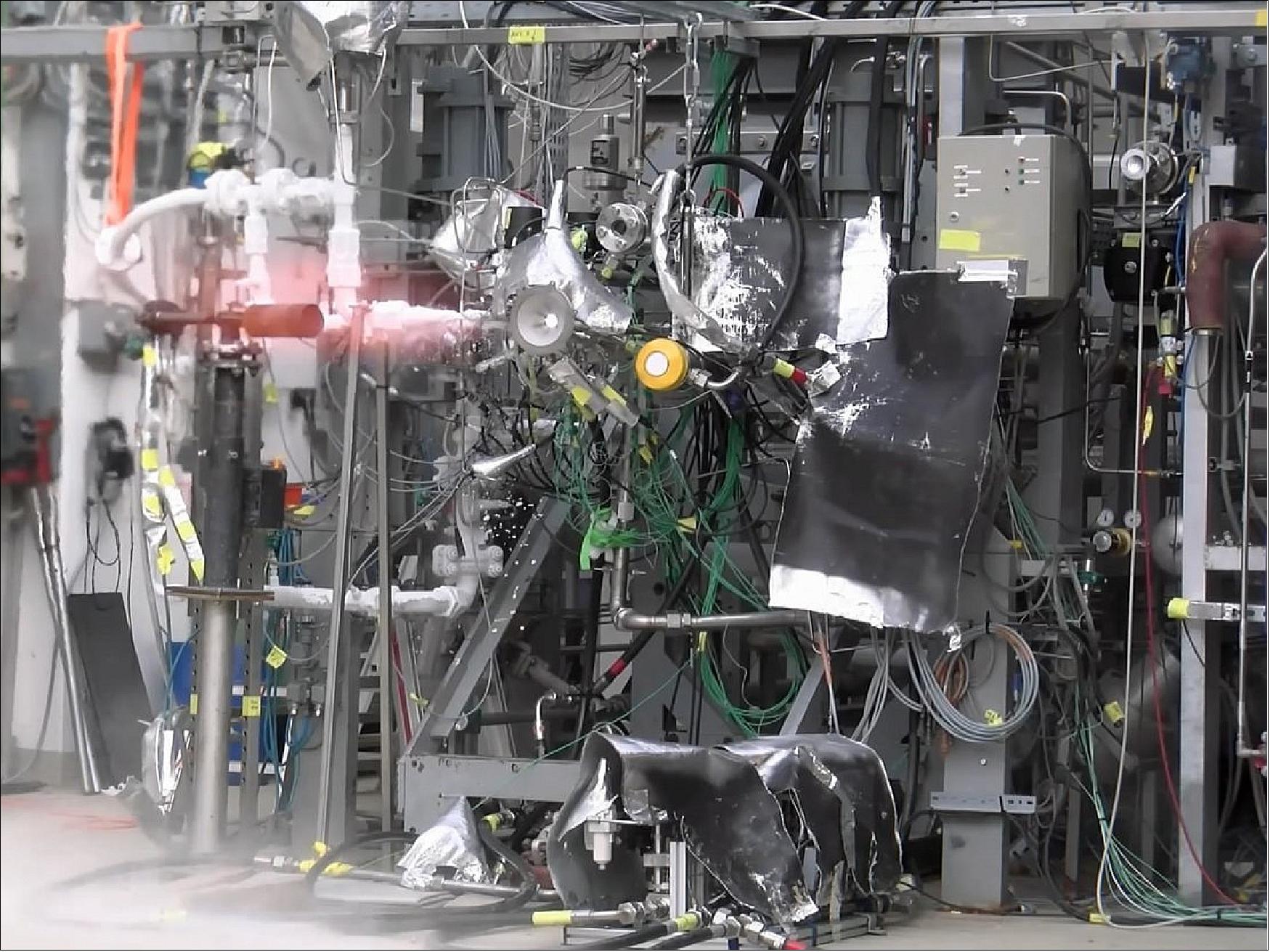
- Additive layer manufacturing builds up a part layer by layer instead of the traditional process of cutting away bulk material. Complex, optimized structures, impossible to manufacture via classical methods, can be created using reduced amounts of material and energy, and in far fewer manufacturing steps.
- A complex arrangement of cooling channels has been printed into the structure of the combustion chamber, to cool the chamber walls.
- “3D-printing and qualifying parts for hot-firing and ultimately flight is a challenge, especially when dealing with fine, complicated structures, like the cooling channels of our demonstrator” added Wenzel Schoroth, propulsion engineer at ESA. “This hot-fire test is a way of demonstrating the effectiveness of our processes, as well as learning more about the flow phenomena within additively manufactured rocket engines.” On the test bench, the cooling mechanism is diverted away from the propellant feed via an adapter between the combustion chamber and the injector head – both of which have been additively manufactured.
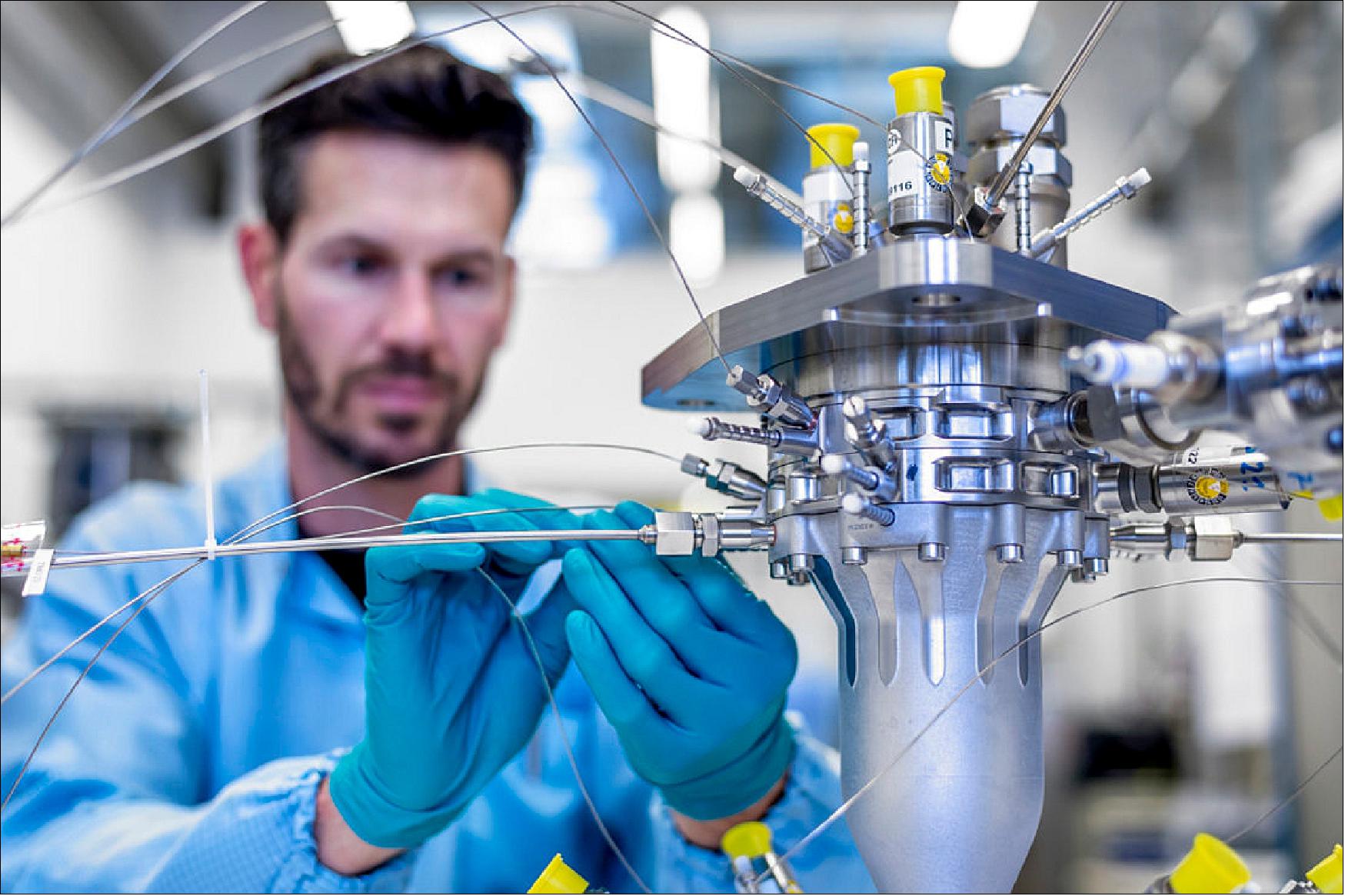
- This allows engineers greater flexibility to investigate the cooling system separately from the combustion process to study the thermodynamic and fluid dynamic properties of the additively manufactured structures and surfaces.
- Further activities will focus on the application of green, environmentally friendly propellants for a larger engine delivering 5 kN of thrust.
- Additionally, ESA is developing additive manufacturing technology for larger engine demonstrators with cryogenic propellants such as Prometheus and ETID.
• January 11, 2019: Here's the finalized frame of the mobile gantry that will cover Ariane 6 pre-launch. Completed on November 30 2018, even though it is 90 meters tall and weighs more than the Eiffel Tower, the entire structure is able to move on rails to uncover Ariane 6 as shortly as possible before takeoff. 89)
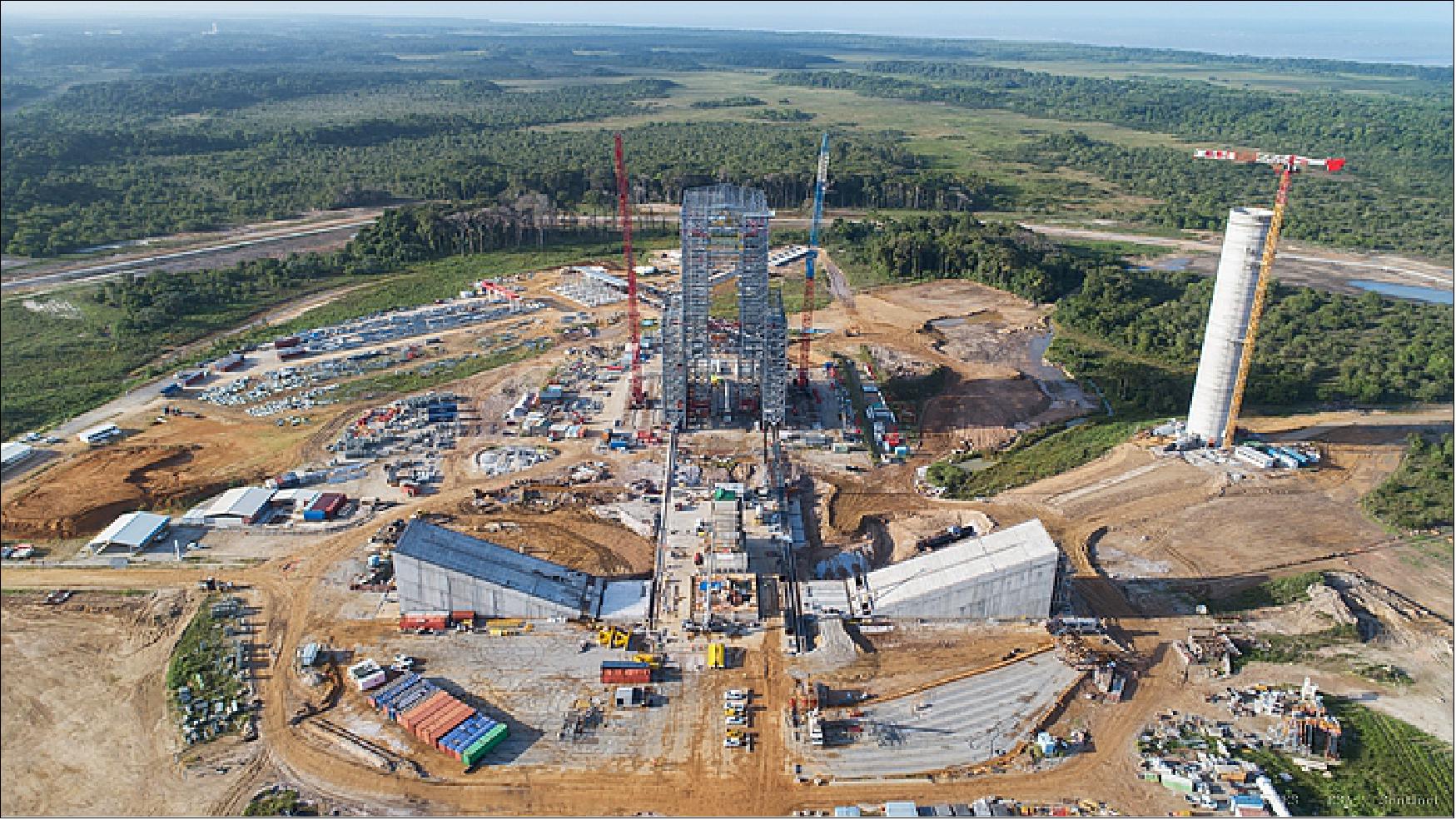
• December 6, 2018: This has been an intense year for Ariane 6 development, with progress boosted across Europe: plants are manufacturing new parts using novel methods, all engines have been tested, and the construction of launch facilities is well underway. 90)
- ESA has worked with an industrial network led by prime contractor ArianeGroup, of more than 600 companies in 13 European countries, including 350 small- and medium-sized enterprises, to fine-tune the design and start production. Meanwhile, France’s CNES space agency has been preparing its launch facilities at Europe’s Spaceport in French Guiana. 91) 92)
• October 25, 2018: Today, the ESA Council met at ministerial level in Madrid to discuss the proposal of ESA’s Director General Jan Wörner for a “United Europe in Space”. — At this meeting, a joint statement on the institutional exploitation of Ariane 6 and Vega-C was signed by Jan Wörner, ESA Director General; Roberto Battiston, President at Agenzia Spaziale Italiana (ASI); Javier Ponce, Director General at the Centro para el Desarrollo Tecnológico Industrial (CDTI); Jean-Yves Le Gall, President at the Centre National d'Etudes Spatiales (CNES); Walther Pelzer, Deutsches Zentrum für Luft- und Raumfahrt (DLR); and Mauro Dell’ Ambrogio, Secretary of State of the Swiss Confederation. 93)
- Through this Statement, the signatories express their full support to the European launcher industry and to Ariane 6 and Vega-C. They recognize the benefit of aggregating their institutional demand for launch services to ensure an independent, cost-effective, affordable, and reliable access to space for Europe.
- The Joint Statement also establishes a high-level forum with the objective to exchange on economic and financial trends on the worldwide launch service market, launch services needs for their missions, and consolidation of a European institutional launch planning. This forum will be open to all European institutional customers of launch services and interested potential parties sharing these objectives.
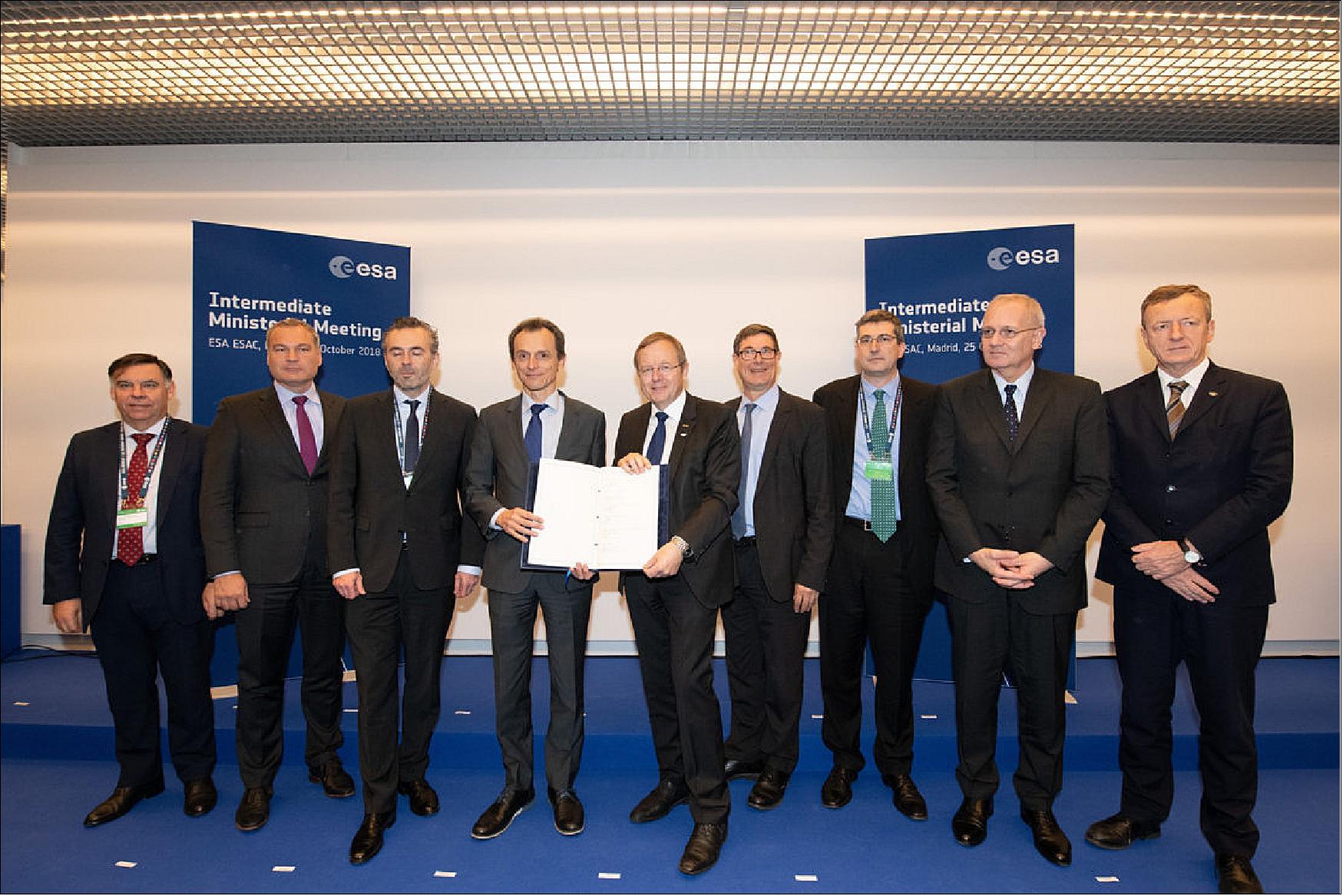
Legend to Figure 107: Pictured from left to right: Javier Ponce Martínez, Director General at CDTI; Walther Pelzer, member of the DLR Executive Board; Thomas Jarzombek, Federal Government Coordinator of German Aerospace Policy; Pedro Duque, Spain's Minister of Science, Innovation and Universities; Jan Wörner, ESA Director General; Mauro Dell’ Ambrogio, State Secretary for Education, Research and Innovation; Stefano Gualandris, Special Advisor to State Secretary Giancarlo Giorgetti; Jean-Yves Le Gall, President at CNES; Roberto Battiston, President at ASI.
The statement was signed by the European Space Agency, the Agenzia Spaziale Italiana (ASI), the Centro para el Desarrollo Tecnológico Industrial (CDTI), the Centre National d'Etudes Spatiales (CNES), the Deutsches Zentrum für Luft- und Raumfahrt (DLR) and the Swiss Confederation.
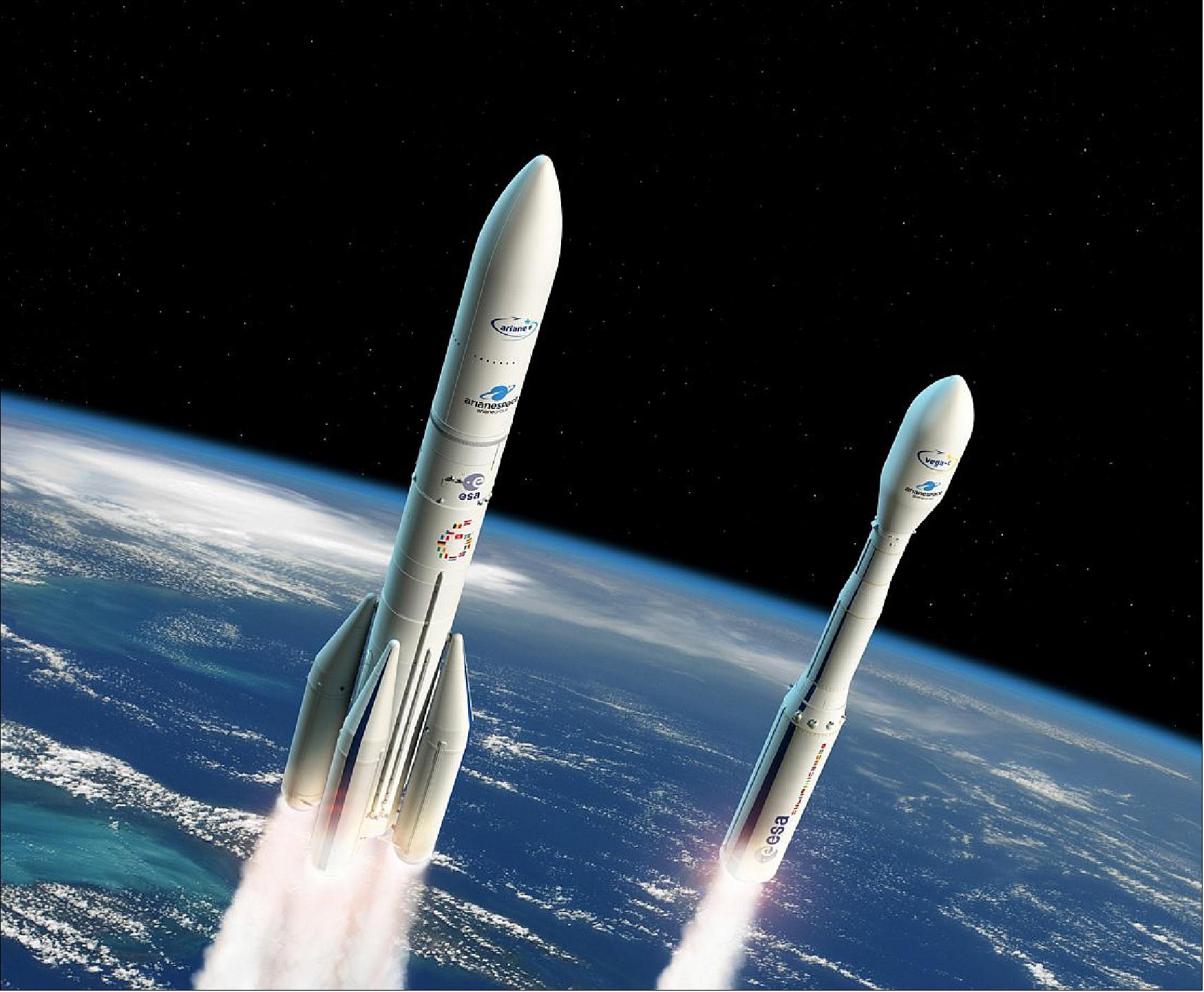
Ariane 6 is Europe’s newest launcher, designed to extend guaranteed access to space for Europe at a competitive price. Fully versatile, it is capable of carrying out all types of missions to all orbits. It features a modular design with two versions: Ariane 62, fitted with two P120C boosters, and Ariane 64, with four. Its maiden flight is planned for mid-2020.
Vega-C is expected to debut at the end of 2019 with P120C as the first-stage motor, which will increase performance from Vega’s current 1.5 t to about 2.2 t in a reference 700 km polar orbit. The additional performance, improved avionics, mission flexibility and expanded fairing volume can capture a wider market of satellites.
• September 20, 2018: The 700 ton steel table that will support Ariane 6 at liftoff is now on the pad at Europe’s Spaceport in French Guiana. 94)
- This structure is so large that it arrived in parts by ship in February, was then welded together and fitted with equipment at a preparation area about 250 m from the launch pad.
- Moving this giant 4 m high, 20 m long and 18 m wide table into its permanent position on the center of the pad is complex. Four hydraulic jacks lifted the table, then two trollies moved the table to the edge of the launch pad. A temporary railway and a mechanical guidance system helped roll the table into position over the center of the pad where it will be lowered with millimeter precision into its final position in the coming days. - Further mechanical, fluidic and electrical equipment will be installed inside and outside the table.
- Activities at Europe’s Spaceport continue to make headway with the next major works involving the integration of the mast as well as the exhaust ‘deflector’ that will sit at the base of the concrete flame duct reaching 25 m below the launch table.
- Ariane 6’s first flight is planned for mid-2020.
• September 18, 2018: At the end of 2019, Vega-C will be launched from Europe’s Spaceport in French Guiana increasing performance from Vega’s current 1.5 t to about 2.2 t in its reference 700 km polar orbit, with no increase in launch costs. 95)
- Vega-C's first stage is based on the P120, the largest single segment carbon fiber solid-propellant rocket motor ever built. It was successfully tested in July 2018. Its development relies on new technologies derived from Vega’s current first stage P80 motor. Two or four P120C motors will also be used for the liftoff boosters on Ariane 6.
- Vega-C’s 3.3 m diameter fairing will accommodate larger payloads such as Earth observation satellites of more than two tonnes, and ESA’s Space Rider reentry vehicle.
- The Vega launch pad and mobile gantry are being modified to accommodate Vega-C leading into a period when launch facilities will accommodate both vehicles.
• September 11, 2018: Arianespace is present at World Satellite Business Week (WSBW) from September 10 to 14 in Paris, confirming the attractiveness of its launcher family with the announcement of two contracts for Ariane 6: the first with Eutelsat as part of a launch services agreement involving five satellites; and the second with France’s CNES space agency and the country’s DGA defense procurement agency for the CSO-3 ( Composante Spatiale Optique-3) satellite of the MUSIS (Multinational Space-based Imaging System) program. A third contract also was signed recently with the Indian Space Research Organization (ISRO) for Ariane 5 missions to orbit two satellites. 96)
- Arianespace’s backlog is now 59 launches to be carried out during the coming years, including three on Vega C and five on Ariane 6 – the new launchers slated to make their maiden flights in 2019 and 2020, respectively.
- As World Satellite Business Week opened its doors, Arianespace and Eutelsat announced the signature of a multi-year multiple-launch agreement concerning five satellites to be launched through 2027, making Eutelsat the first commercial Ariane 6 customer with geostationary orbit satellite payloads. For institutional missions, after the two launch contracts signed in 2017 for the European Commission and ESA’s Galileo constellation, CNES and the DGA have chosen the A62 version of Ariane 6 (with two boosters) to launch their CSO-3 satellite. These orders clearly reflect the competitiveness and versatility of Ariane 6, which will be available in two versions to handle all orbits and multiple payload configurations under the fairing.
• July 16, 2018: Today's hot firing of the P120C solid-propellant motor at Europe’s Spaceport in French Guiana proves its flight-worthiness for use on Vega-C next year and on Ariane 6 from 2020. 97) 98)
- This marks an important milestone in the development schedule of Europe’s new-generation launchers, designed to boost our autonomy in the space arena, and maintain Europe’s global competitiveness.
- The test lasted 135 seconds simulating the complete burn time from liftoff and through the first phase of flight. No anomalies were seen and the performance met expectations, though full analysis will take several months.
- The P120C is 13.5 m long and 3.4 m in diameter and is made using a carbon composite material and built in one segment. It will replace the current P80 as the first stage motor of Vega-C. Two or four P120Cs will be strapped onto Ariane 6 as boosters for liftoff.
- This test was a collaboration between ESA, France’s CNES space agency, and Europropulsion under contract to Avio and ArianeGroup. — The next static firing will occur at the end of this year with the P120C qualification motor.
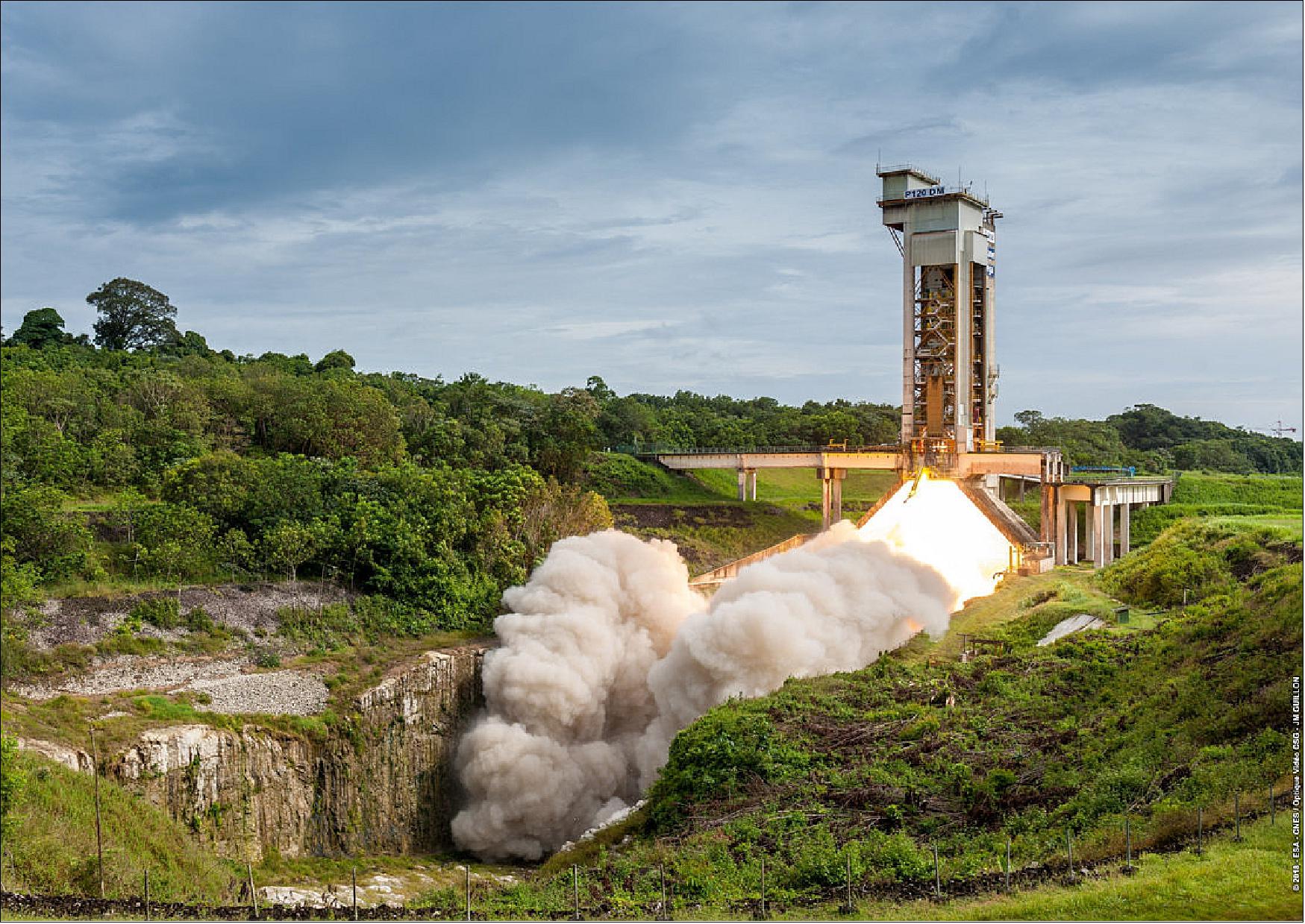
• July 12, 2018: Arianespace has forged forward with a production line, named the B-Line, that includes the world’s most powerful robot, capable of handling nozzles weighing in excess of 2 tons, measuring nearly 3 meters in height and 2.2 meters in diameter. The B-Line is for manufacturing the solid rocket booster P120C motor being used by both future European launchers, Ariane 6 and Vega-C. In doing so they have officially opened a facility at Le Haillan, near Bordeaux, in the heart of the Nouvelle-Aquitaine Region. 99)
- The production line (known as the B-Line), to produce nozzles for the solid rocket booster P120C motor is the first of a new series of production lines for Ariane 6, which was inaugurated by ArianeGroup in 2018, while the P120C booster will be tested at the Guiana Space Center in Kourou.
- And there's more, including the stage assembly buildings for Ariane 6 in Bremen, Germany, and Les Mureaux, France, which are also being finalized in preparation for the first Ariane 6 flight, scheduled for mid-2020.
- This 1,600 m2 unit, christened B-Line, is designed to produce up to 35 nozzles per year for the P120C solid propellant booster, an output that is three times higher than that of the current Ariane 5 boosters.
- The P120C (for “Common”) is the core of the rationalization process for the European launchers range, as it will be used for the boosters powering the Ariane 62 (2 boosters) and Ariane 64 (4 boosters) as well as for the first stage of the Vega-C launcher. Its lift-off thrust can reach more than 4500 kN and, when loaded with 142 tons of propellant, the booster can function in flight for 130 seconds. It is assembled in French Guiana by Europropulsion, a 50/50 subsidiary of ArianeGroup and Avio.
- Alain Charmeau, CEO of ArianeGroup stated that the nozzle produced on the new B-Line in Le Haillan contributes to meeting the targets of the Ariane 6 and Vega-C programs, with optimized costs and shorter cycles, based on a simplified design and the use of innovative technologies and processes. He wishes to thank all the teams at ArianeGroup and those of their industrial partners, who have demonstrated their adaptability in enabling this new production unit to be delivered in record time, thus contributing to the success of the P120C program. With this B-Line in Bordeaux and the V-Line in Vernon in Normandy, inaugurated at the end of 2016 for final assembly of the Vinci® and Vulcain®2.1 engines for Ariane 6, ArianeGroup has unique production resources and know-how in the field of solid and liquid propulsion. They are supplementing these resources with the Ariane 6 stage assembly buildings currently under construction in Bremen, Germany, for the upper stage and at Les Mureaux, in France, for the main stage. With these facilities, ArianeGroup and its industrial partners will be ready for the first launch of Vega-C in 2019 and of Ariane 6 in 2020.
• July 9, 2018: This week, the largest solid rocket motor ever built in one piece will be test fired at Europe’s Spaceport in French Guiana for the first time. This important milestone validates the booster for use on Vega-C next year and on Ariane 6 from 2020. 100)
- The P120C is 13.5 m long and 3.4 m in diameter, contains 142 tons of solid propellant and provides a maximum thrust of 4615 kN (in vacuum) over a burn time of about 135 s.
- The design builds on existing expertise and lessons learned with Vega’s P80 first stage motor. P120C will replace P80 as the first stage motor of Vega-C. Two or four P120Cs will be strapped onto Ariane 6 as boosters for liftoff.
- All main components of the motor such as nozzle, igniter, solid propellant, and insulated motor case have already been tested separately. This static firing will prove these technologies, materials and production techniques in combination and validate the behavior of the assembled motor.
- The test stand with the tools and equipment that will secure the P120C for its test firing, have had to be modified or developed to accommodate this huge motor.
- Recently a full-scale model of the P120C filled with inert propellant allowed engineers to verify tools, check connections and perfect procedures.
- Information gathered during this static firing will allow engineers to compare their numerical models against observed reality to consolidate the P120C design.
- This will guide the design of the P120C qualification motor that will be static fired at the end of the year.
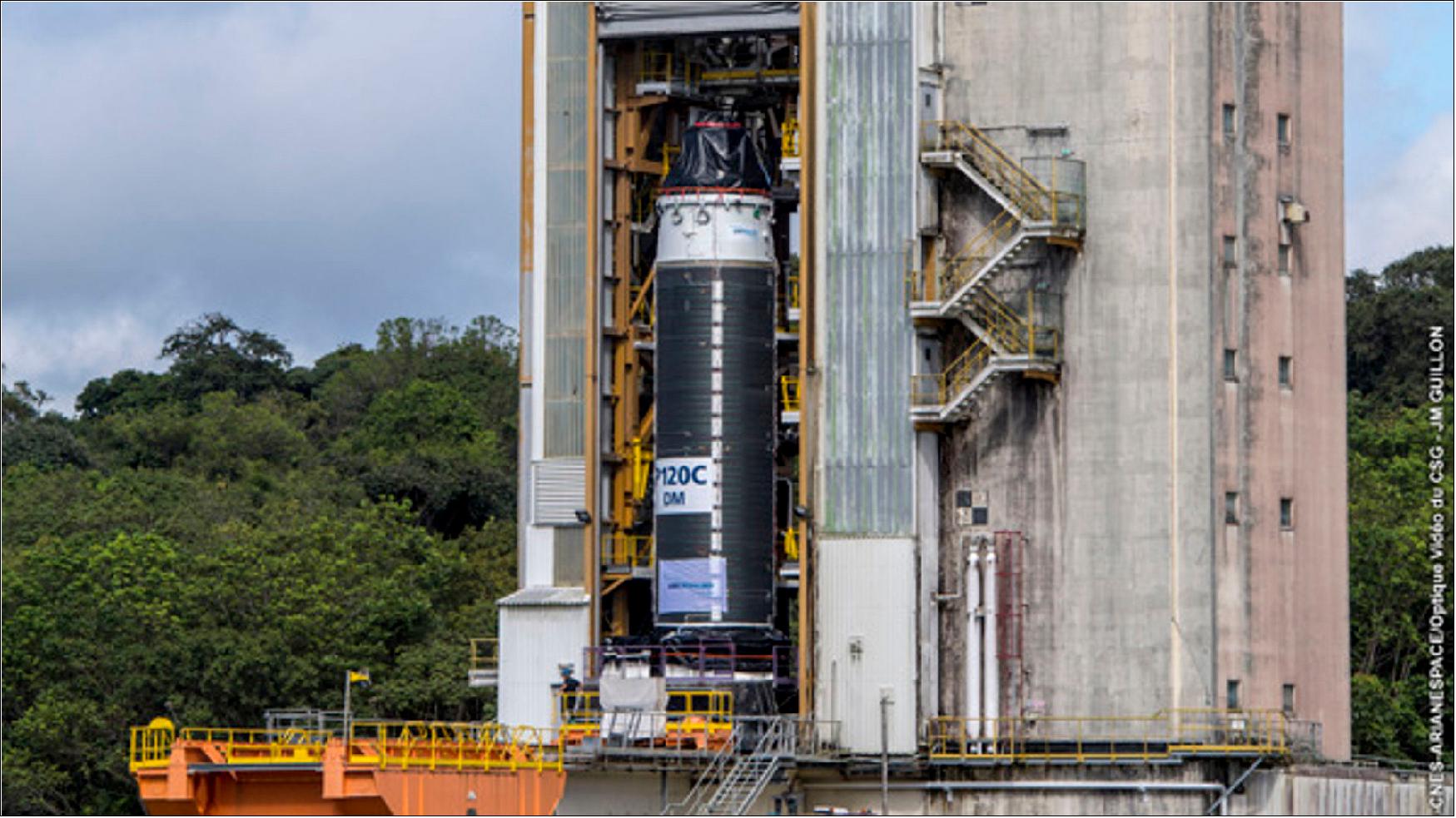
• June 20, 2018: Fully loaded with 142 tons of solid fuel, the development model of the P120C rocket motor was transferred from the integration building to the test stand at the beginning of June 2018 to prepare for its first static hot firing at Europe’s Spaceport in Kourou, French Guiana. 101)
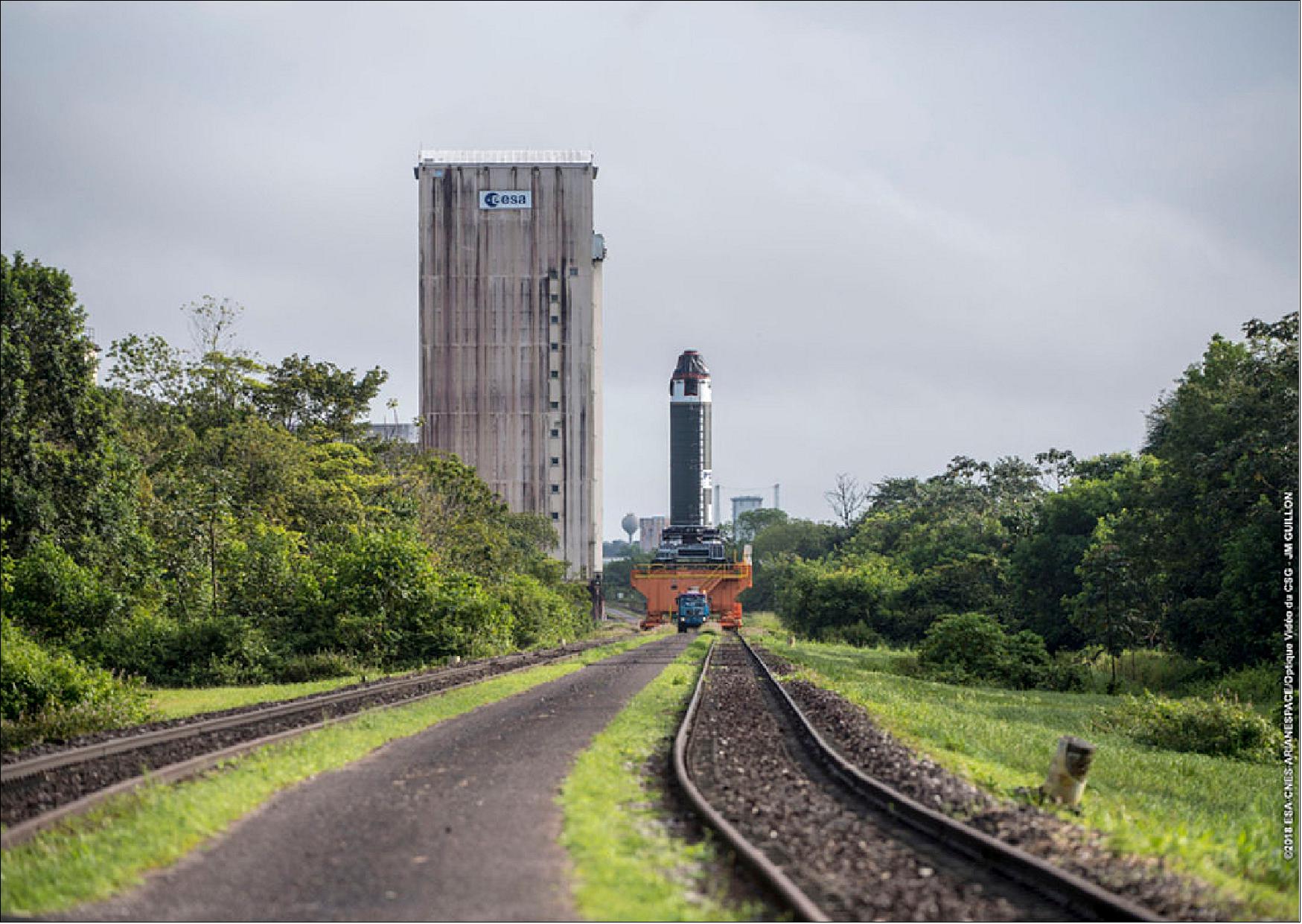
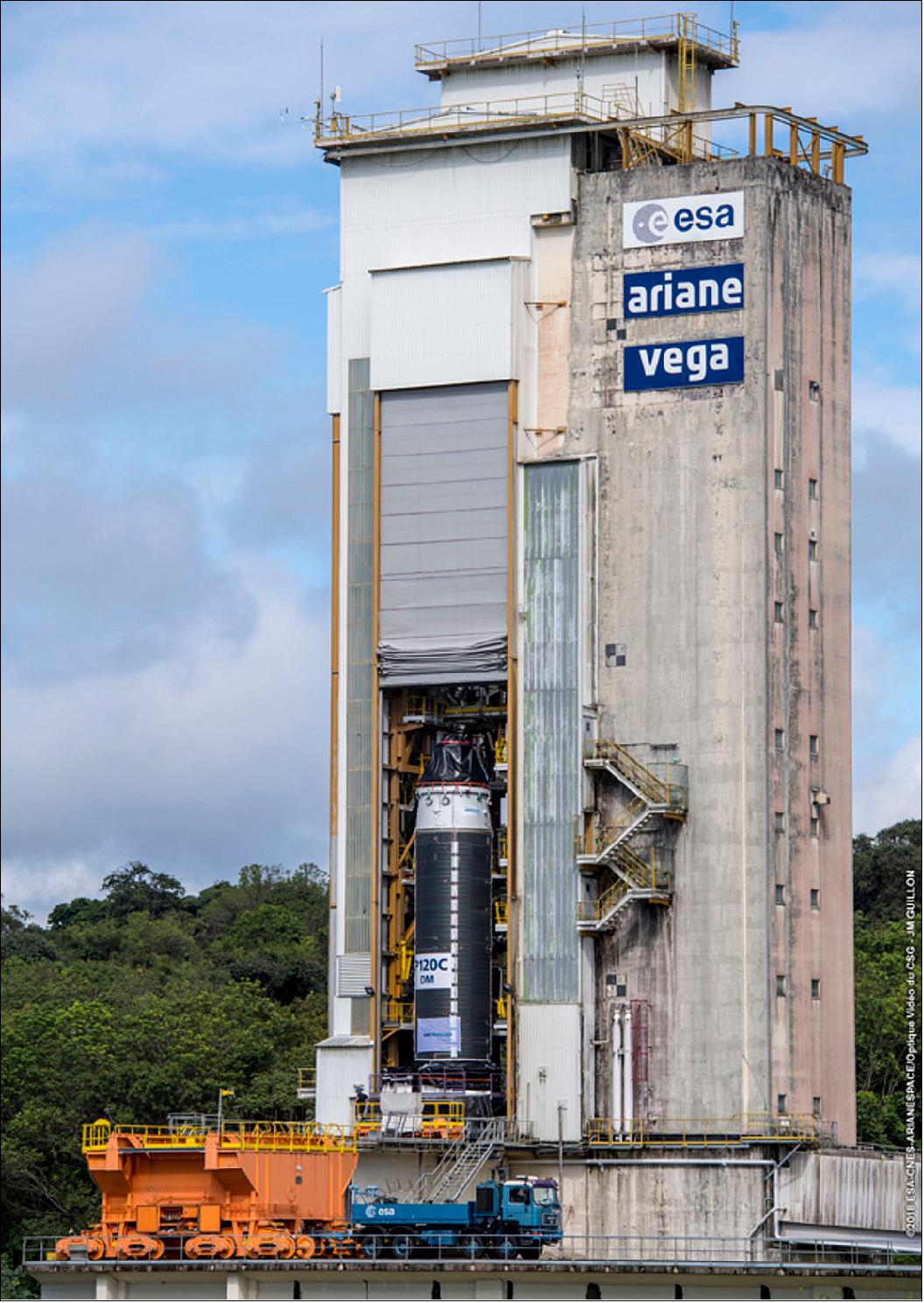
• June 21, 2018: Aviation and space technology company MT Aerospace AG in Augsburg, Germany, a subsidiary of the technology group OHB SE, has officially opened the new production facilities for the Ariane 6. 102)
- MT Aerospace has built a new hall in Augsburg with a floor area of around 2,500 m2, retooled a further production hall and digitized its entire development and production operations with the financial support of ESA (European Space Agency). State-of-the-art welding systems, machine-to-machine communications as well as modernized drilling and riveting robots ensure more efficient and cheaper production processes.
- With an industrial contribution of a good 10 percent, MT Aerospace is playing a crucial role in the development and industrialization of the Ariane 6 launcher system. At the heart of the productivity gains and this quantum technological leap is the large FSW (Friction Stir Welding) system. Installed at the beginning of 2018, the system for welding light metals is one of a kind anywhere in the world. The new process permits efficient light-weight engineering, permitting considerable weight savings, something which is a crucial factor in aviation and aerospace engineering.
- MT Aerospace CEO Hans J. Steininger said with the company's leap into the Industry 4.0 era, the firm is tripling productivity and playing a material role in driving forward technological innovations and the competitiveness of the future Ariane 6 launch vehicle.
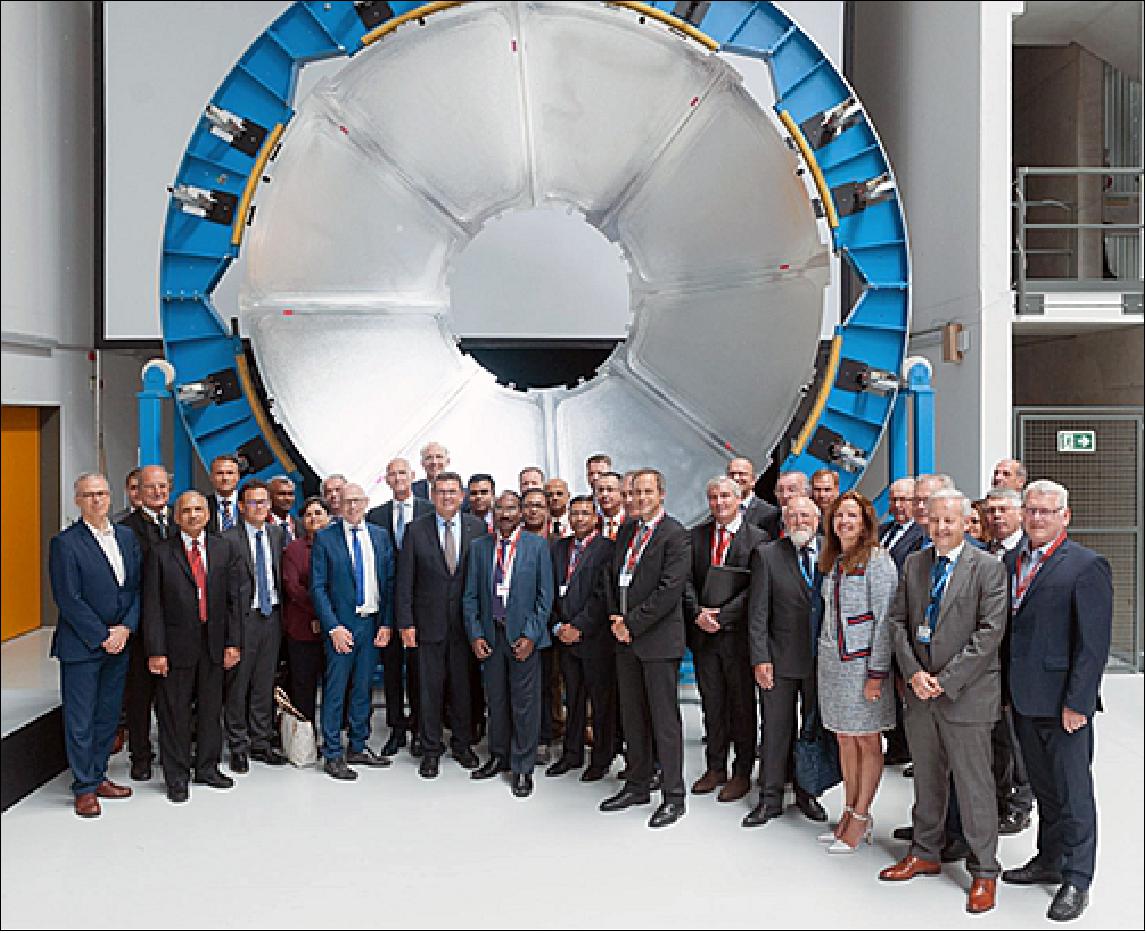
• June 15, 2018: Yesterday’s complex hot fire test of an engine technology demonstrator, was the first in a series of planned tests guiding Europe’s next-generation upper-stage rocket engine design. 103) 104)
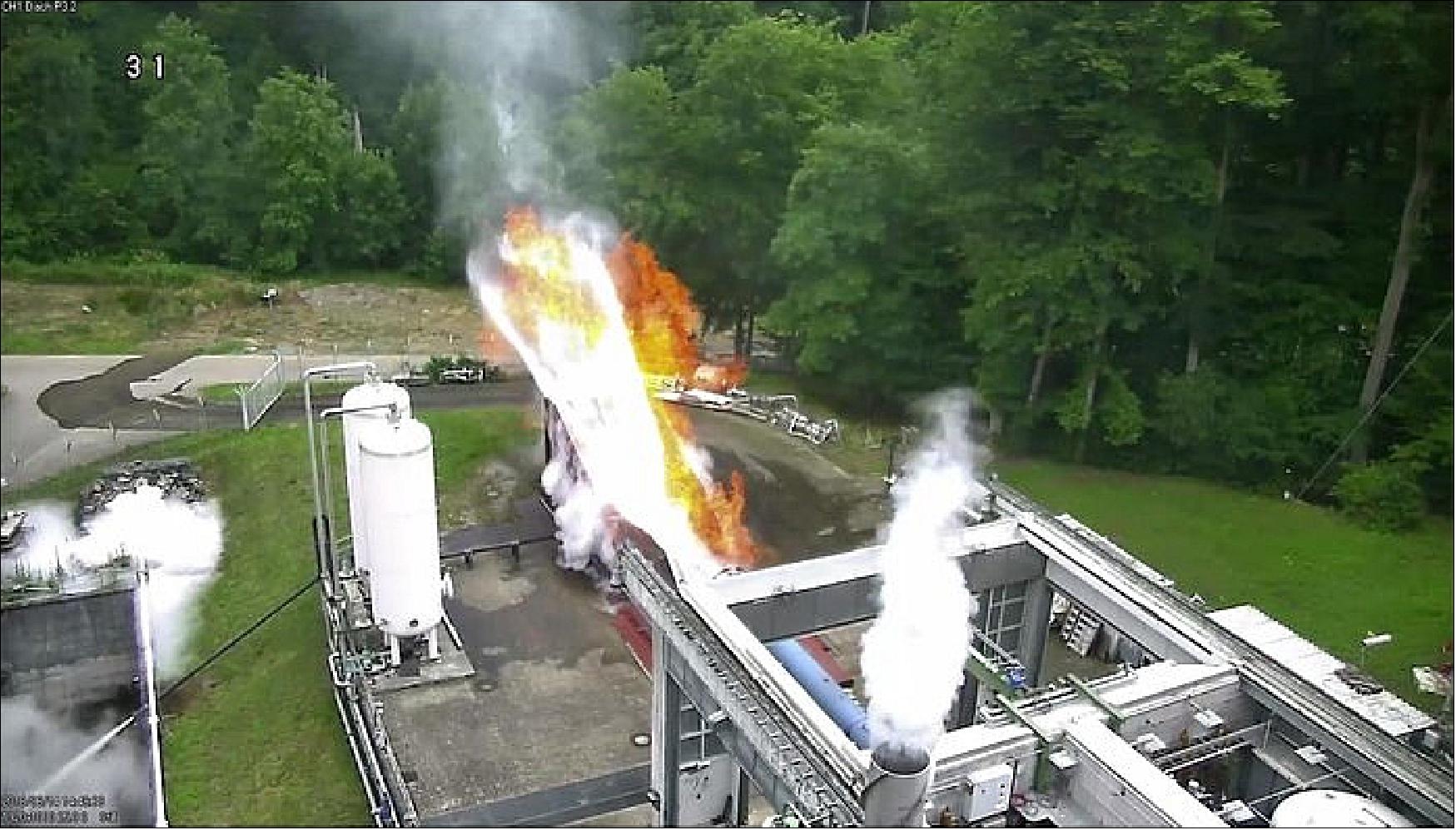
- By the end of the year, the ETID (Expander-cycle Technology Integrated Demonstrator) will be ignited 20 times with each firing lasting up to 120 seconds on a test stand that provides a near-vacuum environment similar to space.
- Engineers will use the results from the test campaign to determine the hardware characteristics, including a precise thrust measurement to determine its “specific impulse” – indicating the exact performance of the engine design. Its results also have relevance for the in-development Vinci engine, which powers the upper stage of Ariane 6.
- Led by ArianeGroup in Germany, the ETID project is part of ESA’s Future Launchers Preparatory Program.
Light Satellite Launch Opportunities Initiative
Vega, Vega-C and Ariane-6 are set to offer low-cost, standardized launch services for small satellites under 500 kg, with a first opportunity in 2019. Though small satellites are increasing their share of the space market with many valuable applications, the opportunities to reach space often fall short of meeting their mission needs. 105)
ESA’s light satellite launch opportunities initiative is investigating possible low-cost launch services based on Ariane-6, Vega and Vega-C efficiently combining payloads in the same mission and offering a standardized service to customers. The aim is to serve a wide variety of small satellites, from CubeSats to microsats and minisats, technology demonstrators to mega-constellations. While services would initially serve European institutional needs, the broader long-term objective is to reach the commercial market.
A series of proof-of-concept flights will demonstrate that Europe can provide economically sustainable access to space for light satellite missions. The first is a rideshare mission planned for early 2019 on Vega using the versatile Small Satellites Mission Service dispenser, designed to deploy multiple light satellites below 500 kg.
This will bring socioeconomic benefits to Europe, particularly in the light satellite applications business, and optimize the Ariane-6 and Vega launch capacities managed by Arianespace at Europe’s Spaceport in Kourou, French Guiana.
Activities started on 16 February 2018 with the prime contractor Arianespace, and with Arianegroup and Avio for the Ariane-6 and Vega-C launcher systems, respectively.
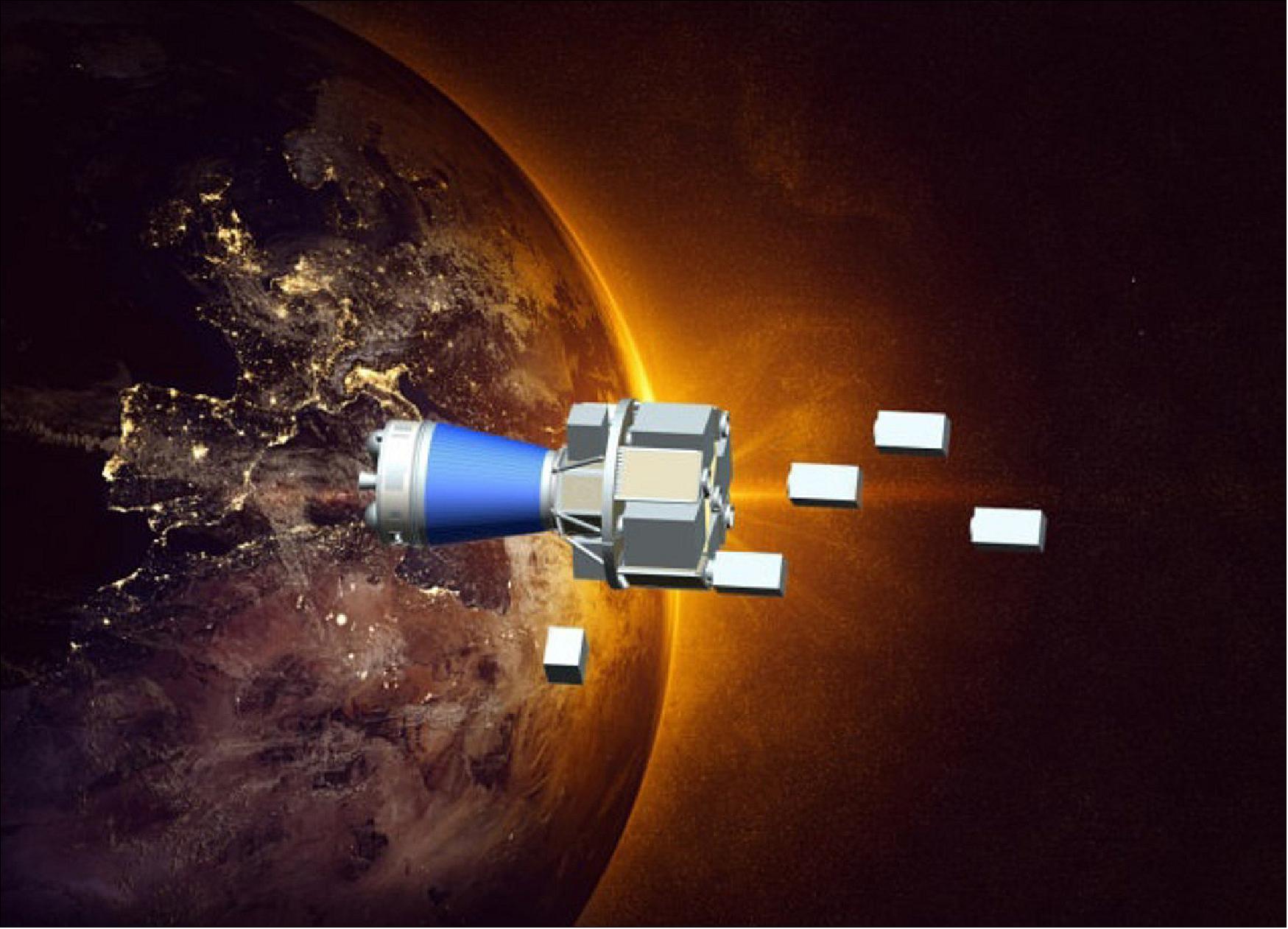
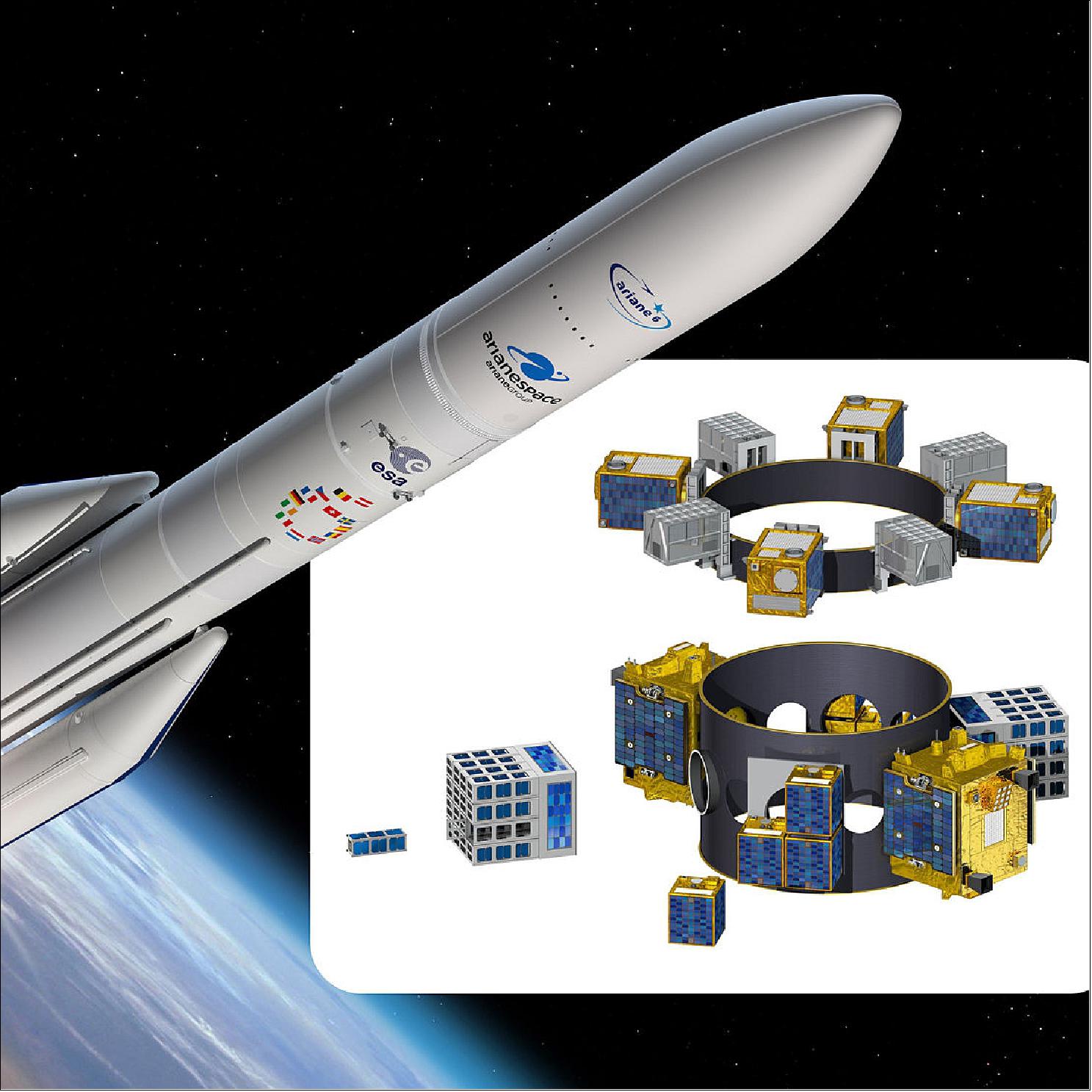
Development Status
June 4, 2019: More than 40 satellite missions will be launched at once by Europe’s Vega launcher this autumn, thanks to the innovative modular “Lego-style” dispenser resting on its upper stage. 107)
- Up until now the smallest classes of satellites – all the way down to tiny CubeSats, built from 10 cm modular boxes – have typically ‘piggybacked’ to orbit. They have to make use of any spare capacity as a single large satellite is launched, meaning their overall launch opportunities are limited.
- “The new Vega Small Spacecraft Mission Service (SSMS) switches this into a ‘ride-share’ model, with multiple small satellites being flown together, splitting the launch cost through economy class tickets,” comments Giorgio Tumino, managing ESA’s Vega development programs.
- “Our development of this new SSMS dispenser – able to group together different satellites from 1 kg to 400 kg in mass – is a response to the market for these small- and microsatellite missions, which has grown exponentially in recent years.”
- The inaugural ‘proof of concept’ flight of Vega’s SSMS dispenser will take place this September, with 41 separate passengers: seven small satellites plus 35 CubeSats in all. Included in that total are a trio of ESA CubeSats: the SIMBA mission studying Earth’s radiation budget, ozone-measuring Picasso and PhiSat, investigating the application of artificial intelligence to Earth observation.
- Giorgio adds: “Regular follow-on SSMS flights are planned for 2020 onwards, once the more powerful Vega-C launcher begins operations. This will offer an extra 700 kg of capacity and enlarged volume within a wider launcher fairing – at the same Vega launch cost as before – so we will be able to fly even more passengers per individual SSMS launch at significant lower cost per kilo.”
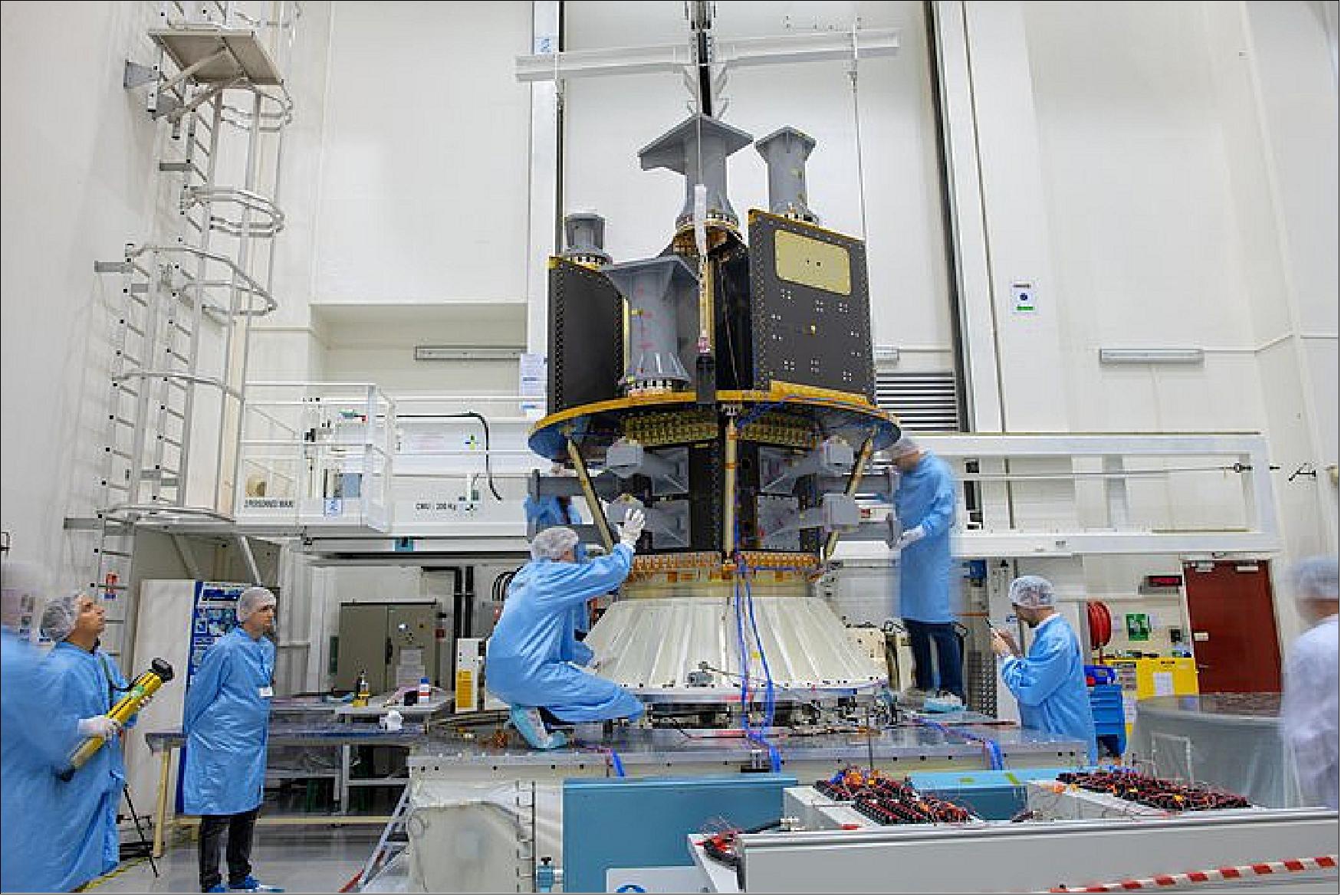
- The SSMS dispenser has been designed to be as market-responsive as possible, able to accommodate any combination of customers, from a main large satellite with smaller companions as piggy back to multiple smaller satellites, or dozens of individual CubeSats.
- “The idea of how to do this came out of an ESA study,” says Giorgio. “Basically the SSMS is composed of different modular parts, which can be put together as needed, Lego-style: a central column, tower or hexagon, a supporting platform, adjustable rods and dividers.”
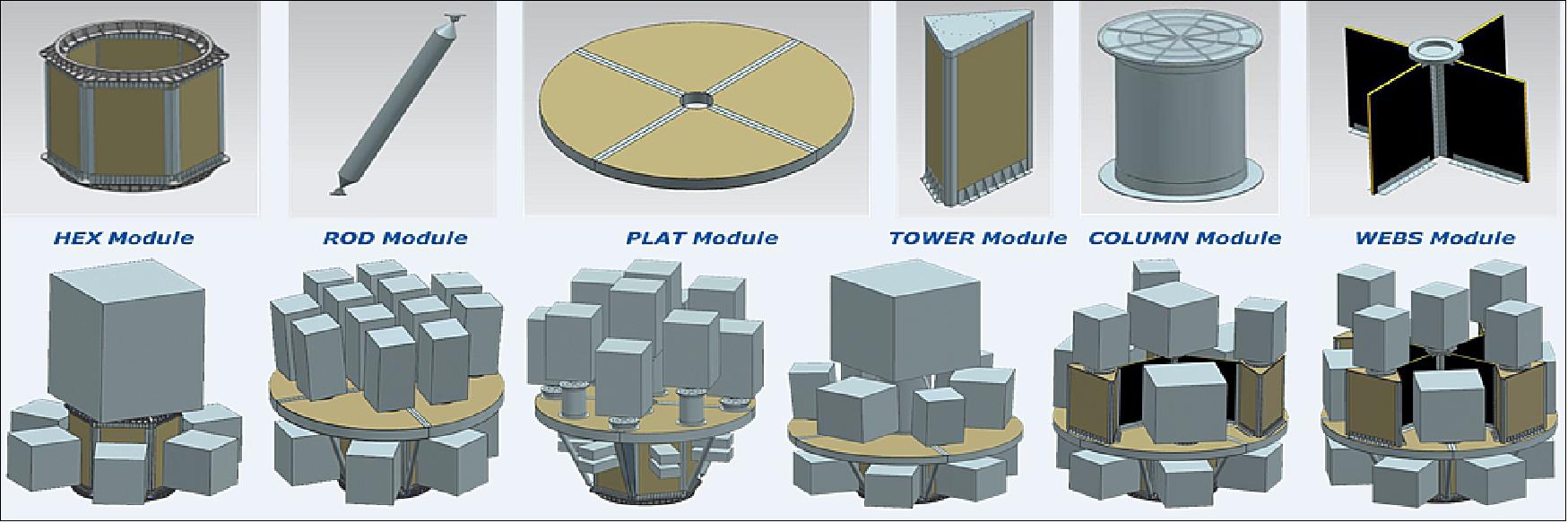
- In a first for any ESA launcher, part of the payload integration takes place in Europe, streamlining the cost and effort required by lean small satellite companies. Satellites are placed onto the lower part of the SSMS by its manufacturer, SAB Aerospace in the Czech Republic, with the top-level satellites added at Europe’s Spaceport in Kourou, French Guiana ahead of launch.
- This inaugural flight will deliver all its passengers to the same 550 km altitude ‘Sun synchronous orbit’, remaining lined up with the Sun for optimal Earth observing conditions. But in the future, Vega could deliver satellites to three separate orbits per SSMS flight.
- Once its target orbit is achieved the SSMS, controlled through the avionics systems in Vega’s AVUM (Attitude & Vernier Upper Module) upper stage, will deploy its satellites in coordinated fashion, with carefully planned delays in between each separation. In a matter of minutes they will all be pushed away smoothly using springs.
- When deployment is completed the AVUM will deorbit itself and its SSMS dispenser, fulfilling stringent international space debris regulations governing low-Earth orbit.
- The three-stage solid propellant Vega launcher with a liquid-fuelled re-ignitable AVUM upper stage has been flying since 2012. Its SSMS dispenser is only one of a range of current developments, to allow Vega to respond to the full portfolio of market needs.
- ”We aim to affordably fly everything from a 1 kg CubeSat all the way up to a 2.3 ton satellite, with still greater capacity on the way through our Vega Evolution program.
- “And as well as the SSMS for several small payloads, we have the Vespa adapter for dual medium size payloads, in addition to the baseline Vampire adapter for single large payloads. The reusable Space Rider system is also under development for payloads requiring return to Earth, as well as the Venus electric-propulsion module under definition for missions to higher orbits.”
- Adding to Vega’s competitiveness is a perfect safety record, with 14 out of 14 launches successful. “ESA, our prime contractor Avio and all our partner companies are fully committed to delivering a successful product,” says Giorgio.
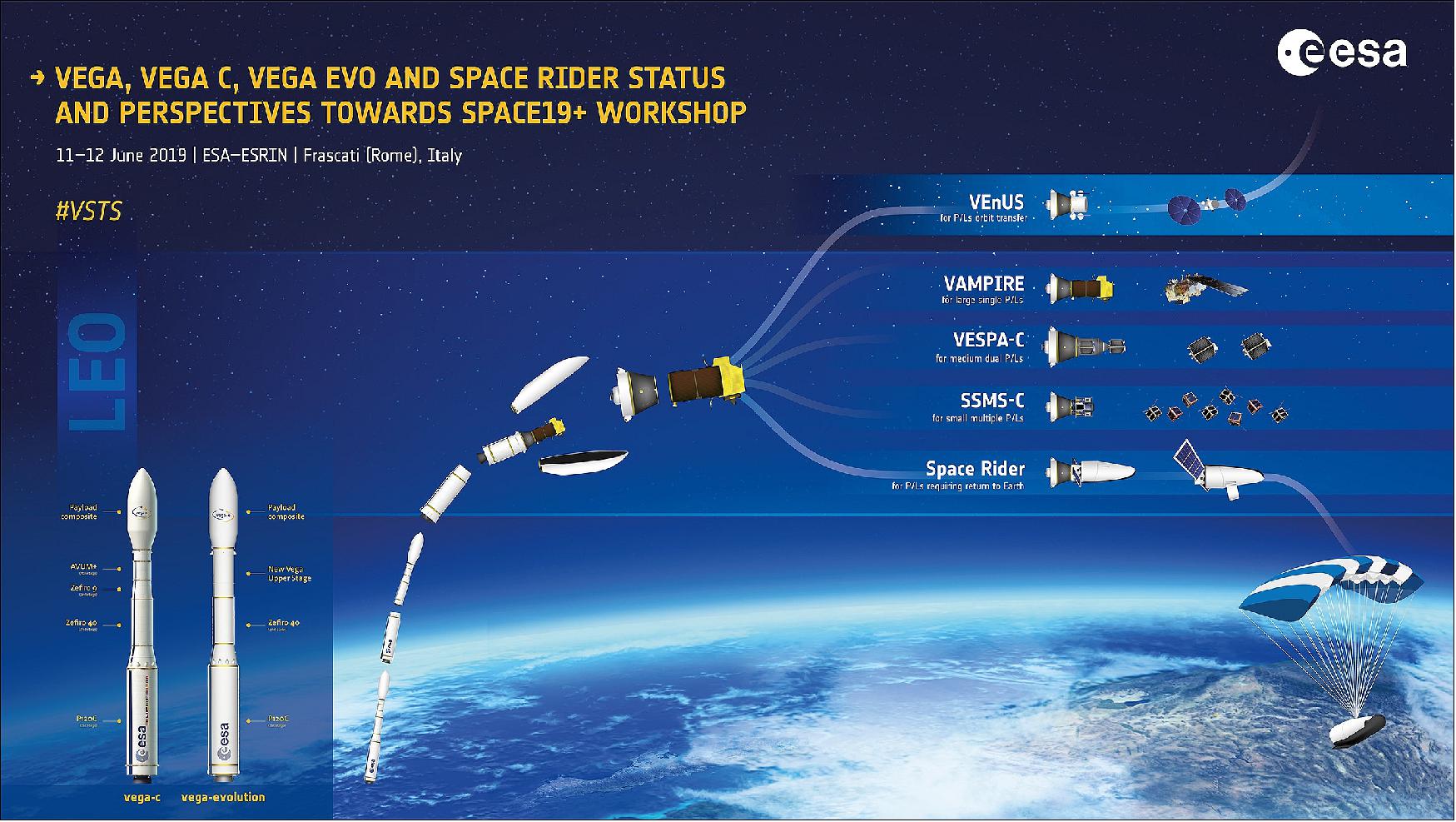
“And ESA’s core Vega Integrated Program Team at ESRIN draws expertise from wherever is available, working closely with ESA’s Directorate of Technology Quality and Engineering and Directorate of Operations, the Italian space agency ASI and the French space agency CNES. Working with all the best available competencies in Europe is a strong reason for our success to date.”
Prometheus Engine Demonstrator Program
Prometheus is an ESA program, initiated with the French space agency CNES (Centre National d’Etudes Spatiales). The contract awarded to ArianeGroup by ESA in December 2017 covers the design, construction and testing of the first two examples of the very low cost engine demonstrator, which uses liquid oxygen and methane technology and is potentially reusable. — Prometheus is a precursor of the future engines intended for use by Europe’s launchers by 2030.
A concept conceived by the ArianeGroup, entitled the Prometheus engine, has just been finalized. The Definition Review of the Prometheus engine demonstrator together with the support of the European Space Agency, CNES and DLR gave their approval on February 1, 2019. 108)
• Prometheus demonstrates the pertinence of the design and the technological choices made and confirms the program's ambitious cost objectives
• Prometheus is the European demonstrator for a very low cost and potentially reusable engine
• The bench tests of the first two examples of the engine are scheduled for as early as 2020.
The innovative technologies and industrial processes developed for this demonstrator program will also be used for the propulsion upgrades of Ariane 6. The Definition Review of the program was held from 30 November to 1 February 2019 on the ArianeGroup sites in Vernon (France) and Ottobrunn (Germany). It was carried out by ArianeGroup and ESA teams supported by experts from the French and German space agencies, CNES and DLR.
According to André-Hubert Roussel, CEO of ArianeGroup : ”This successful milestone of the Prometheus program shows that the teams at ArianeGroup and their partners were able to create an innovative design in an extremely short period of time, barely one year after contract signature with ESA. This success demonstrates the pertinence of our technological choices and confirms the ambitious cost objectives we set for ourselves. It perfectly illustrates the efficiency of the new working methods we implemented with our European partners. This step is extremely important, less than one year before Space19+, the ESA Ministerial Conference. It encouraged us to be ever more daring in terms of technological developments, organization and working methods, so that we could make the European launchers always more competitive to fulfill the missions for our institutional and commercial customers. Thank you to all the teams for this crucial success, which encourages space Europe to go still further.”
The goal of the Prometheus demonstrator is to be able to build future liquid propellant engines in the 100 tons thrust class, for a cost ten times less than that involved in building an existing engine such as the Vulcain®2.
The success of a technological challenge of this nature depends on a completely new design: over and above the change in the traditional Ariane propellant (switching from the liquid oxygen and hydrogen combination to liquid oxygen and methane), the demonstrator will entail major changes, including digitization of engine control and diagnostics. It also depends on the use of innovative design and production methods and tools, including construction using 3D printing in a connected factory environment.
The next major milestone of the program is the Manufacturing Readiness Review (MRR) to start the production of two demonstrators in the first half of 2019. Testing of those two examples is scheduled on the P5 test stand at the DLR in Lampoldshausen (Germany) in 2020.
Development Status
• May 17, 2021: ESA is forging ahead with advanced developments in two flagship space transportation demonstration projects, Prometheus and Phoebus. This will benefit Europe’s new Ariane 6 launcher in the near-term, and prepare for a new generation of European launch vehicles in the next decade. 109)
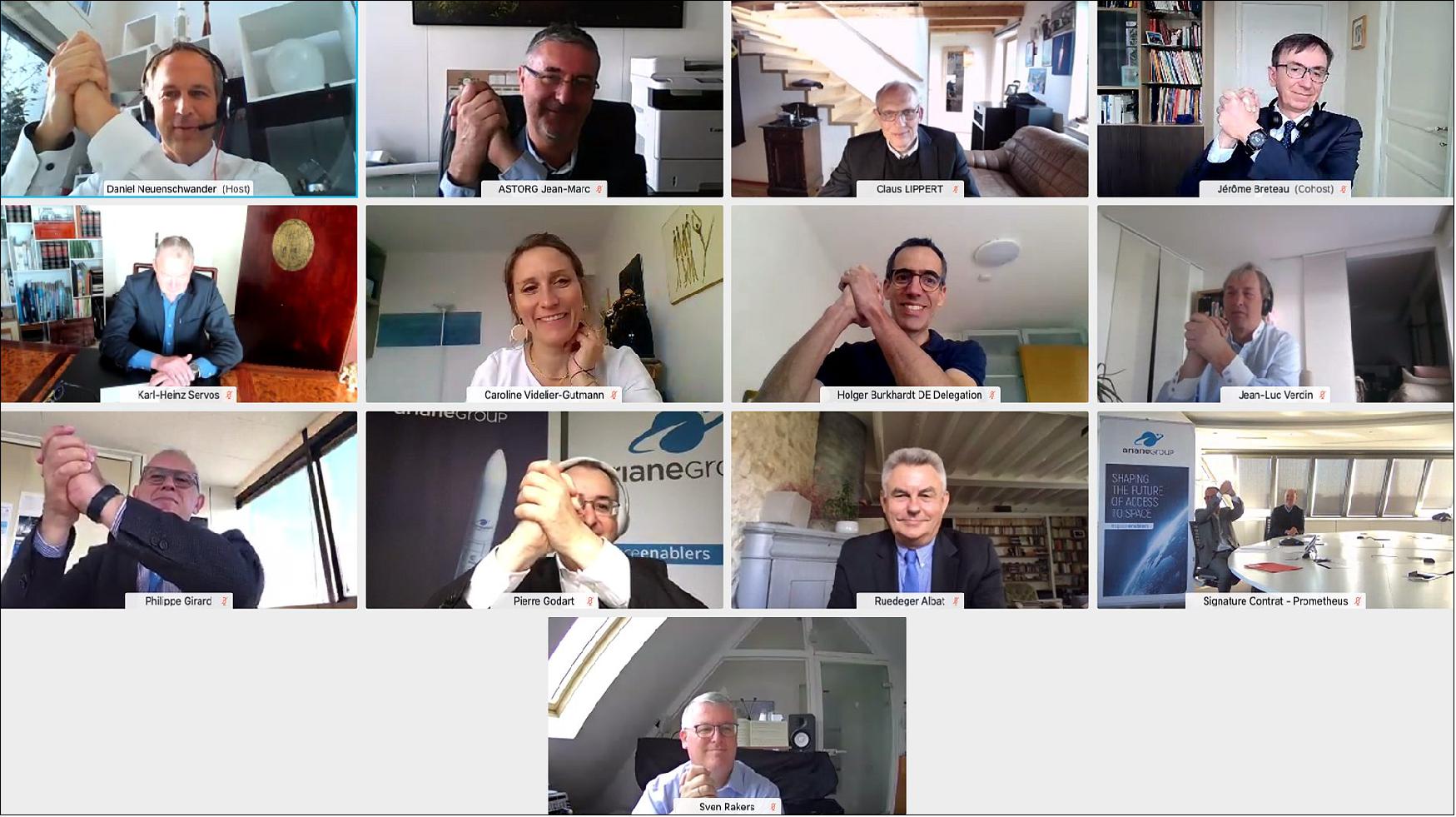
- The signing of these contacts represents an important milestone in development for both projects which will now focus on key technologies and processes defined so far in the lead up to valuable demonstrations.
- “To secure Europe’s autonomous access to space at affordable costs, ESA is engaging resolutely in the development of new technologies required for future space transportation solutions. The Prometheus reusable engine and the Phoebus upper stage are excellent examples of this,” commented Daniel Neuenschwander.
- Prometheus is an ultra-low cost reusable rocket engine demonstrator fuelled by liquid methane. It is highly versatile and therefore suitable for use on core, booster and upper stages of Europe’s future launch vehicles (see Figure 123).
- It features variable thrust, multiple ignitions, and intelligent onboard control systems for reusability. Thanks to additive layer manufacturing, which accounts for 70% of the mass of the engine, the number of parts is low and this speeds up production and reduces waste. This can achieve a tenfold reduction in costs compared with the existing Ariane 5 Vulcain 2 engine. In addition, the use of liquid methane fuel is expected to reduce the cost of ground operations before and after flight.
- To complete the current initial phase, two existing full-scale Prometheus engine demonstrators will perform static fire tests at the DLR German Aerospace Center in Lampoldshausen, Germany. Data collected from these tests will provide important insights to validate and demonstrate the engine concept. This will feed into designs to increase engine thrust from its current 1000 kN to 1200 kN.
- André-Hubert Roussel, CEO of ArianeGroup, said: “The knowledge we have acquired will enable us to develop lighter, much less expensive engines, making European launchers ever more competitive and environmentally friendly.”
- Six Prometheus engine demonstrators will be manufactured for tests. At the same time, this will prove that the engine can be manufactured at the target recurring cost.
- The project will also prepare a Prometheus concept based on liquid hydrogen fuel which will provide alternative options to methane and could be available for use on Ariane 6 as early as 2025.
- Phoebus is a highly-optimized upper stage for use on future versions of the upcoming Ariane 6 launch vehicle as well as other launchers. Phoebus could boost Ariane 6’s payload capacity to geostationary orbit by more than two metric tonnes and reduce production costs (see Figure 99).
- ArianeGroup will work with MT Aerospace to validate key technologies of Phoebus developed with support from ESA since May 2019.
- This will enable the final phase to completion with the detailed design, build and test of a near full-scale demonstrator which will consist of an oxygen propellant tank, a hydrogen propellant tank, the interface structure between the two tanks and the outside cylinder representative of the upper stage outer skin. All of these structures will be made with carbon-fibre composite. A host of additional features will make this demonstrator a representative test bed for multiple promising technologies.
- Early prototypes will de-risk the production of the full demonstrator and determine the industrialization of the process for the series production of upper stages.
- Additional technologies in the fields of materials and structures, propulsion and avionics, could use Phoebus as a ‘test bed’ opportunity to raise their technology readiness level.
- These activities are carried out within ESA’s Future Space Transportation program.
• June 4, 2020: ESA’s Prometheus is the precursor of ultra-low-cost rocket propulsion that is flexible enough to fit a fleet of new launch vehicles for any mission and will be potentially reusable. 110)
- At the Space19+ Council meeting in Seville, Spain last November, ESA received full funding to bring the current Prometheus engine design to a technical maturity suitable for industry. Developed by ArianeGroup, Prometheus is now seen as key in the effort to prepare competitive future European access to space.
- By applying a design-to-cost approach to manufacturing Prometheus, ESA aims to lower the cost of production by a factor of ten of the current main stage Ariane 5 Vulcain 2 engine.
- Features such as variable thrust, multiple ignitions, suitability for main and upper stage application, and minimized ground operations before and after flight also make Prometheus a highly flexible engine.
- This Prometheus precursor runs on liquid oxygen–methane which brings high efficiency, allows standardization and operational simplicity. Methane propellant is also widely available and easy to handle.
- In the short term it is likely that operational engines will benefit from the application of Prometheus technologies.
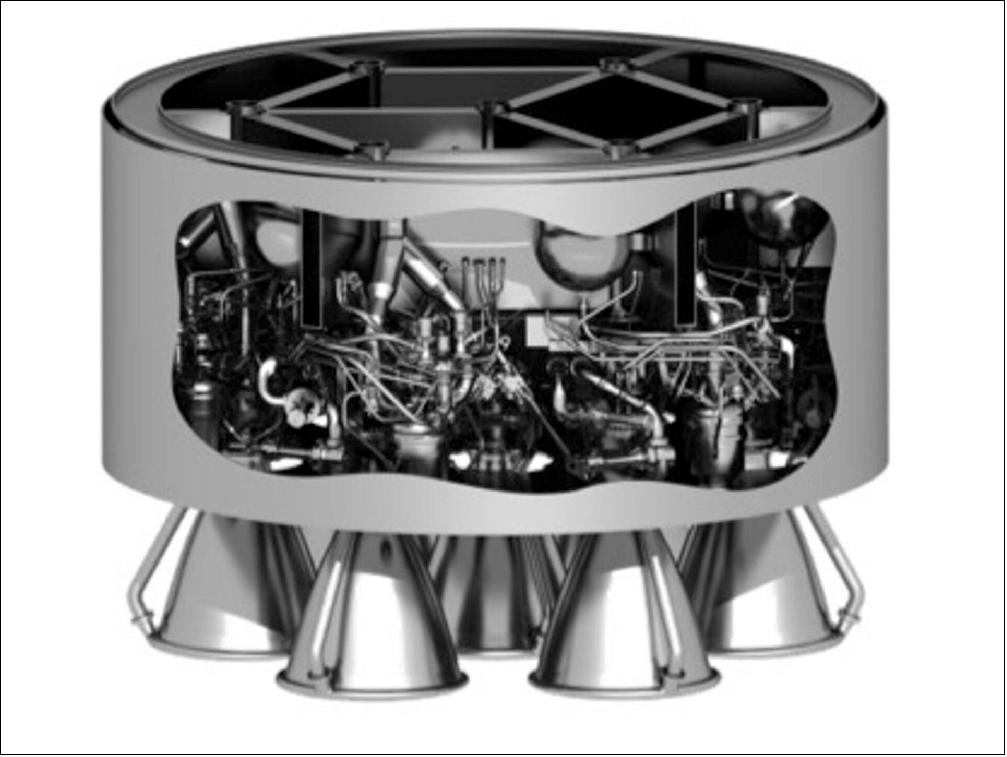
- Upcoming tests overseen by ArianeGroup at the DLR German Aerospace Center’s Lampoldshausen testing facility in Germany will validate the hardware components for the first Prometheus engine test model (M1).
- In preparation, the P5 test bench will gain a 250 m3 capacity propellant tank for methane. This will allow engineers to efficiently switch test configurations between Prometheus and Ariane 6’s Vulcain 2.1 main stage engine, also in development.
- Main subsystems are being manufactured. The first elements built last year benefited from new methods such as additive layer manufacturing (ALM) which speeds up production, achieves fewer parts and greatly reduces costs.
- ALM builds a structure layer by layer, which is much quicker and easier than the traditional process of cutting away bulk material. Complex, optimized parts, impossible to manufacture via classical methods, can be created using less material and energy, and in far fewer manufacturing steps.
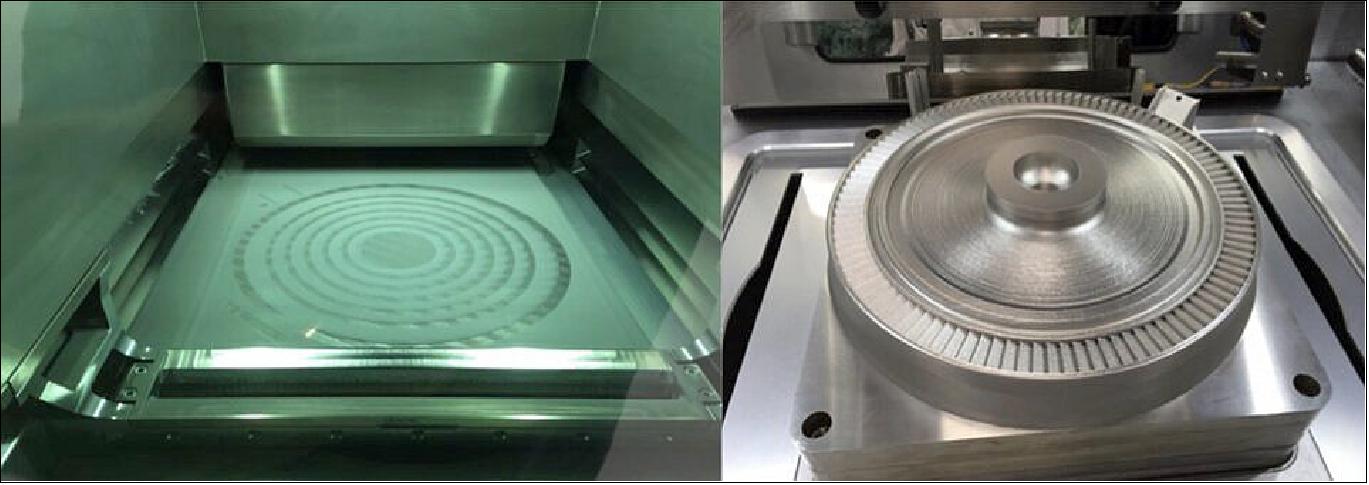
- Components manufactured and now ready to test include the turbo pump’s turbine, pump inlet and gas generator valves. March will see the delivery of the chamber valves and on-board rocket engine computer for engine management and monitoring – the part that makes this a ‘smart’ engine and potentially reusable.
- The first combustion chamber model is expected at the end of June while the combustion chamber for M1 will be delivered in December 2020.
- Engineers will assemble the M1 full-scale demonstrator at the end of this year for testing on the ground in 2021 (Figure 123).
- Further Prometheus engines will be built for testing into the future.
- Also within ESA’s Future Launchers Preparatory Program, Arianeworks is currently preparing an in-flight reusable vehicle demonstration called Themis, which will incorporate the Prometheus precursor engine.
- Prometheus represents a breakthrough in terms of cost and manufacturing and its robust design is the baseline for future evolutions of Ariane to 2030.
• February 21, 2019: ArianeGroup CEO André-Hubert Roussel and CNES President Jean-Yves Le Gall signed a memorandum of understanding (MoU) in Paris to create an acceleration platform dedicated to the preparation of future launchers. To be called ArianeWorks, the new platform will boost innovation for future launcher development by bringing teams together under one roof and connecting them to Europe’s space ecosystem. 111)
- Both longstanding stakeholders in the Ariane series, ArianeGroup and CNES are currently developing Ariane 6 for ESA. Since 2015, they have been working together to conceive the Prometheus rocket engine, prior to ESA’s successful tabling of the related program at its 2016 Ministerial Conference. Prometheus is currently under development, with the first prototype due to be tested in two years. CNES and ArianeGroup are also working together on the development of Callisto—a reusable first stage demonstrator—alongside DLR and JAXA.
- With a view to boosting future launcher preparation, CNES and ArianeGroup have opted for a step change by creating a new kind of partnership where teams work together in a highly flexible environment, open to new players and internationally, with the key goal of accelerating the Ariane Next roadmap and in particular its first phase, the Themis demonstrator. ArianeWorks is being created in the lead up to the 2019 Ministerial Conference and its results will be made available to ESA.
- In this era of NewSpace and in the context of fierce competition, ArianeWorks will accelerate innovation at grassroots level, in favor of mid-tier firms and start-ups, with commitment to reducing costs a major priority. The goal is to work together closely through this first phase up to April 2020 by inspiring and involving new players, not least pioneering start-ups, laboratories, SMEs and manufacturers. ArianeWorks will also act as a pathfinder, able to accurately assess the technological context in order to make the right choices within the shortest timescales. This calls for an approach resolutely geared towards open innovation, to encourage the exchange of expertise and spawn a ground-breaking new ecosystem.
- André-Hubert Roussel added: “ArianeWorks aims to accelerate the innovation process, in order to prepare for future developments of Ariane by involving new players and attracting new types of funding. It also gives us an opportunity to support the emergence of deep tech through access to dedicated funding, while accepting the risks involved in terms of investment and technological development.”
- CNES President Jean-Yves Le Gall said: “Ariane is one of Europe’s greatest technological, industrial and commercial success stories, and we must pursue that success in the face of strong international competition. The role of ArianeWorks is to prepare, at French level, the proposals for future launchers to be presented at Europe’s next Ministerial Conference. These include, in particular, the roadmap for Ariane Next and for its first phase, the Themis demonstrator.”
• December 14, 2017: An ultra-low cost reusable rocket engine, Prometheus, using liquid oxygen–methane propellants, is set to power Europe’s future launchers. 112)
- Today, ESA and ArianeGroup signed a contract to develop a full-scale demonstrator to be ground tested in November 2020.
- Prometheus demonstrates the systematic application of an extreme design-to-cost approach, new propellant and innovative manufacturing technologies.
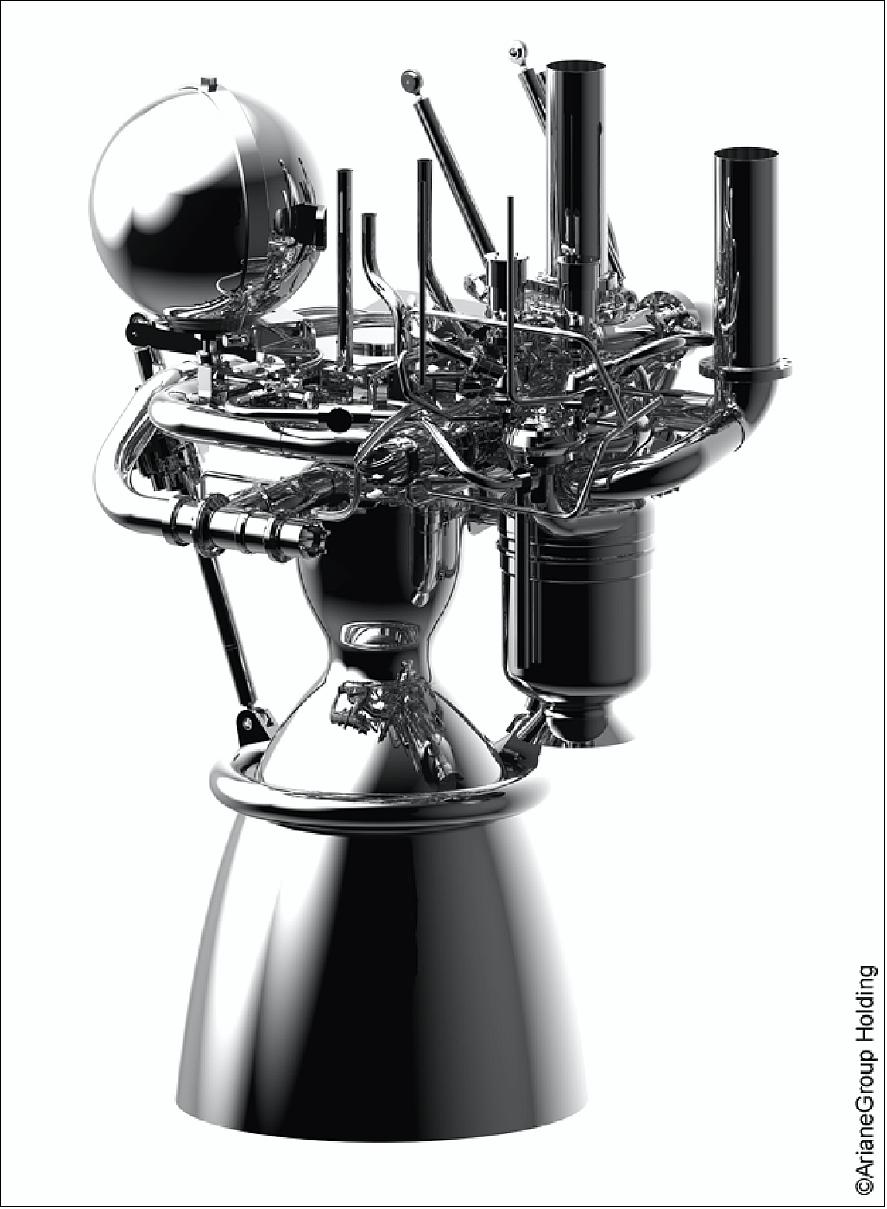
- It lowers costs to a tenth of those for Ariane 5’s Vulcain 2 engine.
- Additive layer-by-layer manufacturing of engine parts enables faster production, with fewer parts.
- Key characteristics of Prometheus include a computer system enabling realtime adjustment and immediate diagnosis for potential reusability.
- Methane propellant is widely available and brings high efficiency, standardization and operational simplicity, making it a perfect candidate for a reusable booster engine demonstration.
- By 2020, technical knowledge of liquid oxygen–methane propulsion gained through the Prometheus project will allow fast and informed decisions to be made on useful applications.
- Prometheus provides a nominal 1 MN of variable thrust, is suitable for first- and second-stage applications, and is reignitable. It will propel a range of next-generation launchers, including future evolutions of Ariane 6.
- The Prometheus contract, worth €75 million, was signed by ESA Director of Space Transportation, Daniel Neuenschwander, and Alain Charmeau, CEO at ArianeGroup, at ESA headquarters in Paris in the presence of ESA Director General Jan Wörner.
- The project is part of ESA’s Future Launchers Preparatory Program
- “Prometheus will power Europe's future launchers, forging a path of continuous improvement in competitiveness,” commented Alain Neuenschwander.
- The project benefits from significant synergies with other launcher demonstration projects within ESA, national agencies and industry.
References
1) Space Transportation strategy,” ESA, ESA, 10 October 2017, URL: https://www.esa.int/Our_Activities/Space_Transportation/Space_Transportation_strategy
2) ”Ariane 6,” ESA, 12 July 2017, URL: http://m.esa.int/Our_Activities/Space_Transportation/Launch_vehicles/Ariane_6
3) ”Ariane 6 — The next-generation launch vehicle,” Arianespace, URL: http://www.arianespace.com/ariane-6/
4) ”Ariane 6: Coming in 2020,” ArianeGroup, URL: https://www.ariane.group/en/commercial-launch-services/ariane-6/
5) ”Vega-C successfully completes inaugural flight,” ESA Enabling & Support, 13 July 2022, URL: https://www.esa.int/Enabling_Support/Space_Transportation/Vega/Vega-C_successfully_completes_inaugural_flight
6) ”Ariane 6 central core transferred to mobile gantry,” ESA Enabling & Support, 12 July 2022, URL: https://www.esa.int/Enabling_Support/Space_Transportation/Ariane/Ariane_6_central_core_transferred_to_mobile_gantry
7) ”Vega C PAC rollout, VV21,” ESA Enabling & Support, 8 July 2022, URL: https://www.esa.int/About_Us/Week_in_images/Week_in_images_04-08_July_2022
8) ”ESA pursues a shared European vision for the future of space transportation,” ESA Enabling & Support, 16 June 2022, URL: https://www.esa.int/Enabling_Support/Space_Transportation/ESA_pursues_a_shared_European_vision_for_the_future_of_space_transportation
9) ”Vega-C set for inaugural launch,” ESA Enabling & Support, 16 June 2022, URL: https://www.esa.int/Enabling_Support/Space_Transportation/Vega/Vega-C_set_for_inaugural_launch
10) ”Vega-C: Launcher integration begins for inaugural flight VV21,” ESA Enabling & Support, 26 April 2022, URL: https://www.esa.int/Enabling_Support/Space_Transportation/Vega/Vega-C_Launcher_integration_begins_for_inaugural_flight_VV21
11) ”Arianespace signs unprecedented contract with Amazon for 18 Ariane 6 launches to deploy Project Kuiper constellation,” Arianespace Press Release, 5 April 2022, URL: https://www.arianespace.com/press-release/arianespace-signs-unprecedented-contract-with-amazon-for-18-ariane-6-launches-to-deploy-project-kuiper-constellation/
14) ”ESA selects payloads for Ariane 6 first flight,” ESA Enabling & Support, 11 February 2022, URL: https://www.esa.int/Enabling_Support/Space_Transportation/Ariane/ESA_selects_payloads_for_Ariane_6_first_flight
15) ”ESA’s Vega rocket marks ten years with countdown to more powerful successor,” ESA Enabling & Support, 11 February 2022, URL: https://www.esa.int/Enabling_Support/Space_Transportation/Vega/ESA_s_Vega_rocket_marks_ten_years_with_countdown_to_more_powerful_successor
16) ”Ariane 6 central core set for assembly,” ESA Enabling & Support, 28 January 2022, URL: https://www.esa.int/Enabling_Support/Space_Transportation/Ariane/Ariane_6_central_core_set_for_assembly
17) ”Ariane 6 upper stage readies for tests at Europe's Spaceport,” ESA Enabling & Support, 21 January 2022, URL: https://www.esa.int/Enabling_Support/Space_Transportation/Ariane/Ariane_6_upper_stage_readies_for_tests_at_Europe_s_Spaceport
18) ”Ariane 6 central core reaches Europe’s Spaceport,” ESA Enabling & Support, 18 January 2022, URL: https://www.esa.int/Enabling_Support/Space_Transportation/Ariane/Ariane_6_central_core_reaches_Europe_s_Spaceport
19) ”Ariane 6 launch complex – December 2021,” ESA Enabling & Support, 7 January 2022, URL: https://www.esa.int/ESA_Multimedia/Videos/2022/01/Ariane_6_launch_complex_December_2021
20) ”ESA contract to advance Vega-C competitiveness,” ESA Enabling & Support, 16 December 2021, URL: https://www.esa.int/Enabling_Support/Space_Transportation/Vega/ESA_contract_to_advance_Vega-C_competitiveness
21) ”Test tanks fuelled for ESA’s Themis reusable first stage,” ESA Enabling & Support, 1 December 2021, URL: https://www.esa.int/Enabling_Support/Space_Transportation/Future_space_transportation/Test_tanks_fuelled_for_ESA_s_Themis_reusable_first_stage
22) ”Last call: fly your payload on first Ariane 6 launch,” ESA Enabling & Support, 05 November 2021, URL: https://www.esa.int/Enabling_Support/Space_Transportation/Ariane/Last_call_fly_your_payload_on_first_Ariane_6_launch
23) ”Ariane 6 mast gains cryogenic arms,” ESA Enabling & Support, 13 October 2021, URL: https://www.esa.int/About_Us/Week_in_images/Week_in_images_11_-_15_October_2021
24) ”Ariane 6 launch complex inaugurated at Europe’s Spaceport,” ESA Enabling & Support, 28 September 2021, URL: https://www.esa.int/Enabling_Support/Space_Transportation/Europe_s_Spaceport/Ariane_6_launch_complex_inaugurated_at_Europe_s_Spaceport
25) ”ESA Council agrees resolution on Ariane 6 and Vega-C exploitation and future space transportation,” ESA Enabling & Support, 3 September 2021, URL: https://www.esa.int/Enabling_Support/Space_Transportation/ESA_Council_agrees_resolution_on_Ariane_6_and_Vega-C_exploitation_and_future_space_transportation
26) ”Rocket tanks of carbon fibre reinforced plastic proven possible,” ESA Enabling & Support, 28 July 2021, URL: https://www.esa.int/Enabling_Support/Space_Transportation/Rocket_tanks_of_carbon_fibre_reinforced_plastic_proven_possible
27) ”ESA advances Vega rocket evolution beyond 2025,” ESA Enabling & Support, 21 July 2021, URL: https://www.esa.int/Enabling_Support/Space_Transportation/Vega/ESA_advances_Vega_rocket_evolution_beyond_2025
28) ”Ariane 6 targets new missions with Astris kick stage,” ESA Enabling & Support, 13 July 2021, URL: https://www.esa.int/Enabling_Support/Space_Transportation/Ariane/Ariane_6_targets_new_missions_with_Astris_kick_stage
29) First Ariane 6 fairing at Europe’s Spaceport,” ESA Enabling & Support, 06 May 2021, URL: https://www.esa.int/ESA_Multimedia/Images/2021/05/First_Ariane_6_fairing_at_Europe_s_Spaceport2
30) ”Vega-C: power and versatility,” ESA Enabling & Support, 03 May 2021, URL: https://www.esa.int/ESA_Multimedia/Videos/2021/04/Vega-C_power_and_versatility2
31) ”Early combined tests mimic Ariane 6 liftoff,” ESA Enabling & Support, 6 April 2021, URL: https://www.esa.int/Enabling_Support/Space_Transportation/Early_combined_tests_mimic_Ariane_6_liftoff
32) ”Arianespace signs long-term supply agreement with Avio for 10 additional Vega C launchers,” Arianespace, 19 March 2021, URL: https://www.arianespace.com/press-release/arianespace-signs-long-term-supply-agreement-with-avio-for-10-additional-vega-c-launchers/
33) ”Ariane 6 upper stage heads for hot-firing tests,” ESA Enabling & Support, 29 January, 2021, URL: https://www.esa.int/Enabling_Support/Space_Transportation/Ariane/Ariane_6_upper_stage_heads_for_hot-firing_tests
34) ”Ariane 6 launch complex – December 2020,” ESA Enabling & Support, 12 January 2021: https://www.esa.int/ESA_Multimedia/Videos/2021/01/Ariane_6_launch_complex_December_2020
35) ”ESA and CNES choose renewable energy to power Europe’s Spaceport,” ESA Enabling & Support, 6 November 2020, URL: https://www.esa.int/Enabling_Support/Space_Transportation/ESA_and_CNES_choose_renewable_energy_to_power_Europe_s_Spaceport
36) ”ESA lays out roadmap to Vega-C and Ariane 6 flights,” ESA Enabling & Support, 29 October 2020, URL: https://www.esa.int/Enabling_Support/Space_Transportation/ESA_lays_out_roadmap_to_Vega-C_and_Ariane_6_flights
37) ”All solid motors for Vega-C complete qualification tests,” ESA Enabling & Support, 23 October 2020, URL: https://www.esa.int/Enabling_Support/Space_Transportation/Vega/All_solid_motors_for_Vega-C_complete_qualification_tests
38) ”All engines for Ariane 6 complete qualification tests,” ESA Enabling & Support, 15 October 2020, URL: https://www.esa.int/Enabling_Support/Space_Transportation/Ariane/All_engines_for_Ariane_6_complete_qualification_tests
39) ”P120C motor configured for Ariane 6 is test fired,” ESA Enabling & Support, 8 October 2020, URL: https://www.esa.int/ESA_Multimedia/Videos/2020/10/P120C_motor_configured_for_Ariane_6_is_test_fired
40) ”Europe's Spaceport, back to business,” ESA Enabling & Support, 29 May 2020, URL: http://www.esa.int/ESA_Multimedia/Videos/2020/05/Europe_s_Spaceport_back_to_business
41) ”Vega's top tank,” ESA Enabling & Support, 4 March 2020, URL: http://www.esa.int/ESA_Multimedia/Images/2020/03/Vega_s_top_tank
42) ”Ariane 6 launch zone at Europe's Spaceport,” ESA Enabling & Support, 4 February 2020, URL: http://www.esa.int/ESA_Multimedia/Images/2020/02/Ariane_6_launch_zone_at_Europe_s_Spaceport
43) ”Ariane 6 launch complex - January 2020,” ESA Enabling & Support, 28 January, 2020, URL: http://www.esa.int/ESA_Multimedia/Videos/2020/01/Ariane_6_launch_complex_-_January_2020
44) ”40 years of Ariane,” ESA / Enabling & Support / Space Transportation, 19 December 2019, URL: http://www.esa.int/Enabling_Support/Space_Transportation/40_years_of_Ariane
45) ”Vega-C fairing’s trial by sound,” ESA Enabling & Support, 26 November 2019, URL: http://www.esa.int/ESA_Multimedia/Images/2019/11/Vega-C_fairing_s_trial_by_sound
46) ”Ariane 6 parts come together, Europe’s Spaceport prepares,” ESA / Enabling & Support / Space Transportation, 26 November 2019, URL: http://www.esa.int/Enabling_Support/Space_Transportation/Ariane_6_parts_come_together_Europe_s_Spaceport_prepares
47) ”Signed protocols on exploitation of Ariane 6 and Vega-C,” ESA / Enabling & Support / Space Transportation, 20 November 2019, URL: http://www.esa.int/Enabling_Support/Space_Transportation/Signed_protocols_on_exploitation_of_Ariane_6_and_Vega-C
48) ”New rocket fairing design offers smoother quieter ride,” ESA, 22 October 2019, URL: http://www.esa.int/Enabling_Support/Space_Transportation/New_rocket_fairing_design_offers_smoother_quieter_ride
49) ”Ariane 6’s core engine completes qualification tests,” ESA, 27 September 2019, URL: http://www.esa.int/Our_Activities/Space_Transportation/Ariane_6_s_core_engine_completes_qualification_tests
50) ”First roll-out of Ariane 6 mobile gantry,” ESA, 29 July 2019, URL: http://www.esa.int/Our_Activities/Space_Transportation/First_rollout_of_Ariane_6_mobile_gantry
51) ”Ariane6 Vulcain engine: successful qualification testing,” ArianeGroup Press Release, 18 July 2019, URL: https://www.ariane.group/wp-content/uploads/2019/08/Vulcain-2-1-End-tests-qualification.pdf
52) ”Réaltra Space wins contract to monitor Ariane 6 launches,” ESA, 27 June 2019, URL: http://www.esa.int/ESA_in_your_country/Ireland/Realtra_Space_wins_contract_to_monitor_Ariane_6_launches
53) ”ESA fosters early involvement in Vega and Space Rider,” ESA space transportation, 20 June 2019, URL: http://www.esa.int/Our_Activities/Space_Transportation/ESA_fosters_early_involvement_in_Vega_and_Space_Rider
54) ”CSG - ELA-4 construction site for Ariane 6,” ESA, Our week through the lens, 3-7 June 2019, URL: http://www.esa.int/Highlights/Week_In_Images_3_7_June_2019
55) ”Ariane 6 and Vega C - a new generation of European Launch Vehicles,” ESA, 6 June 2019, URL: http://www.esa.int/spaceinvideos/Videos/2019/06/Ariane_6_and_Vega_C_-_a_new_generation_of_European_Launch_Vehicles
56) ”Ariane 6 tank for the core stage,” ESA, Our week through the lens: 3 - 7 June 2019, URL: http://www.esa.int/Highlights/Week_In_Images_3_7_June_2019
57) ”First half-shell of Ariane 6 fairing,” ESA, Our week through the lens: 3 - 7 June 2019, URL: http://www.esa.int/Highlights/Week_In_Images_3_7_June_2019
58) ”Ariane 6 series production begins with first batch of 14 launchers,” Arianespace, 6 May 2019, URL: http://www.arianespace.com/press-release/ariane-6-series-production-begins-with-first-batch-of-14-launchers/
59) ”Europe’s institutions consider Ariane 6 and Vega-C,” ESA, 9 April 2019, URL: http://m.esa.int/Our_Activities/Space_Transportation/Europe_s_institutions_consider_Ariane_6_and_Vega-C
60) Arianespace, 19 March 2019, URL: http://www.arianespace.com/press-release/ariane-6-maiden-flight-will-deploy-satellites-of-the-oneweb-constellation-oneweb-also-books-options-with-arianespace-for-two-more-ariane-6-launches/
61) ”Vega-C enters qualification phase for maiden flight,” ESA, 11 March 2019, URL: http://m.esa.int/Our_Activities/Space_Transportation/Vega-C_enters_qualification_phase_for_maiden_flight
62) ”Vega-C’s first stage P120C motor achieves final milestone test,” ESA, 29 January 2019, URL: http://m.esa.int/Our_Activities/Space_Transportation/Vega-C_s_first_stage_P120C_motor_achieves_final_milestone_test
63) ”ESA Council decides on the completion of Ariane 6 and endorses start of transition from Ariane 5 to Ariane 6,” 14 June 2018, URL: http://m.esa.int/Our_Activities/Space_Transportation/ESA_Council_decides_on_the_completion_of_Ariane_6_and_endorses_start_of_transition_from_Ariane_5_to_Ariane_6
64) ”140 successful tests and several “firsts” for Vinci, the engine for Ariane 6,” Arianegroup, 15 Feb. 2018, URL: https://www.safran-group.com/media/140-successful-tests-and-several-firsts-vinci-engine-ariane-6-20180215
65) ”P120C full-scale model is set to horizontal,” ESA, 2 Feb. 2018, URL: http://m.esa.int/spaceinimages/Images/2018/02/P120C_full-scale_model_is_set_to_horizontal
66) ”First hot firing of Ariane 6’s Vulcain engine,” ESA, 23 Jan. 2018, URL: http://m.esa.int/Our_Activities/Space_Transportation/First_hot_firing_of_Ariane_6_s_Vulcain_engine
67) ”Vulcain 2.1 hot firing,” ESA, 8 Jan. 2018, URL: http://m.esa.int/spaceinimages/Images/2018/01/Vulcain_2.1_hot_firing
68) ”ESA Euronews: Ariane 6,” ESA, 15 Dec. 2017, URL: http://m.esa.int/spaceinvideos/Videos/2017/12/ESA_Euronews_Ariane_6
69) ”First Ariane 6 contract: Arianespace to orbit four Galileo satellites on two Ariane 62 launches,” Arianespace, 14 Sept. 2017, URL: http://www.arianespace.com/press-release/first-ariane-6-contract-arianespace-to-orbit-four-galileo-satellites-on-two-ariane-62-launches/
70) ”Airbus Safran Launchers to Become ArianeGroup,” ASL, 17 May, 2017, URL: https://www.ariane.group/wp-content/uploads/2017/05/New-name-_EN.pdf
71) ”Ariane 6 on track,” ESA, 9 Nov. 2016, URL: http://m.esa.int/Our_Activities/Space_Transportation/Ariane_6_on_track
72) Emmanuelle David, Sonia Lemercier, Benoit Pouffary, Pier Domenico Resta, Pierre Guilhem, Laurent Le Querrec, Stephane Haessler, ”Elaboration of Ariane 6 operational concept with a concurrent engineering approach,” 67th IAC (International Astronautical Congress), Guadalajara, Mexico, 26-30 September 2016, paper: IAC-16-D2.2, URL: http://elib.dlr.de/107548/1/IAC-16%2CD2%2C2%2C5%2Cx35323.pdf
73) ”Ariane 6 and Vega C begin development,” ESA, 12 Aug. 2015, URL: http://m.esa.int/Our_Activities/Space_Transportation/Ariane_6_and_Vega_C_begin_development
74) ”ESA, Airbus Safran Discuss Ariane 6,” Aviation Week, 15 June 2015, URL: http://aviationweek.com/paris-air-show-2015/esa-airbus-safran-discuss-ariane-6
75) ”Successful conclusion of ESA Council at Ministerial level,” ESA, 2 Dec. 2014, URL: http://m.esa.int/About_Us/Jean-Jacques_Dordain/Successful_conclusion_of_ESA_Council_at_Ministerial_level
76) Mathieu Chaize, Guillaume Collange, Stefan Haessler, Gilles Debas, ”Ariane 6 Industrialization Concept and Status,” Proceedings of the 68th IAC (International Astronautical Congress), Adelaide, Australia, 25-29 Sept. 2017, paper: IAC-17-D2.1.2
77) ”Comms System at Europe's Spaceport in French Guiana to be Extended by the Space Alliance,” Satnews Daily, 26 April 2018, URL: http://www.satnews.com/story.php?number=1578090648
78) ”ESA proves new technologies to power future launchers,” ESA, 22 March, 2018, URL: http://m.esa.int/Our_Activities/Space_Transportation/ESA_proves_new_technologies_to_power_future_launchers
79) ”Tests start on 3D-printed thrust chamber,” ESA Enabling & Support, 28 May 2020, URL: http://www.esa.int/ESA_Multimedia/Images/2020/05/Tests_start_on_3D-printed_thrust_chamber
80) ”3D-printed thrust chamber passes first tests for Vega evolutions,” ESA Enabling & Support, 3 March 2020, URL: http://www.esa.int/Enabling_Support/Space_Transportation/3D-printed_thrust_chamber_passes_first_tests_for_Vega_evolutions
81) ”Cost-efficient manufacturing for rocket cylinders,” ESA, space transportation, 24 June 2019, URL: http://www.esa.int/Our_Activities/Space_Transportation/Cost-efficient_manufacturing_for_rocket_cylinders
82) ”Metal 3D-printed Ariane 5 bracket,” ESA, 19 June 2019, URL: http://www.esa.int/spaceinimages/Images/2019/06/Metal_3D-printed_Ariane_5_bracket
83) ”Technology Readiness Levels,” ESA, June 2, 2019, URL: http://www.esa.int/spaceinimages/Images/2019/06/Technology_Readiness_Levels
84) Time for answers: Future space transportation, ESA, 7 June 2019, URL: http://www.esa.int/spaceinvideos/Videos/2019/06/Time_for_answers_Future_space_transportation
85) ”‘Intelligent’ thrust for Europe’s future launchers,” ESA, 29 May 2019, URL: http://www.esa.int/Our_Activities/Space_Transportation/Intelligent_thrust_for_Europe_s_future_launchers
86) ”Contracts signed for prototype of a highly-optimized black upper stage,” ESA, 14 May 2019, URL: http://www.esa.int/Our_Activities/Space_Transportation/Contracts_signed_for_prototype_of_a_highly-optimised_black_upper_stage
87) ”New test facility for Ariane 6 upper stage,” ESA, 26 February 2019, URL: http://m.esa.int/Our_Activities/Space_Transportation/New_test_facility_for_Ariane_6_upper_stage
88) ”3D-printed storable-propellant rocket engine design tested,” ESA Space Transportation, 21 February 2019, URL: http://m.esa.int/Our_Activities/Space_Transportation/3D-printed_storable-propellant_rocket_engine_design_tested
89) ”Ariane 6 future launch site,” ESA, 11 January 2019, URL: https://www.esa.int/spaceinimages/Images/2019/01/Ariane_6_future_launch_site
90) ”Ariane 6 on the way to flight,” ESA, 6 December 2018, URL: http://m.esa.int/Our_Activities/Space_Transportation/Ariane_6_on_the_way_to_flight
91) Stefano Bianchi, Pier Domenico Resta, Guy Pilchen, Didier Coulon, Julio Monreal, Jean-Michel Rizzi, Michel Bonnet, Julio Aprea, Linn Boldt-Christmas, ”The Development Status of the Ariane 6 Launch System,” Proceedings of the 69th IAC (International Astronautical Congress) Bremen, Germany, 1-5 October 2018, paper: IAC-18-D2.1.1, URL: https://esamultimedia.esa.int/docs/STS/IAC-18,D2,1,1,x48586.pdf
92) Mathieu Chaize, Guillaume Collange, Sirgfried Chavy, Gilles Debas, Patrick Bonguet, ”Ariane6 launcher system development status,” Proceedings of the 69th IAC (International Astronautical Congress) Bremen, Germany, 1-5 October 2018, paper: IAC-18-D2.1.2, URL: https://esamultimedia.esa.int/docs/STS/IAC-18,D2,1,2,x42969.pdf
93) ”European institutions sign Joint Statement on European Institutional Exploitation of Ariane 6 and Vega-C,” ESA, 25 October 2018, URL: http://m.esa.int/Our_Activities/Space_Transportation/European_institutions_sign_Joint_Statement_on_European_Institutional_Exploitation_of_Ariane_6_and_Vega-C
94) ”Ariane 6 launch table now on pad,” ESA, 20 September 2018, URL: http://m.esa.int/Our_Activities/Space_Transportation/Ariane_6_launch_table_now_on_pad
95) ” Preparing for Vega-C,” E SA, 18 September 2018, URL: http://m.esa.int/spaceinvideos/Videos/2018/09/Preparing_for_Vega-C
96) ”Arianespace signs first commercial GEO multiple-launch contract, plus a new institutional mission,” Arianespace, 11 September 2018, URL: http://www.arianespace.com/press-release/ariane-6-accelerates-as-arianespace-signs-first-commercial-geo-multiple-launch-contract-plus-a-new-institutional-mission/
97) ”Hot firing proves solid rocket motor for Ariane 6 and Vega-C,” ESA, 16.07.2018, URL: http://m.esa.int/Our_Activities/Space_Transportation/Hot_firing_proves_solid_rocket_motor_for_Ariane_6_and_Vega-C
98) ”First hot firing of P120C motor for Vega-C and Ariane 6,” ESA, 16 July 2018, URL: http://m.esa.int/spaceinimages/Images/2018/07/First_hot_firing_of_P120C_motor_for_Vega-C_and_Ariane_6
99) ”ArianeGroup's New French Production Line Includes the World's Most Powerful Robot to Build Nozzles,” Satnews Daily, 12 July 2018, URL: http://www.satnews.com/story.php?number=1771765594
100) ”Largest-ever solid rocket motor poised for first hot firing,” ESA, 9 July, 2018, URL: http://m.esa.int/Our_Activities/Space_Transportation/Largest-ever_solid_rocket_motor_poised_for_first_hot_firing
101) ”Largest rocket motor,” ESA, 20 June 2018, URL: http://m.esa.int/spaceinimages/Images/2018/06/P120C_rocket_motor_transfer_to_test_stand_at_Europe_s_Spaceport3
102) ”To Accommodate the Build of the Ariane 6 Launch Vehicle, MT Aerospace AG Opens New Production Facilities,” Satnews Daily, 21 June 2018, URL: http://www.satnews.com/story.php?number=1979837951
103) ”First hot firing of next-generation rocket engine,” ESA, 15 June 2018, URL: http://www.esa.int/Our_Activities/Space_Transportation/First_hot_firing_of_next-generation_rocket_engine
104) ”Arianegroup tests innovative technology for next generation upper stage rocket engine,” Space Daily, 20 June 2018, URL: http://www.spacedaily.com/reports/Arianegroup_tests_innovative_technology_for_next_generation_upper_stage_rocket_engine_999.html
105) ”Shared launch opportunities for light satellites,” ESA, 23 March 2018, URL: http://m.esa.int/Our_Activities/Space_Transportation/Shared_launch_opportunities_for_light_satellites
106) ”Deploying multiple small satellites,” ESA, 15 March 2018, URL: http://m.esa.int/spaceinimages/Images/2018/03/Deploying_multiple_small_satellites
107) ”Dozens of satellites joining Vega’s ride-share to space,” ESA, Space Engineering & Technology, 4 June 2019, URL: http://www.esa.int/Our_Activities/Space_Engineering_Technology/Dozens_of_satellites_joining_Vega_s_ride-share_to_space
108) ”Prometheus: Demonstrator of Future Engine passed its Definition Review,” ArianeGroup Press Release, 4 February 2019, URL: https://www.ariane.group/en/news/prometheus-demonstrator-of-future-engine-passed-its-definition-review/
109) New ESA contracts to advance Prometheus and Phoebus projects,” ESA Enabling & Support, 17 May 2021, URL: https://www.esa.int/Enabling_Support/Space_Transportation/New_ESA_contracts_to_advance_Prometheus_and_Phoebus_projects
110) ”ESA moves ahead on low-cost reusable rocket engine,” ESA / Enabling & Support / Space Transportation, 4 June 2020, URL: http://www.esa.int/Enabling_Support/Space_Transportation/ESA_moves_ahead_on_low-cost_reusable_rocket_engine
111) ”ArianeGroup and CNES launch ArianeWorks acceleration platform,” Arianegroup Press Release, 21 February 2019, URL: https://www.ariane.group/wp-content/uploads/2019/02/ArianeWorks-VA.pdf
112) ”Prometheus to power future launchers,” ESA Space Transportation, 14 December 2017, URL: https://www.esa.int/Our_Activities/Space_Transportation/Prometheus_to_power_future_launchers
The information compiled and edited in this article was provided by Herbert J. Kramer from his documentation of: ”Observation of the Earth and Its Environment: Survey of Missions and Sensors” (Springer Verlag) as well as many other sources after the publication of the 4th edition in 2002. - Comments and corrections to this article are always welcome for further updates (eoportal@symbios.space).
Next Generation Launcher Development Status Ariane Concept
Future Launchers Preparatory Program Launch Opportunities
Prometheus Engine Demonstrator Program References Back to Top